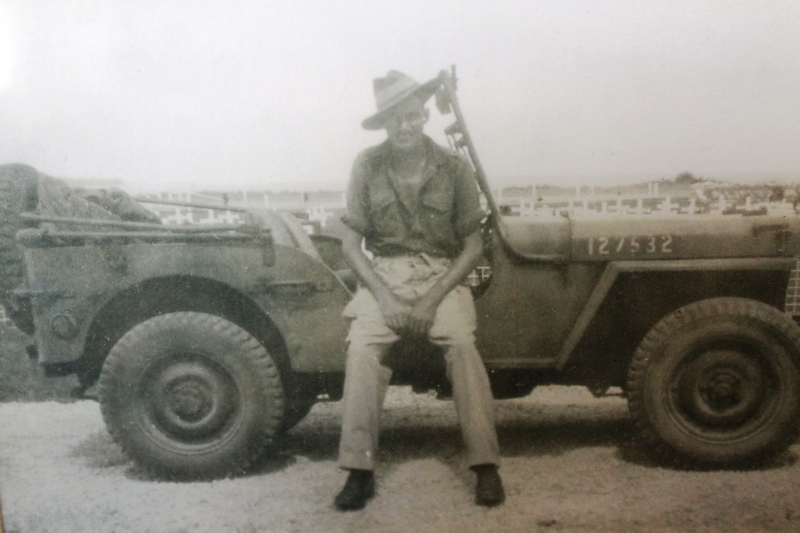Mona Vale Primary School's World War Two Honour roll Board: The Stories behind the Names
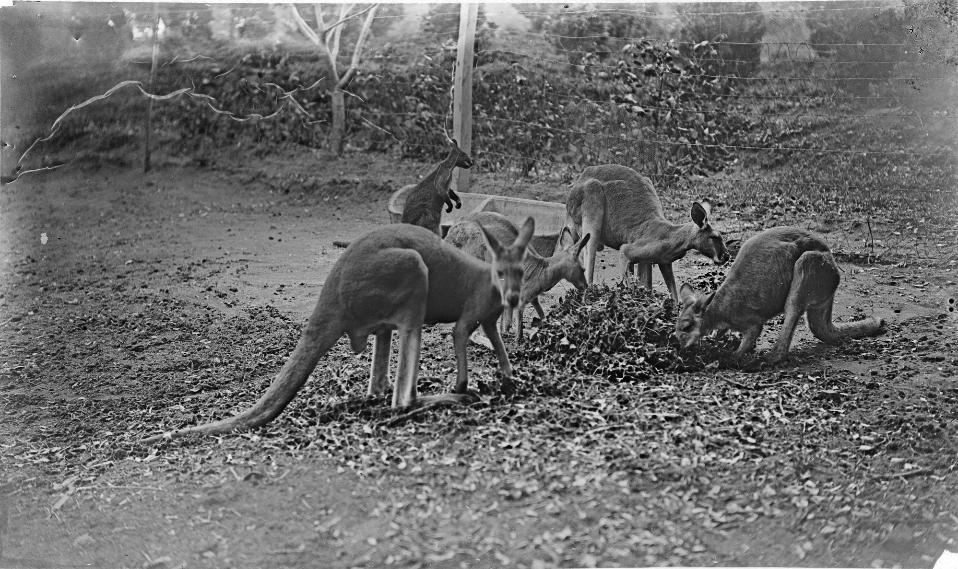
Above Photo: Kangaroo, wallaby and joey mascots left behind/abandoned (?) in England post WWI, photo by Rex Hazlewood (who would photograph and buy land in Avalon Beach on his return), Item: SLNSW_FL3810650, courtesy State Library of NSW. It's worth noting a 2020 article which states red-necked wallabies are now throughout England and states they were released by zoos and collectors during World War Two - how many of these mascots that survived were left behind as well?.
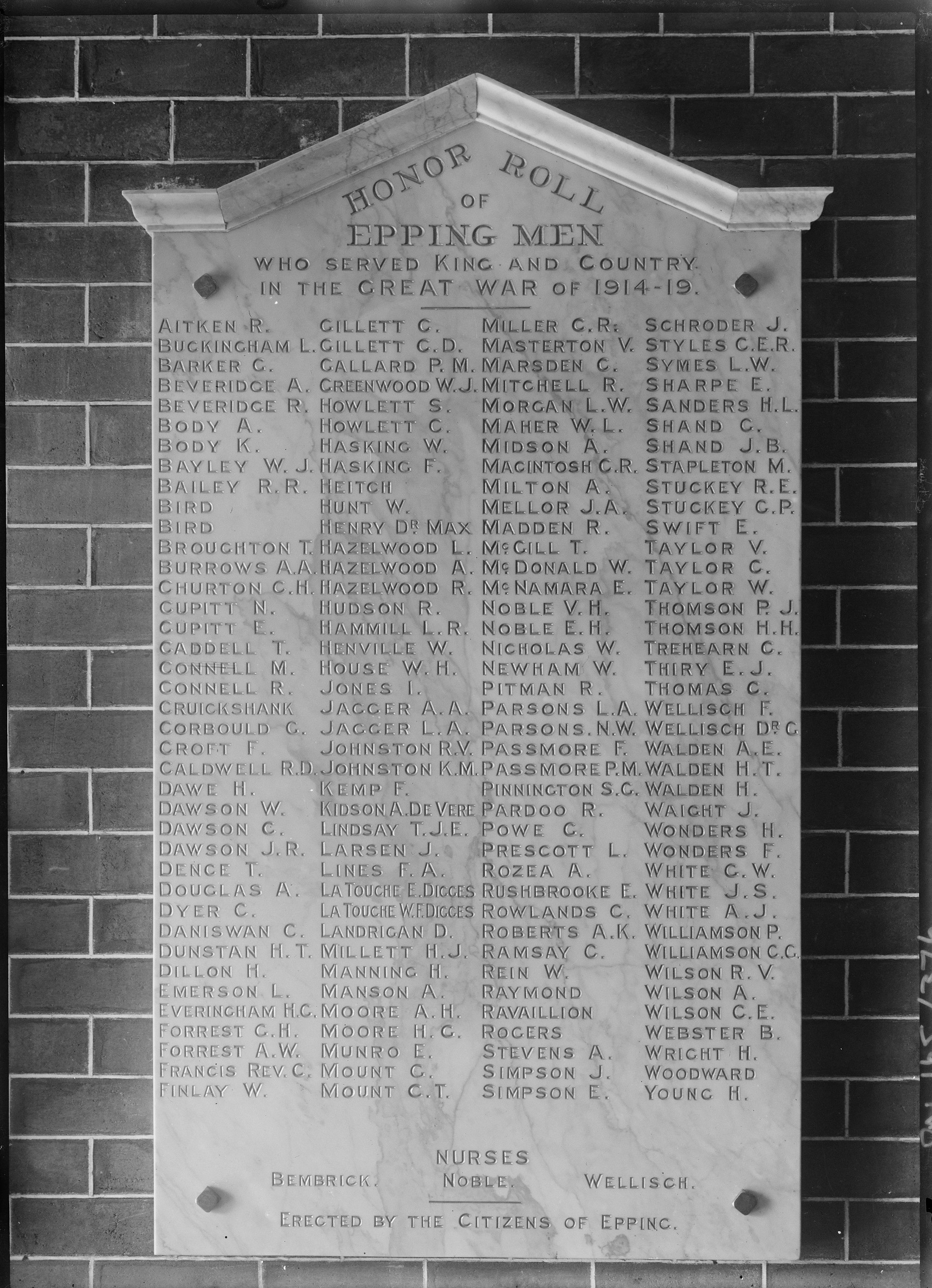
Photo: Honour Roll of Epping Men who served in war 1914-1919 by Rex Hazlewood - NB: Rex and his brothers Arnold and Leonard Willoughby Hazlewood are listed as all three served. Photo by Rex Hazlewood, Item: SLNSW_FL3806389, courtesy State Library of NSW. The AWM has [Australian War Memorial registry files, first series] "Sydney Mail" - Photographs received by mail through Mr R. Hazlewood presented to AWM in 1920 - the State Library of NSW has an extensive collection of his WWI 1914-1919 photographs taken while he served, from being in camp at Sydney Showgrounds and Kiama, the ship and troops entertaining each other while being transported overseas, to ceremonies held in England at the end of the conflict, including parades of all Commonwealth forces.
The first Remembrance Day Service was held on November 11, 1919.
Many of the families that lived at Epping, St Ives and along the Mona Vale road to Mona Vale, Warriewood and Narrabeen, would move to Pittwater post WWI and their children would attend Mona Vale Public School as that was established in Mona Vale itself and the Warriewood valley and surrounds became a farming and market garden district. Their children would be those who volunteered or were drafted into the CMF and then moved into the Army (AIF), Air Force (RAAF) or Navy (RAN).
There are 125 names on the Mona Vale Primary School World War Two Honour Roll, to remember the students who had attended this school who went on to serve in this conflict.
Initially consecrated on Monday November 11, 1996, Remembrance Day, and listed alphabetically, it may be seen that five names now appear at the end of the Honour Roll; L. Maley, M. Maley, C. Birtles, J. Birtles and P. McCarthy - indicating we are still, as a nation and as Pittwater people, discovering the local connections in the 28 years since this Honour Board was first installed inside the school's hall, this coming Monday.
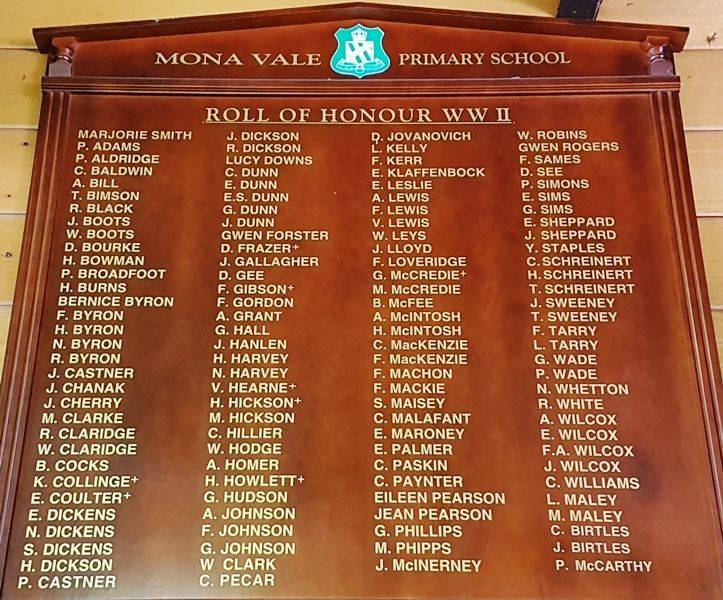
Photo: courtesy Monuments Australia
Those whose names are listed served in every capacity and for those sent overseas, on every Front, from this conflicts commencement until after peace was restored.
The connections between these sons and daughters and those who served in World War One are quite distinct and must have increased the anxiety of those who waited at home with this foreknowledge and experience of war. For instance, the Byron family of Park Street Mona Vale, had 4 sons and a daughter who served.
Their father Richard (Paul) Byron was born ‘near a fallen tree’ at Bungendore. Paul, as he was known, was in the Light Horse Regiment in World War One and met his wife at Dead Horse Hill, a picnic spot west of Mona Vale Cemetery. He was riding in full uniform when he met Ida Louisa Johnson, who worked as a midwife in the area, and they married soon afterwards, Ida purchasing her wedding dress materials from the Porters 11 Mile Store at Bungan-Newport.
An earlier history page recounts the difficulties some riders and horses had with the descent down Tumbledown Dick Hill, near Foleys Hill, of the Light Horse Units that used to come to Mona Vale to train on the old Brock's The Oaks and later La Corniche grounds.
See: Mona Vale Training Grounds: From Lancers on Horses to Lasses on Transport Courses
One of their sons, Neil Byron aged 22, and Donald ‘Frazer’ Gibson aged 25 of Macpherson Street Warriewood enlisted in May 23 for Frazer and May 30 for Neil. Both went into camp at Greta in June 1940 then served in the 2/1 Pioneer Battalion. They were both sent to Palestine and then into Libya to become ‘Rats of Tobruk’.

Neil Byron -WWII enlistment photo
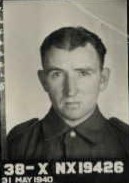
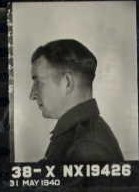
Donald 'Frazer' Gibson -WWII enlistment photos
Neil came home and went on to serve in New Guinea. Frazer was seconded or volunteered to be a Dispatch Rider. On April 14 1941, the night of the Battle of Tobruk, he was Killed in Action, one of 26 men killed that night, including the man who received Australia’s first Victoria Cross in World War 2, Corporal John Hurst 'Jack' Edmondson, 2/17th Australian Infantry Battalion
His brothers Francis and Ray were both made members of 2/18 Australian Infantry Battalion sent into Malaya and then Singapore.
It's hard to believe these two, both from farming families and schoolmates, although they didn’t sign up together, hadn’t had a conversation or two earlier in May 1941. The difference in enlistment dates may be attributed to men being Drafted into the Army during May 1941.
On 20 October 1939 Menzies announced the reintroduction of compulsory military training, known as the Universal Service Scheme, with effect from January 1st 1940. The arrangements required unmarried men turning 21 to undertake three months' training with the Citizen Military Forces (CMF), at the same time, the government raised a new volunteer army for service overseas; the Second AIF - Australian Imperial Force.
Although there was to be no conscription for service beyond Australia and its territories, and that then included Australian territories in Papua and New Guinea, the result of a concerted recruitment campaign, and with unemployment being so high, meant the government had little trouble filling the ranks.
In effect this created two armies. The Second AIF considered itself to be elite, describing the CMF troops as either ‘chocolate soldiers’ (who would melt in the heat of battle) or ‘koalas’ (protected animals that could be neither shot at nor exported – although as we’ve seen to date – this is patently untrue). However, most of those who had to serve in the CMF to begin with due to their age wold go on to enlist in the AIF.
For this conflict a lot of the War Records contain photographs taken of those enlisting on the day they did. Some of these, the girls in particular, are smiling. The men are a mix of smiles, disdain, resentment, aloofness and in some, actual fear. Tragically, of those that show fear it is as though they have premonition as in many cases, those men lost their lives in action.
Australia deployed most of the Second AIF to assist British forces in North Africa, Greece and the Syria–Lebanon campaign. While most Australians were saddened by the outbreak of the war, there was no widespread opposition to the troops’ deployment. The first unit to be deployed was the 6th Division. About 15,000 men sailed in March 1940, more were sent in August 1940.
The 2/1st Pioneer Battalion was raised in Sydney in May 1940. Its men came from around New South Wales and, uniquely, two of its sergeants had served in the 1st Pioneer Battalion during the First World War. In June the battalion moved to the army camp at Greta. After a brief sojourn to Dubbo, at the end of September, it sailed from Sydney as part of a convoy taking Australian Corps' support units to the Middle East.
The convoy reached Suez on 2 November and the 2/1st travelled by train to Palestine and camped at Julis. In January 1941 it left Palestine and moved to Tobruk where it came under the command of the 6th Division. The battalion immediately helped to restore the port, repair roads, and reclaim engineering material.
Following the Allies advance at the start of February the 2/1st moved forward to maintain the road between Tobruk and Derna. In March the 6th Division was relieved by the newly formed 9th Division, as the 6th was needed in Greece.
The Axis were also reorganising their forces. The Germans had landed at Tripoli, bolstering the Italian force, and were advancing east. Consequently, British troops were forced to evacuate to Benghazi and fall back to Tobruk - colloquially referred to as the "Benghazi handicap". Most of the 2/1st was already stationed between Derna and Tobruk but, to bide more time, a lieutenant from the battalion destroyed the Derna pass after the last Allied unit passed through on 7 April. All pioneers were in Tobruk the next day.
For the next five months the 2/1st helped defend the "fortress" by manning various posts and fighting as infantry. In May it was involved in the bitter fighting in the Salient. Tobruk cost the battalion heavily, with 37 men killed in action and seven mortally wounded. Nine became prisoners of war while another 68 were wounded. As with the rest of the Australian defenders, except the 2/13th Infantry Battalion, the 2/1st was evacuated from Tobruk in September.
After a short time in Palestine, the battalion left the Middle East in early March 1942, as the Australian Corps returned home. The 2/1st arrived in Australia at the end of the month. After only a few days leave it was sent to conduct engineering tasks in the Brisbane-Ipswich area. At the end of August the battalion went to Papua, arriving on 5 September.
In February 1941, with the threat of an impending war with Japan, Australia despatched the AIF’s 8th Division, four RAAF squadrons and eight warships to Singapore and Malaya. Most of the men in the 8th Division would be taken into captivity when Singapore fell on 15 February 1942.
Neil’s two brothers in the 2/18th Infantry Battalion were interred as POW’s at the Fall of Singapore, one even becoming part of the forced labor of building the Burma Railway. They were among a few ex-Mona Vale Public school students caught up in that battle – one died in the fighting, another died after being imprisoned in Changi, and already suffering from malaria.
More than 15,000 Australian soldiers were captured during the Fall of Singapore. Of these, more than 7,000 would die as prisoners of war.
At home Darwin was bombed – Tony Rowe (son of Ruskin Rowe of Avalon) died flying in the WA and NT, defending Darwin.
By 1942 Australian soldiers, including the Mona Vale members of the 2/1 Pioneer Battalion, were recalled to Australia as the Japanese moved south, and sent into New Guinea
In July 1942 the seven-month Kokoda Trail campaign began. Soldiers of both the CMF and the Second AIF fought alongside each other with great distinction. During that campaign, more than 600 Australians were killed and some 1680 were wounded, local boys among their number.
One little-remembered aspect is that those captured were brought here – at the end of the conflict they were transported home – this huge exodus of people coming home from conflict zones and being POW’s, and then another exodus as POW’s sent here were returned – and soon after, another huge exodus as people left Europe and England to emigrate here. Just a few records from the National Archives of Australia provide insights of where they had been before being moved here:
Venegoni, Mario (Navy) PWI 48706 - Born: 30 December 1919, Casarezzo Italy - Captured: 22 January 1941, Tobruk Libya - Previously interned: Not known - Arrived Australia: QUEEN MARY, 13 October 1941, Sydney New South Wales - Interned: Leongatha Victoria - Departed: OTRANTO, 10 January 1947, for Naples Italy
Valente, Raimondo (Army) PWI 63575 - Born: 28 May 1915, Cenezia Italy - Captured: 21 January 1941, Tobruk Libya - Previously interned: 22 January 1942, India - Arrived Australia: VERNON CASTLE, 27 April 1944, Melbourne Victoria - Interned: Not known - Departed: OTRANTO, 10 January 1947, for Naples Italy
Visentin, Luigi (Army) PWI 59016 - Born: 17 May 1910, Villadose Italy - Captured: 21 January 1941, Tobruk Libya - Previously interned: 18 January 1942, India - Arrived Australia: MARIPOSA, 5 February 1944, Melbourne Victoria - Interned: Not known - Departed: OTRANTO, 10 January 1947, for Naples Italy
Another little remembered aspect was the application of what was 'Reserved Occupations' - if you brought food to people and in charge of an operation to do so, it was hard to sign up to serve - 'Barry' Cocks, enlisting as a teenager in the CMF was sent home until he was of age, then 21, as his trade was 'Butcher'.
Some of the Yugoslavian men of the Warriewood valley would also have a few problems signing up to try and help those who were defending their family members in Europe as they too were in a vital service. The raising of the Women's Land Army may have helped them to enlist, but there were still some who were rejected on other grounds. For instance, other locals who were a 'Fitter' or in some other skilled trade that would be required to build the ships and airplanes used in defence of Australia would also be seconded into those trades to help in their fields, and shifted out of the AIF.
Some managed to leverage that into enlisting in the services such as the RAAF eventually, the service so many wanted to ne a part of, even serving in England as pilots. However, that age-old knowledge of an 'army marches on its stomach', and definitely needs the equipment and stores required, was not lost sight of in the years it took to restore peace.
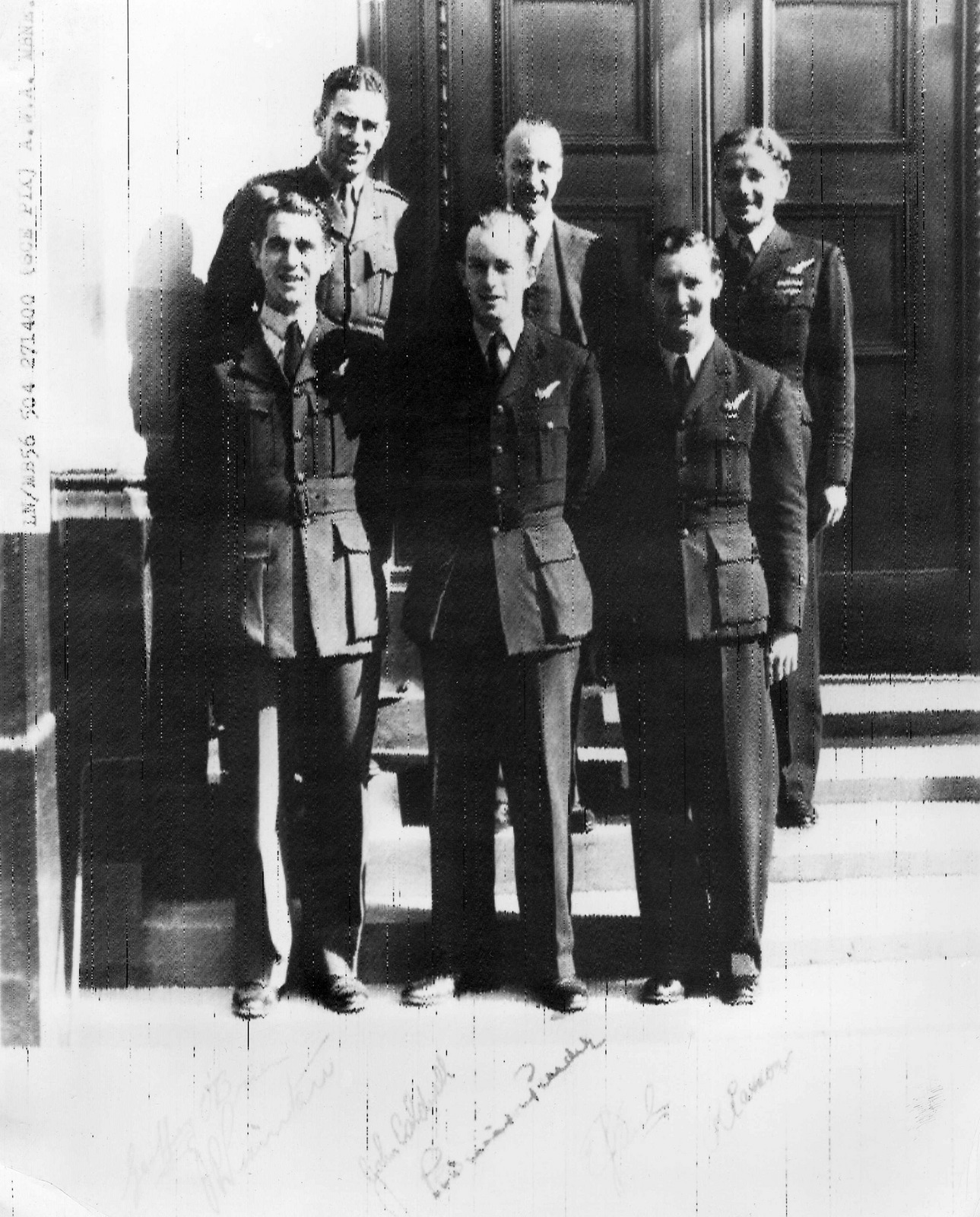
R.A.A.F. EX PRISONERS OF WAR PHOTOGRAPHED ON ARRIVAL LONDON OFFICE OF CABLE AND WIRELESS LTD TO EXCHANGE BEAM WIRELESS MESSAGES WITH NEXT OF KIN IN MELBOURNE AND SYDNEY LAST NIGHT. circa 1945 Group portrait, two rows od three. Back row from left: J. P. Swinton, of Warrnambool, Victoria; joint managing director, Cable and Wireless Ltd, Honourable J. J. Denison-Pender, of London; and, Flight Lieutenant Ron Easson, Narrabeen, N.S.W.. Front row: Flight Officer Geoffrey O'Brien, Mosman, N.S.W.; Flight Officer John Caldwell, Homebush, N.S.W.; and, Pilot Officer Eric Earl, Fairfield, Victoria. Setting in front of large door, back row on second step of stairwell. from Argus Newspaper Collection of Photographs, State Library of Victoria, Item: FL15971893
In reading these records there is a feeling of these men, some of them just 18 when enlisting, being ‘all fired up’. Determination to face and defend their country and a lifestyle that would have been ideal, many were farmers engaged in work in Warriewood valley, Bayview and Mona Vale who spent their whole lives in Pittwater on their return to their homes, is evident between the lines of brief notations.
These were simple hard-working people; there are not a lot of marriage announcements in the newspapers of then - no money for that - but they 'got on with it' then and afterwards. Then, as now, there is a strong sense of community; they all grew up together, were having children together, were trying to make a success of businesses run in the local community, many of them food producing based.
There is also an element of standing up for themselves, along with having that essential more casual approach to anything that remains a part of people who have lived in Pittwater over several generations; some went AWOL, others found themselves up on charges for speaking back to or disobeying orders from superior officers. They wanted to contribute, but wanted to stay within Australia and keep loved ones and fellow Australians safe after Darwin was bombed.
Some were in for the duration. Some were too young to enlist until midway through the conflict. But even then they were sent overseas, to New Guinea, and into places like the launching pad that was Morotai Island on your way into Borneo. Some were not discharged until their units were demobilised, as late as December 1946. Some even served in Japan afterwards.
PEACE:
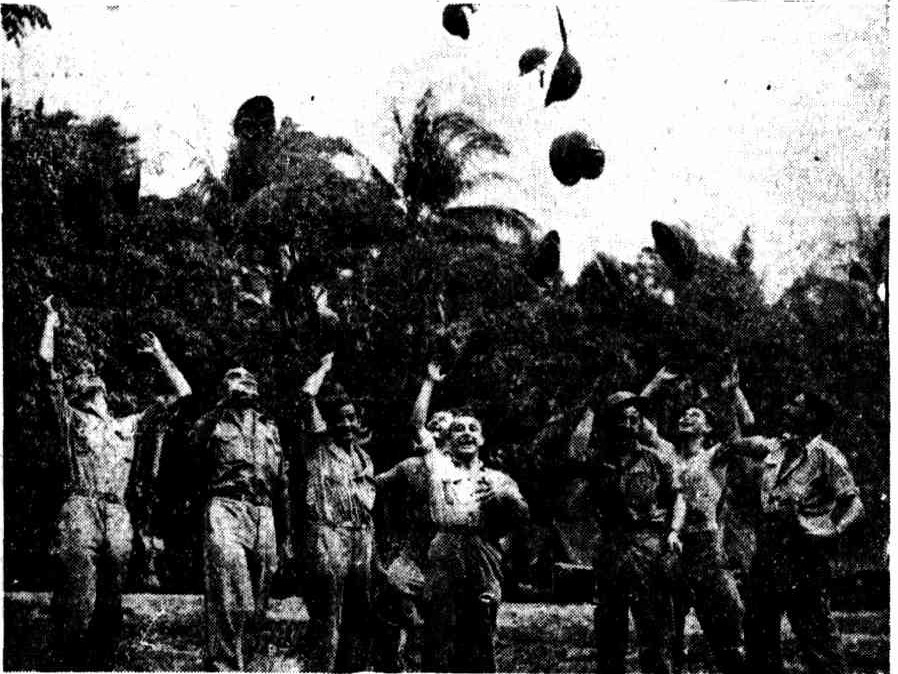
These R.A.A.F. men in Borneo gleefully tossed their steel helmets into the air when' they heard of the Japanese surrender. Australian Official Photo. PEACE: (1945, September 4). Warwick Daily News (Qld. : 1919 -1954), p. 1. Retrieved from http://nla.gov.au/nla.news-article190950745
It should always be remembered that the scars lasted for the rest of their lives for some and that despite the camaraderie enjoined in during Anzac Day and particularly on this Remembrance Day, their lives were marked by these battles for every single day thereafter.
Mrs. Gwynneth Ross, when helping put together her Profile, explained how her husband, Doug, would wake screaming for the rest of his life. He had been trapped in the bowels of a steel ship towards the end of his Service – with the ship on fire, and the men locked in, that nightmare persisted every night afterwards when he came home and they married, had children.
Mrs. Ross would be trying to help him, in the dark hours of the morning, hours before dawn, as he crouched, shaking and soaked in sweat on their bedroom floor, yelling for someone to 'get them out, get the men out!'.
Doug Ross served in New Guinea - Gwynneth explained;
‘’as a Matilda Tank driver and he was in the New Guinea campaign at Milne Bay. He came home from New Guinea after the Coral Sea campaign, when things had been quite successful, which was the Americans mostly, with our ships as well. We became engaged then, I was nineteen.
He went back, over to New Guinea but of course we (at home) didn’t know what was happening…then. What he was doing was training with American landing craft and they were training how to land tanks off the landing craft. This was training for the next campaign which was going to be Borneo. He was with the 7th Division there then, and part of the Balikpapan landing. They would learn how to land the tanks into surf and onto the beach. I think they lost three fellows, they drowned. They were country boys who weren’t used to water. Doug grew up at Clovelly, I grew up at Bronte; he was a good swimmer and the water wouldn’t have fazed him but these poor boys who had to do this in training hadn’t that experience. The book I gave him on his regiment lists them, that they died in training.
Doug Ross, Milne Bay, 1942.
It must have been extremely difficult. A young person, as I was then, I was only 20, you didn’t realise that. In the middle of the night Doug used to so often fling the blankets off, take a few paces and then fall in a heap on the floor. It wouldn’t have been very easy for him. All sorts of dreadful things he went through as part of his regiment.
One he recalled was transporting tanks in the hold of a ship but they weren’t chained properly; they struck a storm and one broke its chains and then with that one cannoning about it hit another one and it broke its chains and they had about four tanks rolling around. They were either going to hull this ship and the ship would have gone down or they’d all go to one side with the ship rolling and that would have made the ship sink. Doug said the Captain had to break radio silence and put all the lights on, and they were throwing bales of rope down in between the tanks as they moved; that too is spoken about in his regiment’s book. So many things in that book he’s made marks beside because he was there.
How long did it take Doug to stop waking in the middle of the night?
Oh, that was going on right until the end, even when he was in the Nursing Home at Collaroy Services when the Parkinson’s became too bad. You know how they sometimes pull up the sides of the bed to stop people falling out?
Well, a couple of times he climbed out and fell on the floor. I said to the Sister, ‘did he say why he did that; was he trying to come home?’; that’s what I thought it would have been, and she said ‘No, he was saying something about, “You’ve got to get off the ship, you’ve got to get off the ship!! Jump off; you’ve got to get off the ship!!”
How old was he then?
He must have been over 80. He was still having the same nightmare.
That’s fifty, sixty years of the same nightmare…
Hmmm.
Did anyone ever speak to him about this?
No, not medically. I think there’s perhaps more medication these days…but not then. The boys that come back from Afghanistan, they must have dreadful things they’ve seen and experienced. Nerve wracking things.. and of course everywhere they walk they could put their foot on something and get blown to bits and die. That really is way over there and not much to do with us, but in our case, our country was threatened, the Japanese were coming ever closer.
In fact, at the time, there was somebody in the Parliament that devised this idea of the Brisbane Line; have you ever heard of the Brisbane Line? It was to run across from Brisbane to the west; that was where we were going to take a stand, if you please, against the Japanese. Why wouldn’t you want to get a gun and go do something?!!''
The 'Brisbane Line' was a controversial defence proposal allegedly formulated during World War II to concede the northern portion of the Australian continent in the event of an invasion by the Japanese. It was rejected by Labor Prime Minister John Curtin and the Australian War Cabinet. An incomplete understanding of this proposal and other planned responses to invasion led Labor minister Eddie Ward to publicly allege that the previous government (a United Australia Party-Country Party coalition under Robert Menzies and Arthur Fadden) had planned to abandon most of northern Australia to the Japanese. A memorandum had been submitted to the Australian War Cabinet in February 1942 (after Menzies, Fadden, and the United Australia Party-Country Party coalition had moved to Opposition), where the General Officer Commanding-in-Chief of the Home Forces, Lieutenant-General Iven Mackay, had advocated that in the event of an invasion, the majority of available Australian forces be concentrated in the area between Brisbane and Melbourne, where most of the nation's industrial capability was located. (Dennis et. al., The Oxford Companion to Australian Military History, p. 107)
Gwynneth’s service;
You were a sergeant in which service?
The Australian Army.
Being a Sergeant; what did that mean?
Oh nothing really, it never went to my head at all.
Which year did you go into service?
I went in in 1942, which was a bad year for Australia. Darwin was bombed then, the Japanese were making their way closer to Australia. All I wanted to do was get a gun and go and do something. I was only 17, so I changed my date of birth to go in, and I got in alright but then of course they found out. And they said, well, you can go away and come back in a year’s time, and I thought, well that’s no good, we might be overrun by then, or, they said, we can put you in the Financial Area and you’ve got to go home to your mother every night. So I chose to do that.
Where was this?
This was at the Sydney Showgrounds, at the War Office.
It wasn't just those of the local school who popped up during the research for this list, those who had had a connection with Mona Vale for some time also became apparent - and this underlines why so many of our surf clubs have Honour Boards for their members too.
This Notice also illustrates how those who survived horrific battles then went on to lose their lives in another elsewhere. One of the former MVPS students who enlisted early in 1940, and served throughout the years in various places and capacities, lost his life in Borneo in June 1945, weeks before the last of the Pacific battles.
 Killed In Action
Killed In Action
Well-known Northern Suburbs first grade Rugby Union breakaway. Lieutenant Robert Albert Hannaford has been killed in action.
Mr. and Mrs. A. E. Hannaford, of Kardinia-road, Clifton Gardens. have been officially informed. Lieutenant Hannaford, who left Australia with the AIF two years and a half ago as a corporal, served in Egypt, Syria, and was one of the "Rats of Tobruk." Hannaford also was a member of Mona Vale Life-saving Club, and for some time swam for Clifton Gardens Club. Killed In Action (1942, November 5). The Sun (Sydney, NSW : 1910 - 1954), p. 8 (LATE FINAL EXTRA). Retrieved from http://nla.gov.au/nla.news-article230584999
Right: Robert Albert Hannaford from newspaper tribute.
KILLED IN ACTION
Lieutenant R. A. Hannaford. A. I. F. former Northern Suburbs Rugby Union footballer and member of the Mona Vale Life Saving Club, has been killed in action abroad. He was the second son of Mr. and Mrs. A. E. Hannaford, Clifton Gardens, and was in the siege of Tobruk.
R. Richards, who represented Sydenham Bankstown in inter-district hard court tennis matches, has been killed in action with the R.A.A.F. at an overseas station. KILLED IN ACTION (1942, November 6). The Sydney Morning Herald (NSW : 1842 - 1954), p. 8. Retrieved from http://nla.gov.au/nla.news-article17811056
Others didn't find out their adored children had lost their life until after hostilities ceased and POW camps emptied.
Even with a peacetime Australia lost people seconded to help Japan. The Australian War Memorial lists 43 Australians who lost their lives during the Japan (British Commonwealth Occupation Force) 1945-52.
Mothers at home spoke out, stating:
TO THE EDITOR OF THE HERALD.
Sir,-I think it is about time all the mothers of our soldiers should cry 'shame" on the strikers who are stabbing the soldiers in the back-for that is what it amounts to Think of our sons, who are fighting overtime at the front to make this country safe for them, without any extra pay Think of the men and women in England who are working overtime and all the time, without any pay at all, to make this country safe for them.
Do not think I write in ignorance I have heard all the arguments and reasonable as they may be at a time like this they do not cut any ice at all with us One is forced to choose between two conclusions. Either through stupidity, assisted by the enemy within our borders, they are cutting then own throats or all the men of strong fibre have gone to the war, and the weaklings left behind simply can’t take it either on the chin or in their pockets.
I should like to ask these workers If any of our enemies should take our country how much overtime they would have to work and what pay do they think they would get for it'
Yours, etc.,
MOTHER OF SOLDIERS. Mona Vale, Jan. 27. TO THE EDITOR OF THE HERALD. (1941, January 30). The Sydney Morning Herald (NSW : 1842 - 1954), p. 5. Retrieved from http://nla.gov.au/nla.news-article17717636
PARCELS FOR SOLDIER PRISONERS
I Suggest to all bridge Players during the first week of November, which is Cup week, they should sub scribe at least once, while playing Bridge, 1/- to be handed in to a P.O.W. fund. MOTHER OF A P.O.W. Mona Vale. POINTS FROM LETTERS (1941, September 22). The Sydney Morning Herald (NSW : 1842 - 1954), p. 2. Retrieved from http://nla.gov.au/nla.news-article17766340
NOW PRESUMED DEAD;
Coulter. Pte. E. Inf.. Mona Vale. … 137 NAMES IN NEW CASUALTY LIST (1946, April 2). The Daily Telegraph (Sydney, NSW : 1931 - 1954), p. 14. Retrieved from http://nla.gov.au/nla.news-article248490364
The research into the stories behind these names is ongoing and will eventually be allocating one dedicated page for each person on a separate Pittwater History from Pittwater Online News website currently being worked on behind the scenes. There is a LOT more to each individual and their inter-connections through marriage, along with how their parents came to be part of Pittwater.
Although the news service ran out of time to load and set all the research, materials and photographs found in time for Sunday the November 10 Issue, (and there are still 12 former students records to find and delve into), more will be made available as Anzac Day, VP Day and Remembrance Day Tributes and precursors from 2025 onwards.
As always, the news service welcomes input and insights from relatives and descendants into the former Mona Vale Primary School students whose names appear on this Honour Roll. Remaining BY Pittwater ensures the records made available are accurate and a fitting tribute that shares what anecdotes have been passed on to we who came afterwards.
We WILL Remember them, all of them.
Please contact the PON researcher via email: pittwateronlinenews@live.com.au
However, as we Honour those who served this Remembrance Day across all conflicts Australians have been sent into, and with 28 years having elapsed since the Mona Vale Primary School Honour Board for their former students was consecrated and dedicated, this Issue these insights into what has been loaded so far runs for you.
References - Notes
- Australian War Memorial - for all information on the Units the men served in
- National Archives of Australia - for all digitised War Service Records
- TROVE - National Library of Australia
- DVA World War Two Service records, available at: nominal-rolls.dva.gov.au/ww2
Deaths as a result of service with Australian units
Per Australian War Memorial, retrieved from: https://www.awm.gov.au/articles/encyclopedia/war_casualties
11 Sept 2024 — The figures below, the number of deaths as a result of service with Australian units, are derived from the Roll of Honour. Questions of eligibility for the Roll of Honour are determined solely by the Memorial’s Council, and have been considered many times over the years by Council and before it by the Memorial’s Board. When a name has been approved by Council as eligible for addition to the Roll of Honour for a current conflict, that name is added on Remembrance Day each year.
Conflict Dates of conflict[1] Number of deaths
New Zealand 1860–61 Nil
Sudan 1885 9
South Africa 11 October 1899 to 31 May 1902 593
China 6 August 1900 to 25 April 1901 6
First World War 4 August 1914 to 31 March 1921 61,678
Second World War 3 September 1939 to 30 June 1947 39,657
Australia (North Queensland Coast, bomb and mine clearance) 1947–50 4
Japan (British Commonwealth Occupation Force) 1945-52 43
Papua and New Guinea 1947-75 13
Middle East (UNTSO; Operation Paladin) 1948 1
Berlin Airlift 1948-49 1
Malayan Emergency 16 June 1948 to 31 July 1960 39
Kashmir (United Nations Military Observer Group in India and Pakistan) 1948-85 1
Korean War 27 June 1950 to 27 July 1953 340
Malta 1952-55 3
Korean War (Post-Armistice service - ceasefire monitoring) 1953-57 16
Southeast Asia (SEATO) 1955-75 12
Indonesian Confrontation 24 December 1962 to 11 August 1966 22
Malay Peninsula 19 February 1964 to 11 August 1966 2
Vietnam War 3 August 1962 to 29 April 1975 523
Thailand 25 June 1965 to 31 August 1968 2
Irian Jaya Operation Cenderawasih) 1976-81 1
Western Sahara (MINURSO) 1991-94 1
Somalia 20 October 1992 to 30 November 1994 1
Border Protection 1997 - 4
Bougainville 1997-2003 1
East Timor (Operations Faber to Citadel) 1999 to 2003 3
East Timor (Operations Spire to Astute) 2004-2013 2
Afghanistan 11 October 2001 to 8 October 2021 47[2]
Iraq 16 July 2003 to 14 December 2013 4
Solomon Island (RAMSI - Operation Anode) 2003-13 1
Indonesia (Operation Sumatra Assist) 2005 9
Fiji 2006 2
Greater Middle East 2014 - 3
Total 103,044
[1] Dates for Roll of Honour eligibility purposes. [2] The figures for current conflicts do not necessarily correlate with the details of the Roll of Honour as the Roll is updated on Remembrance Day.
.jpg?timestamp=1731235980839)
"Curl the mo" says this lad who has just arrived in Sydney for his discharge from the army. [1945?], courtesy State Library of Victoria - which has a lot of the RAAF photos of men who served in New Guinea and across the Pacific. Item: FL16227345, Argus Newspaper Collection of Photographs, State Library of Victoria. Shows Cpl. I. V. Gillian, of Melbourne (Vic.), Pte. J. T. Smith, of Stawell (Vic.) and Pte. C. W. Albert of Melbourne (Vic.).
2/18th Australian Infantry Battalion
The headquarters of the 2/18th Infantry Battalion opened at Wallgrove Camp, west of Sydney on 13 July 1940. Its recruits were drawn principally from north-west New South Wales and Sydney and they trained at Wallgrove until 16 August. The battalion subsequently continued its training at Ingleburn, south of Sydney, and at Bathurst from 6 November. As part of the 22nd Brigade of the 8th Australian Division, the 2/18th sailed from Sydney bound for Singapore on 4 February 1941.
Immediately upon its arrival in Singapore on 18 February, the 2/18th moved north to Port Dickson in Malaya, where it would train for service under tropical conditions. In March it moved to Seremban in central Malaya, in late-August to Jemaluang on the east coast, and in early September to Mersing, also on the east coast. War with Japan was increasingly likely and the battalion set to preparing defensive positions.
The 2/18th stood to arms on 6 December 1941 but it was not until 3 January that it encountered its first Japanese - two downed airmen captured in a hut outside Mersing. On 17 January the 2/18th, much to the consternation of many members of the battalion, received orders to abandon the well-prepared defences at Mersing and withdraw to Jemaluang further south. Japanese successes to the west were threatening to outflank the forces on the east coast. Although never tested, the strong defences had dissuaded the Japanese from conducting a landing around Mersing and using the shortest landward route to advance on Singapore.
The 2/18th's first major action was at Nithsdale Estate in the early hours of 27 January. The battalion lay in wait for the advancing Japanese and sprang an ambush involving three of its companies. It took the Japanese completely by surprise and inflicted heavy casualties. But command broke down in the dark - the complex ambush plan had been intended for daylight - and a premature withdrawal order from brigade headquarters forced the abandonment of D Company behind the bulk of the Japanese force.
After the Nithsdale ambush the 2/18th withdrew to Singapore. It was allocated a position in the centre of the 22nd Brigade's sector on the island's east coast but the wide frontage it was required to cover meant its platoons and sections had to be widely dispersed. When the Japanese launched their invasion on the night of 8 February, the 2/18th had no hope of holding them back, although its positions along the waterfront inflicted heavy casualties. The Japanese infiltrated between the 2/18th's posts and the battled degenerated into vicious scattered engagements in the dark. Like most Australian units involved, it fell into a desperate retreat that ended with surrender on the outskirts of Singapore city on the night of 15 February.
Initially imprisoned in the sprawling Changi prisoner of war camp, it was not long before members of the 2/18th were allocated to external work parties and, as one soldier noted, "scattered to the seven winds". The largest group of 2/18th prisoners were send to to Blakang Mati, off the southern coast of Singapore and lesser numbers ended up at other camps around Singapore and Malaya, along the Burma-Thailand railway, and in Borneo and Japan. The surviving prisoners were liberated in late-August 1945 and began returning to Australia almost immediately. The 2/18th was formally disbanded later that year.
2/1st Pioneer Battalion
The 2/1st Pioneer Battalion was raised in Sydney in May 1940. Its men came from around New South Wales and, uniquely, two of its sergeants had served in the 1st Pioneer Battalion during the First World War. In June the battalion moved to the army camp at Greta. After a brief sojourn to Dubbo, at the end of September, it sailed from Sydney as part of a convoy taking I Australian Corps' support units to the Middle East.
The convoy reached Suez on 2 November and the 2/1st travelled by train to Palestine and camped at Julis. In January 1941 it left Palestine and moved to Tobruk where it came under the command of the 6th Division. The battalion immediately helped to restore the port, repair roads, and reclaim engineering material.
Following the Allies advance at the start of February the 2/1st moved forward to maintain the road between Tobruk and Derna. In March the 6th Division was relieved by the newly formed 9th Division, as the 6th was needed in Greece.
The Axis were also reorganising their forces. The Germans had landed at Tripoli, bolstering the Italian force, and were advancing east. Consequently, British troops were forced to evacuate to Benghazi and fall back to Tobruk - colloquially referred to as the "Benghazi handicap". Most of the 2/1st was already stationed between Derna and Tobruk but, to bide more time, a lieutenant from the battalion destroyed the Derna pass after the last Allied unit passed through on 7 April. All pioneers were in Tobruk the next day.
For the next five months the 2/1st helped defend the "fortress" by manning various posts and fighting as infantry. In May it was involved in the bitter fighting in the Salient. Tobruk cost the battalion heavily, with 37 men killed in action and seven mortally wounded. Nine became prisoners of war while another 68 were wounded. As with the rest of the Australian defenders, except the 2/13th Infantry Battalion, the 2/1st was evacuated from Tobruk in September.
After a short time in Palestine, the battalion left the Middle East in early March 1942, as the I Australian Corps returned home. The 2/1st arrived in Australia at the end of the month. After only a few days leave it was sent to conduct engineering tasks in the Brisbane-Ipswich area. At the end of August the battalion went to Papua, arriving on 5 September.
After two days in Port Moresby, A, B, and C Companies moved to Owers' Corner at the base of the Kokoda Trail and up the track through Uberi to Ioribaiwa. The battalion patrolled and manned defensive positions along Imita Ridge. It also helped the 14th Field Regiment move their 25-pounder guns up the track to the foot of Imita Ridge.
More draining work followed when the three companies moved to 9-mile Quarry in November. For the next seven months the pioneers worked as miners and labourers in two plants, producing crushed metal used to surface airfields and roads. Work at the quarry was frustrating and morale was low. At the same time, D Company was in Milne Bay helping to develop the area's infrastructure. They built trestle bridges and maintained roads.
The battalion returned to Australia in October 1943 and, after leave, regrouped at Wongabel on the Atherton Tablelands. Located with the 6th Division the pioneers could concentrate on infantry training. It was with the 7th Division, though, the battalion would again go to war.
Devised towards the end of the war, the OBOE operations aimed to reoccupy areas of the Netherlands East Indies, with the 9th and 7th Divisions making amphibious landings on Borneo in 1945. The 9th Division landed on Tarakan in May, and Labuan Island and Brunei Bay in June; the 7th Division landed at Balikpapan at the start of July.
The 2/1st came ashore at Balikpapan on 1 July, the first day of the battle. After working to consolidate the beachhead, the battalion's next task was to help defend Balikpapan Harbour. Crossing Balikpapan Bay in landing craft, A Company were sent to patrol the Penadjam and Riko Rivers, while B Company went to Tempadung. In August D Company moved out along Milford Highway.
Japan surrendered on 15 August. With the war over the ranks of the 2/1st gradually thinned, as men were discharged or transferred. What was left of the battalion returned to Australia in December and on 18 February 1946 the 2/1st was disbanded.
172 "RESERVED" OCCUPATIONS
PROVISIONAL LIST ISSUED
Enlistment Restrictions
Volunteers for enlistment in the combatant forces of Australia will in future be accepted only subject to restrictions as to certain industries. A provisional list of 172 reserved industries and occupations was issued last night by the Minister for Defence (Brigadier Street).
The list sets out the industries and occupations in which, in the general national interest, restrictions will be enforced.
"The object of the restrictions is to ensure that while the requirements of the combatant forces are met, those men whose services in other occupations are essential to national requirements shall not be permitted to enlist in the fighting services," Brigadier Street said.
"The list is necessarily provisional. It is being circulated for immediate use, but a completely satisfactory list to cover all essential occupations throughout Australia cannot be completed until it is widely examined and tested. It is not anticipated that the list will meet every requirement. It will be examined and tested to ensure eventually that all national requirements have been fulfilled."
Brigadier Street has informed District and Base Headquarters that the restrictions be applied to recruiting for all branches of the Australian Military Forces with reasonable consideration for the requirements of the Army and of industry respectively.
Military authorities in respective districts have been advised that this could only be obtained by the Army recruiting organisation and man-power officials maintaining the closest co-operation and employing with tact and common sense the discretion and trust which must necessarily be reposed in them by the Government.
In the lists which follow the figures printed before occupational groups mean the age at or above which the restriction against volunteering applies, i.e., men below that age are available for enlistment.
Where no figure appears the restriction applies to volunteers in that occupation, whatever their age.
Abattoirs and Butchering—25, Foremen, leading hands, managers; 30, Boners, Retort hands (preservers), slaughtermen.
Abrasive—25, Chemists, Foremen, managers; 30, Burners, cementers, machine operators, mixers, surfacers.
Agriculture—25, Foremen, managers, working principals (in charge three or more men); 30, Curing shed hands, machinery attendants, machinery drivers, propagators, shearers, wool classers, workers under glass; 35, Farm hands, singly employed; 40, Budding workers, fencing contractors, grafting workers, horse breakers, packers or pressers, shearing shed hands, stockmen, well and dam contractors.
Agricultural Implement Manufacture — 25, Building carpenters and joiners, coremen, draughtsmen, electrical fitters, electrical mechanics, engineer fitters, engineer turners, erectors, foremen, furnacemen (head), heat treaters, machinists (first class), managers, moulders (all classes), pattern makers, saw doctors, sheet-metal bench hands (first class), smith (all classes), welders; 30, Toolmakers, assemblers, blast dressers, bulldozers, die setters, dressers, drillers, fitters (implement), furnacemen (others), glaziers, grinders, machinists (second class), painters, sawyers.
Asbestos Manufacture—25, Foremen, managers; 30, Fixers, fixers' assistants, machinists, wiremen.
Asphalters, Compositions &c. —25, Foremen, managers; 30, Distillers.
Bag Manufacture: Jute, Hessian, Cotton and Wool Packs—25, Foremen, managers; 30, bag-making machinists, balers, hand workers, machinists.
Battery and Accumulator Makers—25, Fore-men, leading hands, managers; 30, Chargers, group burners, mixers, moulders, sealers, stampers.
Bedstead Manufacture—25, Blacksmiths, casters, chill fitters, fitters, foremen, frame setters, furnacemen, managers, mounters; 30, Electro-platers (first class); 35, Chippers, japon and lacquer workers, grinders, platers, splitters.
Boat Builders — Boat builders' assistants, journeymen, managers.
Boot Manufacture—25, Foremen, mainten-ance tradesmen, managers; 35, Clickers, edge setters, edge trimmers, heel builders, lasters, pressmen, pullers over, rounders, stitchers, welters; 40, Boot repairers, heel parers, machinists (??), trimmers.
Brewing, Malting, Wine and Spirits — 25, brewers, foremen, leading hands, maintenance tradesmen, managers, refrigeration engineers; 30, cold cellarmen, coopers, distillers, malt-sters; 35, bottling machine operators, syphoners.
Brick Making — 25, foremen, maintenance tradesmen, managers; 35, burners, clayhole-men, crushers, drawers, moulders, riggers, setters; 40, machinists.
Brushmaking — 25, foremen, maintenance tradesmen, managers; 40, bass brush hands, bass broom drawers, borers, cutters, dressers, hair brush hands, leading sorters, maker and sewers, mixers, paint brush hands, wire brush hands.
Building Construction and Repairs—25, carpenters and joiners, electrical fitters, foremen, hot-water engineers, managers, plumbers (certificated); 30, clerk of works, dog men, electrical wiremen, masons, plumbers (not certificated), steeplejacks; 35, bricklayers, crane-drivers, painters, plasterers, including fibrous; 40, builders' labourers, concrete mixers, riggers, scaffolders.
Carbon Manufacture.—25, foremen, maintenance tradesmen, managers; 30, leading hands; 40, mechanics, mill hands, mixing hands.
Cardboard Box and Carton Trade—25, carton setters, foremen, leading hands, maintenance tradesmen, managers; 40, armoury press hands, corrugated board workers, platen press hands, printing workers, sawyers, slotting hands, splitting machinists.
Carriage and Body Building—25, aero mechanics, assemblers, axle makers, body makers, braziers, carpenters, coremakers, examiners, fitters and turners, foremen, furnace-men, joiners, machinists, maintenance tradesmen, managers, markers out, moulders, panel workers, sheet-metal workers, spring makers, smiths, template makers, testers, welders, wheelwrights, toolmakers; 30, bulldozers, electricplaters, motor mechanics, tubemakers; 35, brass workers (press hands), brass workers (others), furnacemen, glass hands, machinists; 40, cutters, drillers, fabric workers, painters, pipe fitters, press operators, riveters, solderers, squab and cushion hands, trimmers.
Cattle Food and Remedies — 25, foremen, maintenance tradesmen, managers; 30, leading hands; 40, machinists, packers.
Cement and Lime Manufacture — 25, fore-men, maintenance tradesmen, managers; 35, bankmen, cement burners, cooler attendants, crushers, hammermen, millers, plate layers, pump attendants, quarrymen, slurry testers, slurry testers' attendants.
Cement Manufacture — 25, foremen, maintenance tradesmen, managers; 35, annealers, finishers, tank makers, tile and ridge makers; 40, assemblers, cement mixers, concrete mixers, crushers, moulders, pipe wirers, sprayers.
Chemical Dye and Fertiliser Manufacture— 25, foremen, leading hands, maintenance tradesmen, managers; 35, first assistants.
Clothing and Dress Manufacture—25, foremen, maintenance tradesmen, managers; 35, blockers, cutters, dry cleaners, dyers, fleshers, frame makers, helmet makers, pressers, tailors; 40, finishers, fitters up, nailers, trimmers, underpressers.
Commerce and Finance—Banking and Insurance Companies—25, accountants, chief clerks, inspectors, managers and sub-managers, managers, officers-in-charge and 1st assistants in foreign bills and securities departments, officers-in-charge and 1st assistants of departments containing 6 hands and over, secretaries and assistant secretaries, senior executives, superintendents, tellers; 30, assistants—2nd, 3rd, and 4th assistants in foreign bill and securities departments.
Other Establishments—25, Accountants, auditors, bookkeepers, cost and time clerks, commercial artists, managers, secretaries, working principals; 30, caretakers, executives in charge of 3 or more persons.
Communications (Cable, Beam, Wireless) —25, cable jointers, control-room operator, technicians, technicians-in-charge.
Cordage Industry.—25, foremen, maintenance tradesmen, managers; 30, leading storemen, reelers, rope layers, rope splicers, traveller drivers.
Cork Manufacture—25, foremen, managers; 40, bleechers, borers, drawers off, notchers, press hands, rounders, sorters.
Cutlery Makers.—25, foremen, leading hands, managers; 40, finishers, grinders.
Cycle and Motor-cycle Manufacture—25, braziers, foremen, lathe hands, leading hands, maintenance tradesmen, managers; 30, benders, platers, rim and wheel makers; 40, assemblers, polishers, repairers, sprayers.
Distribution Wholesale and Retail—30, department heads, head salesmen, leading store-men, working principals.
Electricity Generation and Supply—25, Cable layers, cable jointers, civil engineers, drafts-men, electrical tradesmen, engineers, foremen, linesmen, maintenance tradesmen, managers, meter makers, superintendents, welders, engine-drivers; 30, erectors, linemen's assistants, fire-men, meter fixers and testers, overseers and patrolmen, switchboard attendants.
Electrical Installation—25, cable jointers, draftsmen, electrical fitters, electrical mech-anics, foremen; 30, managers, electrical wire-men; 35, electrical erectors, testers, transformer and armature winders.
Electrical Articles Manufacture — 25, Electrical fitters, foremen, maintenance staff, managers; 35, assemblers, armature winders, machine operators.
Electrical Insulating Materials—25, Bakelite engineers, foremen, managers; 35, batch makers, resin makers, rolling hands, vulcanising operators.
Electroplating—25, foremen, managers; 30, electroplaters; 35, coaters, electroplaters, liners, polishers.
Employers and Employees' Organisations— 25, full time officers and executives.
Engine-drivers—25, cranes, excavators, gas-engines, internal combustion engines, locomotives, mining engine-drivers, traction engines, winch-drivers, engine-drivers.
Engineering—25, annealers, benders, boiler-makers, braziers, case hardeners, carpenters, caulkers, coremakers, draftsmen, fitters and turners, forgers, foremen, furnace-men, gear cutters, grinders, heat treaters, ladle-men, leading hands, machinists, managers, markers off, moulders, pattern makers, pipe builders, plate setters, riggers and splicers, ring and flange makers, saw operators, smiths, template makers, testers, tube fitters, tradesmen, welders, toolmakers; 30, motor mechanics; 35, assemblers, brass finishers, chippers, dressers, drillers, machinists, welders.
Engraving, Die Sinking, Type Founding—25, engravers, foremen, maintenance tradesmen, managers, matrix engravers, matrix stampers; 35, enamellers, pantagraph operators, type founders.
Entertainment and Recreation—35, machine operators (cinema), maintenance tradesmen, managers, professional entertainers, sport and recreation ground curators.
Fellmonger Trade—25, charge hands, fore-men, managers; 35, mechanics, scourers, sorters, tanners, wool pressers.
Fire Brigades — Full time members public fire brigades; 30, part time members public fire brigades.
Flax Treating—25, foremen, maintenance tradesmen, managers, scutchers.
Flock Manufacture — 25, charge hands, foremen, leading hands, managers; 40, machine feeders, tenterers.
Flour Mills — 25, foremen, maintenance tradesmen, managers, millers, samplers, silo-men, storemen; 30, smuttermen, purifiers, topmen.
Food and Soft Drink Manufacture and Processing — 25, trawler crews, licensed fishermen, foremen, leading hands, maintenance tradesmen, managers, refrigeration engineers; 30, bakers, blenders, brakesmen, butchers, canister makers, case makers, chambermen, confectioners, driers, fish auctioneers, fruit preservers, graders, jam makers, margarine makers, meat export processors, pastrycooks, tasters, trappers, vinegar brewers; 40, bottlers, dough mixers, evaporators, kiln operators, machinists, mill assistants, mixers, oven hands, rollers, separators, slaughter-men, store packers.
Galvanising Trade — 25, foremen, mainten-ance tradesmen, managers; 30, galvanisers; 35, barrellers, picklers, swingers.
Gas Production and Distribution—25, fore-men, maintenance tradesmen, managers, superintendents; 30, conveyor attendants, gas fitters, hydraulic and tar attendants, machine and stage men, meter makers, meter readers, main layers, oxide breakers, pipe jumpers, purifiers and washers, retort operators, charge hands, retort repairers, stokers, service layers, valve men.
GIass Manufacture (including Plate-glass)— 25, foremen, maintenance tradesmen, managers; 30, benders, bevellers, blowers, embossers, feeder operators, furnace builders, gatherers, lathe workers, leadllght workers, lehrmen, makers, sorters (head); 40, cutters, fitters, fire-men, furnace assistants, glaziers, pottery workers, silverers, welders.
Glue, GIycerine, Gelatine, Grocers' Sundries, and Soap Manufacture—25, foremen, leading hands, maintenance tradesmen, managers; 30, blenders, compo mixers, glycerine distillers, leading storemen, millers, mixers, sawyers, soap makers, soda (process workers), stillmen; 40, acidifiers, candle-makers, charcoal burners, dippers, filtermen, glue tippers, grease maker (axle), jelly cutters, kilnmen, logmen, machínists, mill assistants, packers, stone dressers.
Gut Manufacture—25, assemblers, foremen, gutmakers, managers; 35, sandpaper machínist, thinners (filling and drying).
Harbour Works and Control — Berthing masters, construction crews, divers, dock superintendents, dredging crews, harbour lights attendants, harbourmasters, inspectors, pier-masters, pile drivers and layers, pilots.
Hat Manufacture (Felt) —25, dyers (head), foremen, leading hands, maintenance trades-men, managers; 30, body stock supervisors, finished stock supervisors, inspectors, journey-men, warehousemen; 40, bumper attendants, crozers, machine blockers, preparers, pressers.
Hotels and Restaurants—35, caterers (working principals), chefs (1st class), maintenance tradesmen, managers.
Jewellery Manufacture—25, clockmakers (1st class), foremen, lappers, leading hands, managers, setters, toolmakers, turners, watchmakers (1st class); 35, chainmakers, clockmakers (2nd class), enamellers, melters, polishers, press workers, watchmakers (2nd class).
Lamps, Lanterns, &c., Makers—25, copper-smiths, foremen, managers, sheet metal workers; 30, assemblers, brass finishers, polishers.
Locksmiths.—25, foremen, managers, technical staffs; 35, assemblers, drillers, finishers (lock and key), furnace hands, machinists, press hands.
Leather Goods Manufacture — 25, foremen, maintenance tradesmen, managers; 30, collar-makers, frame fitters, journeymen, legging hands, saddlers; 35, cutters, machine workers, padders, quilters, seamers, stitchers.
Leather Tanning and Manufacture—25, fore-men, leading hands, maintenance tradesmen, managers; 30, buffing machinists, curriers, fleshers, grainers, jiggers, shaving machinists, splitters, whitening machinists; 35, leading vat hands, machinists, press hands, scudders, table hands.
Linoleum and Floor Covering Manufacture (not rubber)—25, block cutters, foremen, dyers, maintenance tradesmen, managers; 30, oil boilers, stone dressers, stone millers, carders.
Maintenance Staffs—25, artisans, boiler and power attendants, engine-drivers, fitters, mill-wrights.
Metals (Iron and Steel) — 25, annealers, blastmen, boom chippers, blowers, bricklayers (furnace), by-products plant hands, catchers, casters, converter men, coremakers, chain-makers, crucible-men, cupola-men, dressers, foremen, furnace-men, ladle-men, leading hands (all processes), maintenance tradesmen, managers, mangle-men, moulders, open hearth workers, oxy-acetylene cutters, puddlers, re-finer, rollers, roughers, smelters, shearmen, technical staffs, wire drawers; 30, coke oven hands, drainers, gaggers, gas producer men, guillotiners, mill hands, powder monkeys, powder charge tippers, riggers, splicers, trimmers.
Metals (Non-ferrous) and Kindred Trades— 25, blacksmiths, borers, casters, fitters (N.E.I.), finishers, foremen, furnace-men, leaden goods makers, lead shot maker, leading hands, main-tenance tradesmen, managers, milling ma-chinists, melters, mixers and chasers, moulders, pattern makers, planers, refiners, rollers, slotters, smelters, softeners, turners, tuyere punchers, wire drawers; 30, burnishers, feeders, machinists, press hands, sand workers, sieve hands.
Mining Industry (coal, gold, oil, shale, &c.) —25, blacksmiths, carpenters, examiners, fore-men, inspectors, leading cyanide hands, maintenance tradesmen, managers, miners (all classes), saw doctors; 30, battery-men, cage-men, charge hands, drawers, furnace-men, platmen, retort-men, saw sharpeners, set runners, shaft sinkers, stopping builders, winch drivers, engine-drivers; 35, battery feeders, bracemen, fettlers, lamp hands, machine-men, motor-men, powder-men, puddlers, pumpmen, prospector, senior truck hands, timber-men, truckers, wheelers.
Mica Products—25, foremen, managers; 30, charge hands; 35, mica production employees.
Monumental Masons — 25, foremen, maintenance tradesmen, managers; 35, carvers (machine and hand), erectors, polishers, sawyers (machine and hand).
Nails, Barbed Wire, Tacks, Bolts and Nuts —25, annealers, draw bench hands, foremen, maintenance tradesmen, managers; 30, tool-makers (see Engineering), die setters, gal-vanisers; 35, machinists, picklers, polishers, swingers.
Nickelware Manufacture — 25, foremen, maintenance tradesmen, managers; 30, die setters, repairers, spinners; 35, blankers, drop hammer men, makers-up, picklers, press operators, stampers.
Oil Refining and Distribution—25, foremen, leading hands, maintenance tradesmen, managers, superintendents, technical staffs; 30, assistant managers, fitters (piping), mechanics (motor), section heads, super heater hands, tank drivers.
Oven, Range and Stove Makers—25, black-smiths, braziers, foremen, maintenance trades-men, managers, pattern-makers; 30, electroplaters (1st class), furnace-men; 35, assemblers, brushers, dressers, drillers, fusers, grinders, moulding-box hands, punchers, riveters, sprayers, swillers, testers.
Paint, Enamel, Varnish, Colour Manufacture —25, foremen, managers, technicians; 35, blast operators, boiler hands, charge hands, grinders, mechanical makers, tinters, varnish makers.
Paper Manufacture — 25, beatermen (key), dryermen (key), development staffs, engine-drivers (powder production), foremen, leading hands, machine-men (key), maintenance tradesmen, managers (mill), millers' assistants, technical staffs; 35, beater assistants, breaker beater-men, breaker beater-men's assistants, cuttermen, drum repairers, filtermen, finishers, guillotine-men, hoist men, packers, pastermen, reelermen, sawyers, sizemen.
Paper Bag Manufacture—25, foremen, maintenance tradesmen, managers; 35, guillotine hands, machinists, packers.
Photographers and Photographic Goods—25, Coaters (leading), emulsion mixers, foremen, maintenance tradesmen, managers; 35, photographers (1st class), retouchers; 40, developers, finishers, melters, washers.
Plaster Manufacture (Including Fibrous)—25, foremen, managers; 30, modellers; 40, fibrous plaster hands, repairers, fixers.
Plastic Moulding—25, foremen, maintenance tradesmen, managers; 30, fitters, leading press operators, platers; 40, finishers, press hands (intricate operations), die sinkers.
Plumbing and Hot-water Engineering — 25, hot-water engineers, lead burners, managers, plumbers; 30, gasfitters, plumbers (uncertificated).
Postal, Telegraph, and Telephone — Engineers, fitters, foremen linesmen, mainten-ance tradesmen, mechanics (telephone), mechanics (telegraph), mechanics (motor), operators (telegraph), operators (cable), over-seers, postmasters, superintendents, supervisors; 35, letter carriers, mail sorters, mail contractors, transport drivers.
Pottery Manufacture—25, foremen, leading hands, maintenance tradesmen, managers; 30, bitumen jointers, charge hands for flower-pots, ventilators, and grinding pans, clayhole men, head burners, hollow-ware makers, junc-tion hand moulders, mouldmakers, powder monkeys; 40, burners' assistants, casters (stoneware), charge placers, drawers, flangers, grinders, machinists, plunge hands, pottery printers, pressers, setters, tilemoulders.
Printing, Publishing, Bookbinding, Newsprint, Process Engraving, Map and PIan Production— 25, artists (map and plan), foremen, Iitho-graphers (map and plan), maintenance trades-men, managers, photographers (map and plan), photographers (commercial), process engravers; 30, bookbinders, compositors, editors, leather workers (bookbinding), linotype operators, lithographers, map and plan mounters, opera-tors (machine), plate hands (flat, rotary, stone), readers; 40, finishers, guillotine hands, ink mixers, ink grinders, marblers, packers, rulers, storemen (head).
Professional Services — Chemists: Pharmaceutical, agricultural, analytical, industrial, research. Engineers: Civil, electrical, mechanical, metallurgical, mining, holding degrees or diplomas or members of recognised institutes. Medical Profession (except for service in R.A.A.M.C., R.A.N.V.R., R.A.A.F. Medical Services): Dentists and dental mechanics, X-ray operators, architects (all classes), surveyors (all classes), opticians (qualified), veterinarians, zoologists. Laboratory Staffs, to include: Chemists, engineers, physicists, and other scientific workers qualified by degree or diploma, or students in third year at the university or technical college. Students (University) — Medical and Dental: All students in second and later years of physical sciences, chemistry, physics, metallurgy, and engineering; all students in second and later years of biological sciences, bacteriology, bio-chemistry, zoology, botany, and agriculture, last-year students in economics, commerce, mathematics; third-year honour students in languages; post graduate and research students; university teaching staffs, scientific and research workers; anthropologists, astronomers, bacteriologists (other than members of the medical profession), bio-chemists (plant and animal) (other than members of the medical profession), botanists, entomologists, geographers, geologists, histologists (other than members of the medical profession), hydrobiologists, metallurgists, meteorologists, mineralogists, mycologists, parasitologists, pathologists (other than members of the medical profession), pest control workers, pharmacologists (other than members of the medical profession), physicists, physiologists (plant and animal) (other than members of the medical profession), scientific research workers (full time) in a university or technical school; 35, linguists, teachers in other educational establishments; 40, legal profession.
Public Services or Essential Services Controlled by Government Departments, Boards, Commissions, or other Bodies operating under Government or Local Government Authority— Non - industrial: 25, other than minor or manipulative grades; 35, minor and manipulative grades. Industrial—Aircraft manufacture and repair, defence establishments, mercantile marine, munitions, ship and dockyards, communications (beam, cable, wireless), electricity generation and supply, fire brigades, gas production and distribution, harbour works and control, postal, telegraph, and telephone, railways, sewerage, tramways, water conservation and supply.
Quarries (Stone, Slate, Gypsum, Sand, and Gravel)—25, blacksmiths, engine-drivers, fore-men, maintenance tradesmen, managers; 30, borers, calciners, charge hands, firemen, graders, powder monkeys, tool sharpeners; 40, baggers, crushing-machine men, dressers, drill hands, dryers, facemen, feeders, gypsum raisers, nozzIemen, pitchers, pneumatic pick hands, shaft sinkers, shovel attendants, spallers, slate splitters, washers.
Railways—25, chargemen (station), charge-men (parcels), checkers, cleaners, conductors, engine-drivers (all classes), examiners, fire-men, foremen, gangers, gatemen, guards, in-spectors, linesmen, managers, motormen (elec-tric), platelayers, porters, shunters, signalmen; 25, spraggers, superintendents, stationmasters, other executive officials.
Rubber Industry—25, foremen, maintenance tradesmen, managers, technical staffs; 30, air bag makers, belt makers, calender operators, calenders' assistants, compounders, hose ma-chinists, hose handworkers, lathe hands, me-chanical hands, moulders, press hands (heavy), superintendents, surgical goods operators, tyre builders; 35, buffing hands, curing pan hands, cutters, dough mixers, frothers, machinists, press hands (light), pump attend-ants, repairers, sponge hands, storemen (head), vulcanisers.
Scientific Instrument and Appliance Makers —Dental, optical, surgical appliance and apparatus makers: electrical, mathematical, nautical, scientific, surgical, optical instrument makers and fitters, including appren-tices; foremen, managers, scalemakers.
Sewerage and Drainage.—25, civil engineers, draftsmen, engine-drivers, foremen, house connection designers, inspectors, maintenance tradesmen, managers; 35, borers, compressed air workers, drain testers, jointers, pipe layers, riggers, windlass hands.
Shipbuilding. — Boiler fitters, boiler and pipe coverers, bolt and nut makers, borers, carpenters, caulkers, chippers, coppersmiths, drillers, electricians, electrical wiremen, fitters and turners, forgers, foremen, furnace-men, holders-up, leading hands, maintenance engineers, managers, mastmakers (wood and steel), painters, pattern-makers, platers, plumbers, refrigeration engineers, riggers, riveters, saw operators, smiths (all classes), tradesmen (all classes).
Shipping (Port and Harbour) and Ferry Services. — 25, Customs agents, ferry boat crews, heads of departments, office executives, stevedores.
Shovel, Spade, and Pick Manufacture. — 25, annealers, foremen, maintenance trades-men, managers; 30, testers; 40, handle fitters, pneumatic hammer heads, press hands, riveters.
Social Services, &c.—Cemeteries, charitable institutions, civil ambulances, convalescent homes, friendly societies, hospitals (maternity, surgical, and general public), lighthouse services, penal reformatory establishments, pilot services, police forces; ambulance drivers and attendants, executives, laboratory staffs, maintenance tradesmen, masseurs (qualified), medical profession (including students), penal staffs, policemen, police officers, radiographers, surgical dressers, wardsmen (trained), X-ray operators.
Sugar Refining. — 25, foremen, maintenance tradesmen, managers; 35, leading hands in carbonation, char end house, in golden syrup and treacle, jelly house, melting house, pan floor, raw and refined, and in sugar house.
Tent, Sail, Canvas Goods, Flag Manufacture — 25, foremen, leading hands (proofing works), managers; 30, cutters, head leather workers, hose-makers (canvas), sailmakers; 35, machinists.
Tinsmiths and Sheet Metal Workers. — 25, bench hands (first class), coppersmiths, die setters, embossers, foremen, maintenance tradesmen, managers, panel beaters, spinners (first and second class), tinplate printers, welders (all classes); 30, cannister hands, galvanisers, machinists, painters (spray and hand), petrol tank makers, picklers, press hands, riveters, solderers (all classes).
Tobacco, Cigar and Cigarette Manufacture. —25, foremen, leading hands (sectional), main-tenance tradesmen, managers, section machine hands; 30, cigar-makers, journeyman coverers, journeyman cutters, leaf strippers (cigars); 35, leading hands, casing, domestic leaf, drying, leaf stemmery, packing, pressing, and stores.
Transport (Road, Motor, and Horse-drawn Vehicles). — 25, foremen, maintenance, trades-men, managers, working principals engaged in transport of essential commodities and on licensed route services; 35, team drivers, truck and licensed route drivers engaged in transport of essential commodities and on licensed route services.
Tramway Services. — 25, inspectors, lines-men, maintenance tradesmen, managers, motor-men, platelayers, signal-men, superintendents; 40, conductors.
Water Conservation and Supply. — 25, civil engineers, draftsmen, inspectors, jointers, lead-ing hands (all departments), maintenance tradesmen, managers, pipelayers, rangers, superintendents, turncocks, watersheds—charge hands; 30, chainmen, repair gangs, testers.
Water-proof and Gas-proof Materials — 25, cutters, foremen, head mixers, head oiling hands, maintenance tradesmen, managers.
Wire Rope, Cable, Fences, and Gate Manufacturer — 25, draw bench hands, foremen, leading hands, machinists, maintenance trades-men, managers, rope layers, welders, wire weavers; 30, erectors, sprayers, tinners and galvanisers, tubular hands.
Wireless Stations and Radio Manufacture — 25, announcers, electrical mechanics, engineers, leading hands, maintenance tradesmen, managers, valve makers; 30, cabinet makers, wire-men.
Woodworkers — Box making, furniture making, joinery shops, sawmills, timber yards, timber seasoning, wicker and cane articles; 25, foremen, maintenance tradesmen, managers, saw doctors; 30, axemen, benchmen, benders, box and case makers, cabinetmakers, charge hands, finishers, joiners (stock), lathe hands, sawyers (all classes), sporting goods operators, tallymen, tractor drivers, upholsterers; 35, buzzer hands, dockers, dogmen, frenchpolishers, grinders, kiln operators, leaders, machinists, moulders, morticing hands, nailing hands, planing hands, platelayers, plywood sanders, roller hands, routers, sharpeners (saw), shapers, sprayers, splitters, truckers, wicker and cane workers.
Wool and Cotton Spinning and Weaving— 25, dyers (head), foremen, leading hands, maintenance tradesmen, managers, overlookers; 30, blowroom majors, card fettlers, chargeman scourers, cloth examiners, comb mechanics, grinders and strippers, loom tuners, mule machinists, perchers, pin setters, roller cov-erers, silk throwsters, warehousemen, warpers, warp drawers-in, weavers; 40, carbonisers, card and chain makers, machinists, plierers, shrinking hands, sizing machinists, spinners, willy house workers, wool sorters, waste department charge hands. 172 "RESERVED" OCCUPATIONS (1939, September 28). The Argus (Melbourne, Vic. : 1848 - 1957), p. 2. Retrieved from http://nla.gov.au/nla.news-article11250823
Mona Vale Public School World War Two Honour Roll Board: The List
- ADAMS, P
- ALDRIDGE, P
- BALDWIN, C
- BILL, A
- BIMSON, T
- BIRTLES, C
- BIRTLES, J
- BLACK, R
- BOOTS, J
- BOOTS, W
- BOURKE, D
- BOWMAN, H
- BROADFOOT, P
- BURNS, H
- BYRON, BERNICE
- BYRON, F
- BYRON, H
- BYRON, N
- BYRON, R
- BYRONS, H
- CASTNER, J
- CHANAK, J
- CHERRY, J
- CLARIDGE, R
- CLARIDGE, W
- CLARKE, M
- CLARK, W
- COCKS, B
- COLLINGE, Kenneth
- COULTER, E *
- DICKENS, E
- DICKENS, N
- DICKENS, S
- DICKSON, H
- DICKSON, J
- DICKSON, R
- DOWNS, LUCY
- DUNN, C
- DUNN, E
- DUNN, E S
- DUNN, G
- DUNN, J
- FORSTER, GWEN
- FRAZER, D *
- GALLAGHER, J
- GEE, D
- GIBSON, F *
- GORDON, F
- GRANT, A
- HALL, G
- HANLEN, J
- HARVEY, H
- HARVEY, N
- HEARNE, Vivian William
- HICKSON, Henry Joseph Hatton
- HICKSON, M
- HILLIER, C
- HODGE, W
- HOMER, A
- HOWLETT, H *
- HUDSON, G
- JOHNSON, A
- JOHNSON, F
- JOHNSON, G
- JOVANOVICH, D
- KELLY, L
- KERR, F
- KLAFFENBOCK, E
- LESLIE, E
- LEWIS, A
- LEWIS, F
- LEWIS, V
- LEYS, W
- LLOYD, J
- LOVERIDGE, F
- MACHON, F
- MACKENZIE, C
- MACKENZIE, F
- MACKIE, F
- MAISEY, S
- MALAFANT, C
- MALEY, L
- MALEY, M
- MARONEY, E
- MCCARTHY, P
- MCCREDIE, G *
- MCCREDIE, M
- MCFEE, B
- MCINRNEY, J
- MCINTOSH, A
- MCINTOSH, H
- PALMER, E
- PASKIN, C
- PAYNTER, C
- PEARSON, EILEEN
- PEARSON, JEAN
- PHILLIPS, G
- PHIPPS, M
- ROBINS, W
- ROGERS, GWEN
- SAMES, F
- SCHREINERT, C
- SCHREINERT, H
- SCHREINERT, T
- SEE, D
- SHEPPARD, E
- SHEPPARD, J
- SIMONS, P
- SIMS, E
- SIMS, G
- SMITH, MAJORIE
- STAPLES, Y
- SWEENEY, J
- SWEENEY, T
- TARRY, F
- TARRY, L
- WADE, G
- WADE, P
- WHETTON, N
- WHITE, R
- WILCOX, A -
- WILCOX, E – Edward Thomas
- WILCOX, F A – Frederick Allan
- WILCOX, J – James Henry
- WILLIAMS, C - Cedric
* Lost their lives as a result of their service during WW2
ADAMS, P
Percy Leonard Adams of Orona Road Mona Vale, father, William George Adams, was born March 24th 1921 at Fairfield. He has dark brown hair and brown eyes, with a medium complexion and is 5 feet 8 inches.
Percy is a Radio Mechanic/ Radio Salesman prior to enlisting on August 6th 1942, and single and seconded to the RAE Fortress Engineers initially – NX 112539. On August 18th 1942 he is moved over to the AIF and sent to Darwin to serve with the Darwin Coast Artillery.
His home address is ‘Wemliff’ Deep Creek Road Narrabeen, and he has married by the end of the war, (married Oct 1st 1945 - in Darwin ?) and he has served for 1590 days, all of them within Australia. On November 12th 1945 he is transferred out to LTD NSW for discharge. His rank on discharge is Bombardier (BDR).
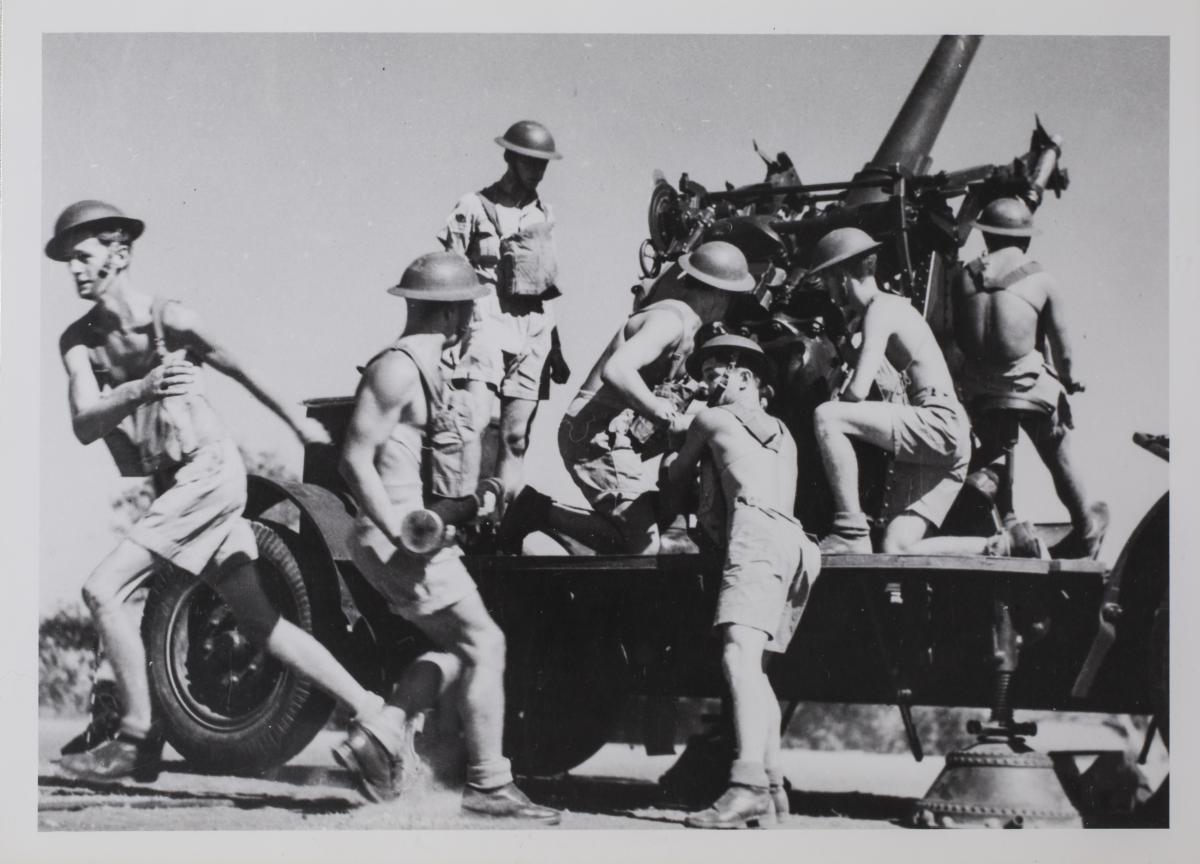
Photo 7_NTL-PH0115-0014. Photo courtesy Northern Territory Library
His Records of Service, available in the National Archives of Australia, provide:
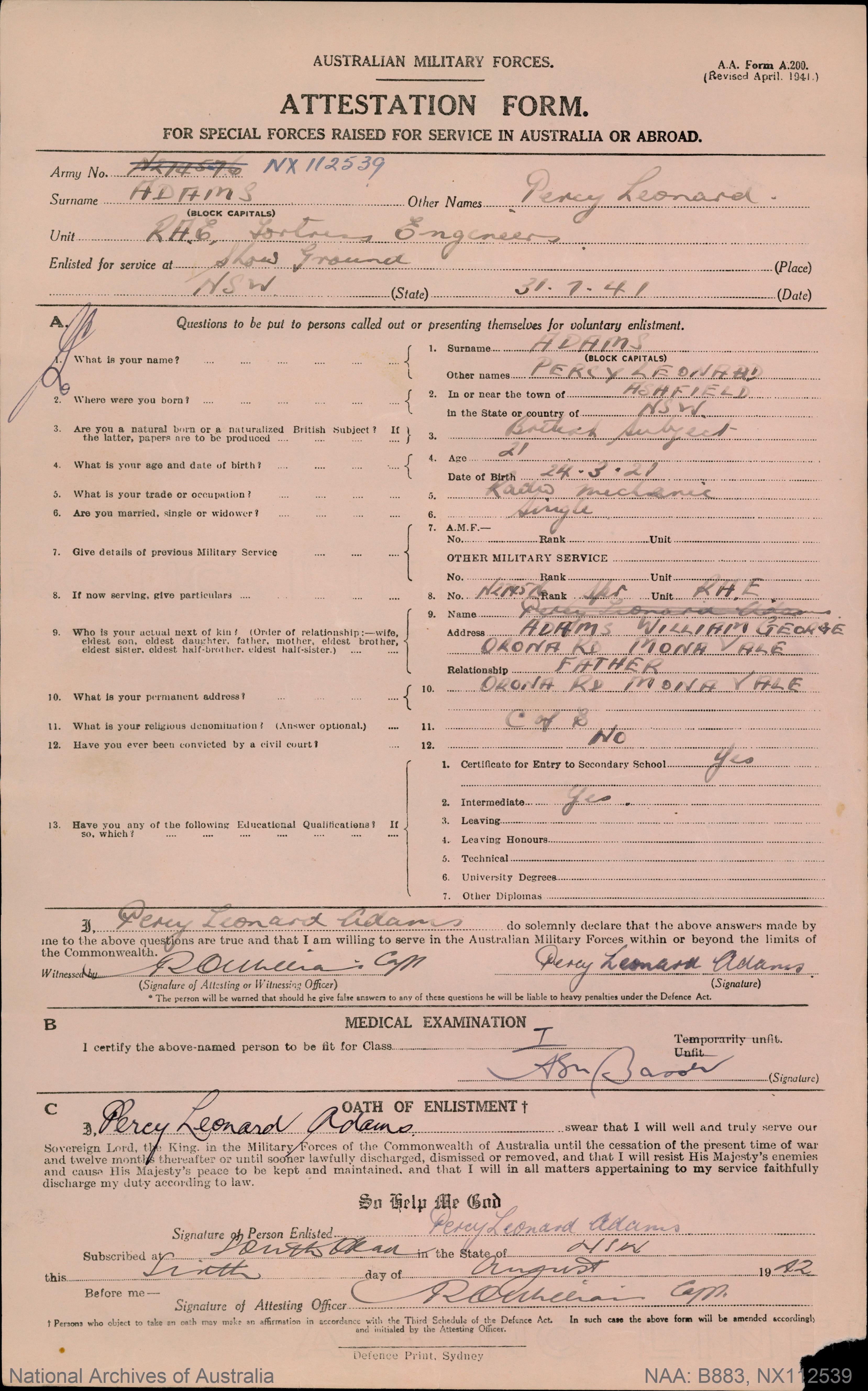
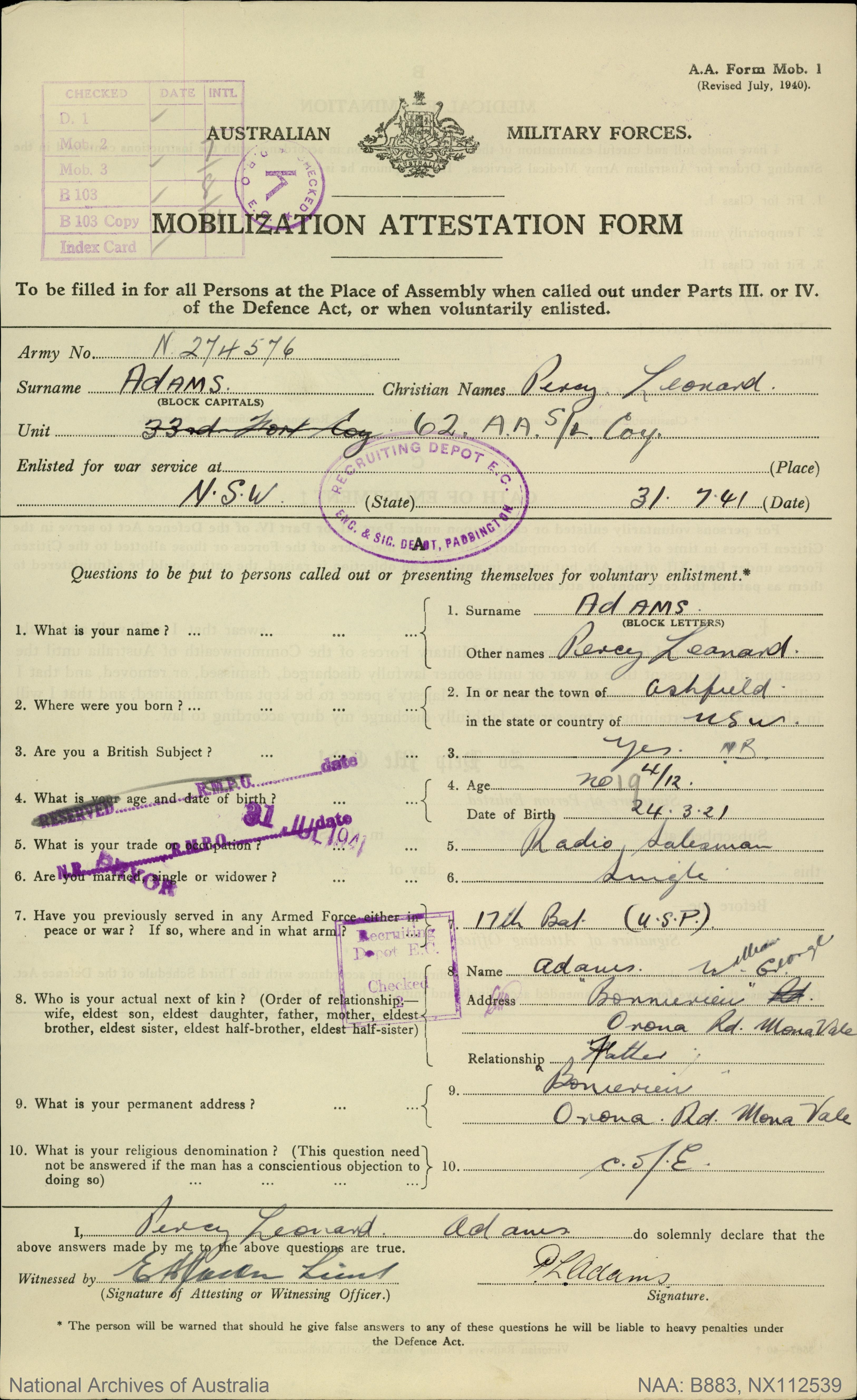
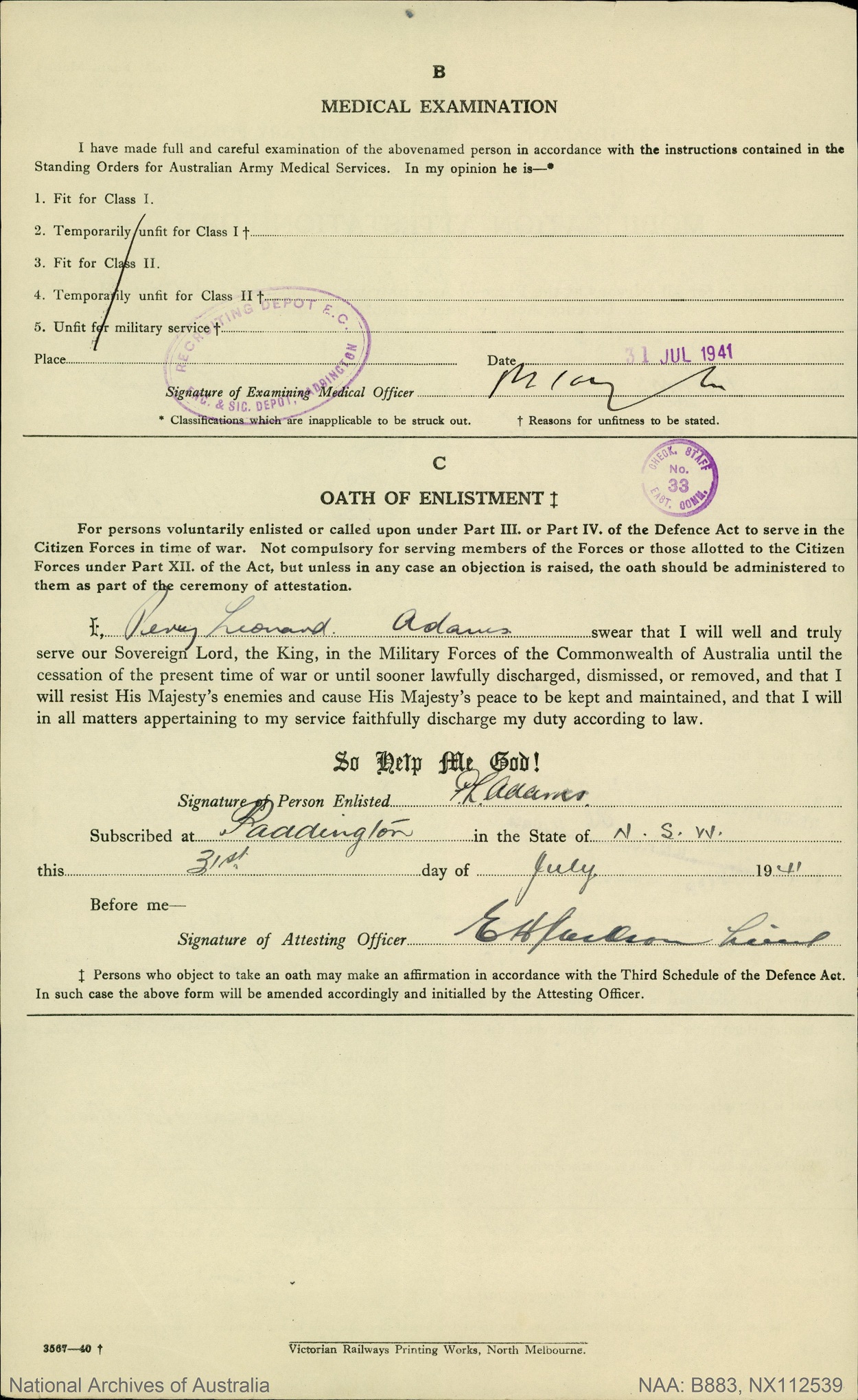
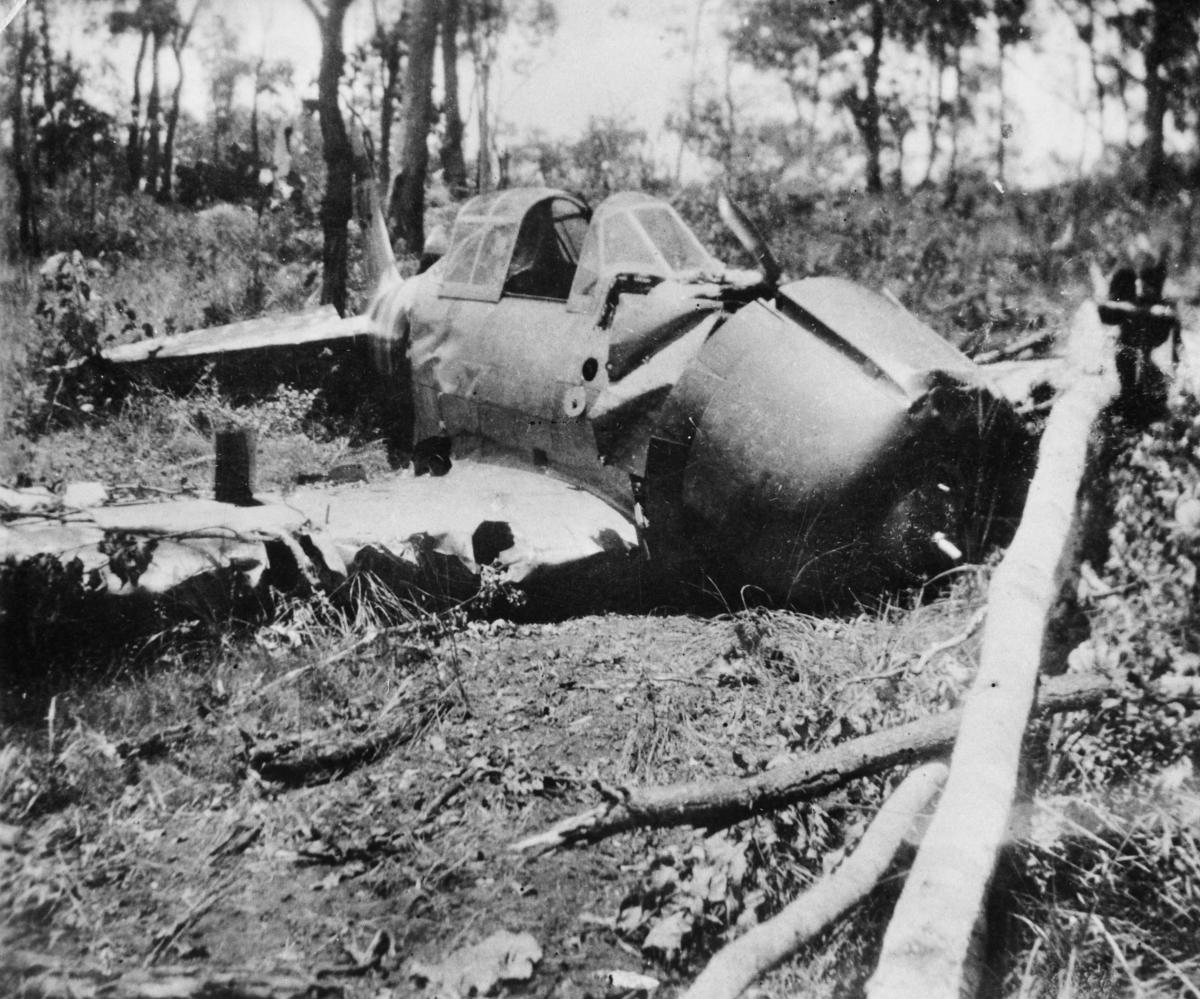
The Japanese lost four aircraft in the first raid – two Val dive bombers and two Zeke fighters. One of the fighters crash-landed on Melville Island, north of Darwin. Its pilot became the first prisoner of war taken on Australian soil when he was captured by Tiwi man Matthias Ulungura. Photo courtesy AWM
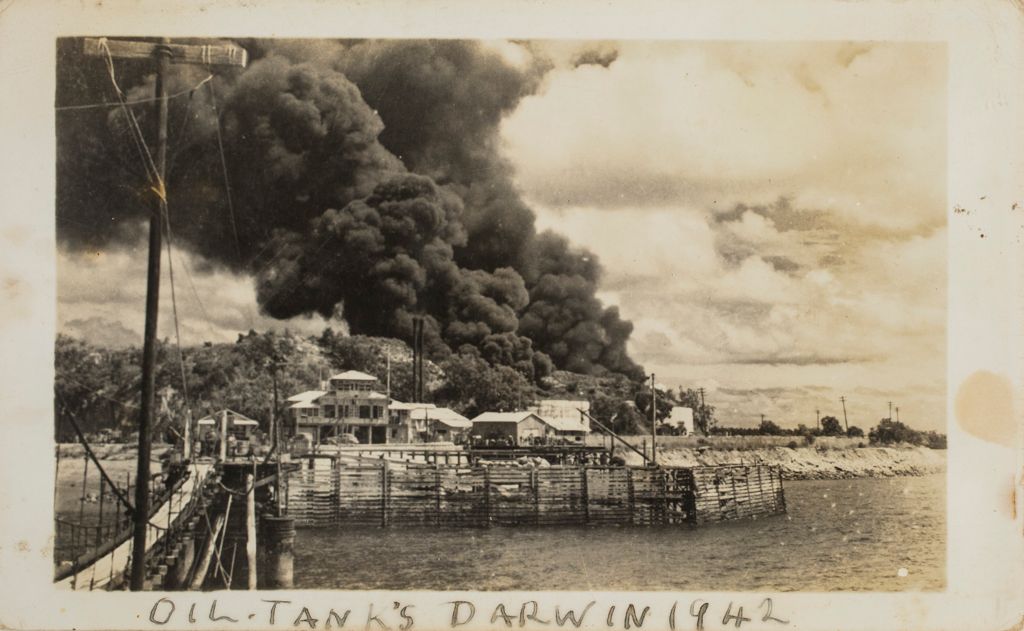
Oil tanks in Darwin on fire after bombing, 1942. Photo PH0808/0004, courtesy Northern Territory Library
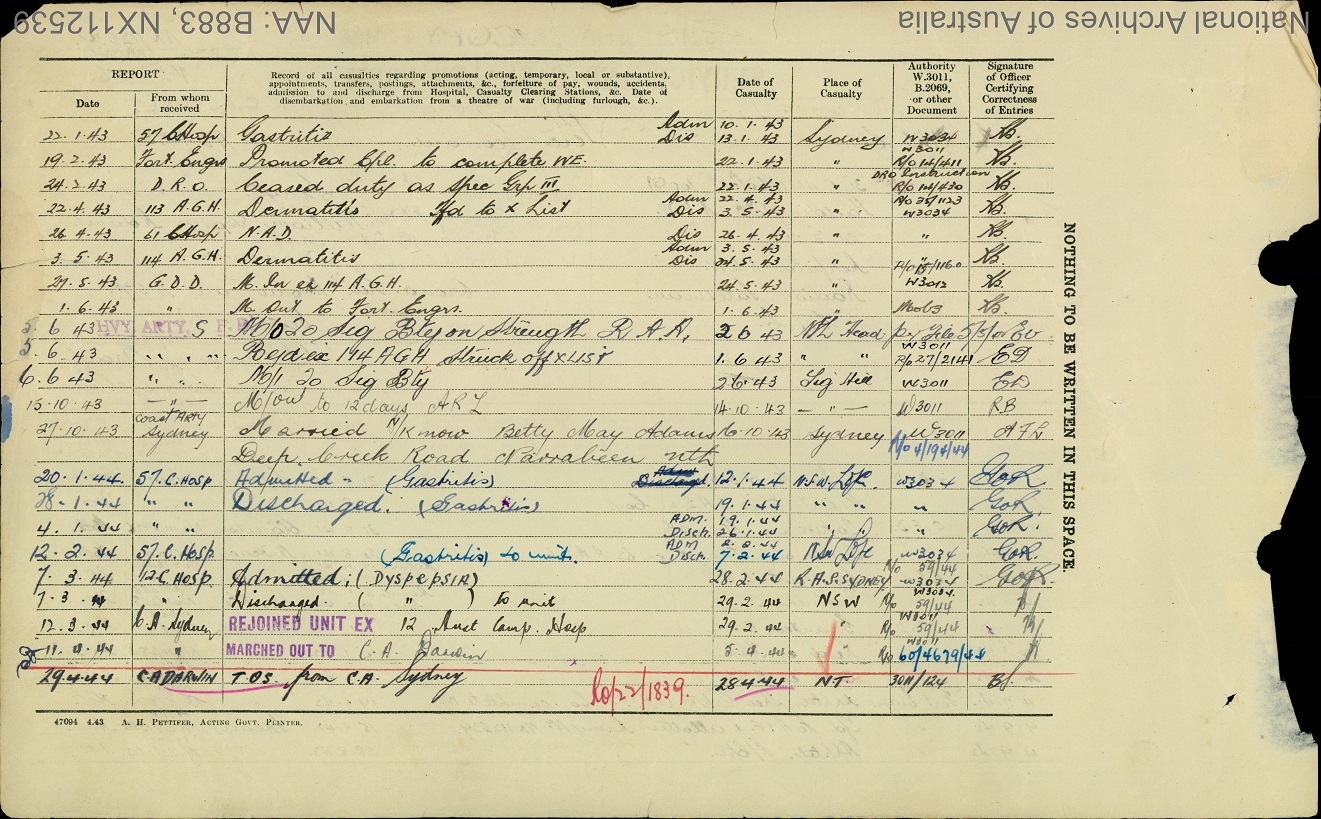
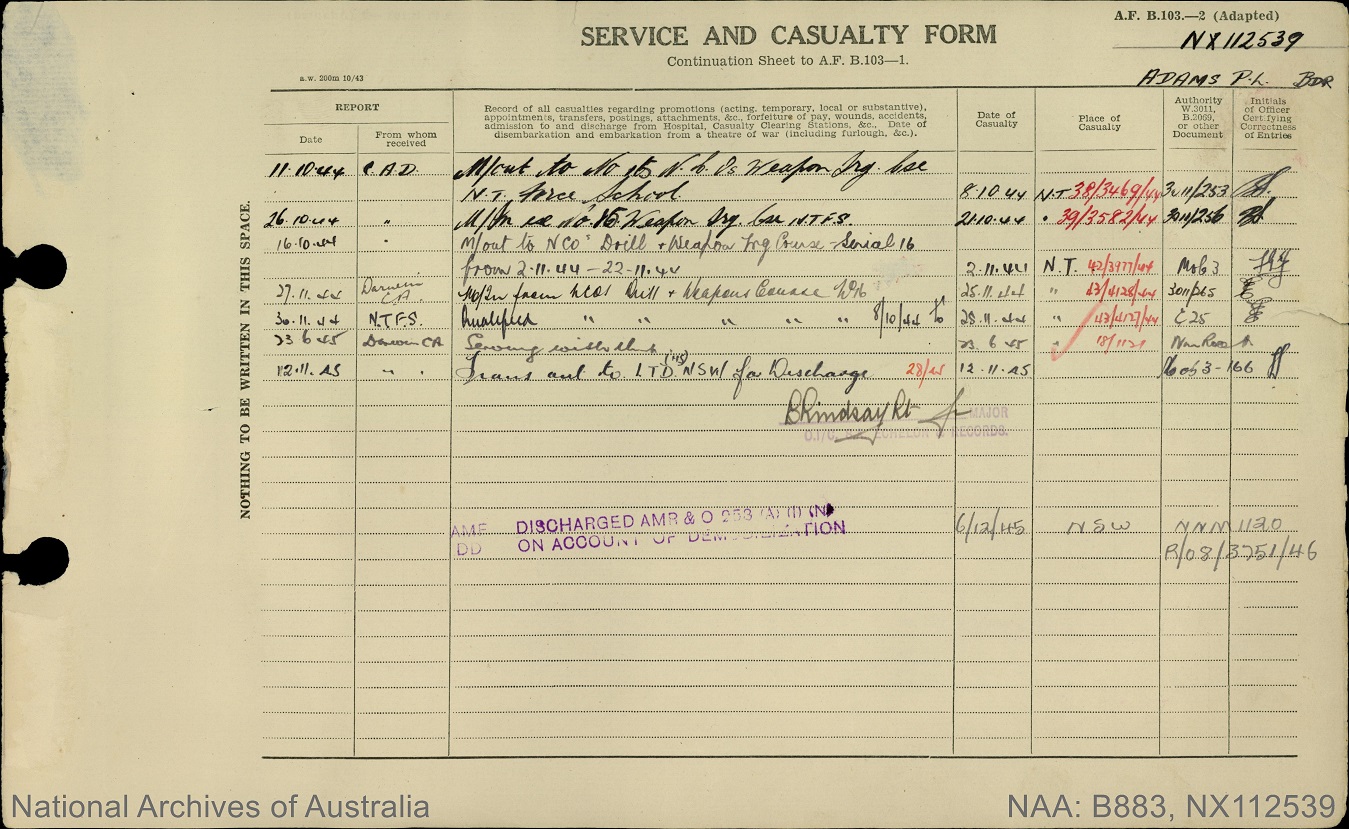
ALDRIDGE, P
Patrick Alfred Aldridge was born May 2nd 1918 at Kalgoorlie, WA. His mother, Margaret Alice Aldridge is listed as his NOK and he is married to Alice Iris Aldridge and living at Pitt Road North Curl Curl by the time he is discharged on February 12th 1946 with a rank of Sergeant (he served in the RAAF as a Cypher Assistant - Service Number - 71935).
Patrick is described as being 5 foot 5 with dark hair and hazel and eyes and a ‘red’ complexion – ruddy is what was probably meant. He is aged 24 years and 8 months when he enlists on October 27th, 1942 and is a Storekeeper prior to doing so. Although it may not appear to be a much needed Reserved occupation, it was as he is working at ACI Engineering.
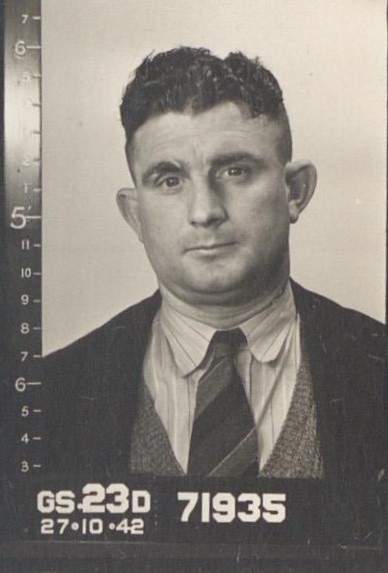
.jpg?timestamp=1731233232796)
He has to apply for permission, a release, to enlist:
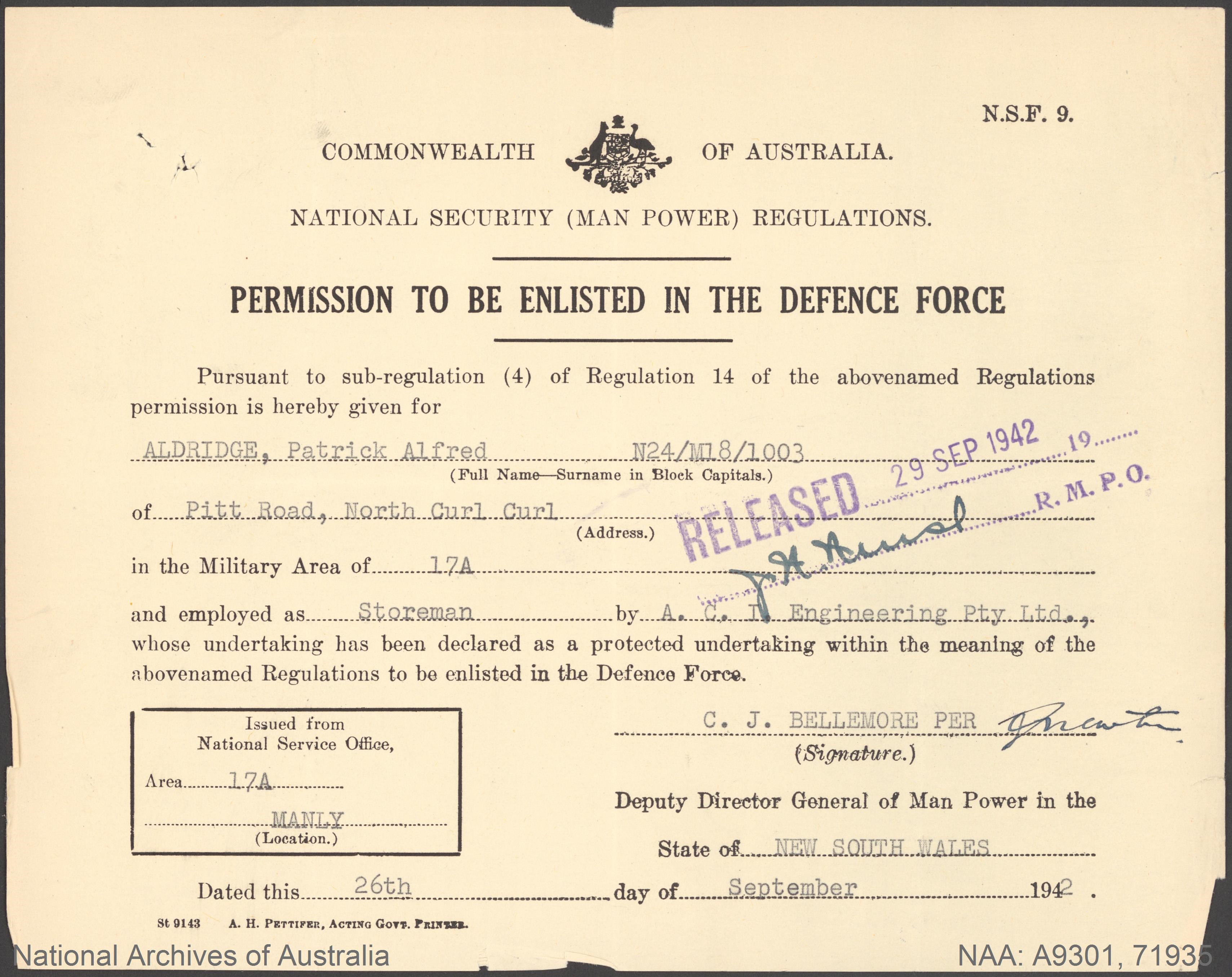

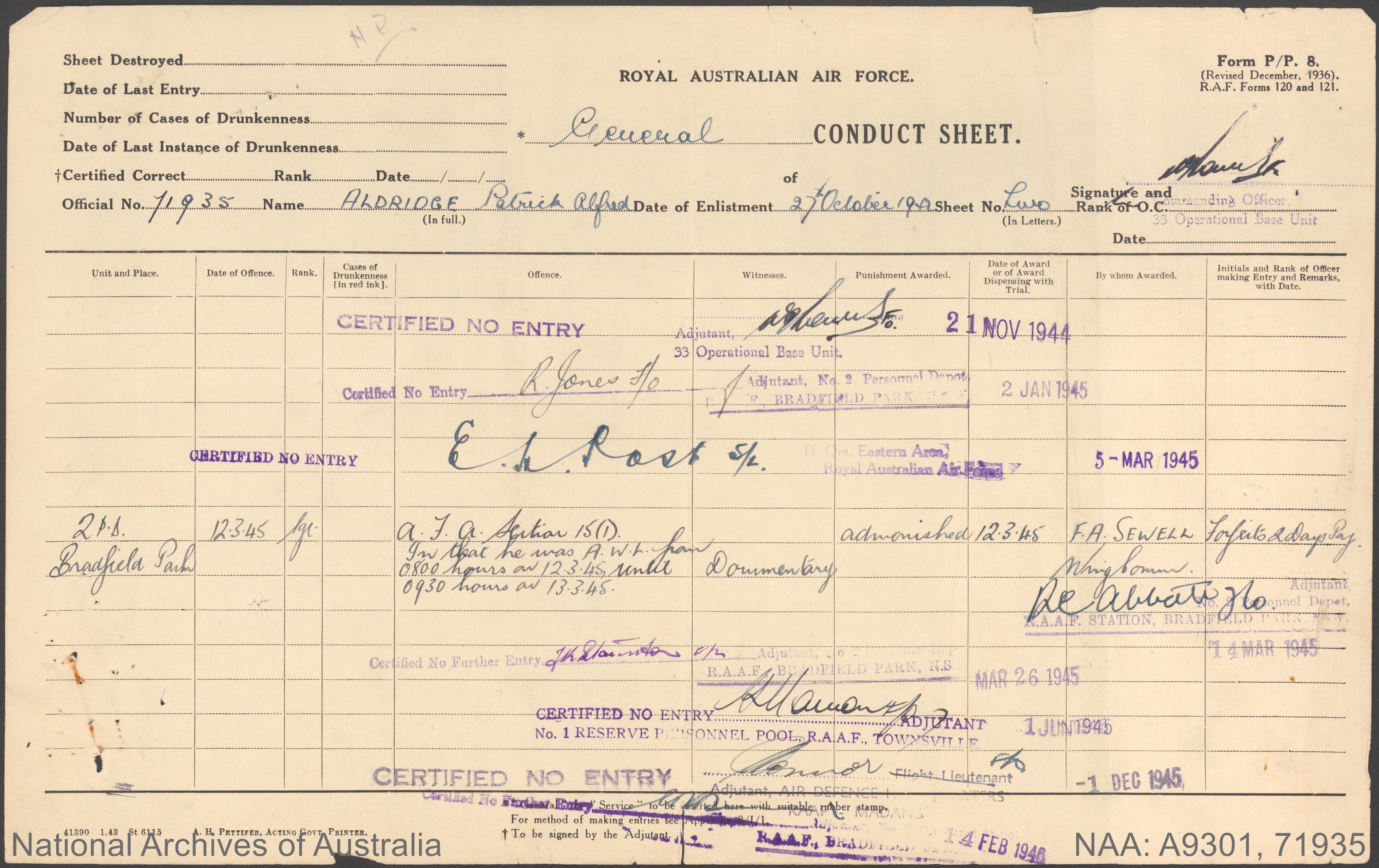
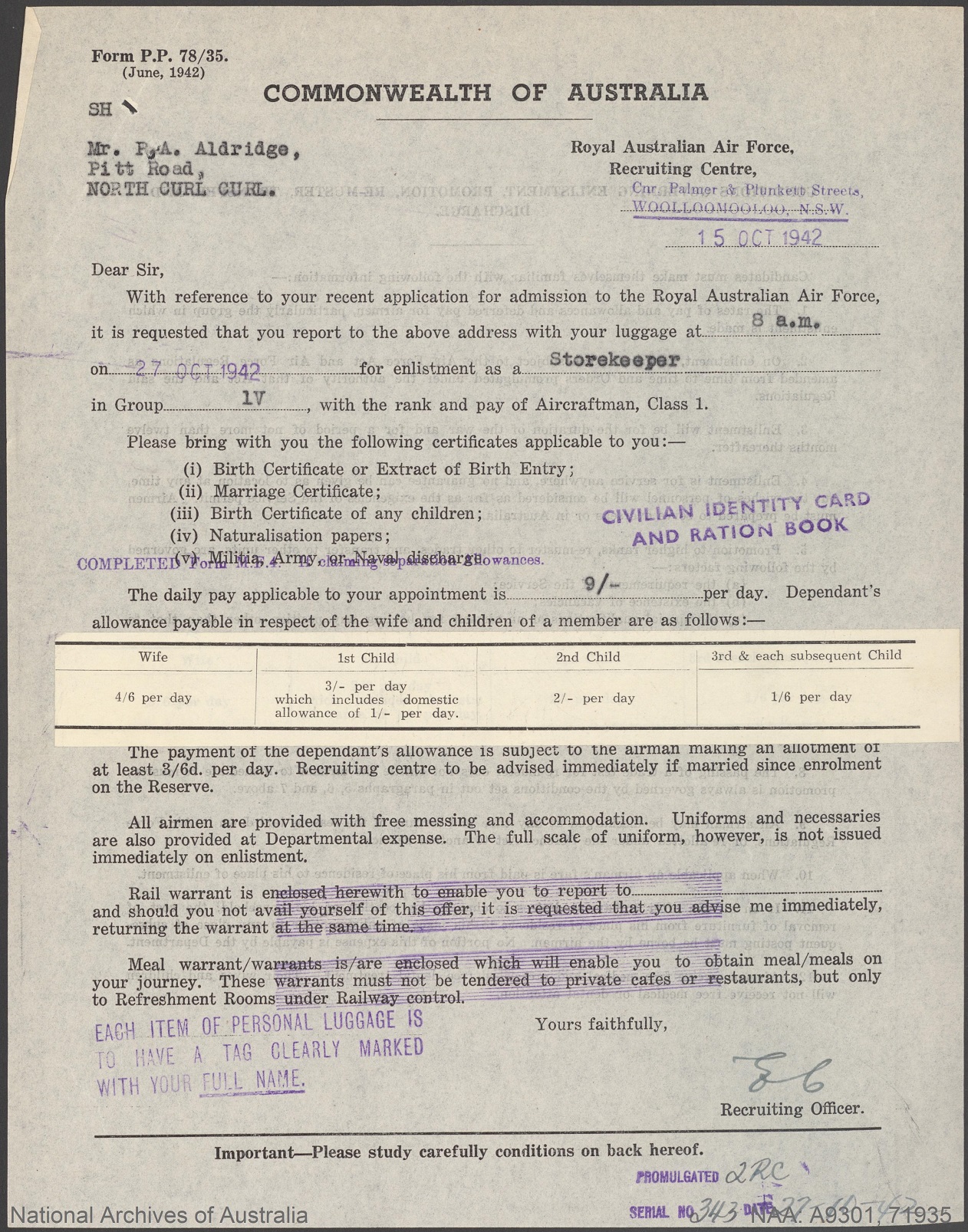
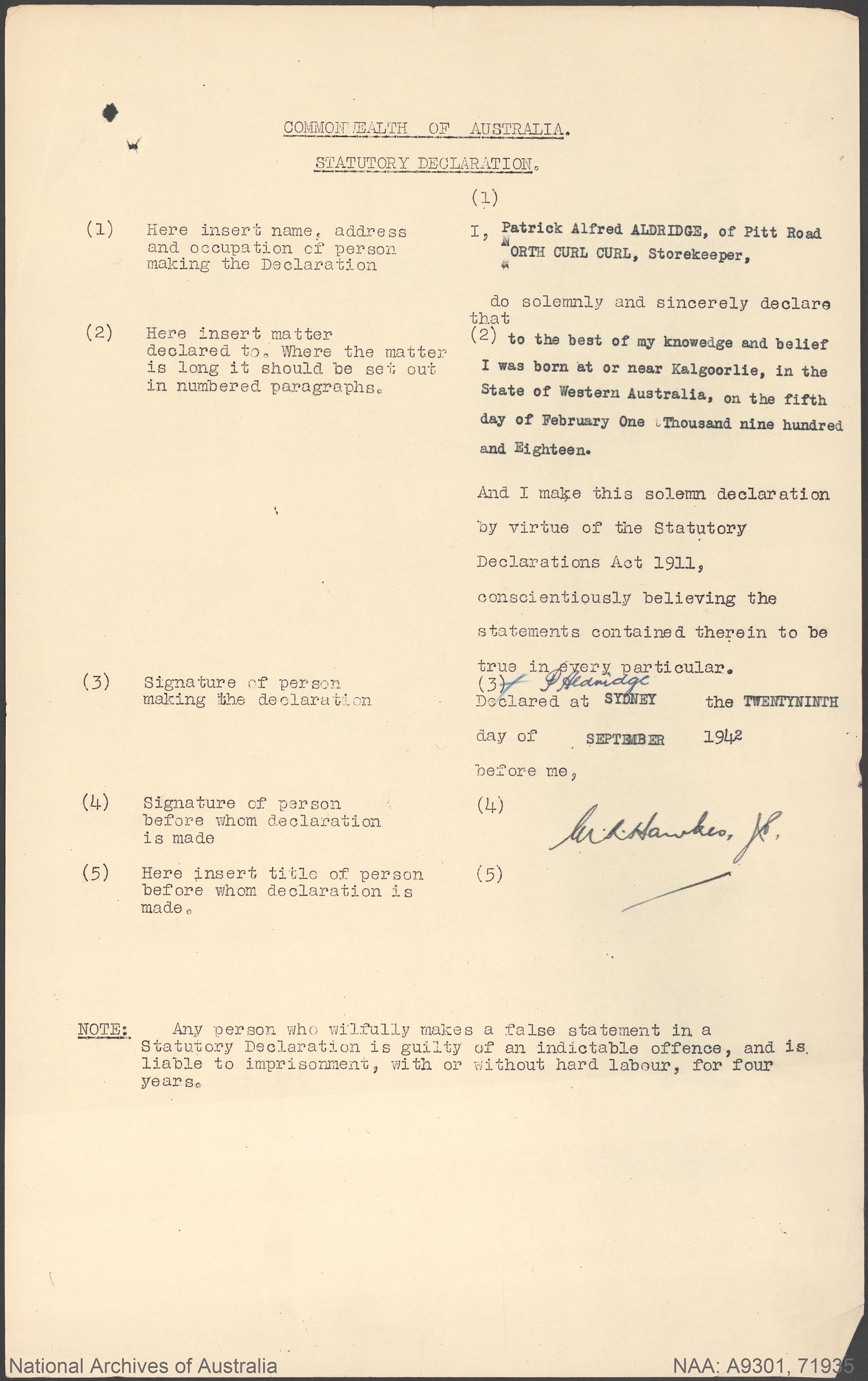
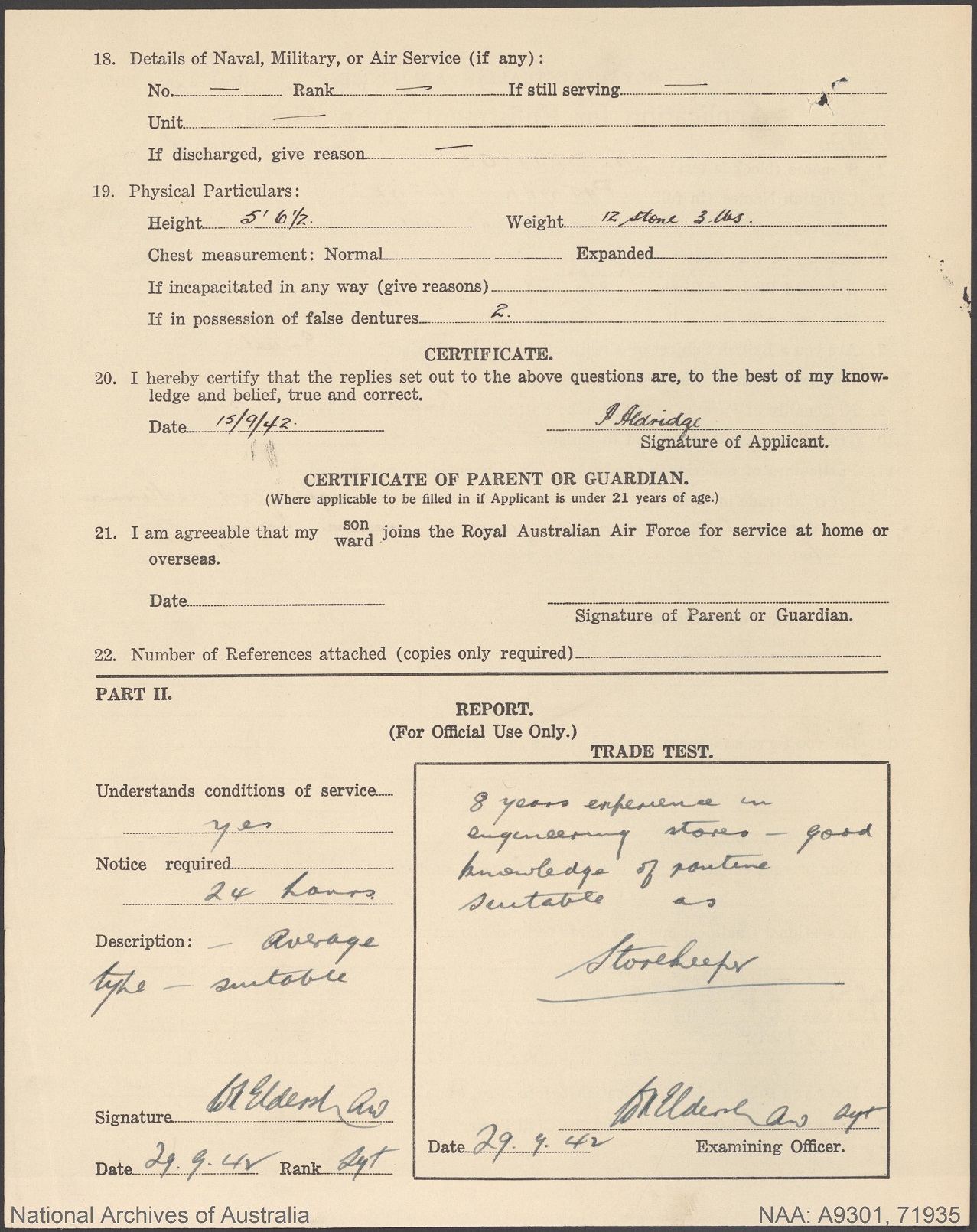
BALDWIN, C
Colin Francis Baldwin : Service Number - N461686 : Date of birth - 01 May 1925 : Place of birth - MONA VALE NSW : Place of enlistment - MANLY NSW : Next of Kin - BALDWIN WILLIAM
Colin is a Dairy Farm Worker prior to enlistment with his address being Gordon Road (Mona Vale Road - 'the road to Gordon') Mona Vale. He has blue eyes and light brown hair. He is just 18 years of age when drafted into the CMF. He serves for 240 days but is found Medically unfit for service and discharged to return home and continue ensuring everyone has their milk.
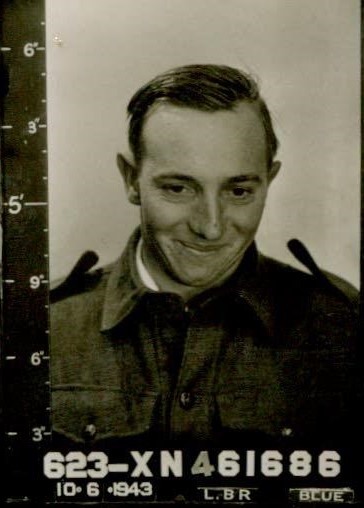
.jpg?timestamp=1731236525366)

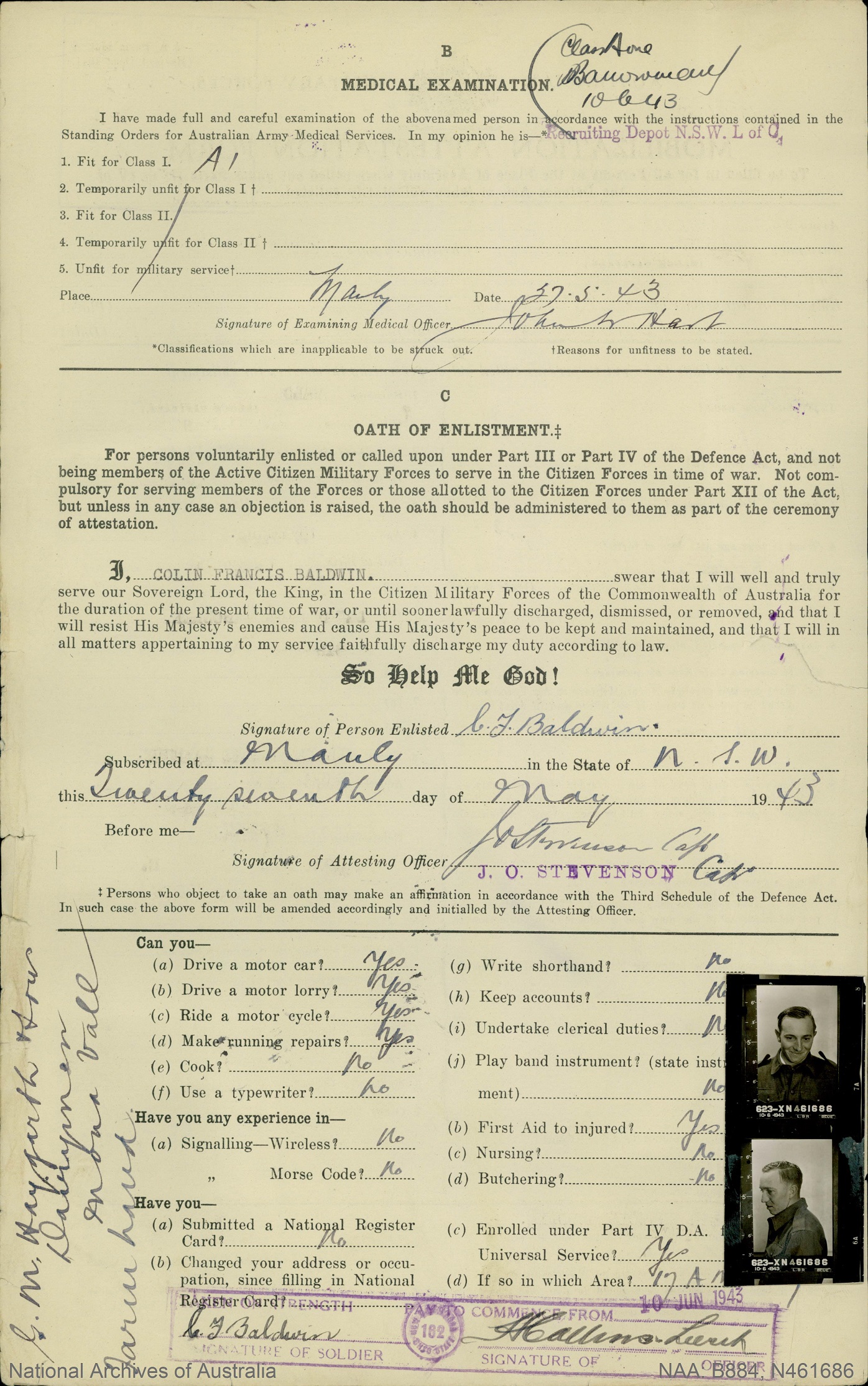
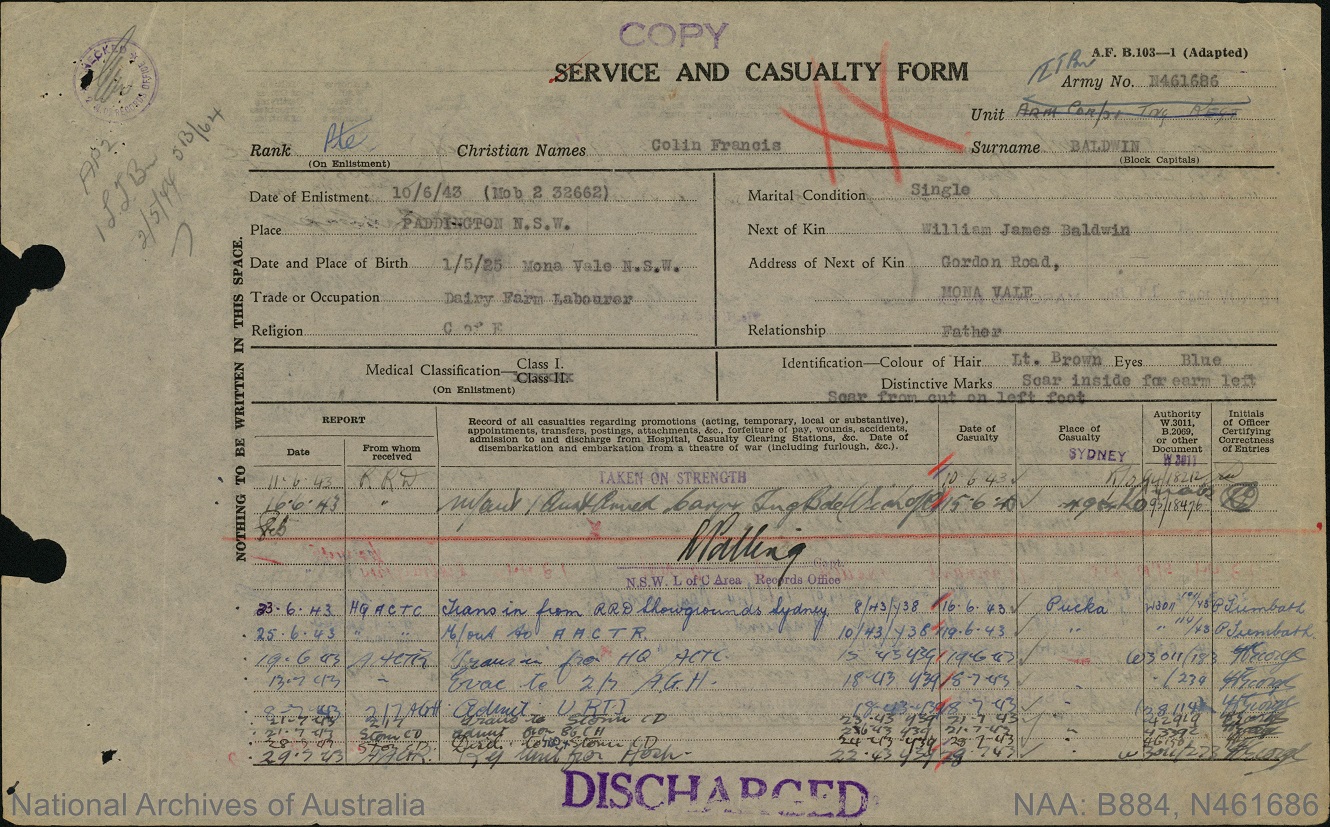
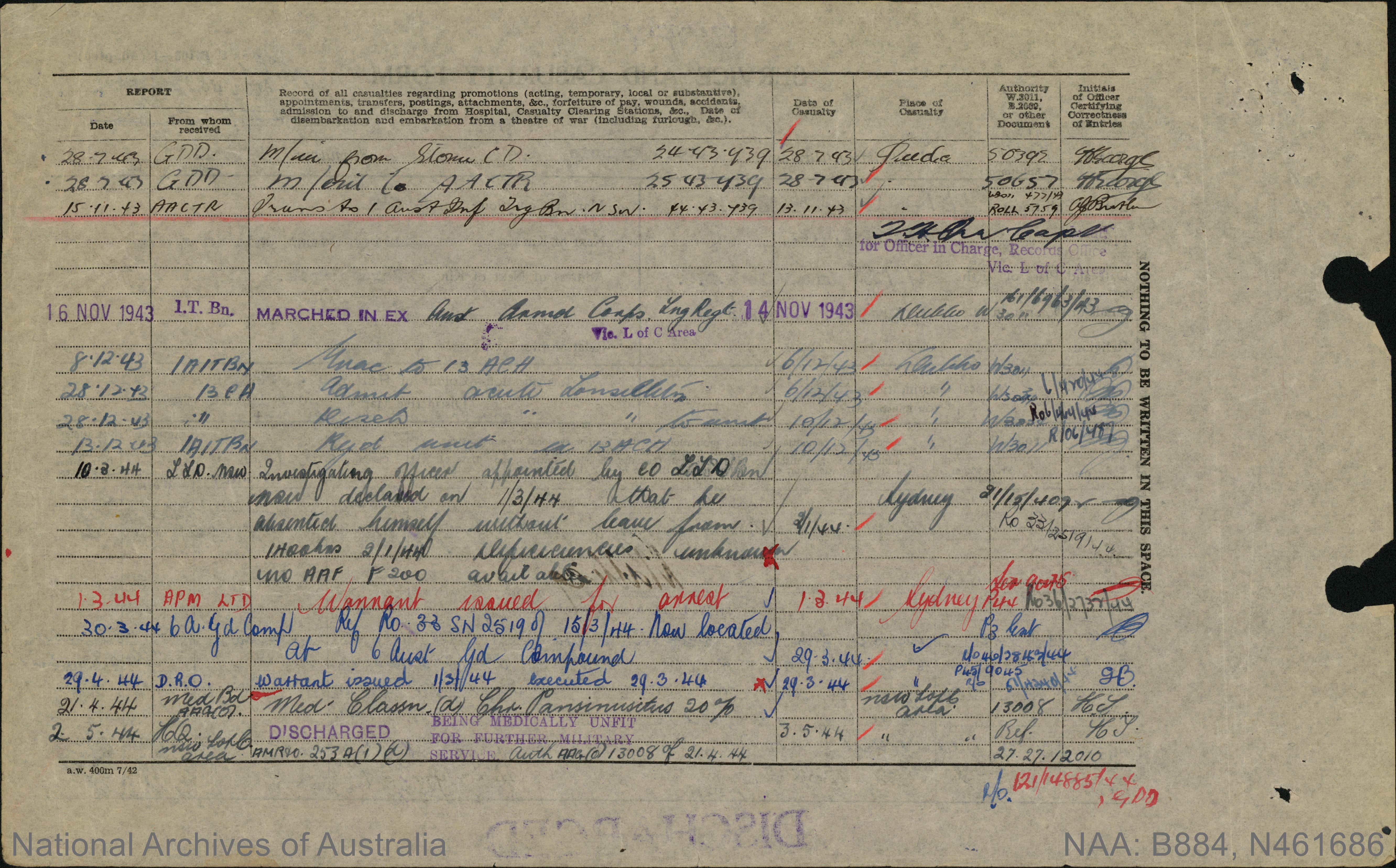

BILL, A
Albert John Charles Bill – Carrying Contractor, of Darley Street Mona Vale, born August 3rd 1913 at Mona Vale was 28 years and 5 months when he enlisted, and a married man. His wife was Edith May.
BILL ALBERT JOHN CHARLES : Service Number - N233880 : Date of birth - 03 Aug 1913 : Place of birth - MONA VALE NSW : Place of enlistment - MANLY NSW : Next of Kin - BILL EDITH
Rank: Gunner. Posting at Discharge 551 LT A A BTY
Albert is drafted into the CMF and sent into New Guinea.
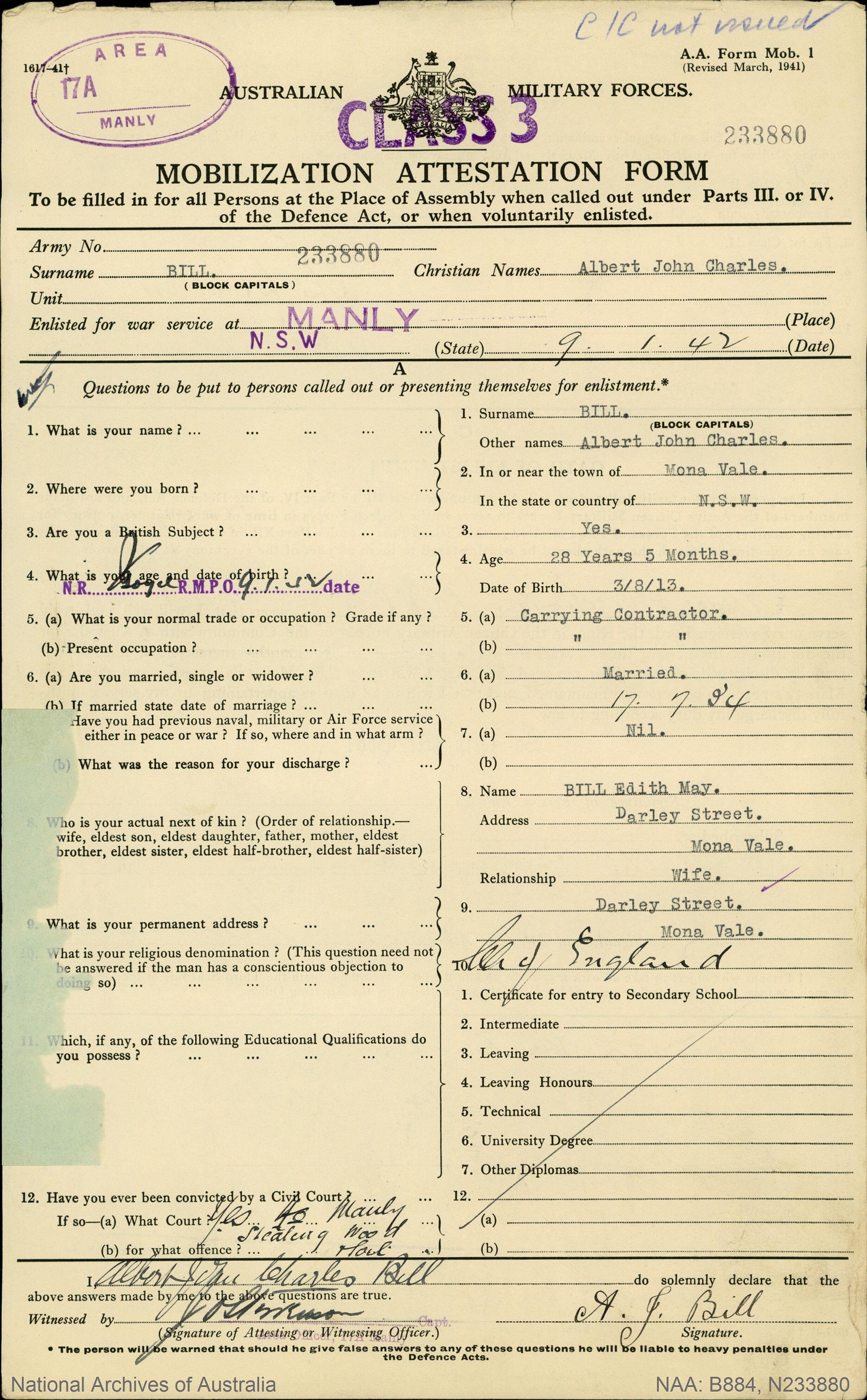
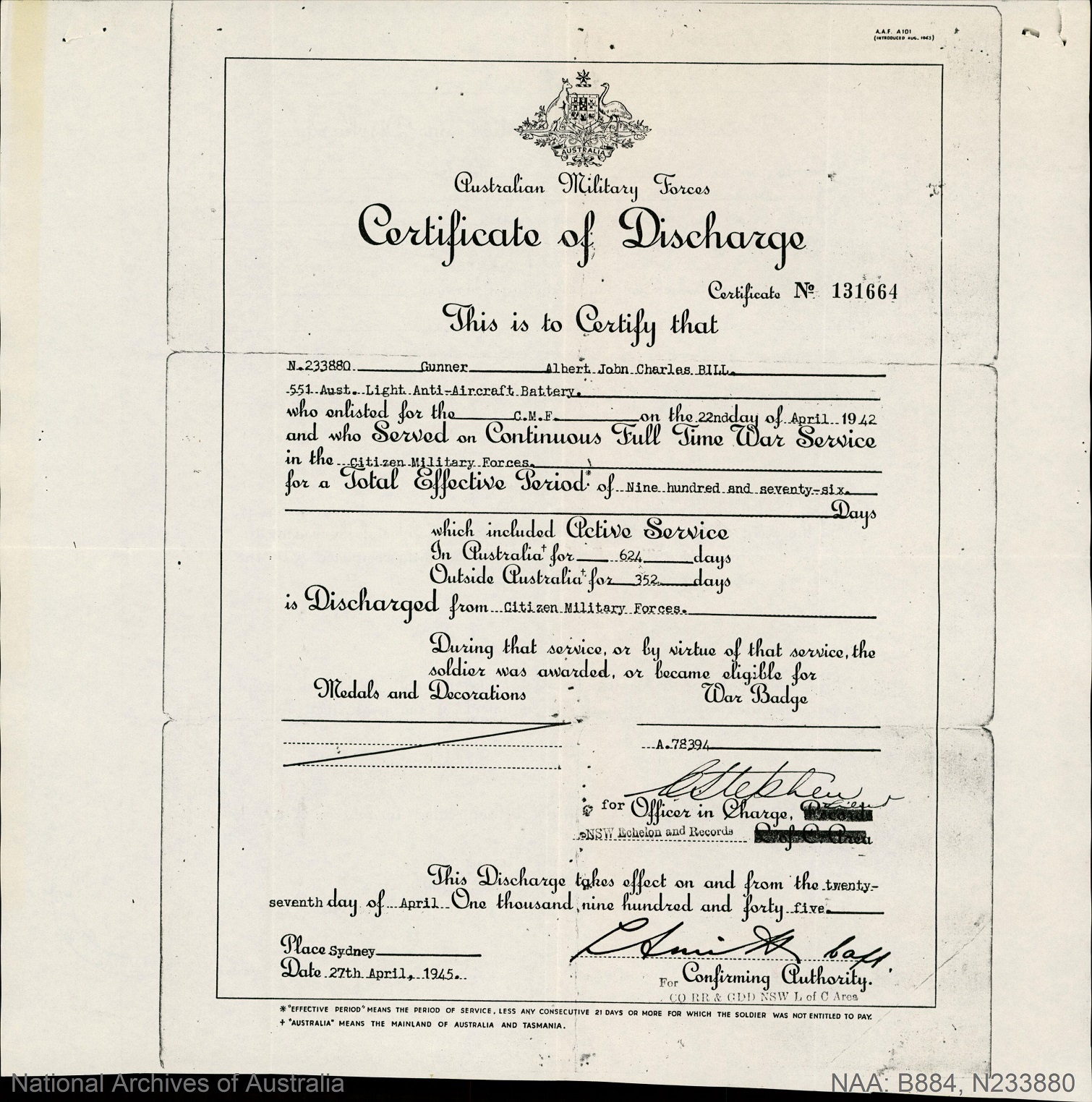
BIMSON, T
Thomas Herbert Bimson, of Warraba Road North Narrabeen, was born July 1st 1920, and is a Motor Driver Mechanic when he enlists on June 9th 1941, aged 20 and 11 months. His next of kin (NOK) is listed as Thomas Hargreave Bimson of Bay View Road Mona Vale. His mother is Emily Ann Francis Bimson (nee Lewis). His sister is Dorothy May Evers (nee Bimson). He is described as being 5 feet and 8 inches tall with brown hair, hazel eyes and with a fair complexion. He has a scar over his right ear.
Thomas is single when he enlists and married by the time his service ends on November 17 1945, and he has a rank of Lance Corporal. However, as with many marriages made during this conflict, the union does not last:
In Divorce Thomas Herbert Bimson v Betty Jean Bimson (formerly Jackson). Marriage, December, 1942. Issue, desertion. Mr. Toose (by Messrs. Michell and Gee) for petitioner. LAW COURTS REPORTS (1947, January 18). The Sydney Morning Herald (NSW : 1842 - 1954), p. 5. Retrieved from http://nla.gov.au/nla.news-article27905489
T H Bimson is seconded to the LHQ School of Signals and serves mainly at Bonegilla. Bonegilla Camp was used for groups in transit and as a base for training specialist units rather than initial recruits.
Bonegilla Camp – timeline courtesy THE ARMY AT BONEGILLA 1 9 4 0 - 7 1 retrieved from; https://historywodonga.org.au/wp-content/uploads/2020/08/THE-ARMY-BOOK.pdf
1940 June Funds allocated to build Bonegilla Camp.
July Builders began to erect about 600 huts. Sept Army moved in.
1941 Jan Governor-General visited and inspected Bonegilla. Dec Pacific War began. 1942-43 Bonegilla enlarged to 848 buildings. Training provided for small arms instructors, signallers, transport workers, bomb disposal and gas warfare personnel. 106 General Hospital received American and Australian soldiers often convalescing from malaria and tuberculosis (TB). An ordnance depot and vehicle park with engineering workshops for military vehicles and equipment established at nearby Bandiana. Service women undertake training at Bonegilla and Bandiana. 1943 Australia’s worst railway crash. Bus driver and 24 service members killed at a rail-crossing near Wodonga.
1944-47 Italian Prisoners-of-War held at Bonegilla and Hume Camp.
1944-46 106 General Hospital partly specialised in treating service personnel with TB.
BIRTLES, C
Calvert Gordon Birtles was born September 16 1926 at Grafton. He enlisted October 6 1944, aged 18 – occupation ‘Assistant Operator’ so possibly already helping his uncle Francis Birtles and father make films.
Date of Discharge: 20 May 1948, Rank: Lance Sergeant, Posting at Discharge: 1 CINEMA UNIT. NX191403 (N480444). His locality on enlistment is 15 Kitchener street ‘Oatley’ Sydney (his father’s Clive’s place; his father does turn up there in 1931, charged with stealing potatoes to feed his family).
.jpg?timestamp=1731010176182)
.jpg?timestamp=1731010213311)
Calvert undertook one of the more unusual roles during WW2 – although conscripted into the CMF as all others were, when he passed into the AIF afterwards he was attached to the Cinema Unit – which has some family precedents – read below.
He also went on to serve on tours of HMAS Kanimbla after peace had been returned.
HMAS Kanimbla was a passenger ship converted for use as an armed merchant cruiser and landing ship infantry during World War II. Built during the mid-1930s as the passenger liner MV Kanimbla for McIlwraith, McEacharn & Co, the ship operated in Australian waters until 1939, when she was requisitioned for military service, converted into an armed merchant cruiser, and commissioned in the Royal Navy as HMS Kanimbla.
Initially used to board and take control of merchant vessels belonging to Occupied Europe and operating in Asian waters, Kanimbla led the raid to capture the Iranian port of Bandar Shahpur in August 1941, and was present during the covert Japanese midget submarine attack on Sydney Harbour in 1942. In 1943, the ship was converted into a Landing Ship Infantry, transferred to the Royal Australian Navy, and operated throughout the South West Pacific Theatre until the end of the war.
Kanimbla was decommissioned and returned to her commercial owners in 1950. The ship was named for the Kanimbla Valley, west of Blackheath in the Blue Mountains in New South Wales. A Sydney Harbour ferry, launched in 1910 as Kanimbla gave up her name to the new larger vessel in 1936, and was renamed Kurra-Ba.
The ship arrived in Melbourne 12 June 1936 and operated a passenger service between Cairns and Fremantle. The ship accommodated 203 first class and 198 cabin class passengers. This passenger service continued until the outbreak of World War II.
Kanimbla carried its own broadcast radio station (call sign 9MI), which broadcast programs to onshore listeners and other ships, as it passed along the coastline. It broadcast on short wave, but sometimes its programs were relayed by onshore medium wave stations. It was conducted entirely by Eileen Foley. It broadcast between 1936 and 1939.
On 24 August 1941, as part of the Anglo-Soviet invasion of Iran, HMS Kanimbla carried an amphibious force that captured the port of Bandar Shahpur. She led seven other vessels, including the gunboat HMS Cockchafer, the corvette HMS Snapdragon, the naval trawler HMT Arthur Cavannagh, the sloop HMIS Lawrence, an oil rig tugboat, and a dhow. In addition, Kanimbla carried 300 Indian Army troops, including Gurkhas and soldiers from 3rd Battalion, 10th Baluch Regiment, whose task included securing the railhead, capturing eight Axis merchantmen (including the German cargo ship Hohenfels), two gunboats, and a floating dock. Kanimbla also provided artillery support with her deck guns.
On the night of 31 May 1942, Kanimbla was one of several Allied vessels located in Sydney Harbour, during the covert attack by Japanese midget submarines .
She arrived back in Sydney on 2 April 1943, was converted to a Landing Ship Infantry (LSI) and commissioned into the Royal Australian Navy as HMAS Kanimbla on 1 June 1943. She received the pennant number C78. In this configuration, she could carry 1,280 troops, and carried up to 22 LCVPs, plus two Landing Craft Mechanised.
The ship earned five battle honours for her wartime service: "New Guinea 1944", "Leyte Gulf 1944", "Lingayen Gulf 1945", "Borneo 1945", and "Pacific 1945".
.jpg?timestamp=1731010442834)
Photo: Kanimbla at Fremantle port, 1945, Unknown author - http://www.fremantleports.com.au
BIRTLES,
Calvert Gordon "Cal"
27th April 2014
At the Armidale Private Hospital of Armidale and formerly Heathcote.
Beloved husband of Judy. Loving father and father-in-law of Judith & John Christie, Margaret & Chris Cooper, Julie & Brett Lamond, Jonathan & Brenda and Michael & May. Loved grandpa and great grandpa.
Aged 87 years
PIDDINGTONS A.F.D.A.
BIRTLES, J
The only one listed is John David Birtles born September 22 1923 in Geelong Victoria, an older brother to Calvert. He enlisted on February 25 1942 and was discharged June 25 1946. Rank: Signalman. Posting at Discharge: SIGNALS 9 AUST DIV. Service Number: NX151283 (N241435) locality on enlistment is 15 Kitchener street ‘Oatley’ Sydney (his father’s Clive’s place; possibly meaning Kitchener street in St Ives, which adjoins Mona Vale road although there is a Kitchener street in Oatley as well), although he enlists at Kogarah.
His occupation is stated to be ‘Storeman’ and he is just 19 years. He is seconded to the 7 Tech Maintenance Unit. He has grey eyes, fair hair and is 5 feet 7 inches tall. He too was sent into Morotai towards the end of the conflict. Death: 2000 (aged 76–77) ; Burial. Kiama Cemetery. Kiama, Kiama Municipality, New South Wales.
His war records state he was a quiet type, and ‘who loses heart easily’ which makes you wonder what went on while he was growing up considering his father’s and uncles’ renown in Australia then. However this is just one person's insight in one moment; there must have been many other moments as he clearly 'went the distance' so must have much more heart than given credit for. Calvert also went the distance beyond the conflict and kept serving.
A few family insights on what these boys grew up around:
BIRTLES m Clive Irwin David. Clive Irwin David Birtles was born in 1894 in Collingwood, Victoria, Australia, the son of Sarah Jane (Bartlett) Birtles and David Birtles. Born 12 Jan 1894 Gender Male Buried 1973 Nambour Garden Lawn Cemetery, Nambour QLD.. Died 16 Sep 1973 QLD Age: 79y
Family MCGANN Olive Selina, b. 9 Jul 1900, Geelong VIC d. 20 Jun 1968, Caloundra QLD Find all individuals with events at this location (Age 67 years) They Married 1919 VIC
Children
1. BIRTLES Joan Selina
2. BIRTLES John David
3. BIRTLES Calvert Gordon
4. BIRTLES Robert Clive
Francis Edwin Birtles (7 November 1881 in Fitzroy, Victoria – 1 July 1941 in Croydon, New South Wales) was an Australian adventurer, photographer, cyclist, and filmmaker, who set many long-distance cycling and driving records, including becoming in 1927 the first man to drive a car from England to Australia. Birtles had set a speed record driving from Darwin to Melbourne the previous year. Birtles was the third child of David Edwin Birtles, an English bootmaker, and Sarah Jane Bartlett. At the age of 15, Birtles joined the merchant navy as an apprentice, but after the outbreak of the Second Boer War, he jumped ship at Cape Town, Cape Colony in 1899, in an attempt to enlist with Australian militia. However, he was attached to the Field Intelligence Department as part of a troop of irregular mounted infantry until May 1902. After a brief period back in Australia, Birtles joined the constabulary in the a mounted police officer in the Transvaal, until his police service ended when he contracted blackwater fever. Birtles returned to Fremantle, Western Australia, and on 26 December 1905 left to cycle to Melbourne, an achievement which attracted widespread attention as it was the first west to east bicycle crossing of the country. After a short stretch as a lithographic artist, in 1907–08, he cycled to Sydney and then, via Brisbane, Normanton, Darwin, Alice Springs and Adelaide back to Sydney, where he based himself. In 1909 he published the story of his feat, "Lonely Lands", which he illustrated with his own photographs. That year he also set a new cycling record for the Fremantle to Sydney continental crossing. In 1910–11 he rode around Australia. In 1911, he was accompanied from Sydney to Darwin by R. Primmer, cameraman for the Gaumont Company. The resulting film "Across Australia" was released the next year. Birtles had continued on to Broome and Perth, then broke his previous records by riding from Fremantle to Sydney in thirty-one days. By 1912, he had cycled around Australia twice and had crossed the continent seven times.
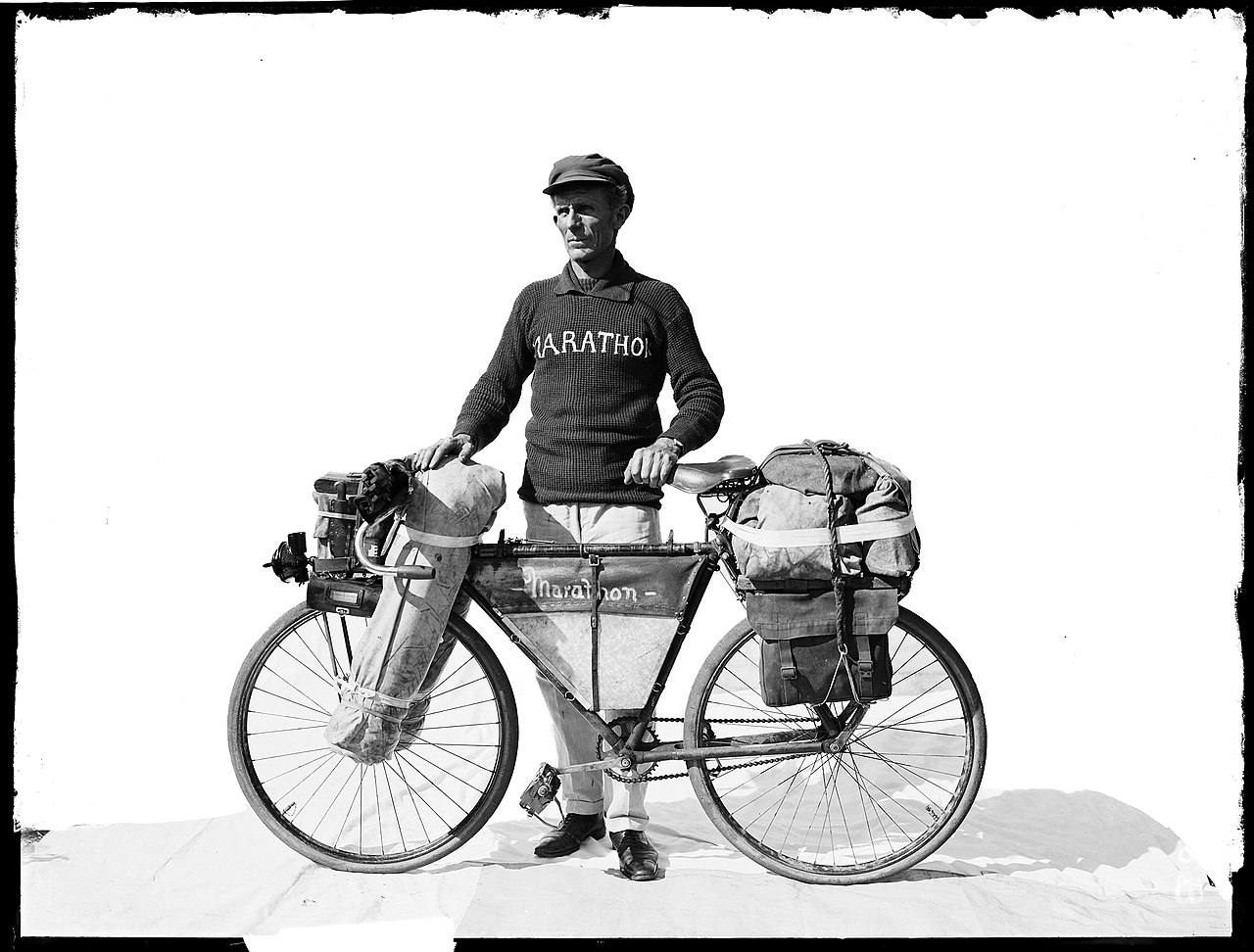
Photo; Francis Birtles with bicycle loaded for marathon cross-country ride, ca. 1920, Arthur Ernest Foster and one more author - State Library of New South Wales,
CYCLING; CLIVE BIRTLES. SETS OUT FOR PORT DARWIN.
Riding the "Universal" bicycle, fitted with an Eadie coaster two-speed hub, upon which his brother Francis has journeyed around Australia and established the overland cycling record from Perth to Sydney, Clive Birtles, 20 years of age, set out yesterday on a 1500 miles trip to Hughenden, where he will join the world-famed overlander in a final dash through the little-known country of the Northern Territory to Port Darwin. Clives's first objective is Bourke. He will then pass through Cunnamulla, Charleville, Berkan, Barcaldine, Aramac, and Muttaburra. The trip is expected to occupy about 30 days, and the brothers hope to have completed their travels and be back again in Sydney before Christmas.
Weighed immediately before starting Clive's machine scaled 119lb, and, festooned with rifle, tent, blankets, and cooking utensils, had the appearance more of a caravan than an ordinary roadster machine. Al-though, in addition, the rider weighed 164lb, Dunlop carvas-lined 28in x 1½in smooth tread tyres were deemed sufficient to tarry that ungainly load through bush and plain. Mr. Sam Hordern bade the plucky rider adieu at the George-street emporium of the firm, and the cyclist was accompanied for some distance along the road by Mr. R. S. Gillett (managing director Horderns, Ltd.), Mr. C. U. Sherwood (Dunlop Company), and it number of pressmen in motor cars. CYCLING. (1913, August 12). The Sydney Morning Herald (NSW : 1842 - 1954), p. 12. Retrieved from http://nla.gov.au/nla.news-article15442472
ANOTHER OVERLANDER. FRANCIS BIRTLES' BROTHER.
Clive Birtles, a brother of Francis Birtles, left A. Hordern and Sons, Ltd., this morning for Hughenden, Queensland, to join his brother. Young Birtles rode the same bicycle on which Francs established a record from Fremantle to Sydney a couple of years ago. Birtles has a ride of about 1500 miles In front of him, and strapped to his bicycle was equipment weighing 1201b. It consisted of a tent, cooking materials, a rifle, and other necessaries for camping out. Birtles will go to Bourke, Cunnamulla, Charleville, and Muttaburra. ANOTHER OVERLANDER. (1913, August 11). The Sun (Sydney, NSW : 1910 - 1954), p. 7. Retrieved from http://nla.gov.au/nla.news-article229676781
In 1912, Francis Birtles became one of the first people to make a west to east crossing by car from Fremantle to Sydney in a Brush Runabout with driver Syd Ferguson.
On 21 September 1912 Birtles with his brother Clive and bulldog 'Wowser' left Melbourne in a blue 20 hp Flanders touring car to drive to Sydney, Brisbane, Charters Towers and then to the Gulf of Carpentaria. From the Gulf he drove close to the Northern Territory border and he arrived back in Melbourne in January 1913.
_(15161043018).jpg?timestamp=1731010722958)
Photo; Clive Birtles at the wheel of the car with the dog, Wowser. c.1915, courtesy National Library of Australia from Canberra, Australia - [Clive Birtles at the wheel of the car with the dog, Wowser]
CLIVE AND FRANCIS BIRTLES.
Mr. D. Birtles, of Canterbury, informs us that he has received a communication from the "Daily Mail", Brisbane, stating that his sons, CIive and Francis, who recently under- took a motor-car trip across Australia, have been entirely exonerated in the cases in which they were charged, Clive having obtained three motor-car tyres under false pretences at Cloncurry (Q. ), and the two brothers jointly with having stolen a Ford motor engine and carburetter at Burke-town (Q.) CLIVE AND FRANCIS BIRTLES. (1917, May 19). The Argus (Melbourne, Vic. : 1848 - 1957), p. 21. Retrieved from http://nla.gov.au/nla.news-article1619192
On Saturday, 13 February 1915 Birtles left Sydney for a six-month-long motoring tour following Burke and Wills' track. Birtles took a movie camera and made a cinematographic record of the journey. Birtles reached Broken Hill on 25 February and Adelaide on 1 March, where he spent two weeks recovering from an illness, before driving to Burra, Port Augusta, Quorn, and Maree to Cooper Creek. Birtles reached Normanton on Saturday, 5 June 1915, and then drove to Melbourne via Cape York, Einasleigh, Hughenden, Tambo, Roma, Toowoomba, and Brisbane, arriving in Melbourne at the end of September 1915 having covered 7,000 miles in seven months. He then drove from Melbourne to Swan Hill and Menindee to finish the movie of the Burke and Wills' track. The film was called 'Across Australia: In the Tracks of Burke and Wills' and was released by The Co-Operative Film Exchange Ltd of Melbourne, and opened in Melbourne at Hoyt's Olympia Theatre on Christmas Day 1915.
THREE MONTHS' TOUR
Clive Birtles' Motor Holiday Scheme
GEELONG, Wednesday. — A throe months' motor tour Is being organised by Mr Clive Birtles, from Geelong to the Gulf of Carpentaria. Mr Birtles is a brother of Francis Birtles. and himself has done much exploratory work. For some time Mr Birtles has been working out a scheme for taking 25 men on a trip through sonic of the most interesting parts of Australia where shooting and fishing can be freely Indulged In. A 45 h.p. De Dion Bouton passenger chassis is being fitted with a five-ton body, with accommodation for the 25 passengers. A trailer equipped with a, kitchen is to go with the party. It Is proposed. to start from Gee-long on August 1G, and calls will be made at Sydney and Brisbane. Then the rough country of Queensland will be gone through. A light car will precede the big bus for the purpose of picking out the route. Mr Birtles expects no difficulty in filling up the passenger list at £100 each. A fortnight will be spent in the Gulf country. THREE MONTHS' TOUR (1924, July 23). The Herald (Melbourne, Vic. : 1861 - 1954), p. 3. Retrieved from http://nla.gov.au/nla.news-article246164907
As a publicity stunt, Francis Birtles was commissioned by Barlow Motors, the Melbourne agent for the Bean cars, to drive a modified Bean 14 car from Darwin to Melbourne. In addition to the Bean sponsorship, Birtles' fuel was provided by the British Imperial Oil Company, the Castrol was provided by Sir Charles Wakefield, and the tyres were provided by Dunlop Rubber. With his co-driver Alec Barlow, they left Darwin at 4 am on 23 October 1926 and completed the 5,440 km (3,380 mi) journey in eight days and 13 hours, a record. The car was dubbed the Sundowner.
Following this success, Birtles was asked to make an attempt at becoming the first person to drive from England to Australia. He departed from Australia House in London on 19 October 1927, farewelled by a crowd of wellwishers including the 1927 Miss Australia. In an era when there were few roads and gasoline supplies sparse, the epic eight-month journey carried him across mountains, deserts and through tropical jungles and included a number of sea voyages – the last being from Singapore to Darwin. He travelled via Europe, Egypt, Persia (now Iran), India, Burma and Malaya.
On arrival in Darwin, his car was seized by customs officials demanding import duty, until direct intervention by the Prime Minister Stanley Bruce averted the situation. He continued south via Brisbane and Sydney to the official finishing point of the journey at the General Post Office on Elizabeth Street, Melbourne on 25 July 1928. He was promptly asked to move on by a policeman for obstructing traffic.
.jpg?timestamp=1731244919959)
Photo; Birtles' Oldsmobile 30 used for the Darwin to Adelaide overland speed record trip 1924
The journey was not repeated until 1955.
Birtles had completed more than 70 transcontinental crossings of Australia by mid-1927, details of which were described in his book Battle Fronts of Outback (1935).
In 1929, the Bean car was presented to the Australian Government on condition that it be placed in the national museum. As there was no such museum at the time, the car disappeared for many years before being recovered in the 1960s and placed into the National Motor Museum in Adelaide in 1980 before moving to the National Historical Collection in the National Museum of Australia in Canberra in 2001.
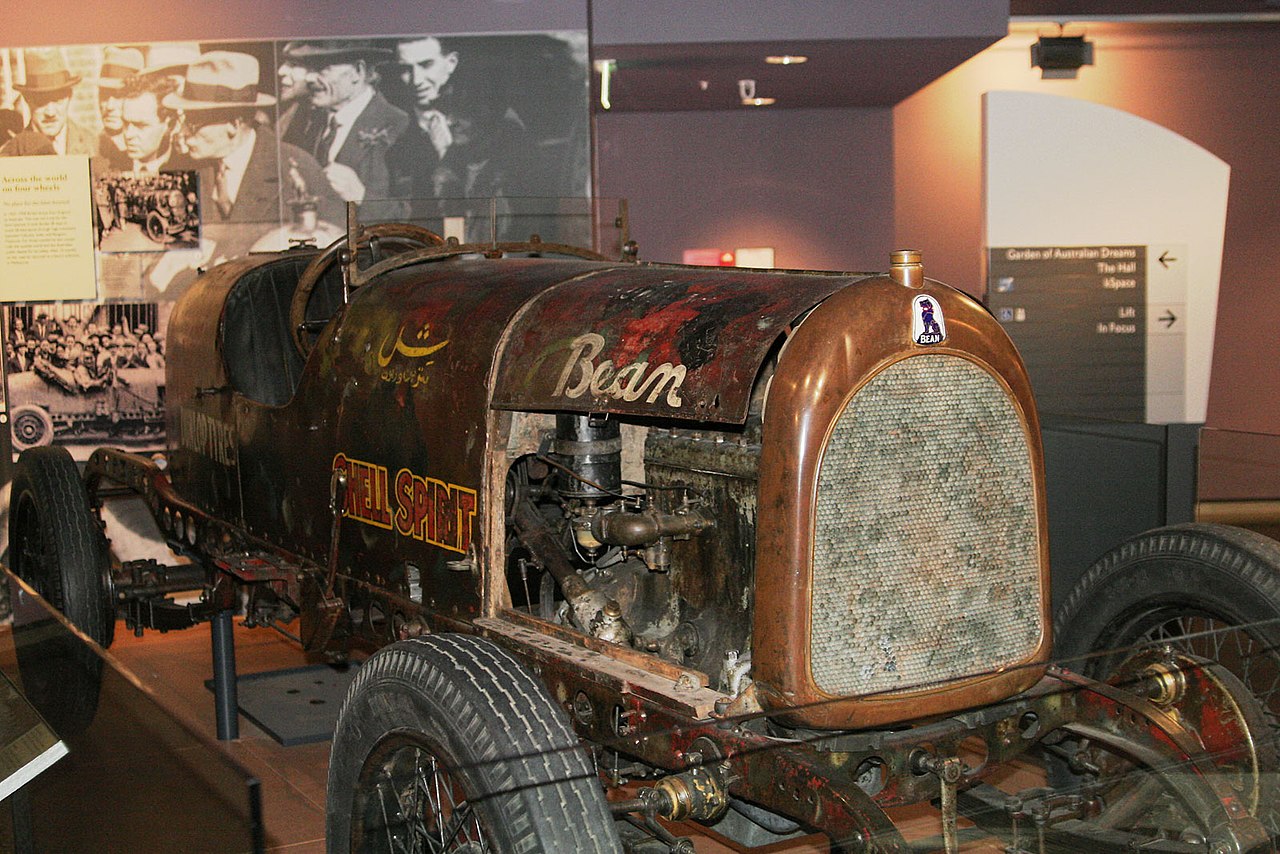
Photo; Sundowner, the record breaking Bean 14. Pic: fir0002
In 1933, Birtles travelled to Arnhem Land with a prospecting and mining expedition in search of gold, after having found some several years previously during one of his journeys. He subsequently sold his share in the mining stake and retired a wealthy man.
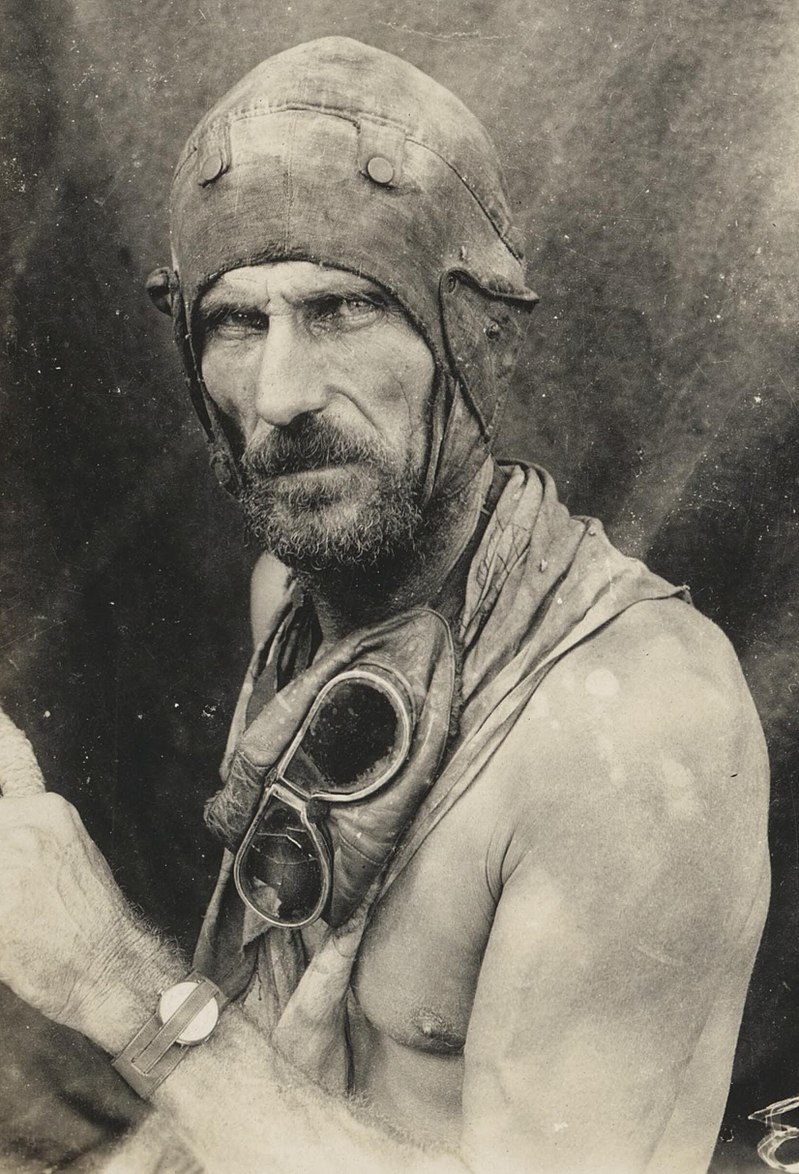
Photo: Birtles in Arnhem Land by Unknown author - Francis Birtles motor car tour collection
Birtles also made several films of his encounters with the outback and Indigenous Australians including Across Australia with Francis Birtles (1912), Into Australia's Unknown (1914) and Coorab in the Island of Ghosts (1929).
Birtles was married twice. Birtles married Frances Knight on 27 November 1920 at St Paul's Cathedral, Melbourne, but they soon separated and she divorced him in 1922. Birtles married Nea McCutcheon on 11 February 1935 at St Mary's Cathedral, Sydney, and they were together until he died at the Sydney suburb of Croydon of coronary vascular disease on 1 July 1941. Birtles is buried in the Anglican section of Waverley Cemetery.
_(2).jpg?timestamp=1731244983216)
Photo; Frances and Nea Birtles in 1935 - State Library of New South Wales from Australia - Francis Birtles, his wife of less than two months, Nea, and his touring car in front of the Public Library of New South Wales, Sydney, 9 May 1935 / photographer Sam Hood
FRANCIS BIRTLES ABOUT TO MARRY
SYDNEY, Saturday.— Francis Birtles, author, prospector, overlander and explorer, is about to marry. His fiancée is Miss Nea McCutcheon, of Curlewis, whom he has known for 18 years. Birtles and Miss McCutcheon had not seen each other for many years until last Monday, when they met by chance at Manly. They then became engaged, and will be married on Monday. The couple will later make a caravan trek into Central Australia. FRANCIS BIRTLES ABOUT TO MARRY (1935, February 9). The Mail (Adelaide, SA : 1912 - 1954), p. 2. Retrieved from http://nla.gov.au/nla.news-article58862102
Birtles Biography: Wikipedia contributors. (2024, May 23). Francis Birtles. In Wikipedia, The Free Encyclopedia. Retrieved from https://en.wikipedia.org/w/index.php?title=Francis_Birtles&oldid=1225245916
POLICE v. CLIVE BIRTLES.
This was a charge against Birtles of having stolen from Leslie George Wallis, of Comboyne, on 5th April, 1931, one gramma and 20lbs of potatoes, valued at 3s. Defendant pleaded guilty. First-class Constable Wilson, stationed at Comboyne, explained the circumstances of the case.
In reply to a question by the Police Magistrate, defendant said he had a wife and four children. The PM. said that, taking all the circumstances into consideration, he would give defendant a chance. Defendant was discharged under Section 556A of the Crimes Act, upon entering into a recognisance in £20 to be of good behaviour, and to come up for conviction and sentence if called upon within twelve months from that date (22nd May, 1931). Defendant to pay 8s costs of Court, and 3s compensation to Wallis. POLICE v. CLIVE BIRTLES. (1931, May 26). The Wingham Chronicle and Manning River Observer (NSW : 1898 - 1954), p. 2. Retrieved from http://nla.gov.au/nla.news-article166286678
BLACK, R
Raymond James Black was born January 21st 1922 and enlisted on June 19th 1942 and was discharged on June 14th 1946 NX137784 (N232890). He is living in Narrabeen when he first enlists at Bagot NT. He lists Albert Black as his NOK. Posting at Discharge: 1 PARA BN. Bagot Community is an Aboriginal community in the Northern Territory located in Ludmilla, a northern suburb of the city of Darwin.
BOOTS, J
James Semple Edwin Boots, born March 20th 1920 at Kingswood, is living at Newport beach when he enlists on January 7th 1943 NX144418 (N127004). He is discharged on June 1st 1945 with a rank of Corporal. Posting at Discharge: RR & GDD STAFF. He lists Rockley Boots as his NOK.
BOOTS, W
Walter Henry Boots, born June 19th 1921 at Penrith, is also living at Newport Beach when he enlists on June 22nd, 1942 at Frenchs Forest. He serves until discharged on March 28 1946 NX111451 (N232829). Posting at Discharge: 2/6 AUSTRALIAN INFANTRY BATTALION. He lists Rockley Boots as his NOK.
BOURKE, D
Research not finalised at present.
Related: ? Ernest Maxwell Bourke
Mr. Patrick Bourke, Mona Vale.
The death occurred in St. Ronan's Private Hospital Manly, on November 20th, after a lingering illness lasting sixteen weeks, of Mr. Patrick Bourke, of Mona Vale, through neuritis supervening upon an attack of influenza. Mr. Bourke, who was a native of Innes, Co. Clare, Ireland, and 65 years old, landed in Melbourne in the year 1863 at the age of 19. He afterwards went to Albury and Wagga, and at the latter place got married, and followed farming pursuits. Eventually he went to Nevertire, where, with his eldest son, John, he took up the well known property, 'Summerfield,' spending fifteen years there, after which, his health breaking down, his medical adviser ordered him to the seaside.
Mr. Patrick Bourke disposed of the property, 'Summerfield,' to his eldest son, John, and then settled at Mona Vale and went in for fruit growing, besides owning a butcher's shop at Narrabeen. After disposing of these two properties to his eldest son, John, he contemplated settling in Woy Woy, but illness overtook him, and he died fortified by the last rites of the Church, leaving a widow, three sons, and two grandchildren to mourn their loss. The remains were interred in the Manly cemetery, on November 21st, the Rev. E. Brauer, assisted by the Rev. R. McElligott, officiating at the graveside. — R.I. P. Mr. Patrick Bourke, Mona Vale. (1912, December 5). Freeman's Journal (Sydney, NSW : 1850 - 1932), p. 25. Retrieved from http://nla.gov.au/nla.news-article108035169
BOWMAN, H
Research not finalised at present.
BROADFOOT, P
Patrick Alexander Broadfoot was born February 2nd 1923 at Mona Vale and enlisted September 3rd 1941 at Paddington and again on October 22nd, 1942 in Darwin NT, although his home address is listed as Mona Vale. He was discharged May 28 1946. Rank: Private (Gunner), Posting at Discharge: 2 HY A A BTY. NX143453 (N279867). His father Alec (Alick Wallis), of the Gordon Road (Mona Vale Road) Mona Vale is listed as his NOK. He is described as having dark brown hair and blue-grey eyes, has a scar on his right knee and works as a Farmer on enlistment.
He initially serves at North Head with the 1 AA Bde. He is transferred to the DDD (Darwin Det. Dep.) at Darwin on November 7 1941. On April 30th 1943 he moves from the 2AA Battery to the 5 AA Battery. On December 29 1943 he is transferred to the 428 Aust. Hy AA Tp. On March 22nd 1944 he is transferred to 102 Aust. AA Regiment (Comp.). on June 17 1944, while on leave in WA, he is charged with ‘conduct to prejudice in that he did behave in an unsoldierly manner’ and fined £1. In August he is transferred into the 2 Aust. HAA Battery. On December 18th, as part of the 102 AA Regiment, he is entrained from the west for the NSW L of C area.
He too had post-war marriage dramas:
TO FACE TRIAL
Claim two had wed previously
INNISFAIL (by telegram) — A man and woman, alleged to have gone through a form of marriage, were each charged with bigamy in Innisfail Court yesterday. The man, Steve Teslich, on remand from Sydney, was charged that on June 16, 1952, at Innisfail, he went through a form of marriage with Rosa Jean Broadfoot, who was then the lawful wife of Patrick Alexander Broadfoot as Teslich then well knew. The woman, Rosa Jean Broadfoot, was charged that on the same date being lawfully married to Patrick Alexander Broad-foot, she went through a form of marriage with Steve Teslich during the life of Patrick Alexander Broadfoot. “Lawful wife” Patrick Alexander Broad-foot, residing in Mona Vale Road, Mona Vale, said Rosa Jean Broadfoot was his lawful wife. He married her at Manly (NSW) on April 6. 1946. There was one child — Lynette Broadfoot. Terlich had frequently visited his home, and knew that he and Rosa Jean Broadfoot were man and wife. In February, 1952, his wife left home, and he later received a letter from her saying she was at Innisfail.
“Returned”'
She returned in December that year, and told him she had gone through a form of marriage with Teslich at Innisfail. After making inquiries, he laid a complaint to the police, Broadfoot said. Teslich and Rosa Jean Broadfoot were committed for trial at the next sitting of the Circuit Court in Cairns. Each was allowed £150 bail. Sub-Inspector B. Topp prosecuted and Mr. G. A. Carpenter appeared for the defendants. TO FACE TRIAL (1954, February 3). The Courier-Mail (Brisbane, Qld. : 1933 - 1954), p. 9. Retrieved from http://nla.gov.au/nla.news-article50571463
In 1994, when is enquiring about medals, he is living at ‘Morilla’, Maguires road, Maraylya NSW.
On June 21, 2021 the Northern Beaches Council cancelled his unused grave interment (burial) rights at Mona Vale Cemetery. Only graves purchased more than 50 years ago (i.e. prior to 1970) and still unused could be "revoked" at that present time. COE-B-105: Alexander Wallace Broadfoot.
The council stated ‘’ Former holders can claim compensation up to 6 years after their right has been revoked and are entitled to receive a grave of equivalent value (if available) or monetary compensation equivalent to 50% of the fee to purchase an equivalent grave at the time they come forward. A standard "full monumental" interment site at Mona Vale Cemetery currently costs $12,470 so compensation would be $6,235 in the current financial year.’’
BURNS, H
Reserach not finalised at present
Worth noting:
MISS MARIE BURKE, who has been putting in her spare time working for the Australian Comforts Fund and gardening at her home at Mona Vale, will make a reappearance at the Sydney Town Hall on September 2nd. A popular concert is being arranged in aid of the Sydney Hospital and Harold Williams; famous Australian baritone, will also appear. The Police Band and Police Choir are on the same bill. No title (1941, August 21). The Sun (Sydney, NSW : 1910 - 1954), p. 13 (LATE FINAL EXTRA). Retrieved from http://nla.gov.au/nla.news-article231630935Byron Family
This family had 4 brothers and one sister who served in WW Two
Beryl Byron, now Clarke, 94 and still sharp as a tack, was one of 9 children – has spoken about how they used to make camouflage nets at school during their lunch breaks. She was reading the Sydney Morning Herald down on Pittwater road after the Fall of Singapore, in which two brothers were caught up and became POW’s after, and found out that way they were still alive – ‘mum, mum, they’re still alive’– all 4 brothers were returned and went to work for Warringah shire council after the war.
More on this soon – some details:
Guy and Joan Jennings’ excellent ‘Mona Vale Stories’ records Richard (Paul) Byron was born ‘near a fallen tree’ at Bungendore. Paul, as he was known, was in the Light Horse Regiment in World War One and met his wife at Dead Horse Hill, a picnic spot west of Mona Vale Cemetery. He was riding in full uniform when he met Ida Louisa Johnson, who worked as a midwife in the area, and they married soon afterwards, Ida purchasing her wedding dress materials from Porters 11 Mile Store at Bungan-Newport.
Marraige per NSW BDM’s:
8667/1916 BYRON, PAUL to JOHNSON, IDA I registered at MANLY
They had 9 children between 1919 and 1931: Frank (Johnny), Neil (Ned – spelt ‘Neal’ in NSW BDM’s), Roy (misspelt Ray), Bernice, Henry, Dulcie, Marjorie, Aileen and Beryl.
The family home was at 73 Park Street and not much more than a mud and hessian hut to begin with.
The family were by no means well-off but never went hungry according to Guy and Joans’ records; they grew their own vegetables, gathered mushrooms from Bayview golf course, picked blackberries and caught rabbits and fish.
Paul worked for Warringah Shire Council, one week on and one week off, and won £60 in a lottery at some stage. They bought a Hudson Ready Cut Home for $460 and Tommy Johnson charged $60 to erect it.
Neil remained in Mona Vale all his life. He was one of a few former Mona Vale Public Schools students who served at Tobruk – although he was fortunate to survive. He went on to serve in New Guinea.
Two brothers, Francis and Ray were members of 2/18 Australian Infantry Battalion sent into Maya and then Singapore, and became prisoners of war after the Fall of Singapore.
Other ex-MVPS students were also caught up in that event and some did not survive.
A brother of their father Paul also lived in the area:
MR. PATRICK JOSEPH BYRON
The death occurred on 27th October at Prince Alfred Hospital, Camper down, of Mr. Pat. Byron at the age of 71 years. He had been in ill-health for years, and on 12th June was taken by ambulance to Prince Alfred Hospital, where he remained till his death.
Though his death was peaceful, he had suffered considerably during his long illness. During the months he was in hospital he was constantly visi ted by his wife and family, and they speak very highly of the kindness and attention of the Matron and staff oi the institution. : Tile deceased was born at 'Mill-post,' Bungendore. His early life was spent at that town, where he married Miss Goldspink, of Braidwood. About 28 years ago the family moved to Braidwood, where they have remained ever since. Surviving are his wife and five sons Sydney (Braidwood), Cecil (Braid wood), Patrick (Crookwell), Paul (Western Australia), Thomas (Braid wood), and two daughters, Pearl (Mrs. Sonter, Burwood) and Vera (Mrs. W. Coleman, Braidwood). One son and two daughters predeceased him. Also surviving are one sister, Elizabeth (Mrs. Lewis, Bungendore), and three brothers, John (Mittagong), Michael (Narrabeen) and Paul (Mona Vale). The funeral took place in the Catholic portion of Rookwood Cemetery on 30th October. The 'Dispatch' extends sympathy to the bereaved relatives. MR. PATRICK JOSEPH BYRON (1950, November 3). The Braidwood Dispatch and Mining Journal (NSW : 1888 - 1889; 1895; 1897 - 1954), p. 2. Retrieved from http://nla.gov.au/nla.news-article119282204
Some details of their WWII Service, derived from their war records:
BYRON, B
Bernice, also spelt Burnice May Byron (later Swayer when married to VX109654 CFN R J Sawyer) – of Park Street Mona Vale (orchard and family home was up the hill opposite current Woolworths) she was born 4th of September 1921, to Paul (father) and aged 21 her occupation was Waitress prior to enlistment on May 18 1943; with a scar on the middle finger of her right hand from a burn when young.
Bernice had hazel eyes and dark brown hair. She was assigned to the NSW L of C area - which was located at Boronia Park in New South Wales. NSW Line of Communication Area General Staff Branch (NSW L of C Area GS Branch).
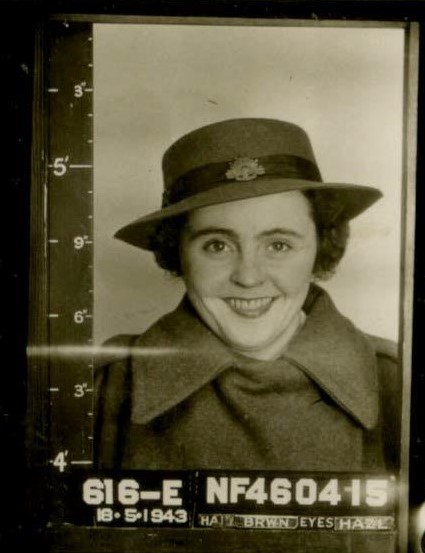
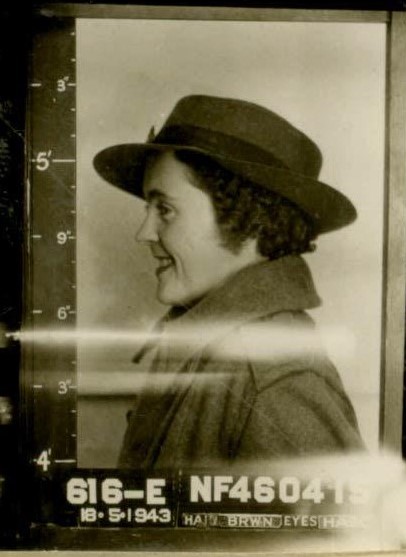
She was X list of AWAS (2 AWAS depot) and sent to Miss Stewands School at Killara before being transferred to 2HQ school of Arty. On May 20th 1944 she was admitted to the 3 Australian Womens Hospital and on June 8th 1944 was evacuated and admitted to the Eva Hordern Convalescent Home. By June 24th she rejoined the LHQ S of A (A/A).
On the 19th of August 1944 her records she now has a married name and her husband is VX109654 CFN R J Sawyer of South Sydney of FTRs Workshops AEME. On October 10th 1944 she is discharged at her own request on compassionate grounds, then part of the HQ NSW L of C Area.
NSW BDM’s: 17125/1944 SAWYER RAYMOND JOSEPH to BYRON BURNICE MAY registered at MANLY
Raymond’s records state they married August 5th 1944
Raymond J. Sawyer was born at Albury on 16 Sep 1921 and enlisted on 29/4/1941 at Albury and again on October 2nd 1942 at Camp Pell, Parkerville, Victoria on aged 20 – he was a Farmer/Farm Hand prior to enlistment and a Gunner afterwards – father is a C R Sawyer still on ‘Jindera’ near Albury. He is discharged January 22nd 1946 after serving across Australia – never left mainland but worked as a Fitter on machine transport after initial deployment.
BYRON, F
Francis Paul Byron, born March 2nd, 1917 at Mona Vale, enlisted 2 Jul 1940, discharged on 9 Jan 1946. NOK: Ida. NX52405. Rank: Private, Posting at Discharge: 2/18 Australian Infantry Battalion, Prisoner of War: Yes
He worked as a Factory Hand prior to enlistment. He was in the CMF from 7.4.41 to 26.7.1942 and was transferred into the AIF from 27.7.1942 until January 1st 1946.
BYRON, H
Henry Joseph Byron, born October 9th 1923 at Mona Vale NOK Richard, enlisted 27 Jul 1942, discharged 01 Apr 1946. Rank: Private, Posting at Discharge: 32 HVY A/A REGT. NX106028 (N108407).
BYRON, N
Neil Alfred Byron, born August 13 1918 at Mona Vale, enlisted 31 May 1940, Discharged: 23 Aug 1945 NOK: Ida, NX24681. Rank: Private, Posting at Discharge: 2/1 Pioneer Battalion
Beryl Clarke, is sister, states he first met his wife Pauline when he was 15 and she 13. Her family use to come to Mona Vale for holidays – Pauline riding her bike down while the family came in a car.
NSW BDM’s: 14512/1942 BYRON, NEIL ALFRED to PITT, PAULINE JEAN registered at MANLY
BYRON, R
Roy James Byron, born June 1st 1919 at Mona Vale, enlisted 2 Jul 1940, discharged 13 November 1945. NOK; Ida. Rank: Private, Posting at Discharge: 2/18 AUSTRALIAN INFANTRY BATTALION. NX52404. Prisoner of War: yes.
Roy is described as being 5 feet, 4 inches tall with blue eyes, fair hair. He is 21 years of age when he enlists and aged 25 years and 10 months old by the time he s released. After being made a prisoner of war at the Fall of Singapore he is made to work on the Burma Railway.
BYRONS, H
There are no records available in National Australian Archives or DVA WWII records – there is a Hilda Byron, born June 3rd 1921 at Homebush, NOK: May Byron. She served as an Aircraftwoman at Bradfield Park from July 11 1942 to November 27, 1945. Service Number: 98681.
CASTNER, J
John Louis Castner was born April 28th 1922 with the birth registered at Manly, he is living at Narrabeen on enlistment on March 24 1922. Service: Royal Australian Air Force, Service Number:162266. He is discharged on 31 Jan 1946with a Rank: Leading Aircraftman, Posting at Discharge: 3 AIRFIELD CONSTRUCTION SQUADRON
CHANAK, J
John Chanak, born April 16 1923 in SIROKA KULA LIKA, JUGOSLAVA is a Warriewood Market Gardener/Greenhouse-man. He enlists at Manly on 12 March, 1942 and is discharged on December 18 1943. Rank: Private, Posting at Discharge: 2 AUSTRALIAN EMPLOYMENT COMPANY
CHERRY, J
Joseph Rupert Thomas Cherry, born July 12, 1912 at ‘North Sydney', enlists at Frenchs Forest on August 22nd 1942 and is discharged on April 18th 1945. Rank: Private, Posting at Discharge: 84 DENTAL UNIT
CLARIDGE, R
Roy Mervyn Claridge was born July 27th 1925 at Collaroy. He enlisted at Manly on June 4th 1943 to serve in the Royal Australian Navy. He was discharged on September 16, 1946. Rank: Able Seaman, Posting at Discharge: HMAS Penguin, Service Number: S/8245.
CLARIDGE, W
Walter Edward Claridge was born September 8th 1916 at Sydney and is living in Warriewood when he enlists on May 31st 1940. He is discharged July 13th 1944. NOK: Annie Claridge. Rank: Lance Corporal, Posting at Discharge: AEME ATTACHED. NX23298
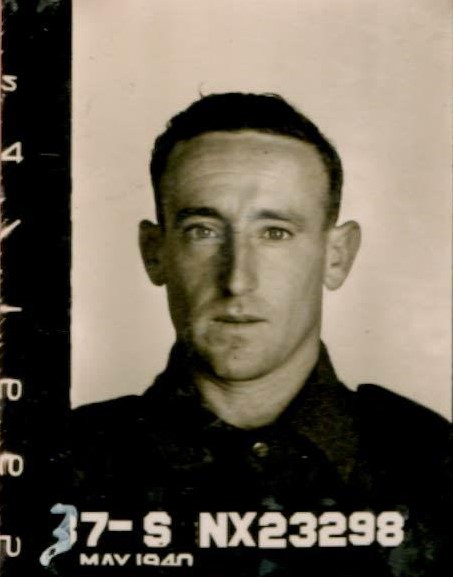
CLARKE, M
Mervyn Athol Clarke is born May 18, 1920 at Paddington and living at Collaroy, his NOK is listed as George Johnson. He enlists on November 4, 1941 and serves in the Army until May 28, 1946. Rank: Trooper, Posting at Discharge: 2/2 COMMO SQN, NX50134
CLARK, W
William Thoms Clark is born December 6, 1922 at ‘North Sydney’ and living at Narrabeen when he enlists on September 12, 1942. He serves in the Army until June 3rd 1946. NOK: Lily Clark. Rank: Gunner, Posting at Discharge: A A BTY DARWIN. NX134277 (N233265)
COCKS, B
Barrington (‘Barry W’ – signs name with this) Walter Cocks – Pittwater Road Mona Vale, born July 25th 1925 and was, on enlistment at Manly on August 12th 1943, 18 years of age Occupation listed as Butcher. Next of kin listed as Frances Maud Cocks, Mother. Unit on discharge: 2 BAD (AAOC). Height: 5 feet 8 ½ inches, eyes hazel, hair light coloured as was his complexion.
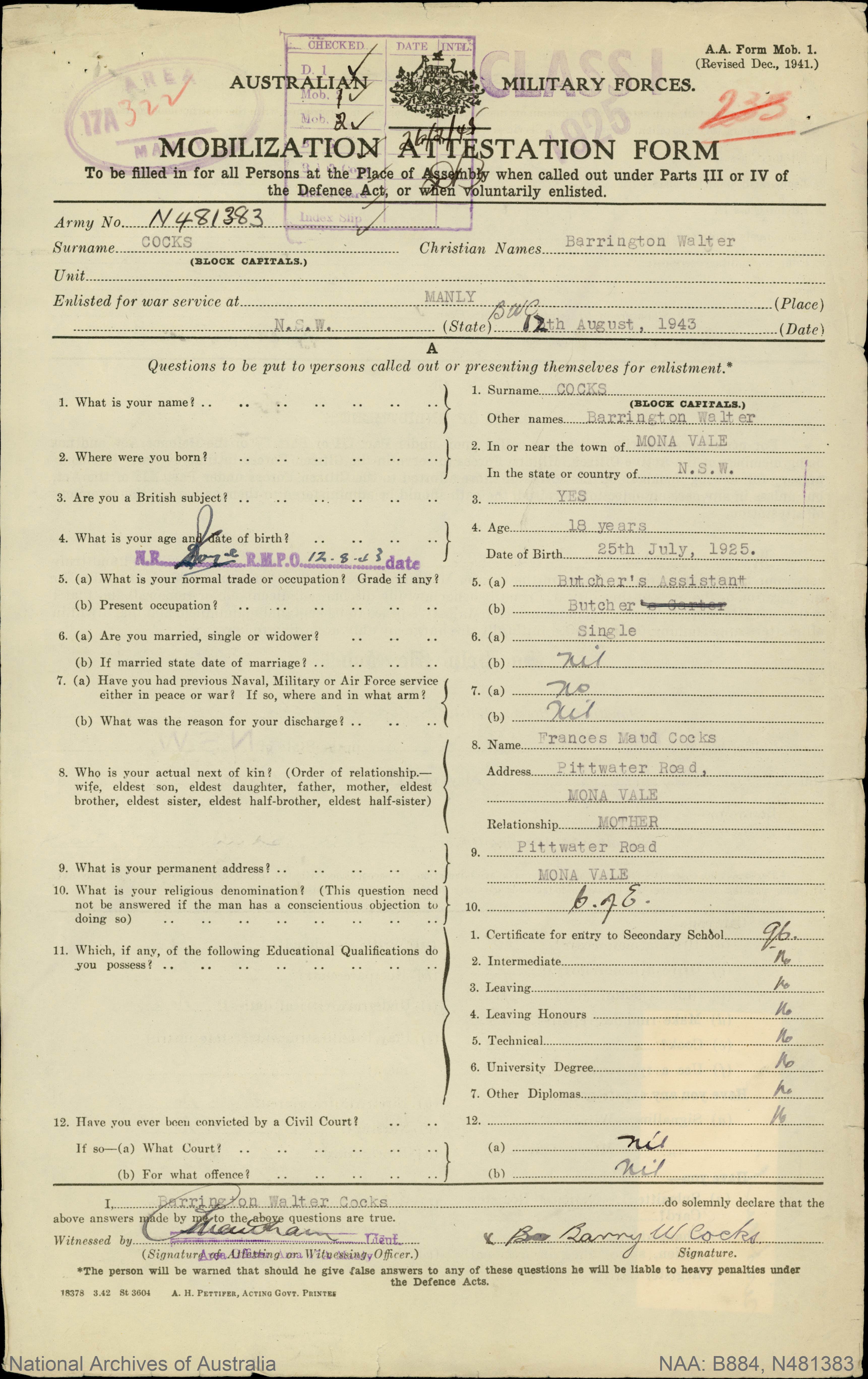
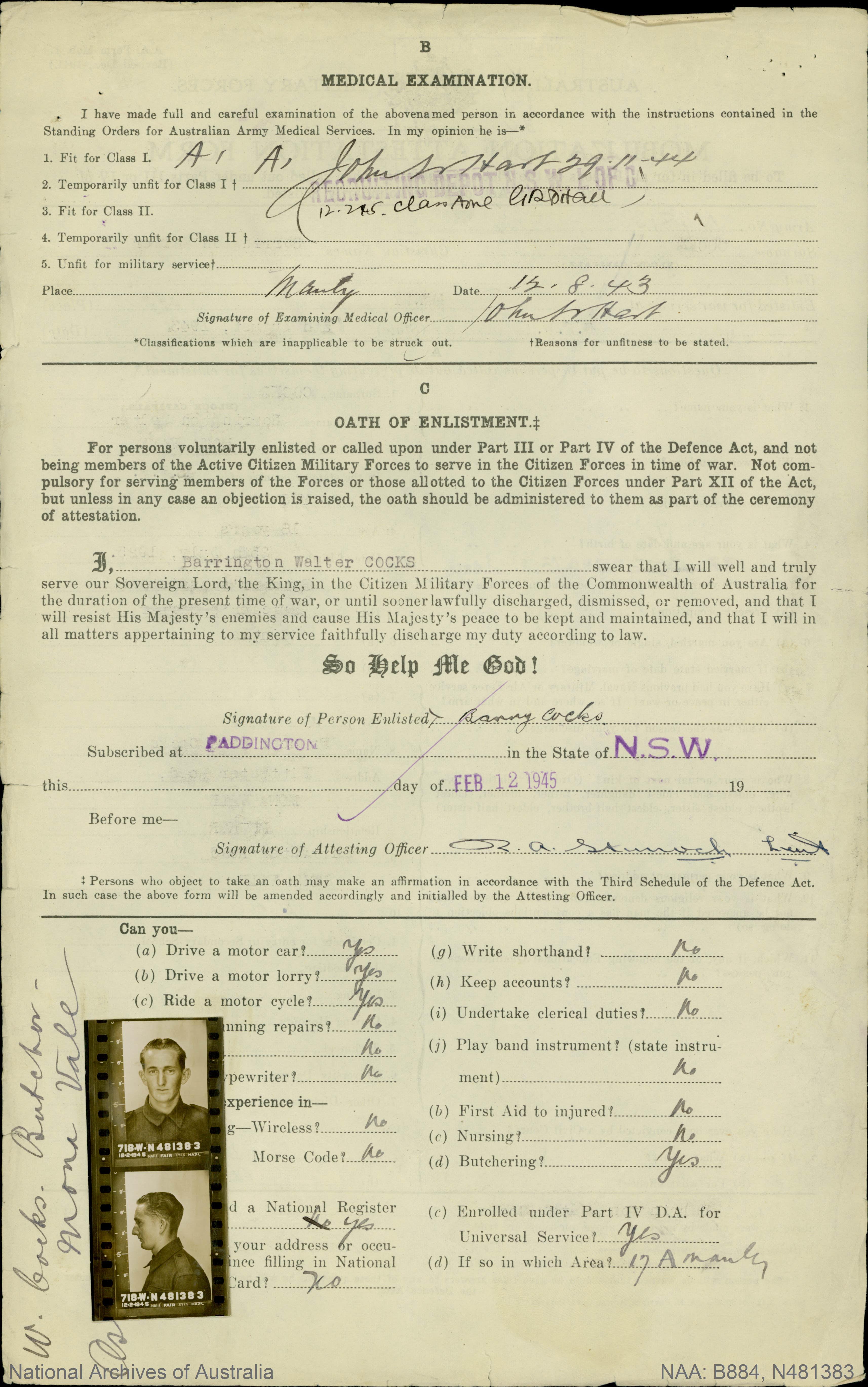
Obviously sent home, as butchers were a Reserve Occupation (see news item and list from 1939 below under Notes – Extras) and his age, and his mum being his NOK would indicate he was bound by the rules; there is no letter of permission from his mum to enlist, then required as at 18 he was below the legal age of consent/adulthood, still 21 then. Persistent, he enlisted again on February 12th 1945, this time listing his occupation as a Butcher’s Assistant, and by April 30 was assigned to the 1st Australian Inft. Trg Batn. In NSW. On July 7th 1945 he has tonsillitis and is admitted to the 104 AGH. On august 2nd 1945 he is transferred to Concord hospital to convalesce.
He too went AWOL, on August 25th until September 17, and forfeited 24 days pay. He continued serving in NSW; with the RR and GDD, then the 38 AWC, before being transferred on November 24th to 2 BAD. He served there until September 19 1946 when he as transferred from the 6th ACC to the 6th Australian G Compound. On October 31st 1946 he was received from the 2nd Aust. Bone. AMN Depot – there is a reference there to delete the AWOL: incident from his record. Once again something has gone on or been made more apparent ??
He passed away on August 5th 1990.
COLLINGE, K*
Kenneth also lived in Park Street Mona Vale. He was born in Manchester, England, on the 3rd of June 1919. He enlisted on June 18th 1940 at Manly, aged 21 and 2 weeks, his occupation listed as Truck Driver and his mother, Asenath Collinge, listed as his next of Kin they were in Park Street Mona Vale. He was assigned NX52401, when he Enlisted at Paddington on 2 July 1940.
He died during the Fall of Singapore. He has no known grave.
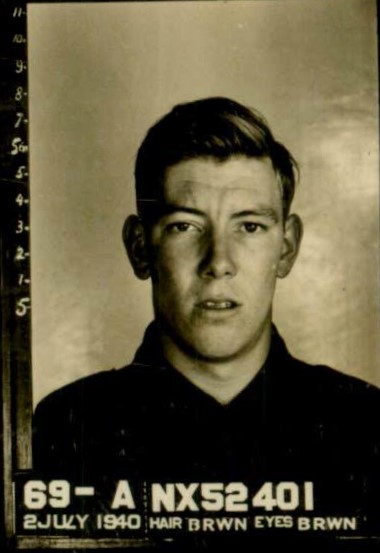
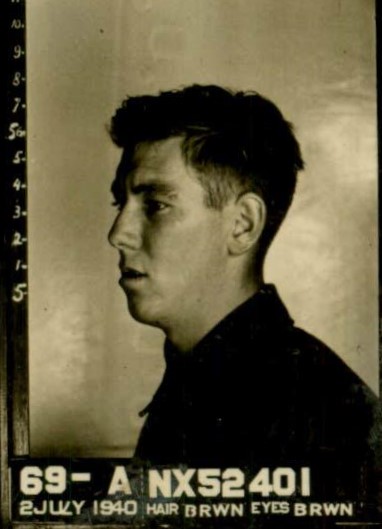
Last Rank: Private, Last Unit: 2nd/18th Infantry Battalion.. Died: Presumed, Malaya, 9 February 1942, aged 22 years. Cemetery:No known grave - "Known Unto God" Singapore Memorial, Singapore Col 119. Memorials: Australian War Memorial Roll of Honour, Ballarat Australian Ex-Prisoners of War Memorial, Manly War Memorial NSW, Mona Vale Primary School WW2 Roll of Honour, Singapore Memorial Kranji War Cemetery.
COULTER, E *
Eric Coulter – of ‘British Camp’, Elimatta Road Mona Vale, was born January 8th 1916, and enlisted 19th of June 1940 at Manly, aged 24 listed his occupation as Labourer. His mother Florence Coulter (nee Bailey) listed as his next of kin. His father was Graham Charles Coulter.
Eric is described on his war records as having blue eyes and blond hair. His enlistment photograph has been removd from his War Records.
City of Sydney Archives; Letter. Graham Coulter, Commission Agent, 125 Sussex Street. Offering to pay eighteen shillings per week for lease of Corporation Stores, Haymarket, January 21st 1873. Surety, NH Ariell, Sussex Street.
Graham Charles Coulter was born January 6, 1866 in Sydney, to Graham Coulter and Mary Coulter. He passed away June 13, 1929 (63), with the death recorded at Manly. He was a brother of Elizabeth Anne Shaw; Sophia Jane Coulter; Mary Emma Thomas / Varcoe; Edward Gent Coulter and Esther Isabella Wallace and Half brother of John Rutledge Coulter; Eliza A. Coulter and William James Coulter.
Eric Coulter was assigned NX32795 and sent to the 2nd/18th Infantry Battalion and sent to Wallgrove on August 1st 1940 and then to Bathurst for training. On January 1st 1941 he was charged with being AWOL from 1500hours 28.12.1940 to 1600hours 3.1.1941 and fined £3 and 7 days.
On February 18th 1941 he embarked on HMT Queen Mary. He disembarked in Singapore on March 1st 1941 and was sent into Malaya where he served, apart from being granted a Leave of Absence in September 1941 (in Singapore) until December 31st 1941 when he was admitted to the 13th AGH 2/9 Field Ambulance with malaria. He was transferred to the 2nd Convalescent Depot on January 10th 1942. On March 26th 1942 he is recorded as reported missing in Malaya – recorded MIA date is February 15 1942.
He was sent to Changi.
His brother was Harold Graham William Coulter, born February 4, 1898 in Glebe, Council of the City of Sydney. Graham passed away on October 21, 1964 (66). Son of Graham Charles Coulter and Florence Coulter. Husband of Isabella Violet Jane Coulter, Father of Mabel Isabella Page; Florence Nancy Coulter; Beryl Jean Samuels; Ida Caroline Latimer; William Coulter and 2 others.
The 2/18th Battalion was raised around Sydney, in June 1940, with its first subunits being formed on 13 July at Wallgrove Camp. Formed as part of the Second Australian Imperial Force (2nd AIF) from volunteers for overseas service, the battalion's first commanding officer was Lieutenant Colonel Arthur Varley, a grazier from Inverell, New South Wales, and a World War I veteran who had previously commanded the 35th Battalion while serving in the Militia during the interwar years. The battalion concentrated at Wallgrove on 15 July, and a cadre of commissioned and senior non-commissioned officers (NCOs) who were selected from the Militia—in many cases personally by Varley—was established, while the remainder of the battalion's NCOs were appointed from recruits following their arrival.
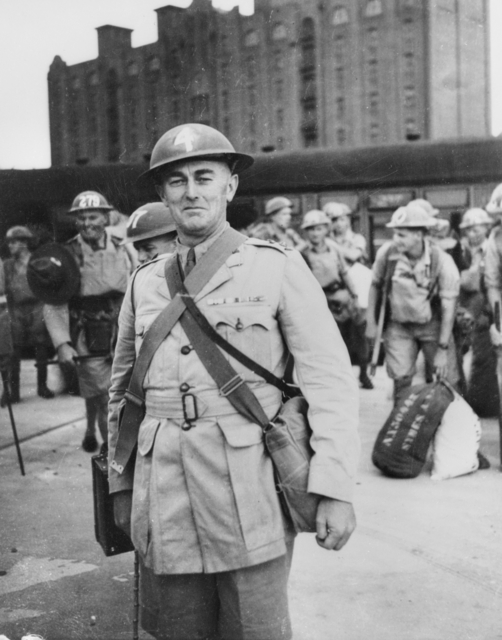
Photo: The 2/18th's first commanding officer, Lieutenant Colonel Arthur Varley, awaiting transport to Malaya with the battalion, February 1941
The 2nd/18th Infantry Battalion went into action near Mersing on the night of the 26 January 1942, in a battle lasting ten hours. The entire British-Australian force was then forced out of Malaya only twelve days later. When the Japanese invaded Singapore Island, the 2/18th was in action again.
Formed in June 1940, the battalion was assigned to the 22nd Brigade, which formed part of the Australian 8th Division. After completing basic training, the 2/18th was sent to Singapore and Malaya to strengthen the defences of the British colonies in February 1941 against a possible Japanese attack. The 2/18th Battalion subsequently undertook garrison duties throughout the year at various locations in Malaya, where it conducted jungle training and constructed defences along the eastern coast.
Following the outbreak of war in the Pacific in December 1941, the 2/18th saw action against Japanese forces in the Malayan campaign, during which they took part in a large-scale ambush of a Japanese force on the Malay Peninsula before joining the withdrawal to Singapore in early 1942. Assigned to defend part of the north-west coast of the island, the battalion participated in the unsuccessful defence of Singapore in early February 1942. Following the fall of Singapore the majority of the battalion's personnel were taken as prisoners of war. Many of these men died in captivity; the survivors were liberated in 1945 and returned to Australia where the battalion was disbanded.
NOW PRESUMED DEAD;
Coulter. Pte. E. Inf.. Mona Vale. … 137 NAMES IN NEW CASUALTY LIST (1946, April 2). The Daily Telegraph (Sydney, NSW : 1931 - 1954), p. 14. Retrieved from http://nla.gov.au/nla.news-article248490364
DICKENS, E
Erl William Dickens is born January 7th 1927 with the birth registered at Manly. He enlists on March 5th 1945 and is discharged on December 19, 1946. NOK: Norman Dickens, living at South Narrabeen on enlistment. Rank: Private, Posting at Discharge: 16 A S D COY, NX206079
DICKENS, N
Norman Dickens, of 22 Oak street Narrabeen, born October 12th 1902 at Chatswood, is 37 and 7 months old when he enlists on May 27th 1940 – NX28263. His occupation is listed as Bus Driver and he is married to Gwendoline May Dickens. He is seconded to the 1st Anti Aircraft Regiment and while undergoing training at Liverpool is appointed a Group III Driver Mechanic. He is listed as a Gunner soon after.
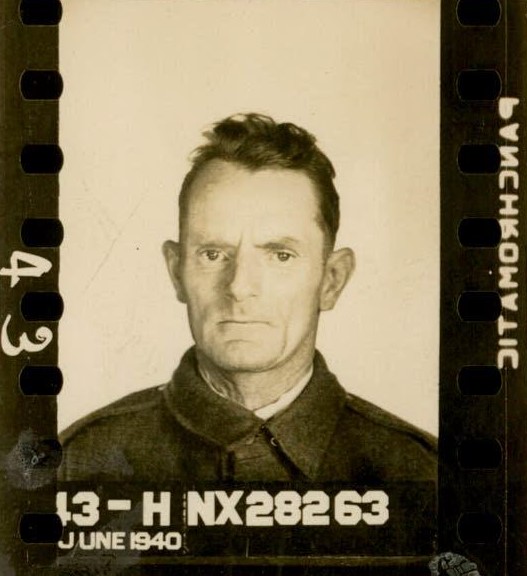
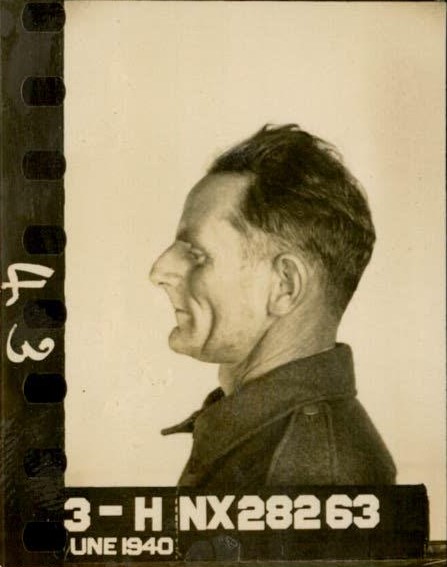
On June 6th 1941 he embarks on Convoy US 11A and on July 25th 1941 disembarks in the Middle East.
In general the "US" convoys followed the same procedure, any ships destined for Singapore being detached south-west of Sunda Strait and escorted onward from there by a China Station cruiser, the remainder going on to Colombo (or, in the case of the Queens, to Trincomalee) and thence to Suez. Escort from Australia to the limit of the Australia Station, or beyond to Ceylon, was provided by the R .A.N. During 1941 seven "US" convoys, comprising twenty-three transports carrying a total of approximately 92,000 troops, sailed from south-eastern Australia, the last for the year, US.13,5 leaving there on the 3rd November. By the end of the year, in the sixteen "US" convoys, comprising sixty-eight ships, which had sailed from Australia since their institution in 1940, there had been carried in round figures some 134,000 (including 14,800 to Malaya) Australians, and 46,200 New Zealanders.
Convoys US.9, Queen Mary, Aquitania, Mauretania, Nieuw Amsterdam ; US .10, Queen Mary, Queen Elizabeth, Mauretania, Nieuw Amsterdam, Ile de France; US .11a, Queen Mary, Queen Elizabeth, Aquitania ; US.11b, Johan van Oldenbarnevelt, Marnix van St Aldegonde, Sibajak ; US .12a, Queen Mary, Queen Elizabeth ; US .12b, Aquitania, Johan van Oldenbarnevelt, Marnix van St Aldegonde, Sibajak ; US.13, Queen Mary, Queen Elizabeth. Of the total numbers carried were approximately 70,000 were Australians, including some 3,800 RAAF and RAN . The balance were New Zealanders. More than half of the grand total of 92,000 (just over 50,000) were carried in the two Queens. - THE AUSTRALIA STATION—1941, AWM Collection, available at: https://s3-ap-southeast-2.amazonaws.com/awm-media/collection/RCDIG1070347/document/5519635.PDF
On February 2nd 1942 he embarks per ‘Sophocles’ to be returned to Australia and disembarks at Adelaide on March 18th 1942. By April 17th 1942 is entrained to ‘L of Carea’ in the NT. Between 19 February 1942 and 12 November 1943, the Japanese mounted more than eighty air raids on Darwin and other Northern Territory airfields.
On October 18 1942 he is granted 7 Days Home Leave. On June 19th 1943 is Entrained for the NT L of C area and detrained in the WSW area. He serves there until August 31 1943 when he is moved to Queensland as part of the 2/1 AA Regiment.
On November 22nd 1943 he embarked at Townsville per the ‘Duntroon’ for New Guinea, disembarking at Buna on the 27th.
He served here, apart from records of visits to the hospital, on one occasion for dermatitis to his hands, until June 6th 1944 when he was placed on a Hospital Ship at Port Moresby and sent to Sydney, disembarking on June 13th.
By early August he had been diagnosed with Cheiropompholyx and Anxiety (and more dermatitis). Cheiropompholyx describes a vesicular pattern of eczema affecting the skin of the hands.
By mid-August he has been diagnosed with R. Epididymis Orchitis. In adults, epididymo-orchitis is usually due to infection, most commonly from a urine infection. Bacterial orchitis might be associated with epididymitis — an inflammation of the coiled tube (epididymis) at the back of the testicle that stores and carries sperm. In that case, it's called epididymo-orchitis. Orchitis causes pain and can affect fertility.
On August 10 1944 he is discharged having been assessed Medically Unfit for further service. This is confirmed in his war records and made official on September 25th 1944. He is then 44 years of age and his home is then listed as being in Alleyne Avenue, Narrabeen.
A 1961 Statuary Declaration, when he is applying to have reissued his Service Badge, lost on a boat returning home and somewhere between Manly and Mona Vale, shows he is living at 12 Dygal Street Mona Vale.
The 2/1st Field Regiment was an Australian Army artillery regiment raised as part of the all volunteer Second Australian Imperial Force during World War II. Formed in October 1939, the regiment was assigned to the 6th Division. Shortly after it was raised, the regiment was deployed to the Middle East, where it was briefly re-roled as an anti-aircraft regiment before returning to the field artillery role. In 1941, the regiment served in North Africa and in Greece, before being withdrawn back to Australia in early 1942, following Japan's entry into the war. In late 1942, and early 1943, the regiment took part in the defence of Port Moresby during the fighting along the Kokoda Track, before taking part in the Battle of Buna–Gona and the defence of Wau, remaining in New Guinea on garrison duties until August 1943. Withdrawn to Australia, a long period of training followed before the regiment took part in its final campaign of the war Aitape–Wewak campaign in 1945.
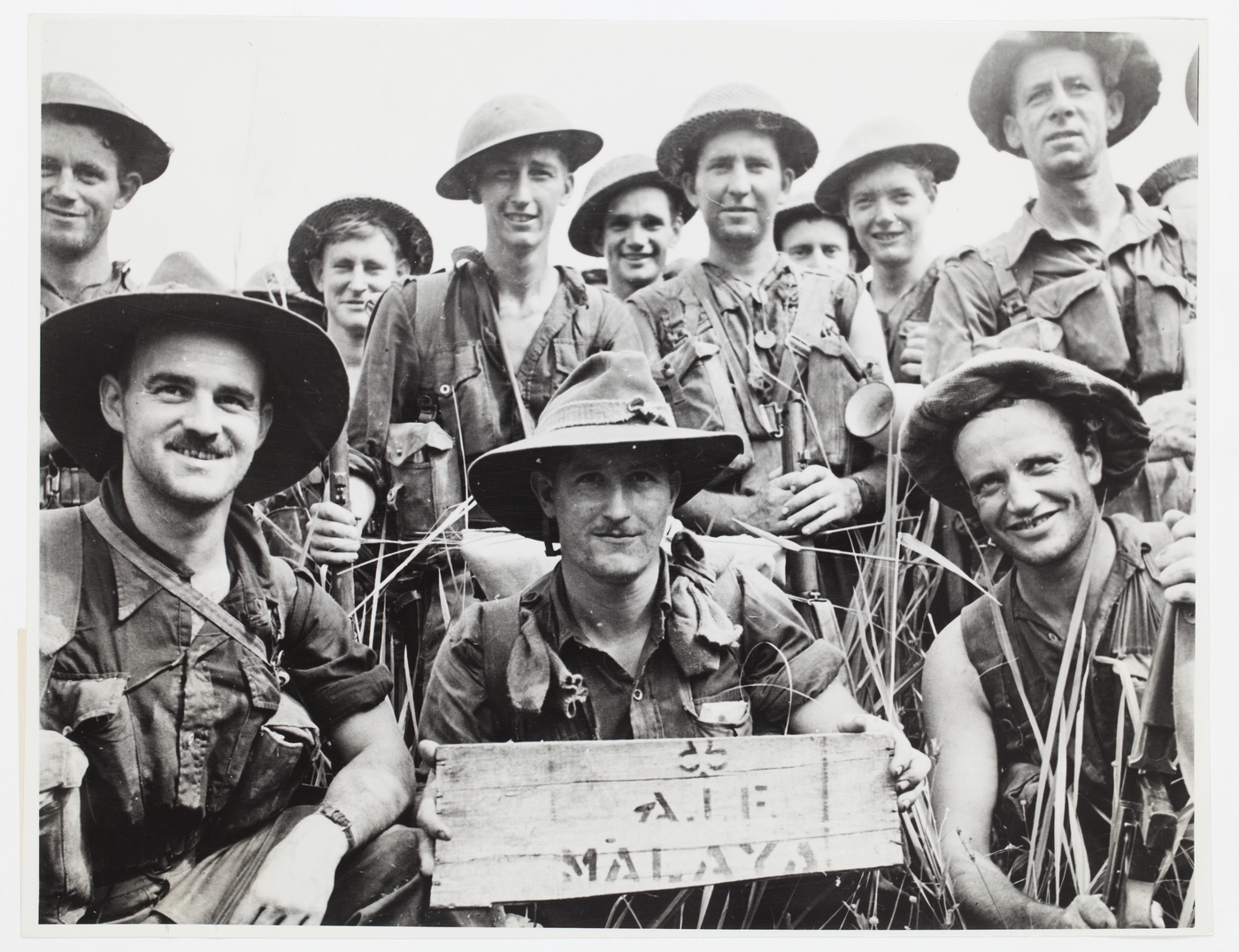
New Guinea, military operations - Gona, ca. 1941-1943, from Mitchell Library, State Library of NSW, Items: SLNSW_FL1089720,SLNSW_FL1089712, SLNSW_FL1089721 and SLNSW_FL1089722 more at; https://collection.sl.nsw.gov.au/record/YezElgL9
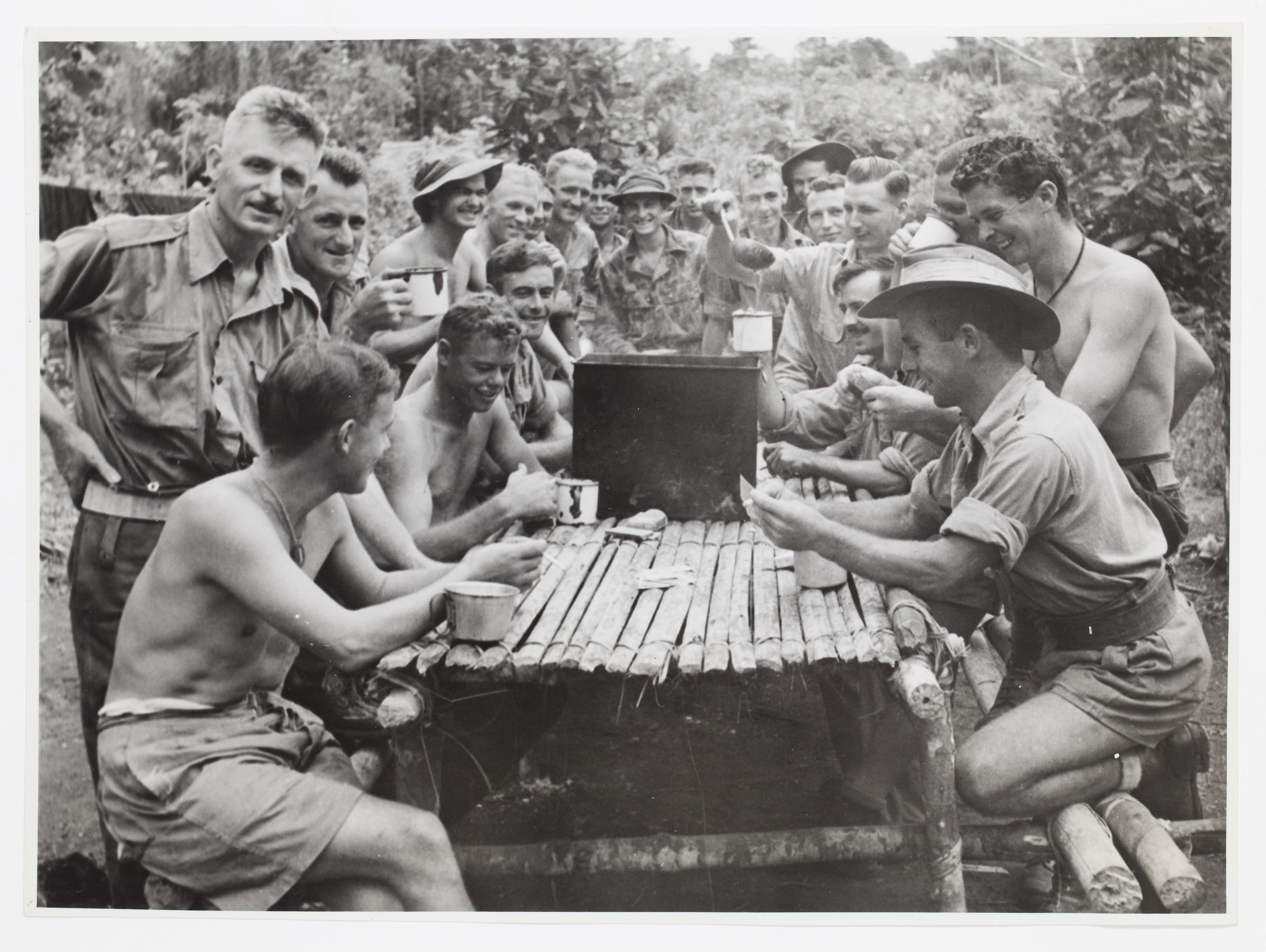
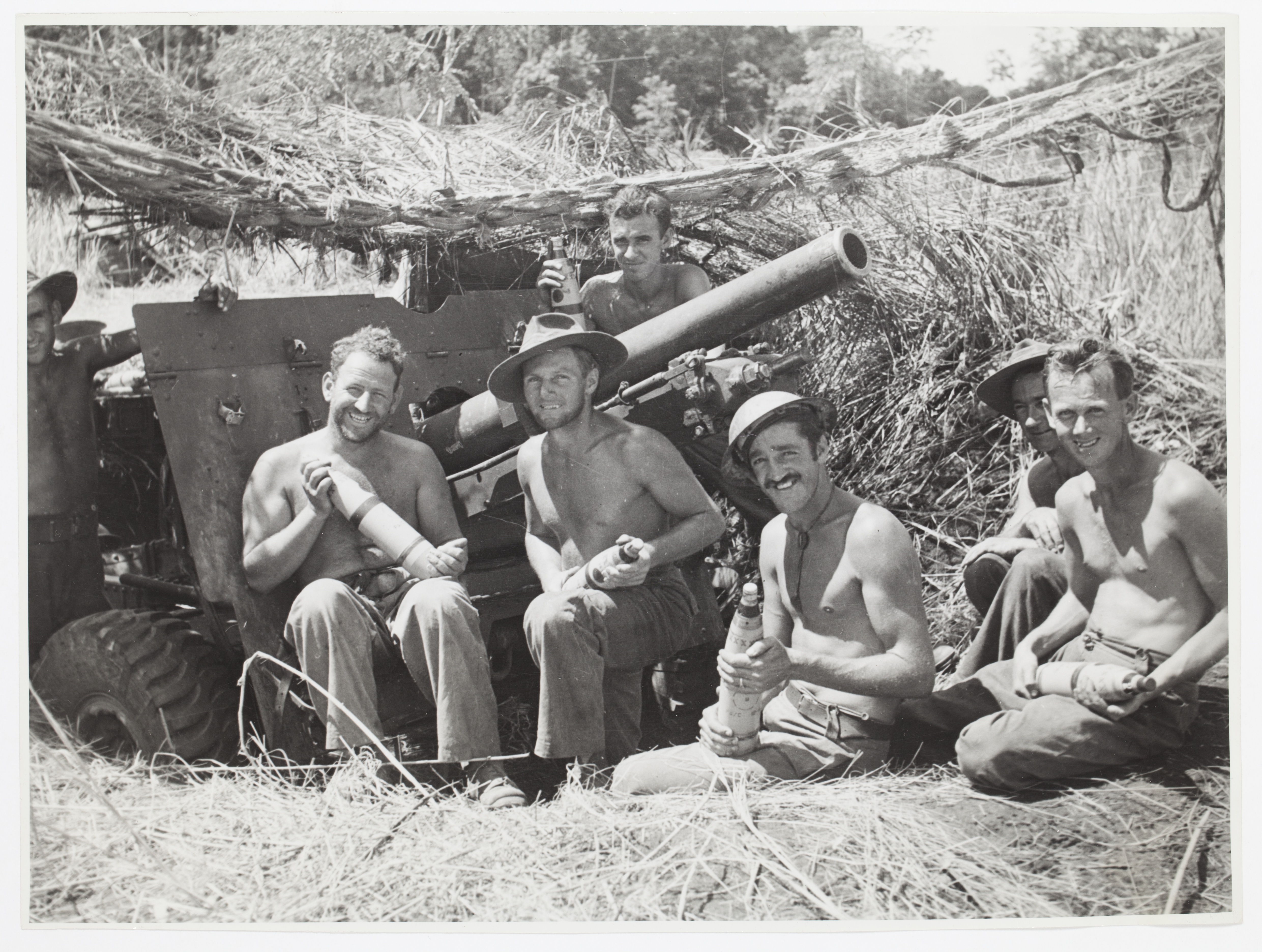
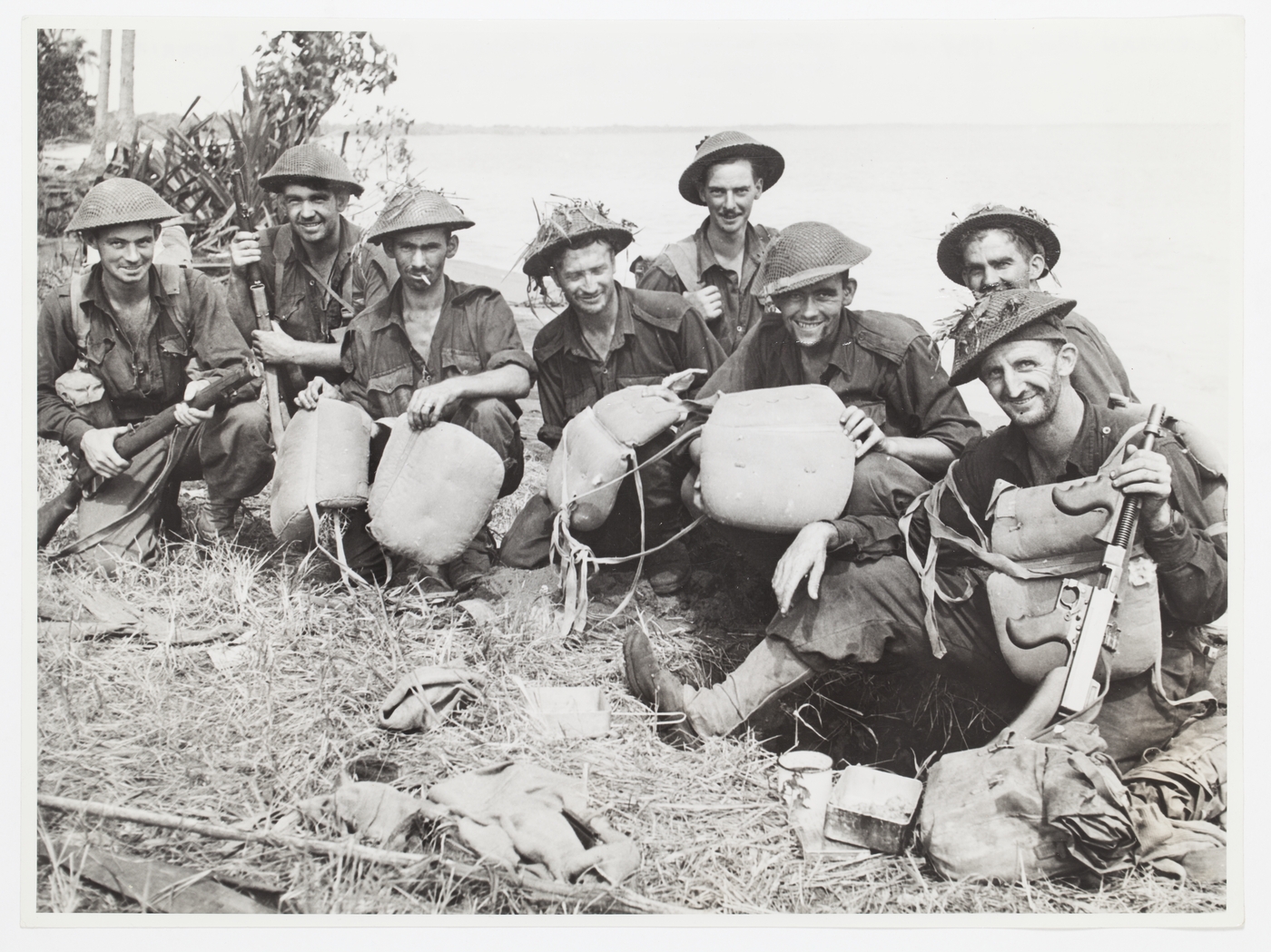
The 2/1st Anti-Tank Regiment was an Australian Army anti-tank artillery regiment that was raised for service during the Second World War as part of the all volunteer Second Australian Imperial Force. Formed in November 1939, it was sent to the United Kingdom in mid-1940, but was broken up and converted into infantry. In late 1940, the regiment was re-formed and deployed to the Middle East, joining the 6th Division. It took part in the Battle of Greece before being evacuated to Egypt. Later, the regiment took part in the Syria–Lebanon campaign. In early 1942, it was withdrawn back to Australia for service in the Pacific. En route the regiment was diverted to Ceylon for garrison duties. It served in New Guinea around Port Moresby and Milne Bay in 1942–1943 and then again in early 1945 during the Aitape–Wewak campaign, serving there until the end of the war.
By August – September 1942, the situation in the New Guinea campaign was critical for the Australians, as the Japanese were advancing along the Kokoda Track towards Port Moresby; as a result, the newly returned 16th Brigade was hastily deployed to reinforce the Australian troops on the track, and the 1st Battery deployed in support. The 16th subsequently took part in the Australian counter offensive that pushed the Japanese back towards their beachheads on the northern coast in October and November. Meanwhile, regimental headquarters was deployed to Port Moresby in November, and the 3rd Battery deployed to Milne Bay. The 2nd Battery remained at Greta, though, and the 4th Battery was subsequently disbanded at this time. To make up for its missing battery, the 8th Battery was temporarily attached to the regiment from the 2/2nd Anti-Tank Regiment, in Port Moresby at this time.
During the Battle of Buna–Gona, the 2/1st Anti-Tank Regiment detached a 6-pounder from Port Moresby to reinforce elements of the 2/1st Field Regiment. This gun fired directly onto Japanese bunkers around Sanananda, which was subsequently secured by 22 January 1943. Meanwhile, in February 1943 the 3rd Battery rejoined the regiment from Milne Bay, and the 8th Battery returned to the 2/2nd. The following month, the regiment was renamed the 2/1st Tank Attack Regiment.
The regiment remained in New Guinea until October 1943, returning by sea to Cairns, Queensland. Throughout late 1943 and into 1944, the regiment remained in Australia as there was no real role for them in the offensives being fought by the Australians in New Guinea at this time to secure Salamaua–Lae, the Huon Peninsula and the Finisterre Ranges. Instead, they undertook training on the Atherton Tablelands, and for a period, the regiment detached one of its batteries to the School of Artillery at Holsworthy, New South Wales. Ultimately, the regiment did not see action until the final year of the war. In late 1944, the Australian Army assumed responsibility for securing the area around Aitape and Wewak in northern New Guinea, taking over from US troops who were redirected to the Philippines. The regiment deployed to Aitape in January 1945 to join the Aitape–Wewak campaign, under the command of Lieutenant Colonel Arthur Rickard.
DICKENS, S
Also on Pittwater road Narrabeen Sydney James Dickens, aged 18, 'Motor Driver' (enlisted July 23rd, 1917 and served in WWI) - he came home. He lists his NOK as his father, Frederick William Dickens of Pittwater Road Narrabeen.
Sydney J has hazel eyes, brown hair and is 5 feet 3 inches tall.
DICKENS, S
Sydney Dickens is born April 18, 1899 at Chatswood. He is living at 86 Addison Road Manly when he enlists at Manly on February 24, 1941 and serves until April 4, 1946. NOK: Elsie Dickens. Rank: Sergeant, Posting at Discharge: 87 AUSTRALIAN LIGHT AID DETACHMENT. NX68203
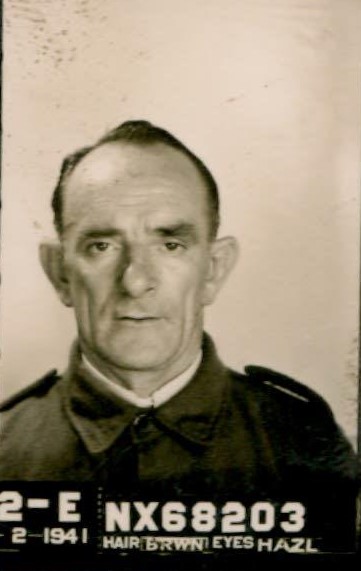
.jpg?timestamp=1731023918348)
DICKSON, H
Henry Dickson is born November 13, 1907 with the birth registered at Manly. He is living in Macpherson Street Warriewood when he enlists on September 1, 1941, aged 33 and 8 months, and serves until January 22, 1943. NOK: Dorothy Dickson, his wife. Rank: Private, Posting at Discharge: 2/4 Pioneer Battalion, NX44028
NSW BDM's Marriage:
13232/1927 DICKSON, HENRY to CLARKE, DOROTHY R - registered at MANLY
His occupation is a Farm Produce Agent and Carrier on enlistment and he is described as being 5 feet 6 inches tall with blue eyes and brown hair. He was discharged at his own request while on active service, after being shipped to go overseas on February 14 he is disembarked at Darwin on February 18 1942 and admitted to the 119 GH - General Hospital.
He remains in hospital until May 10 1942 when he is struck off service and transfers to the Labour Company in mid July 1942, and then returns into the 2/4 Pioneer Battalion until Christmas Eve 1942 when he is sent back to the NSW L of C area.
He is discharged to AOR on January 22, 1943.
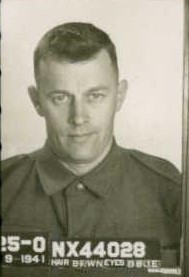
.jpg?timestamp=1731031925624)
DICKSON.-The Relatives and Friends of Mr. and Mrs. HENRY DICKSON and FAMILY, of McPherson Street. Warriewood, are informed that the funeral of their late beloved DAUGHTER and SISTER, Marjorie Rosevear, will leave the Prívate Chapel of Motor Funeral Limited, 309 Pacific Highway. Crow's Nest. THIS MORNING, at 11 o'clock, for the Northern Suburbs Cemetery. Family Notices (1940, June 15). The Sydney Morning Herald (NSW : 1842 - 1954), p. 13. Retrieved from http://nla.gov.au/nla.news-article17692872
AWM: 2/4 Pioneer Battalion
The 2/4th Pioneer Battalion was raised at Greta army camp in February 1941. After initial training, it arrived in Darwin in September 1941 and established headquarters at Noonamah. Its companies worked on defensive positions between Adelaide River and Darwin.
On 14 February 1942 the battalion left Darwin and sailed with the "Sparrow Force" to Timor. Japanese aircraft bombing forced them to return following the Fall of Singapore. The ship arrived in Darwin Harbour on 18 February and was sunk by the Japanese during the attack on the harbour the next day. The battalion's equipment went down with it.
The 2/4th spent the next 13 months defending various locations in the Darwin area, until they were finally relieved in March 1943. After some leave the pioneers regrouped for jungle training on the Atherton Tablelands. However, the war was nearly when the battalion went overseas to support the 9th Division landing in Borneo.
The OBOE operations aimed to reoccupy areas of the Netherlands East Indies with the 9th and 7th Divisions making amphibious landings on Borneo in 1945. The 9th Division landed on Tarakan in May, and Labuan Island and Brunei Bay in June. The 7th Division landed at Balikpapan at the start of July.
On 10 June the 2/4th landed and operated on Labuan as part of the 1st Beach Group. Men from the battalion were involved in some of the fighting but incurred only five casualties in the Borneo operation.
Japan surrendered in August and official surrender ceremonies were held the following month. The 9th Division was responsible for carrying out surrender arrangements in British Borneo, Sarawak, Brunei, Labuan, and the Natuna Islands. The 2/4th became part of the "Kuching force", responsible for the area around Kuching.
With the war over the ranks of the 2/4th gradually thinned, as men were discharged or transferred. The battalion returned to Australia in December and was disbanded in early 1946.
DICKSON, J
James Dickson is born April 6 1905 at North Sydney and living in Warriewood Road at Warriewood and working as a Market Gardener when he enlists on May 30, 1940. He serves until July 1 1944 – until August 22 1940 as a Signalman with the Corps of Signals and from December 2nd 1942 until 1944 with 116 General Transport Company as a Lance Corporal.
NOK: Patricia Dickson (wife). NX142143 (N270398) and NX24365. Two listings, and two separate NX numbers – both same DOB, address and NOK.
DICKSON, R
Robert Dickson was born December 1 1912 with the birth registered at North Sydney. He is living on Pittwater Road at North Narrabeen when he enlists on June 18 1940 and serves until January 4, 1946. NOK: Flora Dickson. Rank: Driver, Posting at Discharge: 2/16 TRANSPORT PLATOON. NX34536
Robert Dickson, whose wife Flora then lived at 28 Collins Avenue North Narrabeen was sent in to Bonegilla in Victoria and then sent into Alexandria, Africa and then Borneo towards the end of the war in the Pacific. Robert was not the only male from Mona Vale who served in Borneo towards the end of WWII.
DOWNS, LUCY
No records found as yet.
DUNN, C
Clive Dunn – born June 14, 1895, and living at ‘Narrabean Park, Narrabean’ is 45 years and 3 months when enlisting on December 2, 1940, and served until October 14, 1941 – he was discharged as he worked in a Reserved Occupation: Fitter, and was needed elsewhere. Service number N101000 .NOK wife Mary Lillian Dunn. Discharged Rank when discharged: Private, Posting at Discharge: 106 RESERVE N T COY. He had served with the AIF in France and from 1914 to 1919 in WWI.
THE Governor-in-Council has approved of the undermentioned persons being appointed to the Commission of the Peace for the State of New South Wales, viz.:— Dunn, Clive, Narrabeen Park parade, Warriewood; APPOINTMENTS. (1947, November 21). Government Gazette of the State of New South Wales (Sydney, NSW : 1901 - 2001), p. 2702. Retrieved, from http://nla.gov.au/nla.news-article224774057
DUNN, E
Edward Dunn – born November 9th 1914, was 27 years and 3 months of age when enlisting on February 9th 1942 and lived in Warriewood Road, Warriewood. He worked as a Manager, Market Gardener. His NOK is listed as Agnes Dunn, mother, his place of birth; St Ives, NSW. His father was James Dunn.
His parents married in 1904:
6307/1904 DUNN JAMES to SMITH AGNES registered at CHATSWOOD
Siblings:
DUNN ANNIE 2443/1907 JAMES AGNES CHATSWOOD
DUNN JOHN 13284/1909 JAMES AGNES CHATSWOOD
DUNN UNNAMED MALE 14659/1911 JAMES AGNES CHATSWOOD
DUNN GEORGE T27717/1912 JAMES AGNES CHATSWOOD
DUNN EDWARD 45558/1914 JAMES AGNES CHATSWOOD
DUNN LILA A 19752/1917 JAMES AGNES PARRAMATTA
Edward was single and described as being 5 feet 5 inches tall and having blue-grey eyes and brown hair. Service No.: NX87912. He was discharged March 14, 1946, Rank: Gunner, Posting at Discharge: 7 FIELD REGIMENT.
He married in 1954: 9567/1954 DUNN, EDWARD to NIX, JEAN KATHERINE registered at: MANLY
Mother’s death: DUNN AGNES 2310/1955 parents; WILLIAM BERTHA registered at MANLY
At rest in Mona Vale Cemetery with husband James Dunn Death: 1955-01-20, Burial: 1955-01-21,site; COE-C-002
James Dunn Death:1959-10-08, Burial:1959-10-09.
Edward is also in Mona Vale Cemetery: Death: 2001-08-06, Burial: 2001-08-09, site: COE-D-079, with his wife Jean Kathleen Dunn, who passed away in June 27th 1964. They were parents.
On July 8 1942 he was entrained for W. A. L. of C area, Greta. On September 21 1942 he embarked per the M. Amsterdam for Vic. L of C area in Freemantle, and was seconded to the 7th Field Regiment on September 27th. He was ‘detrained’ to the NSW L of C Area on September 27 1943, in Sydney. On November 19 1943 he was transferred to the 7AUST INF TRG BRIGADE. On May 9 1944 he is transferred to the 2/28 Infantry Battalion and sent to Queensland. On April 23 1945 he embarked on the ‘General McRae’ at Townsville, disembarking at Morotai Island on May 1 1945.
The Battle of Morotai, part of the Pacific War, began on 15 September 1944, and continued until the end of the war in August 1945. The fighting started when United States and Australian forces landed on the southwest corner of Morotai, a small island in the Netherlands East Indies (NEI), which the Allies needed as a base to support the liberation of the Philippines later that year. The invading forces greatly outnumbered the island's Japanese defenders and secured their objectives in two weeks. Japanese reinforcements landed on the island between September and November, but lacked the supplies needed to effectively attack the Allied defensive perimeter. Intermittent fighting continued until the end of the war, with the Japanese troops suffering heavy loss of life from disease and starvation.
AWM: 2/28th Australian Infantry Battalion
Western Australia's 2/28th Infantry Battalion was raised in 1940, with the nucleus of the battalion coming together at Melville Camp, near Fremantle, on 17 July. The battalion was initially raised as part of the 24th Brigade of the 8th Division and was transferred to the newly formed 9th Division in December. In early January 1941 the 2/28th moved to Fremantle, where it joined a troopship convoy to the Middle East. The battalion arrived at Egypt at the end of the month. Disembarking at Port Tewfik in Suez, the battalion travelled by train to Palestine. Southern Palestine was being used as a base for the Australians where they could complete their training. The 2/28th went into camp at Khassa, north of Gaza.
By early 1941 the British advance in the Western Desert had reached El Agheila. In March the 9th Division was brought from Palestine to Libya to garrison the area east of Tobruk. The division did not have enough vehicles to bring all of its units forward towards Benghazi and the 24th Brigade (composed of the 2/28th, 2/43rd, and 2/32nd Battalions) remained in Tobruk.
This situation had quickly changed in April. The German Afrika Korps led the Axis counter-attack, pushing the British from El Agheila. The 9th Division withdrew to Tobruk and, with the 18th Brigade, defended the "fortress" for the next six months. The 2/28th participated in the usual pattern of defensive duties, manning parts of the Red Line, working on the Blue Line, and aggressively patrolling no man's land. The Red Line was Tobruk's outer line of defence and was a series of concrete pillboxes forming a semicircle around the town. The Blue Line was the second line of defence.
In September and October the majority of Australians were evacuated by sea. The 2/28th was evacuated on 23 September and sailed to Alexandria, from where it was transferred to the camp at Kilo 89 in Palestine. The brigade later moved to Syria and then Lebanon for rest, training, and garrison duties.
By July 1942 the war in North Africa had become critical for the British forces. The Germans and Italians had reached El Alamein in Egypt, about seventy miles from Alexandra. Consequently, the 9th Division was rushed to the Alamein "box" and held the northern sector for almost four months, as the British Eighth Army was reinforced for a new offensive.
The 2/28th reached the Alamein front on 10 July and the division attacked a week later. On 17 July the 2/32nd and 2/43rd moved inland, fighting along the ridgeline from Trig 22 and approaching Ruin Ridge. The 2/32nd led the attack, advancing from Trig 22 to the Qattara Track. The 2/43rd then followed towards Ruin Ridge.
Just after midnight on 27 July, the 2/28th attacked Ruin Ridge and by 1 am they were on the feature. But things were starting to go wrong: the Germans were attacking the Australians from rear positions; three company commanders were wounded; and many of the vehicles that should have brought forward ammunition were destroyed or damaged. Increasingly cut off, an attempt by British tanks to relieve the battalion was abandoned after 22 vehicles were "knocked out". Shortly before 10 am enemy tanks began moving in on the Australians from three directions. A company was overrun and the battalion's commander had little choice but to surrender. The Australians were rounded up and marched through the British artillery barrage, resulting in more casualties, as they moved behind the German lines.
The 2/28th suffered heavily at Ruin Ridge. Sixty-five officers and men from the battalion and its support units were killed or wounded; nearly 500 were captured and became prisoners of war. From those who participated in the attack, only 92 men remained. The 2/28th was withdrawn and rebuilt during the following weeks. It was back on the front line by September.
During the general Allied offensive from 23 October to 4 November the 24th Brigade was in reserve. Its task was to deceive the Axis forces by faking an attack. The 2/28th and 2/43rd raided enemy lines, while the 2/32nd directed a smokescreen and placed "dummy soldiers" in no man's land. The 24th Brigade did not take part in the main fighting until the night of 31 October, when it relieved the 26th Brigade in the "Saucer", where the heaviest fighting took place.
Alamein was a great, although bloody, success for the Allies and by 6 November enemy forces were retreating. But the 9th Division was needed elsewhere. The 2/28th left Alamein in December and went to Gaza in Palestine to participate in the 9th Division parade on 22 December. In January 1943 the battalion left Palestine for the Suez Canal, from where it was sailed back to Fremantle on 18 February.
Reorganised for jungle operations, the 2/28th participated in the 9th Division amphibious landing at Red Beach, north-west of Lae, in early September. Following the fall of Lae the 20th Brigade landed at Scarlet Beach, north of Finschhafen, on 22 September. It gradually moved to Scarlet Beach, the 2/28th arriving on 14 October. Days later the Japanese made a strong counter-attack against Scarlet Beach but the brigade was too strong and by the end of the month the main Japanese force withdrew to Sattelberg. But large numbers of enemy troops were still north of Scarlet Beach, near Pino Hill and Nongora. Moving inland, the 2/32nd captured Pino and then Pabu. The 2/28th followed the coast and captured Guiska. It then moved to Wareo, where it spent Christmas. The battalion returned to Australia at the end of January 1944.
After some leave, the 2/28th reformed at Ravenshoe on the Atherton Tablelands in Queensland, for what proved to be an extensive period of training. Indeed, the war was almost over before the battalion went into action again.
In April 1945 the 9th Division was transported to Morotai, which was being used as a staging area in preparation for the 7th and 9th Divisions amphibious operations on Borneo. The 24th Brigade landed on "Brown Beach" on Labuan Island on 10 June. It took the 2/28th and 2/43rd 11 days to clear the island. The strongest Japanese resistance came from the area called the "Pocket". The battle began on 15 June and, after almost a week of shelling, air strikes, and naval bombardment, the 2/28th captured the position. The Pocket was captured on 21 June and the 2/28th moved to Beaufort, on the opposite side of Brunei Bay, spending the final weeks of the war patrolling the surrounding area.
Following the end of the war and Japan's surrender, the ranks of the 2/28th thinned, as men were discharged, transferred, or volunteered for the occupation force for Japan. They returned to Australia in January 1946, where the 2/28th was disbanded.
Edward embarked per the LST 637 for Service in British North Borneo on July 12th 1945 and he and his mates were forwarded to the 34th Infantry Brigade.
The Battle of North Borneo took place during the Second World War between Allied and Japanese forces. Part of the wider Borneo campaign of the Pacific War, it was fought between 10 June and 15 August 1945 in North Borneo (later known as Sabah). The battle involved a series of amphibious landings by Australian forces on various points on the mainland around Brunei Bay and upon islands situated around the bay. Japanese opposition to the landings was sporadic initially, although as the campaign progressed a number of considerable clashes occurred and both sides suffered significant casualties, although major combat was largely restricted to Labuan and around Beaufort. On the mainland, while Allied conventional operations focused largely on the coastal areas around Brunei Bay, guerrilla forces consisting of Dayak tribesmen and small numbers of Allied personnel from the Services Reconnaissance Department fought an unconventional campaign in the interior. The Allies were successful in seizing control of the region. Nevertheless, many of the strategic gains that possession of North Borneo provided were ultimately negated by the sudden conclusion of the war in August 1945.
The 34th Battalion was formed in January 1916 at a camp established at the Maitland showground in New South Wales. It was planned that the bulk of the battalion's recruits would be drawn from the Maitland area and thus it was dubbed "Maitland's Own". The first recruits for the 34th, however, hailed from the far north-west of the state and arrived at Maitland after joining a recruiting march that began at Walgett. These men were known as the "Wallabies".
On January 3rd 1946 he was Emplaned at Labuan, Borneo and Deplaned at Morotai again. He Marched in from 2/28 Infantry Battalion on February 18 1946, still at Morotai. His Date of Discharge is: 14 March 1946, on account of demobilization.
AWM states:
7th Australian Infantry Battalion - After the First World War the defence of the Australian mainland lay with the part time soldiers of the Citizens Military Force, otherwise known as the Militia. The Militia was organized to maintain the structure of the First AIF and kept the same numerical designations. These Militia units were also distributed in the same areas that had raised the original AIF units. Consequently, Militia units were also known by the name of their shire. Thus, Victoria's 7th Infantry Battalion was the "North-West Murray Borders". The battalion was headquartered in Mildura, with companies established in Merbein, Wentworth, and Red Cliffs. However, during the 1930s little was spent on defence and the Militia had few volunteers. In 1929 the 7th merged with the 38th Infantry Battalion, forming the 7th/38th Infantry Battalion, although in 1936 the two were unlinked.
With the start of the Second World War in 1939, the 7th, like many other Militia units, tried to volunteer as a unit for overseas service but was rejected on the grounds that it was needed for the defence of Australian. From early October the Militia were called up in two drafts for 30 days training. This was repeated in early 1940, this time for 90 days. Militia units were brought up to strength with men conscripted for service. Most of those called-up and allocated to the 7th were from the Sunraysia district, but others also came from Nhill, Hopetoun, Warracknabeal, Rainbow, Jeparit, Donald, Murtoa, Minyup, Rapinyup, and Horsham. There were also some from Maryborough and Kyneton.
During 1940 the battalion held a number of training camps, first at Mt Martha on the Mornington Peninsula, then Belcombe, and in 1941 at Nagambie Road, north of Seymour in Central Victoria. When Japan entered the war, the 7th was in camp at Belcombe and was immediately placed on a war footing and allocated a defensive position in the Dandenong area. However, the battalion was needed elsewhere and in began moving north in mid-February 1942.
The 7th arrived in Darwin on 25 February. The Japanese bombed the town throughout the year and the battalion got its first taste of action. It was also in Darwin that the 7th joined the 23rd Brigade. The brigade had been part of the 8th Division but, when two of its battalions were captured on Ambon and Timor, it was reformed with Militia units. The 7th joined the brigade's other battalions - the 8th and 27th.
The brigade spent a year-and-a-half in Darwin. In April 1943 the 7th was relieved and returned to Melbourne, via Adelaide, for some well-earned leave. In November, the battalion again headed north, this time to the Atherton Tablelands for intensive training. However, the 7th was destined for more garrison duties.
As part of the Bougainville campaign, the 23rd Brigade relieved the American garrisons on the Outer Islands. In October 1944 the 7th took over from the Americans on the Treasury Islands and placed one of its companies on Munro Island.
The 7th's role was to defend the airfield and conducted surveillance of the surrounding islands occupied by the Japanese. To escape the boredom and monotony, volunteers from the brigade worked as crews on American PT boats, raiding Japanese-occupied islands in New Ireland and New Britain.
In 1945 the 23rd Brigade moved to Bougainville, becoming responsible for the Central and Northern Sectors. In April the 7th left the Outer Islands and moved to Torokina, the Australian base on Bougainville. In June the battalion began moving along the Numa Numa Trail, in the Central Sector, to Pearl Ridge where they relieved the 27th Battalion. After years of static garrison duties, the 7th was about to go into combat.
Under the leadership of Lieutenant Colonel Harry Dunkley, the 7th dominated the Japanese. From 7 June to 15 August the battalion captured 25 Japanese positions, including Wearne's Hill, Base Point 3, Tokua, and Sisivie. By the end of the war the 7th claimed 181 Japanese killed, 17 probably killed, and 11 wounded, for the loss of 25 killed and 54 wounded.
In September, with the war over, the 7th returned to Torokina and was transferred to Fauro Island the next month to helped guard the Japanese. The Japanese were concentrated on Fauro so they could be repatriated back to their country. The ranks of the 7th gradually thinned, as men were discharged, transferred, or volunteered for the occupation of Japan. By the end of February 1946 the last of the Japanese had left Fauro and the remnants of the 7th returned to Australia in March. The battalion was disbanded on 10 May 1946.
DUNN, E S
Eric Stanley Dunn, born March 30 1925 at ‘Kallara’ (Killara?) NSW and living in Warriewood road, Warriewood. He is aged 18 when he enlisted on May 5, 1943. He served until November 19 1946. Is NOK is listed as James Dunn, his father. His occupation is Assistant lorry hand and driver.
Eric is describer as 5 feet 7 ½ inches tall with blue eyes and dark hair. Rank: Private, Posting at Discharge: 2/13 AUSTRALIAN INFANTRY BATTALION
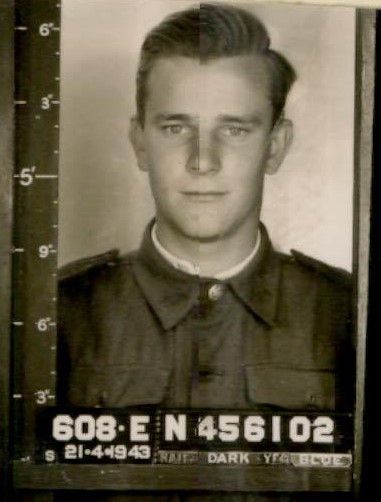
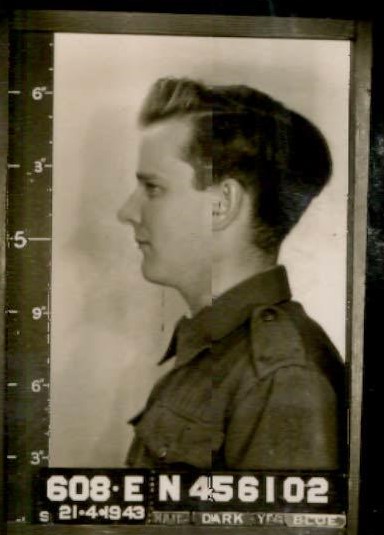
Eric is clearly a brother to Edward – and sent into Borneo too. Eric was seconded to the well-known 2/13 Australian Infantry Battalion and 9th Division that was recalled to Australia to face a new enemy - the Japanese. The 2/13th left Egypt in January 1943 and disembarked at Sydney in February. After leave and jungle training on the Atherton Tablelands in Queensland in August the battalion embarked for Milne Bay in Papua.
Towards the end of April1944 the 9th Division was transported to Morotai to prepare for amphibious landings on Borneo as part of the OBOE operations. The 2/13th landed at Brunei on 10 June before making another landing in the Miri-Lutong area ten days later. The battalion captured the Lutong airfield and oil tanks and moved inland along the Pujut Road to the Pujut oilfields. It then moved along Canada Hill to Lobang, where it remained until the end of the war.
In 1951 he married – NSW Births, Marriages and Deaths registry records:
17295/1951 DUNN, ERIC STANLEY to ROBINSON, FAY IRENE - registered at MANLY
Eric Stanley Dunn would buy land at Ingleside off James Park Millner in 1960 when he subdivided the 100 acres he held. His address later in life was 67 Mona Vale Road, Mona Vale when he applies for his medals’; Pacific Star, War Medal, Australian Service Medal.
DUNN, G
George Thomas Dunn was born June 19 1913 at St Ives and living in Warriewood road Warriewood when he enlists on January 7th 1942. His NOK is also James Dunn, his father. He serves until March 20, 1946, Service Number: NX82781, Rank: Private, Posting at Discharge: 2/12 AUSTRALIAN GENERAL HOSPITAL. George is 32 years and 3 months when he enlists with fair hair, blue eyes, a far complexion and 5 feet and 7 inches tall and his occupation is listed as Carrier.
.jpg?timestamp=1731031016482)
.jpg?timestamp=1731031042695)
George is seconded to the 2 AARD (Australian Advanced Reinforcement Depot.) on January 29 1944 and to the No. 5 Australian ARD on July 29th.
On August 4 1944 he was sent into Queensland and attached to the 5 AARD and on August 19 was ‘marched out’ to the 2/12 Australian General Hospital.
He was there until March 3 1945 when he was transferred to the No. 1 Australian Base Sub Area Ing. School Hygiene and Sanitary Course No. 6.
On June 16 1945, as part of the 2 ADV 2 ECH he embarked per the ‘’Sea Barb’’ (US Army Transport Ship) for Morotai, arriving June 29.
Photo: AT SEA, TOWNSVILLE - MOROTAI. 1945-04-15. TROOPS OF 2/24 FIELD PARK COMPANY, ROYAL AUSTRALIAN ENGINEERS, READING THE SHIP'S DAILY NEWSHEET ABOARD THE US ARMY TRANSPORT SEA BARB EN ROUTE TO MOROTAI WITH REAR ELEMENTS OF 1 CORPS, 2 BEACH GROUP, AND ELEMENTS OF 9 DIVISION. IDENTIFIED PERSONNEL ARE:- SAPPER W.R. GIBBS, 2/24 FIELD PARK COMPANY (1); CORPORAL L.V. HAYWARD, 1 ARMOURED DIVISION PROVOST COMPANY (2); SAPPER A.C. DAVIS (3); SAPPER L.J. SHARP, 2/24 FIELD PARK COMPANY (4). Courtesy AWM
Photo; AT SEA, EN ROUTE TO MOROTAI, 15 APRIL 1945. MEMBERS OF 2/9 ARMOURED REGIMENT ATTENDING CHURCH PARADE ON NO 3 HATCH ABOARD THE UNITED STATES ARMY TRANSPORT, SS SEABARB. IN BACKGROUND CAN BE SEEN THE NEW GUINEA COAST BETWEEN SIO AND SAIDOR. THE SERVICE WAS CONDUCTED BY CHAPLAIN W JONES, 2/9 ARMOURED REGIMENT. Courtesy AWM
Photo: USAT Sea Barb
The USAT Sea Barb was originally built for a bare bottom charter but was allocated to the US Army who had her converted to a troopship in December. Used by the US Army Troop Transport to transport men, equipment and supplies during World War II. The standard C3-S-A2 design was a 465-foot ship, of which 162 were built, in five variants. In addition, 75 ships were built to other designs in this size group. USAT Sea Barb was allocated to the Asia-Pacific Theatre. Laid up in 1946 at Suisun Bay, California.
Sold to the Luckenbach Steamship Co. on 1 Mar 1949, it was renamed F. J. Luckenbach, and remained with that company until 1 Nov 1960 when she was again sold, this time to Pope & Talbot Inc. who renamed her SS P & T Seafarer. Sold on 13 Nov 1963 to the American-Foreign Steamship Co and renamed SS American Hawk. During the Vietnam war, the SS American Hawk was limpit mined at Qui Nhon and beached. She was sold for scrapping on 7 Oct 1971 to Leung Yau Ship-breaking Co, of Hong Kong.
On July 7 1945 he embarked at Morotai per the ‘’William M. Seward’’ for Service in Balikpapan – Roll 409/8 JFC RO. 11/1159 /45. On November, while still at Balikpapan, he was transferred to the 2/2 C.C.S.
He left Balikpapan in January 1946 and was demobilised, along with the rest of his unit, on March 25 1946.
AWM: The 2/12 Australian General Hospital
Raised at the Sydney Showgrounds in July 1941, in October they were sent to Wellisara, near Colombo, Ceylon to handle patients in transit from the Middle East to Australia, and naval casualties. During the short ill fated Malay - Singapore campaign they also handled casualties from that fighting. They remained in Ceylon (Sri Lanka) to service the 16th and 17th Brigade Groups who, although in transit to Australia from the Middle East, were retained in Ceylon until British troops could arrive in sufficient number for its defence. In December 1942 they returned to Australia. After leave they assembled in Warwick, southern Queensland in February 1943.
In May 1944 the 2/12 Australian General Hospital was identified as one of the units to be involved in actions north of New Guinea, but in the meantime it treated patients from southern Queensland units. In early 1945 it was allocated to the 7th Australian Infantry Division, which was to capture the oil fields at Balikpapan in Dutch Borneo. On 16 Jun 1945 the 2/12th AGH boarded USAT Sea Barb for Morotai, which was serving as the staging point for all Borneo operations, and in July they travelled aboard the AHS Manunda to Balikpapan where they remained for the rest of the war.
AWM Photos: Balikpapan, Borneo 1945 Aerial view of 2/12th AGH. AWM P00630.040
BALIKPAPAN, BORNEO. 1945-08-26. MISS GRACIE FIELDS, ENGLISH COMEDIENNE (3) AND MISS PEGGY SHEA, VOCALIST (1) WITH LIEUTENANT COLONEL A. R. BAKER, MATRON (2) ON THEIR ARRIVAL AT 2/12TH GENERAL HOSPITAL.
BALIKPAPAN, BORNEO. 1945-09-13. PRIVATE (PTE) C. DODGE, 2 INDEPENDENT COMPANY (1) AND SERGEANT (SGT) D. A. WOOLLEY, 2/40TH INFANTRY BATTALION (2), EX-PRISONERS OF WAR OF THE JAPANESE, NOW RECOVERING AT 2/12TH GENERAL HOSPITAL. PTE DODGE AND SGT WOOLLEY WERE CAPTURED AT TIMOR IN 1942-03 AND SENT TO MAKASSAR WHERE THEY WERE FORCED TO DO DEFENCE WORK. IDENTIFIED PERSONNEL ARE: SISTER G. M. LAW (3); SISTER D. F. BARDON (4).
BALIKPAPAN, BORNEO. 1945-08-23. THE FIRST WEDDING TO BE HELD IN BALIKPAPAN SINCE F DAY WAS BETWEEN PRIVATE (PTE) T. C. MEAGHER, 2/14TH INFANTRY BATTALION AND LIEUTENANT (LT) L. B. BARNARD, 2/12TH GENERAL HOSPITAL. AS BALIKPAPAN IS DUTCH TERRITORY THE CEREMONY TO BE LEGAL WAS HELD IN NETHERLANDS INDIES CIVIL AFFAIRS AREA BY LT BURGMANN, DEPUTY CIVIL ADMINISTRATOR. A SECOND SERVICE WAS CONDUCTED IN THE ROMAN CATHOLIC CHAPEL AT HQ 7TH DIVISION BY CHAPLAIN D. F. O'HURLEY, 2/12TH GENERAL HOSPITAL. SHOWN, THE BRIDAL COUPLE TALKING WITH LIEUTENANT-COLONEL A. R. BAKER, MATRON, 2/12TH GENERAL HOSPITAL (1) AND COLONEL M. A. REES, CO 2/12TH GENERAL HOSPITAL (4) AFTER THE SECOND CEREMONY.
William Henry Seward was an American politician who served as United States Secretary of State from 1861 to 1869, and earlier served as governor of New York and as a United States senator. A determined opponent of the spread of slavery in the years leading up to the American Civil War. Despite his being an ardent supporter of American expansionism during his time in the Cabinet, only Alaska was added to U.S. territory during Seward's service as Secretary of State. (It should be remembered that the purchase of Alaska from Russia was not inevitable; the land had the same latitude as Siberia and was very difficult to farm, while neither gold nor oil nor any other important mineral was discovered there until years after Seward's death.) Nevertheless, his influence extended to later American acquisitions. One of his friends, Hamilton Fish, in 1875 signed the trade reciprocity treaty with the Kingdom of Hawaii that eventually led to the American annexation of the islands. William Everts, another Seward friend, in 1877 signed a treaty of friendship with the Samoan Islands, laying the groundwork for another American acquisition. A young friend and protege of Seward, Lincoln's assistant private secretary, John Hay, served as a successor to Seward from 1898 to 1905, during which time the U.S. acquired Puerto Rico, Guam, American Samoa, the Philippines, and the Panama Canal Zone.
The Battle of Balikpapan (1945) was the concluding stage of Operation Oboe, the campaign to liberate Japanese-held British and Dutch Borneo. The landings took place on 1 July 1945. The Australian 7th Division, composed of the 18th, 21st and 25th Infantry Brigades, with a small number of Netherlands East Indies KNIL troops, made an amphibious landing, codenamed Operation Oboe Two, a few miles north of Balikpapan. The Allied invasion fleet consisted of around 100 ships. The landing had been preceded by heavy bombing and shelling by Australian and US air and naval forces. The Allied force totalled 33,000 personnel and was commanded by Major General Edward Milford, while the Japanese force, commanded by Rear Admiral Michiaki Kamada, numbered between 8,400 and 10,000, of which between 3,100 and 3,900 were combatants. After the initial landing, the Allies secured the town and its port, and then advanced along the coast and into the hinterland, capturing the two Japanese airfields. Major combat operations concluded around 21 July, but were followed by mopping-up operations, which lasted until the end of the war in mid-August. Australian troops remained in the area until early 1946.
Photo: American manned Alligators during the landing of Australian troops at Balikpapan, Borneo
The Second Battle of Balikpapan
Balikpapan was retaken by the Australian 7 Division (reinforced to 33,000 men) on 1 July 1945 (Operation OBOE VI) in the last amphibious assault of the Second World War. The defending Japanese troops numbered about 3100 men from 71 Independent Mixed Brigade and 22 Special Base Force heavily armed with artillery and antiaircraft guns, plus another 1100 service troops and potential reinforcements of 1500 troops at Samarinda. The Australian landings were preceded by twenty days of heavy air attacks and the most massive prelanding bombardment ever conducted in the Southwest Pacific. This ignited many of the oil storage tanks. U.S. underwater demolition teams cleared many of the Japanese obstacles from 26 June onwards.
The prolonged bombardment was prompted by intelligence indicating strong fortifications in the area, and, one speculates, a desire to minimize Australian casualties this late in the war. The fortifications were no illusion: The Japanese had built a number of pillboxes, tunnels, and obstacles some 400 to 1000 yards (360 to 910 m) inland and had excavated tank traps up to 14 feet (4 meters) wide near the beaches. Log barriers had been constructed 70 to 100 yards (64 to 90 meters) offshore, and the area was heavily mined, including large numbers of Allied acoustic and magnetic mines dropped from aircraft earlier in the war. The shallow water (less than 10 fathoms deep as much as 6 miles or 10 km offshore) meant that small minecraft would have to be employed and would be difficult to provide with gunfire support. Furthermore, the nearest functioning Allied airfield was at Tawi Tawi, which meant that fighter cover would be badly stretched.
Sweeping commenced on 15 June 1945 and continued until the landings on 1 July 1945. Three minecraft were destroyed by mines and another damaged, and three more were damaged by Japanese coastal guns. Some 27 mines were swept, but since it was known that 93 Allied mines had been dropped (and none were set to self-deactivate) a considerable number of mines were thought to be still in the area. However, no other ships or boats were lost during the landings.
Underwater demolition teams arrived on 24 June to begin demolishing the obstacles. Over 300 yards (270 meters) of obstacles were destroyed before the landings.
Following a Japanese air attack on 25 June, three U.S. escort carriers were detailed to assist the landings. These had been operating off Kyushu, but arrived on 1 July 1945, the day of the landings, and provided three days' air cover. Opposition was initially light but stiffened as the Australians moved inland. Some 10,500 men, 700 vehicles, and 1950 tons of supplies were brought ashore the first day. Sepinggang Airfield was seized on the second day and Balikpapan town on the third. Manggar Airfield fell on 5 July. Because the war was winding down, the Australian commanders were under orders to minimize casualties and the advance towards Samarinda was very cautious. However, the area was considered secured by the end of July, with the remaining Japanese retreating towards Banjarmasin and Kuching. Australian casualties were 229 killed and 634 wounded while the Japanese lost at least 1800 killed and 63 taken prisoner.
Ammunition was expended lavishly in the pre-invasion bombardment. Some 23,764 shells of 4.7" (120mm) calibre or greater were expended up to 1 July; another 11.884 on 1 July; and 11.158 more by 7 July. Another 114,000 rounds of 20mm and 40mm automatic weapons rounds were also expended. This exceeded by a considerable margin the ammunition expenditure of any other division landing during the war.
George Thomas Dunn returned to Warriewood as well. In 1954 he married with the NSW BDM’s records showing:
9630/1954 DUNN, GEORGE THOMAS to O'DONNELL, UNA JOYCE – registered at MANLY
Also married soon after:
16676/1956 DUNN, FREDERICK GEORGE to CRUCKSHANK, JOSEPHINE MARGARET - registered at MANLY
There are several children born to a James and Agnes Dunn in the St Ives vicinity - those available per NSW BDM's cut-off year, at present, of 1922, are:
DUNN GEORGE THOMAS 27717/1912 JAMES AGNES CHATSWOOD
DUNN UNNAMED MALE14659/1911 JAMES AGNES CHATSWOOD
DUNN JOHN 13284/1909 JAMES AGNES CHATSWOOD
DUNN ANNIE 2443/1907 JAMESAGNES CHATSWOOD
DUNN WILLIAM HENRY J26409/1901 JAMES AGNES ST LEONARDS
There are others listed and attributed to the same parents, but unable to be confirmed to the whole being allocated a birth year of '1951'.
Parents Marriage:
6307/1904 DUNN, JAMES to SMITH AGNES - registered at CHATSWOOD
DUNN, J
No resaerch done as yet.
FORSTER, G
This is the lady whose married name was Gwenyth Sneesby. Her Profile from 2013, recently re-run for VP Day 2023 as Gewn turned 99 on June 17 2023.
Her story in her words:
When did you enlist?
I joined the Navy in 1942, 9th of December.
Why were you attracted to the Navy?
My father was in the Navy, he was in the British Navy and then he transferred to the Australian Navy. So the Navy was in my blood I suppose.
Where in Britain was your dad?
I don’t remember that because I was so young. I do remember that he was at Plymouth. I was born here but because he was in the Navy he had to go back to England and we went back on a passenger ship and then he had to join the Navy in Barrow and they were in the first submarine that came to Australia. This was called the Otway.
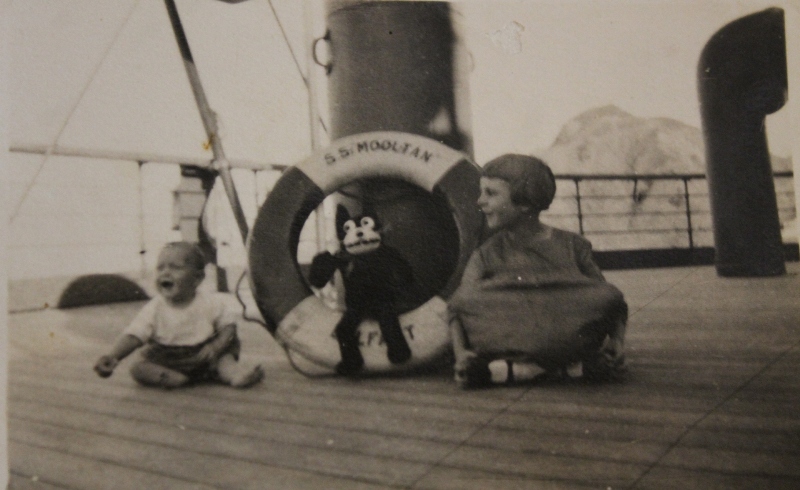
Gwenyth aged 8 months, 1925, on way to England.
How old were you then?
I was nine months when I went to England. The ship was three years being built so we stayed in Barrow in England. My father joined the Otway to come back here but my mother and I had to come by passenger ship. This took about six weeks. My mother was a very bad sailor and I believe all the waiters used to look after me because I was nine months old and not getting around much at that age, but mum was taken to her cabin for most of that time.
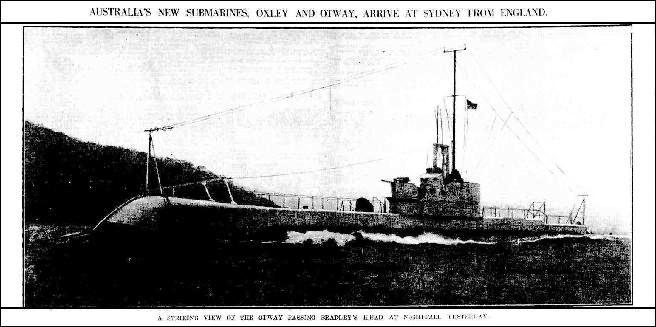
AUSTRALIA'S NEW SUBMARINES, OXLEY AND OTWAY, ARRIVE AT SYDNEY FROM ENGLAND. A STRIKING VIEW OF THE OTWAY PASSING BRADLEY'S HEAD AT NIGHTFALL YESTERDAY. AUSTRALIA'S NEW SUBMARINES, OXLEY AND OTWAY, ARRIVE AT SYDNEY FROM ENGLAND. (1929, February 15).The Sydney Morning Herald (NSW : 1842 - 1954), p. 16. Retrieved from http://nla.gov.au/nla.news-article16531518
Was it a rough trip?
Oh no, she had been back several times after that and she never improved. In my father’s diary there are records “Taken to her cabin again.” appears several times. But she still liked to go back to England because she was English and of course my father was English as well.
Where were they born?
They were born at St Helen’s, in Lancashire.
Where were you born Gwenyth?
I was born at Northbridge on the 17th of June, 1924.
Where did your family settle when you came back?
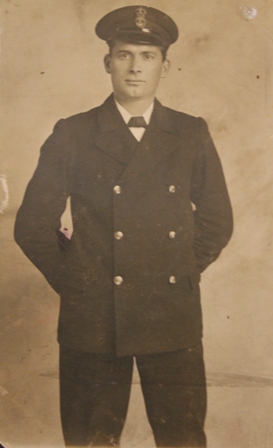 Willoughby. Dad was still in the Navy and on the ships there, having transferred to the RAN, on the Otway. After that he was shore based on the Penguin. His time expired shortly after that. He’d been in for 15 years, so he retired from the Navy. He bought a property in Turimetta street, Mona Vale in 1933 and built glasshouses and grew glasshouse tomatoes. This was nothing similar to his engineering experience that he had in the Navy….growing plants. He liked it.
Willoughby. Dad was still in the Navy and on the ships there, having transferred to the RAN, on the Otway. After that he was shore based on the Penguin. His time expired shortly after that. He’d been in for 15 years, so he retired from the Navy. He bought a property in Turimetta street, Mona Vale in 1933 and built glasshouses and grew glasshouse tomatoes. This was nothing similar to his engineering experience that he had in the Navy….growing plants. He liked it.
Right - Mr. Forster, Gwenyth's dad.
He did very well with these tomatoes. About five of his colleagues in the Navy, they all retired about the same time, a few months later, and they all bought properties in various parts of Mona Vale…not Warriewood…Mona Vale. They all liked it.
How many glasshouses did your dad have?
He had about four glasshouses, they were big. He bought four blocks of land, they were quarter acre blocks, which made an acre for the whole thing. He built a house on one block and he had tomatoes in glasshouses on one block when he first started because he didn’t know whether he’d make a go of it or not, and then he did well so he put glasshouses on the other block. He always kept the last block as one for his daughter to have when she got married. I didn’t know at the time because I was only a child.
Were you the only child?
Yes. A lot of the sailors' wives didn’t want any more because the sailors were at sea and it was too difficult bringing up children on your own.
What is the biggest difference between the Mona Vale of the early 1930’s and the Mona Vale of 2013?
The transport was of course very poor. The tram line came as far as Narrabeen and then there was a bus from there but it didn’t run very frequently. My father did get a car though; an Essex Tourer. We were very lucky to have that. The big shopping expedition was to go to Manly on Friday night. We would go in the evening because you have to look after tomatoes; you have to see that their ventilators are open in the morning and closed at dusk because that keeps the heat in.
I think a very important thing that I remember from when I was a child was the opening of the Harbour Bridge. I lived at Willoughby then. There were lots and lots of public Schools and Willoughby was one of them that were dancing around Maypoles in the Sydney Cricket Ground. There were Maypoles as part of the celebrations, about twenty or so of them. Willoughby school was one of those who participated in the preliminary celebrations. It was lovely. The older children did a big wheat display; they came into the field in all green clothes with little hoods on their heads, and they danced around and the girls, at a certain part of the music they undid a little string or something and the girls became all yellow…like corn. It was very impressive to see that, the sight of lots and lots of these children, hundreds of children.
SCHOOL CHILDREN To Celebrate Bridge Opening.
Schoolchildren in the metropolitan area will celebrate the opening of the Harbour Bridge at the Sydney Cricket Ground next Thursday. There will be a maypole dance, folk dances and physical exercises. More than 4000 boys and girls will give a display of flag drill. There will also be singing and a tableau representing the building of the bridge. Ten thousand children from 140 schools will take part in the display. Music will be supplied by the Young Australia League and Hurstville boys' bands. The Governor (Sir Phillip Game) will be among those present. SCHOOL CHILDREN. (1932, March 26). The Sydney Morning Herald (NSW : 1842 - 1954), p. 11. Retrieved from http://nla.gov.au/nla.news-article16850830
What did you think when deGroot dashed across the line and stole the show?
We were all amazed about that…I didn’t actually see it because we were at the back; I was standing at North Sydney watching that and didn’t see it but the word came around; people were saying “How dare he!” Everyone was very annoyed.
I was very happy later on when the Queen came in 1956. She came out to Palm Beach and we were watching and I can remember still telling my daughter how naughty she was; she had her head in a suitcase or something, looking for something in her bag, and she missed it. We still reprimand her for that.
Where were you standing?
Down on the corner here, on Mona Vale road, she was waving to everybody. She must have been going out there for lunch or something.
Where did you go to school?
Mona Vale Public School. It was three rooms then, a beautiful stone building. That’s been pulled down now.
Did you go to the MVPS 100th celebrations last year?
Yes, we went. I went, not only to the daytime celebrations, but we were also invited to the dinner which was lovely. I caught up with people I hadn’t seen for a while. My two daughters were pupils there too, so they were invited and my eldest daughter was also a teacher there too. They also had children who attended this school, so three generations have gone through Mona Vale Public School from our family. I was presented with a spoon that evening because I was the oldest inhabitant of Mona Vale, still, that was at the dinner. There were probably older ones who weren’t perhaps able to get there because they’re getting on a bit.
Where did you go after Mona Vale, after your primary school years?
After I finished sixth class I went to Manly Domestic Science School.
What is a Domestic Science School Gwenyth?
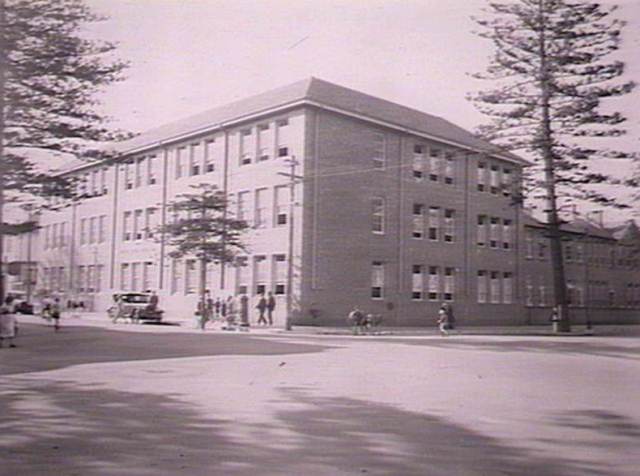 Well, they don’t have languages. They taught very sensible things; you learnt cooking and sewing and a few business principles; shorthand and typing up to quite an adequate standard. You had to pass all that and it was really good, you could get a good position afterwards with only three years there. I think in those days there were High Schools where you could go to five years but it was too far to go to a High School for me. Cremorne Girls High School was the closest one and the buses didn’t go directly to there. The buses were coming out here in those days, all the way to Palm Beach. I think you could board there but my parents didn’t want me to do that.
Well, they don’t have languages. They taught very sensible things; you learnt cooking and sewing and a few business principles; shorthand and typing up to quite an adequate standard. You had to pass all that and it was really good, you could get a good position afterwards with only three years there. I think in those days there were High Schools where you could go to five years but it was too far to go to a High School for me. Cremorne Girls High School was the closest one and the buses didn’t go directly to there. The buses were coming out here in those days, all the way to Palm Beach. I think you could board there but my parents didn’t want me to do that.
DOMESTIC SCIENCE. MANLY'S NEW SCHOOL
The Manly Domestic Science School, which was opened by the Minister for Education last week, Is a three-story building, set in pleasing surroundings at the intersection of Darley-road and Victoria-parade, adjoining the Public school. Owing to the many buildings on the school area, the site for the new school was restricted, but the best possible use has been made of the space available.
Brickwork has been used throughout for the wall construction, the roofing being of semiglazed French pattern terra cotta tiles. The domestic section consists of a large kitchen, pantry, laundry, and two sewing-rooms, with necessary staff and change rooms, adjoining which are two shelter sheds, three classrooms, and lavatories. In this section, which is on the ground floor. Is a home unit, consisting of a kitchen, dining-room, bedroom, and bath-room, so arranged as to provide a domestic atmosphere for Instruction relating to the management of a home.
The first floor is devoted to classrooms, the headmistress's room, staff room, stores, and an assembly hall. On the second floor there are additional class-rooms, a typing room, and a library. The building, which provides accommodation for 720 pupils, was erected as an unemployment relief work, at an estimated cost of £15,200, by the Building Construction Industrial Undertaking, under the supervision of the Government Architect, from plans prepared in his office. Building AND CONSTRUCTION. (1931, October 20). The Sydney Morning Herald (NSW : 1842 - 1954), p. 5. Retrieved from http://nla.gov.au/nla.news-article16802600 Picture of Domestic science School, Manly from GPO locations, image No: D1-28553r, Courtesy State Library of NSW
What did you do after you had been there?
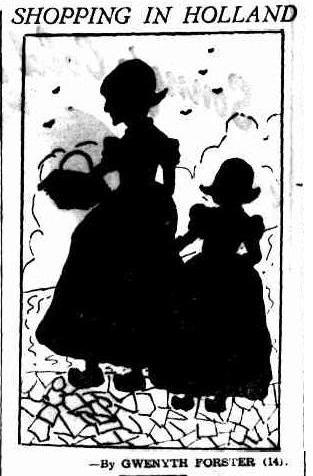 I won a scholarship, which was to a Business College which taught me more of the same but also ticket writing and commercial art. I'd always liked drawing. I was interested in the Ticket Writing and had just about finished a 12 month course there when my mother saw an advertisement in the Manly Daily for a department store in Manly which was called ‘Coopers’ who needed a ticket writer. I had just about finished my time so I took my portfolio over to Manly and I got a job there. I was sixteen when I was there. I loved the job, it was very interesting.
I won a scholarship, which was to a Business College which taught me more of the same but also ticket writing and commercial art. I'd always liked drawing. I was interested in the Ticket Writing and had just about finished a 12 month course there when my mother saw an advertisement in the Manly Daily for a department store in Manly which was called ‘Coopers’ who needed a ticket writer. I had just about finished my time so I took my portfolio over to Manly and I got a job there. I was sixteen when I was there. I loved the job, it was very interesting.
Left: SECTION FOR GIRLS AND BOYS Conducted by SOUTH WEST WIND. SHOPPING IN HOLLAND -By GWENYTH FORSTER (14). SECTION FOR GIRLS AND BOYS. (1939, June 5). The Sydney Morning Herald (NSW : 1842 - 1954), p. 23 Supplement: Women. Retrieved from http://nla.gov.au/nla.news-article27973270
What is ‘ticket writing’?
Ticket writing was doing big signs because the tickets were displayed, and most of them didn’t have prices on them, but they were on tables with big signs on them and I painted the signs, big or small. When there was a sale coming on of course and they all had to be wiped and another colour put on...similar to what they do today, and it was painting the signs with most of the prices on. The goods that were displayed in the windows, they all had to have signs on them. It was lovely.
So you were among all the best fashions and the newest things coming out?
Yes.
Did you try on any of these?
Oh no, but it was very interesting. The war was on by then of course, this was 1940. I joined the Navy from there. The recruiting office was in Loftus street, Circular Quay and I signed up there and went into the Navy then. I was eighteen then but was at Coopers for nearly three years.
There were a lot of Army girls and the Land Army, there were a lot of girls going in to that, and the Air Force but the Navy didn’t recruit any and I often thought if they did I’d go in. I was interested in any of them but my father was interested of course. Reluctantly the Navy eventually would allow women in but we weren’t very welcome. It was a very different culture from what there is today.
The Women's Royal Australian Naval Service (WRANS) was formed in April 1941 and by the end of the war more than 3000 women had served with the WRANS. Approximately 60 women joined the Royal Australian Navy Nursing Service (RANNS).
What did give you to do as your duties?
I was stationed at HMS Penguin which was at Balmoral. We did our Basic Training there, which was more or less marching around the oval and teaching us discipline. At the end of six weeks there were ten girls whose names were called out, and I was one of them, and they said, well you’re going to go to HMS Kuttabul, which isn’t in Garden Island as everybody thought. Garden Island was where the Kuttabul was moored and there was Garden Island, Pott’s Point. Garden Island was being connected to the land at this stage, in those days. They were making a road, called the ‘Burma Road’. Until then it was definitely an island.
Garden Island’s name stems from being the colony's first food source when gardens were established on the island. It was given to the crew of the Sirius to feed the colony on 27 January 1788. HMAS Kuttabul is the Royal Australian Navy's primary naval base on the east coast of Australia and located on Garden Island. The base is named for the steam ferry HMAS Kuttabul that was sunk while docked at Garden Island during the Japanese midget submarine attack on Sydney Harbour at 2.30am June 1st, 1942. Garden Island has been host to a naval base since 1856, when the government of New South Wales suggested giving the area over to the Royal Navy as a base for ships serving on the Australia Station. (1)
On 1 May 1940, Prime Minister, R.G. Menzies, told parliament : "A dry dock of a larger size than any in Australia has been an important strategic consideration since the size of capital ships has increased so greatly. I do not need to elaborate the great value to Australia of a dock capable of accommodating not only the largest warships but also merchant ships of great tonnage. The possession of such a dock would make Australia a fit base for a powerful fleet and would, in certain contingencies, enable naval operations to be conducted in Australian waters without the necessity for ships to travel 4,000 miles to Singapore for purposes of refit and repair. It is estimated that three years will be occupied in the construction of the dock."
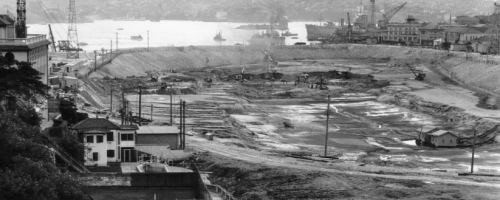
Garden Island was identified out of three options as the best and the construction of the graving dock, new workshops and modern machinery would be provided on the island, together with construction of a repair wharf with a 250-ton crane. The coffer-dam, known as the 'Burma Road', was commenced in December 1940 and completed in February 1942 this involved the reclamation of 30 acres between Potts Point and Garden Island and the construction of the graving dock approximately 1,140 feet (345 metres) long, 147 feet (45 metres) wide and 45 feet (14 metres) deep. (2)
Why did they carry on HMS Kuttabl even though she had been sunk?
It was a tribute I suppose, to all those sailors who were lost during that time. The Kuttabl was a training ship and all those boys lost were young trainees, some still teenagers. HMS Kubttabl was what was on our hats. It’s still the Kuttabl today. I was home here at Mona Vale the night that occurred.
What were your duties during this conflict was?
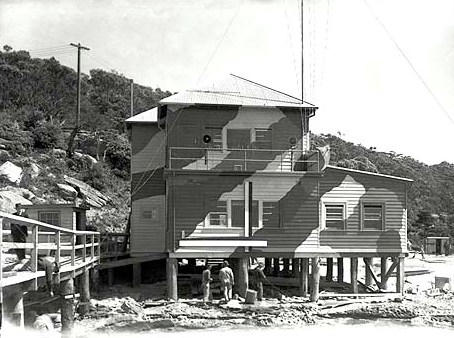 We were told we were to go to Bradley’s Head. We didn’t know what Bradley’s Head was and we were quite worried because we didn’t know of anything being there. An establishment had been built there by the American Navy, a camouflaged two storey building and it was called the Degaussing Range. I think because of my ticket writing training they decided I could do this work and we worked on charts there.
We were told we were to go to Bradley’s Head. We didn’t know what Bradley’s Head was and we were quite worried because we didn’t know of anything being there. An establishment had been built there by the American Navy, a camouflaged two storey building and it was called the Degaussing Range. I think because of my ticket writing training they decided I could do this work and we worked on charts there.
Degaussing is the process of decreasing or eliminating a remnant magnetic field. Degaussing was originally applied to reduce ships' magnetic signatures during WWII. It was the testing base really for degaussing; which is a bit of a complicated situation; but we used to operate ten instruments and from that the Electrical Officers who were with us would calculate the amount of electrical current that had to be passed around the hull of a ship to repel the magnetism of the mines, to make them safer in waters where there were these magnetic mines. It was quite a technical job.
We didn’t do the calculations. We operated the machines. It was similar to those heart monitors that have the lines going up and down and the ten gauges, we had to operate those while the ship was going across the harbour and their magnetism was being recorded on these machines. We would then take off the tape off these twelve machines and put them together and we would trace over those and give them to the Officers and they would calculate the necessary adjustments that needed to be made to the electrical current. They were the clever ones. It was very interesting. The Navy, the American Navy, stayed there for a couple of weeks to teach us girls how to operate the machines. There were ten of us who worked there, and four Naval Officers. There was a lot of camaraderie between us girls.
Did you go out together or were you on base all the time?
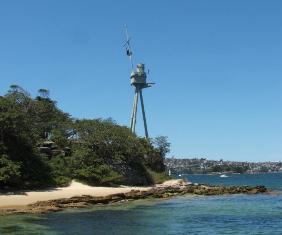 We were on base and would travel home. We did shifts of four hours; four on and four off. It was a heavenly place. It was right underneath where the mast of HMAS Sydney is. It was lovely. We called it ‘the hut’ but it was a two storey building (above right).
We were on base and would travel home. We did shifts of four hours; four on and four off. It was a heavenly place. It was right underneath where the mast of HMAS Sydney is. It was lovely. We called it ‘the hut’ but it was a two storey building (above right).
Left: The foremast of the cruiser HMAS Sydney, renowned for taking part in the Royal Australian Navy's first ship against ship engagement in World War I, is mounted on the headland of Bradley’s Head as a memorial to that battle. In June 2000 the mast was rededicated as a monument to all Australian ships and sailors lost in conflict.
What did you do when you went on Leave?
I went home to Mona Vale. We got plenty of Leave. We didn’t have very good transport to get to Bradley’s Head; we didn’t sleep there for the first six months. Once the American Navy left us we were under different rules and we came back under the RAN. We cooked for ourselves here; there was a fully equipped galley. None of us could cook very well; although we’d all gone to Domestic Science schools we’d never really put it into practice. We managed ourselves and we received a ‘living out’ allowance because we were living out.
To get to Bradley’s Head from Mona Vale we had to go to The Spit on the bus then a tram which finished at the Zoo (Taronga). Then we had to walk through Ashton Park to get to Bradley’s Head. It was quite a walk. When we wanted to go home we often use to catch a lift from various boats from one of the ships that were anchored in the harbour. If they were going ashore they’d come past and see if we wanted a lift. We had a jetty out to the end of the degaussing establishment and we used to get a ride from any boat going past that was going to Man O’ War steps at Garden Island. The girls would signal to them.
How many ships were in the Harbour?
Lots of them, lots of Merchant ships. They used to moor at Chowder Bay, which was just around the corner, and would have to pass us. They were bringing goods and supplies to Australia. When I think about it nowadays and all the dangerous things that happen to ladies, we were just so innocent, not thinking anybody would harm us, getting on boats with strangers, people from other countries, just to get a lift. You wouldn’t go on your own of course, there would be two or three of you. There were real gentlemen and real ladies then.
Do you remember the day peace was declared?
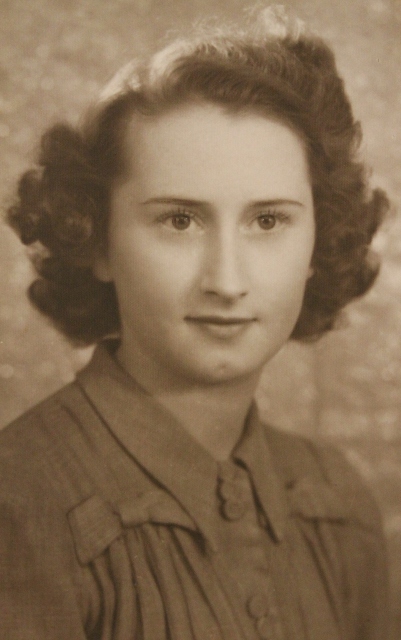 Yes. I was with the girls at Bradley’s Head that day; we were all celebrating. It was a wonderful day. We were still working so we just got on with it.
Yes. I was with the girls at Bradley’s Head that day; we were all celebrating. It was a wonderful day. We were still working so we just got on with it.
I had been married before then. I met him on the bus when I was going to work at Cooper’s. He was on the bus going into the City where he worked at a firm. We fell in love then, I think we were 16; it was an on the bus romance. He joined the Army and I joined the Navy. He was sent to Townsville and in the Transport Section of the Army. They taught the boys to maintain and drive the trucks. When he got out of the Army he didn’t want to go back to the office, he wanted to pursue this mechanical career that he’d forged while in the Army. He got an apprenticeship and became a motor Mechanic and liked that work very much. He had been training to be an Accountant prior to serving, so it was pretty different. I thought I was going to be ironing nice white shirts and ended up cleaning greasy overalls! So many of the Servicemen didn’t want to pursue what they had been doing prior to that war, they were very much different. He came home on Leave once a year and that was the only time we saw each other. We just had to correspond in between. Then we were married early in 1945 at St Matthew’s church at Manly.
At the end of 1945 I got out of the Navy and lived with my mum and dad. My husband was still away, he wasn’t demobbed as quickly as I. I went up to Brisbane and he came down on one of his Leaves and we spent ten days there and I was demobbed after that. I went to live in Brisbane then, because I was out of the Navy, and all I wanted to do was have a baby. A little while after that I did get pregnant and I had to come home straight away more or less because you had to book into a maternity hospital almost straight away in those days. I came home, and I wasn’t sure because I had nobody to ask what the symptoms were. I didn’t have a doctor or anything like that then. So I came home and booked into the Mater at Crows Nest. Eventually Gordon got demobbed.
After that we lived with mum and dad because we didn’t have a house. We then built a house on the block of land which my father had given to me and kept in case. My husband’s father was a builder, he worked at Hayman and Ellis Timber Yard They were at North Manly there, near the bridge. He had our house built for us; he engaged tradesmen; we got a loan of course, through a Building Society in Manly and built our dream home in Turimetta street, with mum and dad next door to babysit.
So you had two daughters?
Yes. Just the two girls.
What was Mona Vale and Warriewood like in the late 1940’s?
There were still a lot of glasshouses in Warriewood, more then Mona Vale. I’ve seen a lot of the big trees go from around here too; there used to be a lot more. We had double-decker buses then. The buildings have changed a lot; we didn’t like that Delmege structure at first, didn’t care for that at all, it was too modern. It’s been a godsend really; all the shops that were there originally; the supermarket, the butcher, the delicatessen and a chemist and a newsagent was wonderful. Now that I’m almost 89 and there’s nothing in there but Medical Specialists and that’s just what we need now! Nowadays I don’t give a hoot about the supermarket, it’s the doctors I need; the supermarket can stay where it is now and we’ll accept all the medical help we can get because we’ve got that big medical centre as well, so we’re very well provided for, and this place is so handy, no matter what you can walk over there.
You must have seen the roads change a bit too; more of them and change from being dirt roads to tarred ones?
Turimetta street was very much a dirt road but quite early in the piece these side roads were tarred, this would have been the 1950’s. I remember the sewerage tankers too. In 1945, when we were building the house, we used a fair amount of fibro initially, there wasn’t anything else, and we had a pan down the backyard and a toilet block. In the Services you got deferred pay later on; so the best thing we did was buy a septic tank with our deferred pay. We were very very happy with this; I had a toilet inside and I had a tiled bathroom, I insisted on a tiled bathroom. Goods were very very hard to get, you couldn’t get bricks, you could only get certain things and you had to put your name down for everything. You had to put your name down for carpet and it wasn’t carpet it was called ‘feltex’; it was soft but had no pile. You put your name down for Lino (linoleum) and the Service people got a little bit of preference. You had to put your name down for tiles. We did have a tiled roof, we were fortunate in that. My mother had a tin roof next door and it was very hot.
Gordon my husband died in 1974. I went back to work at David Jones in the Children’s Wear Department at Warringah. I worked there until I was 60; it was company policy to retire us at 60 in those days, all that knowledge then went to waste of course. In those days at David Jones we had the Cash’s woven name tags. All the parents stationed overseas had their kiddies in boarding schools in NSW. Parents would call from New Guinea, call in their lists of what was needed for their child, and the work room at David Jones used to put the name tags on for free, as part of the service; the parents would say, ‘ask Mrs Sneesby to do such and such.
I did Meals On Wheels for some years after I retired; it’s good to stay active, to be useful. I stopped doing that in 1999 though. I have been Activities Officer here too for a while (Pittwater Village – Mona Vale) and active in a few other areas with other people when asked. I knew Cora Adcock, she used to live in Elimatta Road here, she was a wonderful lady, did a great many things for so many people.
What is your favourite place in Pittwater and why?
Mona Vale. Because it is my home and has been all my life, since very early in the piece. I wouldn’t want to do anything else apart from live in Mona Vale.
What is your ‘motto for life’ or a favourite phrase you try to live by?
Do unto others as you would have them do unto you.
1. HMAS Kuttabul (naval base). (2013, April 14). In Wikipedia, The Free Encyclopedia. Retrieved from http://en.wikipedia.org/w/index.php?title=HMAS_Kuttabul_(naval_base)&oldid=550273844
2. Captain Cook Graving Dock, retirved from Garden Island NSW Community website at: http://www.gardenisland.info/1-02-010.html
3. Photo of A World War II degaussing building in use as a naval store, Bradleys Head, courtesy State Records NSW. Image no: MSBL 1826
NSW BDM's: 3507/1945 SNEESBY, GORDON TABER to FORSTER, GWENYTH HEATON - Registered at MANLY
Wedding group portrait for the marriage of Private Sneesby (4th from left) to Gwen H. Forster (5th from left). The identity of the other members of the group is not known. Private Sneesby and the other soldier at extreme left are members of a Motor Transport Unit of the Australian Army Service Corps (AASC). The bride was serving as a Writer with the Women's Royal Australian Naval Service (WRANS). Owing to wartime shortages of dress materials, she had had to borrow her wedding dress from a cousin who had married before the war. The bridesmaids' dresses were made from lengths of fabric purchased with clothing coupons scrounged from sympathetic relatives. As ribbon was unobtainable, the ties used for the bouquets were made from dress material, which accounts for their wrinkled appearance. The large bouquets indicate that flowers at least were in plentiful supply. (Original housed in AWM Archive Store)
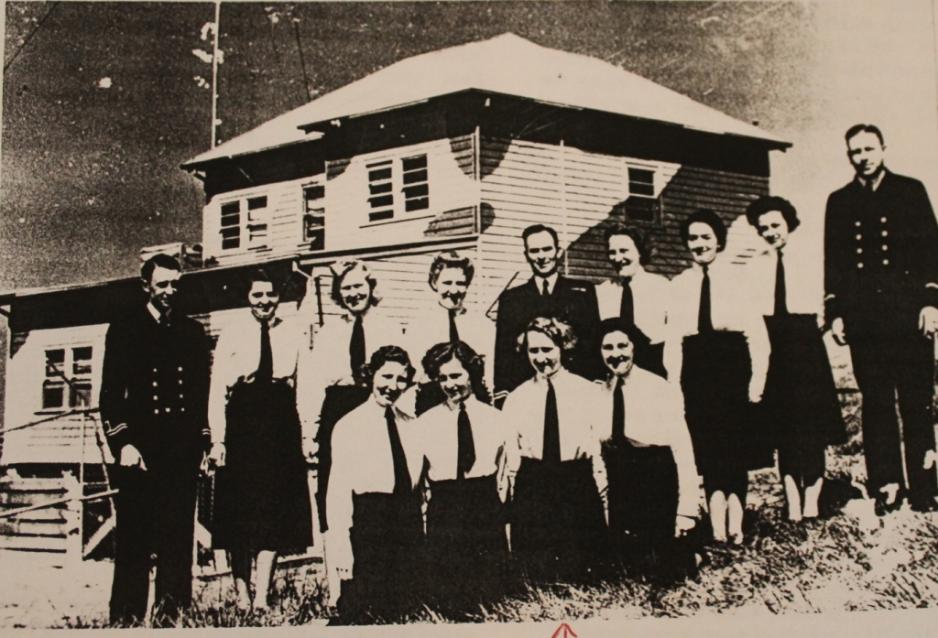
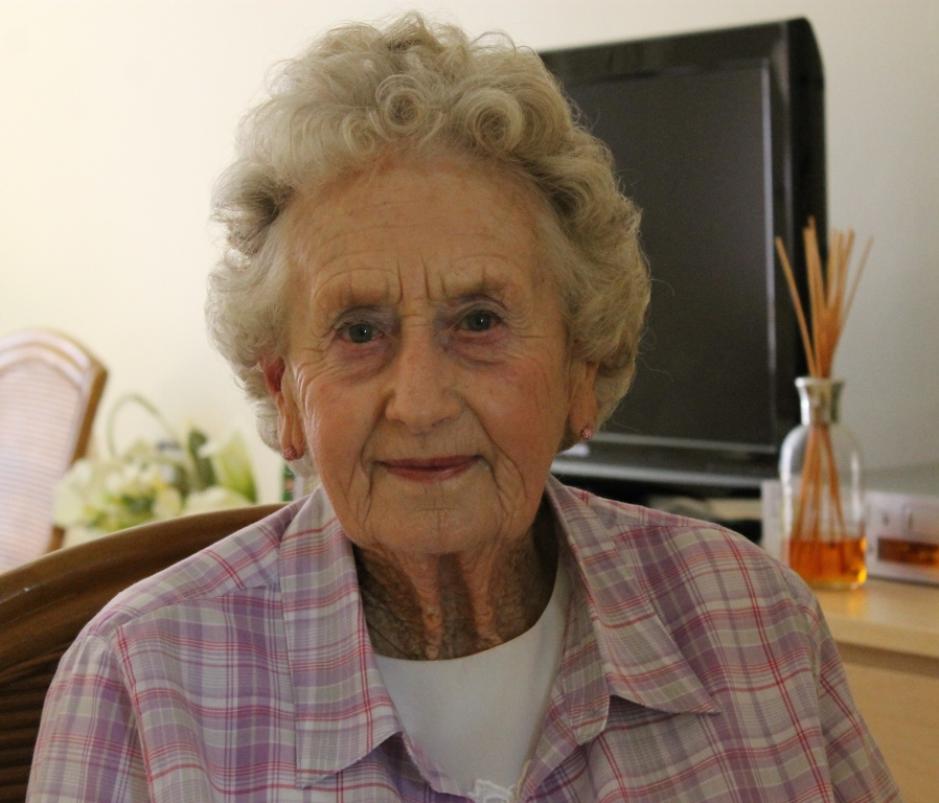
Gwyneth Sneesby, photo and interview: A J Guesdon, 2013.
FRAZER, D *
Douglas Ian Frazer - Service number 402498. Rank Pilot Officer, Unit 41 Air School South African Air Force. Service Royal Australian Air Force, Conflict/Operation Second World War, 1939-1945. Date of Death 01 February 1942, Place of Death South Africa, Cause of Death Accidental. Cemetery or Memorial Details East Bank Cemetery, East London, Eastern Cape Province, South Africa
Enlisted September 14, 1940, described as 5 feet 10 inches with fair hair and blue eyes, 21 years and 7 months works as a Clerk and father lives at 20 Kareela road Cremorne.
Seconded to RAF Kumalo Station at Bulawayo on January 15 1941 then to Adjunct no. 25 AFTS RAR at Salisbury Southern Rhodesia on March 6 1941. June 13 1941: G/Captain OC No.21 SFTS. December 9 1941 is seconded to W/O no 41 Air School. East London.
Nephew Of "Smithy" Among 54 New Commissioned Pilot Officers
THE names of 47 R.A.A.F. pilots, five air observers, and two wireless operator-air gunners serving in operational squadrons abroad, who were recently granted commissions as pilot officers, were announced today by the Minister for Air (Mr. Drakeford). -
THEY include Peter Kingsford Smith, of Sydney, who is a nephew of the late' Sir Charles Kings-ford Smith, and the well-known international cricketer, Richard Hastings Nitschke, South Australian left-hand opening batsman. These commissions were granted after urgent requests had been made by the Department of Air to RA.A.F. Overseas Headquarters in London to expedite the advancement of Australia's air crew personnel fighting the Empire's air battles in and around Britain and in other theatres of war. Mr. Drakeford revealed that all the airmen had been recommended for commissions by their commanding officers after having had actual operational experience.
Full List
They are: — Hugh McMaster (Q'sland) las from 5/11/41) ; John Rodney Henry Elphick (N.S.W.) ; George Maxwell Brlggs (Tasmania) ; Thomas William Scott (N.S.W.) ; Eric Blair Tainton (N.S.W.); William Stewart (Q'sland); Donald William Newborn . (Queensland) ; Frederick Revis McCann (N.S.W.); Clive Wawn (Vic.»; Derek Keith Ryder (Q'sland ); John Rutherford (N.S.W.); Alan James Leslie (N.S.W.). Lloyd George Scharer (N.S.W.l; Archie -Campbell (N.S.W.); Eric William Cuthbert Creed (Vic.) ; Ronald Charles Beckley (Vic.); Ian Seaforth MacKenzie (N.S.W.); Lionel Vivian Hudson (Vic.) : Maxwell Coup-land Johnston (Vic.) ; Geoffrey Wyndham Rose (N.S.W.) ; Lloyd Wilson Bailey (Q'sland); Norman Frederick -Rankin (N.S.W.), (as from 9/12/41); Ernest Olaf Lane (N.S.W.); Robert James Clarenden Whittle (Q'sland) ; Richard Hastings Nitschke (S.A.); Samuel John Morginv Bart-I lett (Vic.); Walter Kenneth Watts (Vic.); Walter William Beresford Gale (W.A.); Raymond Gershen Goldberg (S.A.), (as from 10/12/41); Alexander William Fraser (Q'sland); Hugh Gavin Fraser (N.S.W.). Donald George Totolos (N.S.W.); George ' Hubert Newbourne Shiells (Vic.); Ronald Wilkins Taylor (N.S.W.); Peter Kingsford Smith (N.S.W.); Malcolm Sydenham Humphrey (Vic.) ; Allen Bruce Slater (N.S.W.); Mervyn Richard Roberts Green (Vic.); Jfef-frles Earle Perry (N.S.W.); Warwick Bryan Poulton (N.S.W.); John Henry Eric Bisley 1 (N.S.W.); Lloyd Thaxter Rawnsley (N.S.W.); Terrence Maxwell Leslie Friend (N.S.W.) : William Wrixon Boylson (N.S.W.); John Allan Weller (Q'land) (as from 15/1/42); James Cowan and Peter Collin Boiler. Observers;— David Hamilton Paterson (Q'land); Leonard Cochrane (Vic.); Edward Francis Appleton (Vic.) (as from 9/12/41); Geoffrey Arthur Bennett (Vic.); Douglas Crawford Bell (Q'land) (as from 10/12/41). Wireless Operator-Air Gunners: — Kenneth Robert Symons (Vic.) (as from 9/12/41); Jacques Dupont (Vic.) (as from 10/12/41). 44 Flight-sergeants Mr. Drakeford said that at the same time as. these sergeants were -commissioned 44 airmen were promoted to Flight Sergeants, but their names had not yet been received at i R.A.A.F. Headquarters. These commissions were granted in accordance with the provisions of the Empire Air Training Scheme under which a number of commissions are granted at the conclusion of the training period in Australia, Canada, and other places. After active operations in the field an additional percentage of commissions are granted on the recommendations of commanding . officers. Nephew Of "Smithy" Among 54 New Commissioned Pilot Officers (1942, February 19). Daily Mirror (Sydney, NSW : 1941 - 1955), p. 2 (War News Edition). Retrieved from http://nla.gov.au/nla.news-article272092405
His NOK is listed as his mother Susan Ada Frazer who is living at 19 Sturdee Parade Dee Why. He serves until July 17 1946. Rank: Private, Posting at Discharge: 8 AUSTRALIAN INFANTRY BATTALION. NX112233 (N38521, N38821).
He serves in Bougainville, spending 627 days from May 19, 1944 until February 1946 at Emirau, Bougainville, and Rabaul.
He lives at 63 Lagoon Street Narrabeen in 1951 when applying to recover lost papers, and his Service Certificate, that went missing when moving.
GALLAGHER, J
John Patrick Gallagher, born November 7 1919, is working as the baker’s delivery as a teenager:
BOLTING HORSE
Stopped by Bystander.
YOUTH THROWN FROM CART.
Seizing the dragging reins, Robert Hickson, of Bayview, a pedestrian, stopped a horse which was bolting with a baker's cart yesterday in Bayview-road, Mona Vale, after the driver had been thrown to the roadway.
John Patrick Gallagher, 19, of Waratah-street. Mona Vale, was driving the outfit along Bayview-road when the horse bolted. Gallagher was striving vainly to control the horse when the offside wheel of the cart bumped over an embankment. The jolt threw him off the vehicle, and he fell heavily to the roadway.
The horse galloped along the road for an-other half-mile, turned round, and galloped back again. Several men had run to Gallagher's aid, and one of them, Hickson, grasped the trailing reins as the horse was passing and brought it to a standstill.
Dr. R. Belli, of Bayview-road, gave Gallagher attention on the roadside. Gallagher, who was suffering from lacerations to the right leg, abrasions, shock, and probably a fracture of the skull, was taken by the Manly Ambulance to the Manly District Hospital. BOLTING HORSE (1936, July 25). The Sydney Morning Herald (NSW : 1842 - 1954), p. 18. Retrieved from http://nla.gov.au/nla.news-article17255106
He initially lists his mother Grace Marion as his NOK when enlisting on January 26, 1942 and his occupation as Range Fitter. He is described as being 5 feet 10 inches, with blue eyes, brown hair and a tan complexion. They are then living at 4 Lily street Auburn. He is seconded into the ITB Unit and then into the 35 Australian Infantry Battalion.
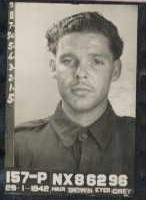
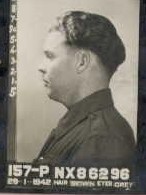
On June 30 1942 he is seconded into the 2/3 Australian Machine Gun Battalion, after those not captured in the earlier years of the 2/3 Australian Machine Gun Battalion were reformed.
On August 10 1942 he is appointed to L/Cpl, becomes, through promotion, A/Cpl on October 6 and is confirmed a full Corporal on January 20, 1943.
He suffered from injuries and illness when sent into New Guinea in December 1944. Henry MacPhillamy, who served in a medical capacity in New Guinea, explained in his Profile interview that he was transferred out of his unit into pathology, and that many men were made ill by local parasites, especially those carrying typhus.
He is sent back to Australia, disembarking on November 30, 1945. By December 1945, a scant few weeks before his Unit was demobbed, he was discharged to AMR & O 253 due to being needed in an 'Essential Occupation'.
His death in his War Records is stated to be October 20, 1957.
Although what happened is not truly known by anyone other than himself, it would appear he, alike many other men after this conflict, did not cope with civilian life:
BEFORE JUDGE O'SULLIVAN,
GALLAGHER v. GALLAGHER. Mrs. Valda Gallagher, formerly Smith, of Duckenfield, said in Maitland Divorce Court yesterday that she left her husband, John Patrick Gallagher, with their two children after he had "bashed her up." She had not returned. She said she was married on January 29 1944, at Maitland. There were two children. Her husband always drank, but things were fairly normal till after the birth of the second child. He then started to stop out all night three and four times a week. He would come home drunk, abuse her and knock her about. One night in December 1945, he came home drunk and 'bashed her up." She telephoned her parents, who went to the house, but her husband would not allow the children to leave. She locked herself In a room with them and left next morning. When her husband assaulted her, she told him she was going to leave him.' He said the best thing she could do was to get out. In 1950, an order was made against him for maintenance. He paid for only a few months. A warrant had been issued for his arrest. Judge O'Sullivan found the Issues of marriage and desertion In the affirmative. Mr C. R. Fry appeared for Mrs. Gallagher. DIVORCE COURT (1953, October 24). Newcastle Morning Herald and Miners' Advocate (NSW : 1876 - 1954), p. 6. Retrieved from http://nla.gov.au/nla.news-article140297272
IN the Supreme Court of New South Wales.—Probate Jurisdiction.—Re estate of JOHN JOSEPH PATRICK GALLAGHER, late of Sefton, pensioner, deceased, intestate.— Letters of administration granted by Supreme Court of New South Wales on 19th day of June, 1958.—Pursuant to the Wills, Probate and Administration Act, 1898-1954, Testator's Family Maintenance and Guardianship of Infants Act, 1916-1954, and Trustee Act, 1925-1942, Nancie Lilian Gallagher, the administratrix of the estate of the said John Joseph Patrick Gallagher, who died on the 20th day of November, 1957, hereby gives notice that creditors and others having any claim against or to the estate of the said deceased are required to send particulars of their claims to the said administratrix at the undermentioned address on or before the 28th day of August, 1958, at the expiration of which time the said administratrix will distribute the assets of the said deceased to the persons entitled, having regard only to the claims of which she then has notice.—Dated this 23rd day of June, 1958. PATRICK HARGRAVES & CO., Solicitors, 10 Martin-place, Sydney. 4255—£1 5s. IN the Supreme Court of New South Wales.—Probate Jurisdiction.—Re estate of JOHN JOSEPH PATRICK (1958, June 27). Government Gazette of the State of New South Wales (Sydney, NSW : 1901 - 2001), p. 1982. Retrieved from http://nla.gov.au/nla.news-article220275654
Birth:
GALLAGHER JOHN P37907/1919 Parents: WILLIAM P ALMA G - registered at REDFERN
Death:
GALLAGHER JOHN JOSEPH PATRICK 27910/1957 WILLIAM PATRICK GRACE MARY - registered at AUBURN
Locality on Enlistment: AUBURN, NSW, Place of Enlistment : PADDINGTON, NSW, Next of Kin GALLAGHER, GRACE, Date of Discharge: 15 Dec 1945, Rank: Corporal, Posting at Discharge: 2/3 MACHINE GUN BATTALION
AWM: 2/3 Australian Machine Gun Battalion
The 2/3rd Machine Gun Battalion was formed in June 1940 under the command of Lieutenant Colonel Arthur Blackburn, VC. Although raised in South Australia, B Company came from Victoria, C Company came from Tasmania and D Company came from Western Australia. Indeed, it was not until April 1941, that the whole battalion was brought together as a whole and this was on board the troopship taking them to the Middle East.
Arriving at the Suez Canal in mid-May, the battalion travelled to Palestine, where it joined the 7th Division which was preparing to invade Syria. Allied forces began their invasion of Syria on 8 June and were soon engaged in heavy fighting against the Vichy French.
Although Syria was a short campaign, the machine-gunners saw extensive service. B Company supported the 25th Brigade, covering the attack on Fort Metulla on 10 June and participating in the fighting around and defence of Jezzine. In mid-June, A Company supported the 2/2nd Pioneer Battalion attack on Fort Merdjayoun, while D Company was attached to the 21st Brigade, which captured Said (Sidon) and Damour. C Company's first action was at Quoneitra in support of British units. By the second week of July the campaign was over, with the Vichy French surrounding and a cease fire coming into effect at midnight on 11 July. The machine-gunners remained in Syria as part of the occupation force for the rest of the year.
But by now, though, Japan had entered the war and the AIF had been recalled to Australia. In January and February 1942 units from the 7th Division began to return to Australia and the 2/3rd (less B Company) sailed on 1 February. However, the battalion was about to caught in the Japanese thrust.
British forces in Singapore surrendered on 15 February. Two days later the troopship Orcades, carrying the 2/3rd, 2/2nd Pioneer Battalion, and 2/6th Field Company, reached Oosthaven in Sumatra, before going on to Batavia in Java. The Japanese were already moving through the Netherlands East Indies and, in what was more a political decision than strategic one, it was decided these divisional support units would make a stand on Java. It was a futile gesture.
The small Allied force that was supposed to defend Java was built around the 2/3rd and other units aboard Orcades, as well as a battery of American artillery already on Java and a squadron from the 3rd King's Own Hussars. Blackburn was promoted to brigadier and was placed in command of the force which became "Blackforce".
The Japanese landed on Java on 28 February. Blackforce went into action at Leuwiliang, near Buitenzorg, on 4 March. They fought the Japanese for two days but on 8 March Dutch forces surrendered and the next day Blackforce was ordered to lay down its arms.
Those who had survived the fighting spent the rest of the war as prisoners. For the next three years they were used for labour, most of them working on the infamous Thai-Burma Railway or languishing in prison camps. One-hundred-and-thirty-nine men from the 2/3rd died while prisoners.
However, not all of the battalion was captured. While its headquarters and fighting components were in action in Java, the battalion's B Company had returned to Australia in March. The group formed the basis of what was essentially a new 2/3rd, as from April the battalion was reformed at Ingelburn in Sydney, before it moved to the prisoner of war camp at Cowra in July.
In May 1943, after ten months at Cowra, the battalion moved to Queensland. Based at Deception Bay, C Company went to Moreton Island, D Company to Bribie Island, and B Company to Merauke in Dutch New Guinea. Later in the year the 2/3rd was concentrated at Wondecla, on the Atherton Tablelands, where it came under the command of the 6th Division.
The 2/3rd spent the rest of 1943 and almost all of 1944 on the Tableland. In December the battalion was sent to New Guinea to support the 6th Division's Aitape-Wewak campaign. But rather than fight as a machine-gun battalion, with its companies separated and supporting the division's different units, the 2/3rd fought as infantry from February 1945. The machine-gunners performed well in their new role, capturing a number of positions. B Company even made an amphibious landing at Dove Bay, east of Wewak, as part of Farida Force in May.
Following Japan's surrender in August, the 2/3rd's ranks thinned, as men were either discharged or transferred. In December the remaining members of the battalion returned to Australia and in January 1946 the 2/3rd was disbanded in Sydney.
GEE, D
Desmond ‘Hugh’ Gee was born November 14 1917 at Mona Vale. He enlisted June 26 1941 and was discharged January 10 1946. Service Number: NX37420, Rank: Private, Posting at Discharge: 2/30 Battalion. He lists Hugh James Gee, of Waterview Street Mona Vale as his NOK on his enlistment papers.
He is 23 years and 7 months old when he signs up, listing his occupation as a Builders Laborer. His address is later Darley Road Mona Vale – his father was a Manager of ‘La Corniche’ at Mona Vale in the early 1920’s. Desmond is described as being 5 feet 9 inches tall with green eyes, a fair complexion and light brown hair. He has a scar on his left hand. Prisoner of War: Yes.
His is another from Mona Vale who ends up in Changi after the Fall of Singapore.
.jpg?timestamp=1731039550877)
.jpg?timestamp=1731039570815)
The 2/30 Battalion
The AWM states: The 2/30th Infantry Battalion was formed on 22 November 1940 at Tamworth, New South Wales, with men drawn from Dubbo, Goulburn, North Sydney, Randwick, Wallgrove, and Wagga Wagga. The first 2/30th commander, Lieutenant Colonel F.G. "Black Jack" Galleghan, trained the men hard and they became known as "Galleghan's greyhounds".
The battalion was part of the 8th Division's 27th Brigade, the last AIF infantry brigade raised for service during the Second World War. At the end of July 1941 the main component of the 2/30th sailed to Singapore on board the Dutch ship Johan Van Oldenbarnevelt, as part of the convey carrying the 27th Brigade. The battalion then went to Malaya and soon put what it had learnt into practice.
Just before midnight on 7 December, Japanese forces landed at Singora and Patani in Thailand, and Kota Bahru in northern Malaya. They fought against British and Indian troops, until the 2/30th B Company ambushed the Japanese at Gemencheh Bridge, shortly before 4 pm on 14 January 1942. The rest of the battalion, located 4 miles to the rear of this position (in front of Gemas, on the Gemas-Tampin road), engaged the Japanese the next day. It was a brilliant ambush and the first AIF attack against the Japanese. The 2/30th suffered 20 killed or missing believed dead and 58 wounded. The Japanese casualties were thought to be about 1,000. The battalion had fulfilled its task of acting "as a shock-absorber" and "inflict[ing] as many casualties as possible", before falling back.
After Gemas, the 2/30th fought at Ayer Hitam and then in the defence of Singapore Island. However, they could not stop the Japanese and on 15 February the British commander on Singapore surrendered. The battalion spent the next three-and-a-half years as prisoners of war.
After the surrender the battalion was concentrated in Changi goal, where they were used as labour for work parties, first in Singapore and then in other parts of Japan-s Greater East Asia Co-prosperity Sphere. Men were sent to work on the Burma-Thailand railway, Borneo, and Japan. Over three hundred men from the 2/30th died during captivity.
A lucky few, however, were spared the ordeal. Prior to Percival's surrender, 44 men who had been sick, injured, or wounded, were repatriated to Australia. A few others escaped and managed to make their way back to Australia. But there was no attempt to reform the battalion.
The war finally came to an end in August 1945 and Japan signed the official surrender the following month. Yet due to the large number of Allied prisoners who needed to be repatriated, it took some time for the battalion survivors to return to Australia. Those in need of urgent medical care were flown back to Australia in varying aircraft, including Dakotas, Catalinas, and converted Liberator bombers. The majority returned to Sydney in October on board the Esperance Bay.
Desmond came home, recovered, and married Shirley Mime Goggin in Victoria in 1955.
He is listed as part of the Prisoner of War Memorial Ballarat.
He passed away March 10, 2003 aged 85 and his remains interred with his wife at Lilydale Lawn Cemetery in Lilydale Victoria:
a4445 Gee Desmond Hugh 1917 2003 Shirley M
a4445 Gee Shirley Mime 1923 1999 Desmond H

Photo of plaque: NX37420 - GEE, Desmond Hugh, Pte. - HQ Company, Carrier Platoon. View of the bronze plaque erected in the NSW Garden of Remembrance on Wall 16, Row K. The garden is adjacent to Sydney War Cemetery at the Rookwood Necropolis, and is maintained by The Office of Australian War Graves. The plaques are provided by The Office of Australian War Graves to commemorate eligible veterans who have died post war and whose deaths are accepted as being caused by war service. This form of commemoration is used when there is a private memorial elsewhere. photo courtesy G Wilson
GIBSON, F *
This young man's name was actually Donald Fraser Gibson – obviously he was known by his middle name as his father, who also enlisted and served after the loss of his son, had the same name.
Frazer is 25 years and 4 months old when he enlists on May 23 1940, his Occupation is ‘Labourer’ and his home is in Macpherson street, Warriewood. He has grey eyes, brown hair – he has a scar on his left forearm.
On May 31 1940 he goes into camp at Greta and is seconded into the O.C. 2/1 Pioneer Battalion. On September 30 1940 he embarks and then disembarks on November 2nd in Palestine. On December 21 1940 it is recorded he is detached to the 2/1 Ord. Stores Company from 17.12.1940 to 23.12.1940.
He had been transferred to become a Dispatch Rider when he died, KIA, on April 14th 1941, at Tobruk. His remains are interred in Tobruk War Cemetery.
Donald Frazer Gibson:
Service Australian Army
Service Number NX19426
Date of Birth 21 Jan 1914
Place of Birth WALLSEND, NSW
Date of Enlistment 31 May 1940
Locality on Enlistment WARRIEWOOD, NSW
Place of Enlistment PADDINGTON, NSW
Next of Kin GIBSON, DONALD
Date of Death 14 Apr 1941
Rank Private
Posting on Death 2/1 Pioneer Battalion
His father enlisted a few months later after being 'called up' and lists his occupation as 'Butcher' - the family has moved to Orchard Street Warriewood. He is 55 years old when he commences service and 62 when he is released. Serves 27.12.1941 - 25.10.1945.
His wife Kate moves to Telegraph Point, NSW during his service years.
Name GIBSON, DONALD FRASER
Service Australian Army
Service Number N387981
Date of Birth 23 May 1886
Place of Birth DUNGOG, NSW
Date of Enlistment 27 Dec 1941
Locality on Enlistment WARRIEWOOD, NSW
Place of Enlistment HOLSWORTHY, NSW
Next of Kin GIBSON, KATE
Date of Discharge 25 Oct 1945
Rank Lance Bombardier
Posting at Discharge AUST L H Q SCHL OF ARTY
On April 13–14, 1941, the 9th Australian Division and 18th Australian Brigade were besieged by German troops in the Battle of Tobruk. The 9th Australian Division was commanded by Lieutenant-General Leslie Morshead. The overall command of the Tobruk defence was held by Major-General John Lavarack, who was previously the commander of the Australian 7th Division.
The DVA states:
‘’The year 1941 was a dark one for the Allies. The Germans conquered all before them but Tobruk held out against Rommel and stood in the way of his advance towards Egypt and the Suez Canal. The defiance of the defenders of Tobruk raised morale in the countries of the British Empire and Commonwealth. Those who served there became known as the 'Rats of Tobruk', so-called because the German radio propaganda broadcaster 'Lord Haw Haw' described them as rats living in the ground.
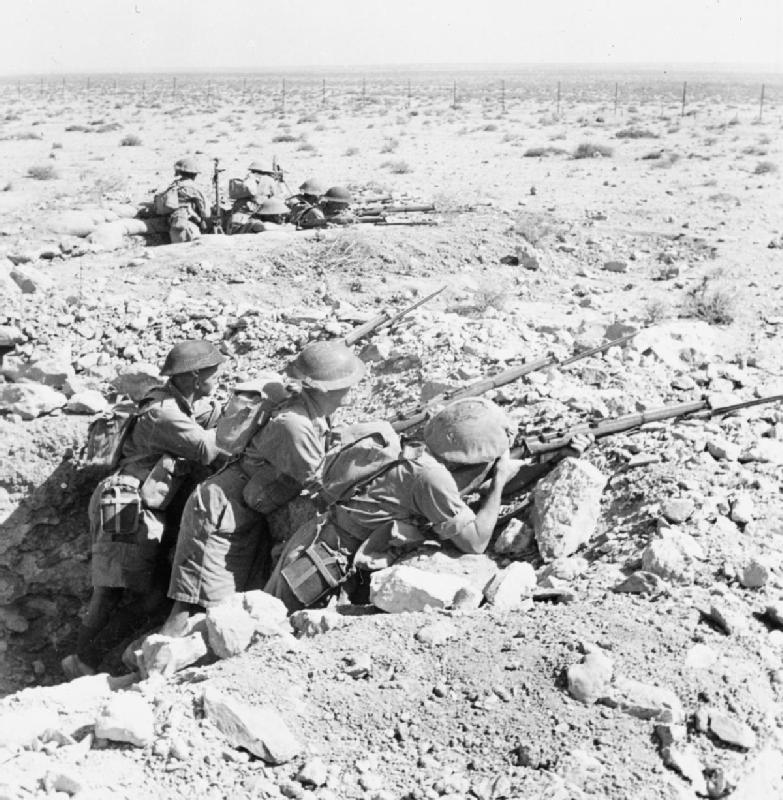
Australians at Tobruk. Photo: Imperial War Museum
By April, German forces had begun to cut off and surround Tobruk. For eight months, from April to December 1941,Tobruk was besieged and Australian forces, notably the men of the 9th Division, the 18th Brigade of the 7th Division and RAN ships of the famous 'scrap iron flotilla' played a prominent role in the town's defence.
Corporal John Edmondson, 2/17th Battalion, AIF, VC citation, The London Gazette, 1 July 1941:
On the night of 13th-14th April, 1941, a party of German infantry broke through the wire defences of Tobruk and established themselves with numerous machine guns, mortars and field pieces. Led by an officer, Corporal Edmondson and five privates carried out a bayonet charge upon them under heavy fire. Although wounded in the neck and stomach Corporal Edmondson not only killed one of the enemy, but went to the assistance of his officer, who was attacked by a German from behind while bayoneting another who had seized him about the legs. Despite his wounds, from which he later died, Corporal Edmondson succeeded in killing these two Germans also, thus undoubtedly saving his officer's life. Throughout the operation he showed outstanding resolution and leadership, and conspicuous bravery. –‘ John Hurst Edmondson was the first Australian to be awarded a Victoria Cross during World War II,’ – from: DVA (Department of Veterans' Affairs) (2021 ), Libya and the Siege of Tobruk 1941, DVA Anzac Portal, available at, https://anzacportal.dva.gov.au/wars-and-missions/world-war-ii-1939-1945/events/libya-and-siege-tobruk-1941
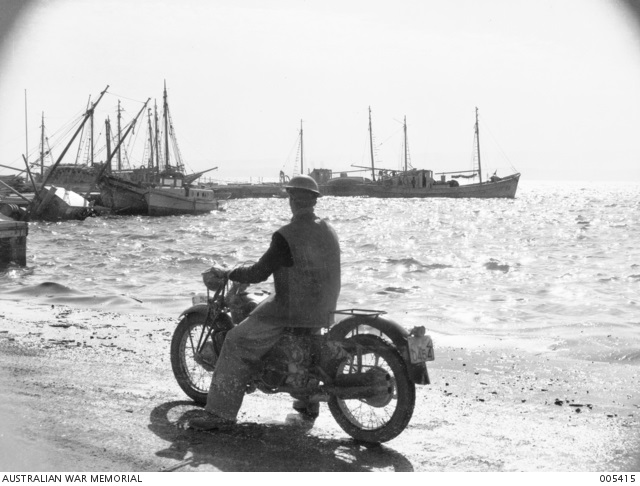
Photo courtesy AWM: TOBRUK. A DESPATCH RIDER ON HIS MOTOR CYCLE LOOKING AT SMALL FISHING AND TRADING SHIPS EITHER SCUPPERED OR BOMBED IN TOBRUK HARBOUR. (NEGATIVE BY F. HURLEY). Date of picture; 22 January 1941
The Siege of Tobruk took place between 10 April and 27 November 1941, during the Western Desert campaign (1940–1943) of the Second World War. An Allied force, consisting mostly of the 9th Australian Division, commanded by Lieutenant-General Leslie Morshead, was besieged in the North African port of Tobruk by German and Italian forces. The tenacious defenders quickly became known as the Rats of Tobruk. After 231 days, they were finally relieved by the British Eighth Army.
In late 1940, the Allies had defeated the Italian 10th Army during Operation Compass (9 December 1940 – 9 February 1941) and trapped the remnants at Beda Fomm. On 22 January 1941, Tobruk's Italian garrison surrendered. But in early 1941, much of the British Western Desert Force was sent to the Greek and Syria–Lebanon campaigns, leaving only a skeleton force short of equipment and supplies.
Adolf Hitler felt compelled to send reinforcements, commanded by Generalleutnant Erwin Rommel, to rescue his beleaguered Italian ally. Rommel launched Operation Sonnenblume (6 February – 25 May 1941), driving the Allies back across Libya to the Egyptian border. However, Tobruk held out, depriving Rommel of a supply port closer to the Egyptian–Libyan border than Benghazi, 560 mi (900 km) west of the Egyptian frontier. The Axis siege of Tobruk began on 10 April and continued despite two failed Allied relief attempts: Operation Brevity (15–16 May) and Operation Battleaxe (15–17 June). The garrison repulsed several Axis attacks. The port was frequently bombarded by artillery, dive-bombers and medium bombers, while the Royal Air Force flew defensive sorties from airfields far away in Egypt. Allied naval forces, such as the British Mediterranean Fleet (including the Inshore Squadron) ran the blockade, carrying reinforcements and supplies in and the wounded and prisoners out. Finally, Operation Crusader (18 November – 30 December) succeeded in raising the siege.
Siege of Tobruk
AWM: ''Between April and August 1941 around 14,000 Australian soldiers were besieged in Tobruk by a German–Italian army commanded by General Erwin Rommel. The garrison, commanded by Lieutenant General Leslie Morshead, consisted of the 9th Division (20th, 24th, and 26th Brigades), the 18th Brigade of the 7th Division, along with four regiments of British artillery and some Indian troops.
It was vital for the Allies' defence of Egypt and the Suez Canal to hold the town with its harbour, as this forced the enemy to bring most of their supplies overland from the port of Tripoli, across 1500 km of desert, as well as diverting troops from their advance. Tobruk was subject to repeated ground assaults and almost constant shelling and bombing. The Nazi propagandist Lord Haw Haw (William Joyce) derided the tenacious defenders as 'rats', a term that the Australian soldiers embraced as an ironic compliment.
Photo: Australian troops occupy a front-line position at Tobruk. Smith, N (Lt), No 1 Army Film & Photographic Unit - This photograph E 4792 comes from the collections of the Imperial War Museums (collection no. 4700-32)
The Royal Navy and the Royal Australian Navy provided the garrison's link to the outside world, the so-called 'Tobruk ferry'. These ships included the Australian destroyers Napier, Nizam, Stuart, Vendetta and Voyager. Losses comprised two destroyers, including HMAS Waterhen, three sloops, including HMAS Parramatta, and 21 smaller vessels.
Half the Australian garrison was relieved in August, the rest in September-October. However, 2/13 Battalion could not be evacuated and was still there when the siege was lifted on 10 December, the only unit present for the entire siege.
Australian casualties from the 9th Division from 8th April to 25th October numbered 749 killed, 1,996 wounded and 604 prisoners. The total losses in the 9th Division and attached troops from 1st March to 15th December amounted to 832 killed, 2,177 wounded and 941 prisoners. –‘’ AWM
Wikipedia; - ‘The Germans were surprised, having assumed that the shipping at Tobruk was to evacuate the garrison and planned a night attack by the 5th Light Division for 13/14 April. Groups of Axis vehicles were attacked by 45 and 55 Squadrons RAF, which rearmed at the airfields inside the perimeter.’
‘The attack began after dark, with an attempt to get over the anti-tank ditch west of the El Adem road in the 2/17th Australian Battalion sector, which the Australians repulsed. Another attempt was made later and by dawn a small bridgehead had been established, where the 5th Panzer Regiment drove through and turned northwards, ready to divide into one column for the harbour and one to move west to stop the escape of the garrison.
The German tanks were engaged head on by the 1st RHA and veered away, only to drive into the path of the British cruiser tanks, waiting hull-down and received anti-tank fire from three sides, losing sixteen of 38 tanks and retreated. The Australian infantry had stood their ground and pinned down the German infantry. As the retreat continued, every gun and aircraft at Tobruk fired into the area and the German 8th Machine-Gun Battalion lost about 75 percent of its men including its commander Gustav Ponath, for a garrison loss of 26 men killed, 64 wounded, two tanks and a field gun knocked out. Attacks from the south were abandoned and the 5th Light Division dug in, with the Schwerin Group (renamed after Prittwitz had been killed) to the east. In support, the Luftwaffe and Regia Aeronautica flew 959 sorties over Tobruk; on 14 April 40 Ju 87s bombed the defences and on day 27 they succeeded in destroying a heavy anti-aircraft battery at Tobruk by swamping the defences with 50 aircraft allowing for an entire staffel (12) to concentrate on each gun.’
2nd AIF Order of Battle - Tobruk
9th Australian Division
18th Brigade Detached from 7th Division (2/9th, 2/10th, 2/12th Battalions)
20th Brigade (2/13th, 2/15th, 2/17th Battalions)
24th Brigade (2/28th, 2/32nd, 2/43rd Battalions)
26th Brigade (2/23rd, 2/24th, 2/48th Battalions)
2/1st Pioneer Battalion
2/12th Field Regiment
2/3rd Anti-Tank Regiment
24th Anti-Tank Company
26th Anti-Tank Company
2/3rd Field Company Engineers
2/4th Field Company Engineers
2/7th Field Company Engineers
2/13th Field Company Engineers
2/11th Field Ambulance
(from: http://www.militarian.com/threads/australian-order-of-battle-1939-1945.5201/ )
No one forgot these lost loved ones – even years later Memorials appear in local papers:
RATS OF TOBRUK.— To the ever-lasting memory of our deceased Comrades who fell in the siege of Tobruk from 9th April to 13th Nov., 1941. From Members of Rats of Tobruk Association, Queensland Branch.
BROWN.— In proud and loving memory of QX5092 Private A J. Brown, 2/2 A.C.C.S., killed in action Tobruk 10/4/41. Inserted by his Widow and Children. Family Notices (1949, April 9). The Courier-Mail (Brisbane, Qld. : 1933 - 1954), p. 12. Retrieved from http://nla.gov.au/nla.news-article49687831
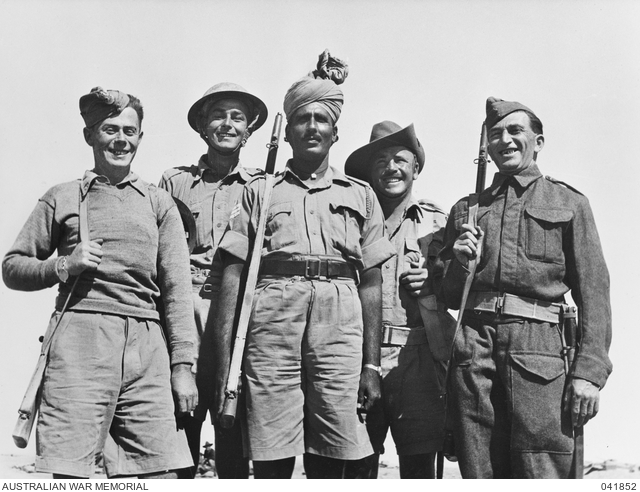
Photo: Soldiers from each of five different allied armies fighting together against the Germans and Italians in Tobruk, Libya. From the left they are Polish, British, Indian, Australian and Czech. Courtesy AWM, Unknown author - from www.awm.gov.au/collection/C273600
At home, on a Wednesday, April 30 1941:
KILLED IN ACTION
On Wednesday word was received by the relatives of Corporal Frazer Gibson that he had been killed in action. Corporal Gibson was the younger son of Mr. and Mrs. 'Dinny' Gibson, of Warriewood, and formerly of Dungog. Besides his parents, one brother and one sister survive him. Mrs. J. Wilson, junr., of Dungog, who is a sister of Mrs. Gibson, went to Sydney on Wednesday night to stay a few days with the family. KILLED IN ACTION (1941, May 2). Dungog Chronicle : Durham and Gloucester Advertiser (NSW : 1894 - 1954), p. 2. Retrieved from http://nla.gov.au/nla.news-article141277407
KILLED IN ACTION
Word has been received by Mrs. S. Elford, The Hatch, that her brother, Private Donald Fraser Gibson, has been killed in action abroad. Private Gibson was educated at Port Macquarie Public School, his parents at the time residing at North Shore, on Mr. J. P. Mclntyre's property. He enlisted at Warriewood, near Manly, where his parents now reside. At the last meeting of the W.C.F., a letter was read from this soldier acknowledging a parcel forwarded by that body. Duty nobly done, he has paid the supreme sacrifice, and his name will rank with others who travel the same path of destiny. We sympathise with the bereaved parents and family in their hour of sorrow. KILLED IN ACTION. (1941, May 3). The Port Macquarie News and Hastings River Advocate (NSW : 1882 - 1950), p. 4. Retrieved from http://nla.gov.au/nla.news-article130481129
GIBSON.-April 14, 1941, killed in action, Driver Donald Fraser, beloved youngest son of Donald Fraser and Kate Isabelle Gibson, of Warriewood, and brother of Nettie and Gordon, aged 26 years. Family Notices (1941, May 17). The Sydney Morning Herald (NSW : 1842 - 1954), p. 12. Retrieved from http://nla.gov.au/nla.news-article17745341
Dispatch Rider Killed
News has been received by relatives that Dispatch Rider Fraser Gibson has been killed in action. He enlisted from Warriewood. Narrabeen, with the 2/1 Pioneer Battalion. He left Australia six months ago as a transport driver, but was transferred to dispatch riding. He was 20, and was the son of Mr. and Mrs. Donald Gibson. He was a native of Wallsend. HAMILTON MAN KILLED (1941, May 7). Newcastle Morning Herald and Miners' Advocate (NSW : 1876 - 1954), p. 5. Retrieved from http://nla.gov.au/nla.news-article139405773
A.I.F. CASUALTIES AT TOBRUK :
Should Not Exceed 300 MELBOURNE, January 29.
Australian casualties in the taking of Tobruk would not be as heavy as in the capture of Bardia. said the Minister for the Army (Mr. Spender) today.
It was not expected that they would exceed 300. 1 This information had been received late last week from Army Headquarters in Libya, and no further reports of total casualties had been sent. There was no official information yet regarding the part of the A.I.F. in the action at Derna. Army Headquarters said that the original estimate of Bardia casualties—about 500—was correct. This figure was applied specifically to the attack on Bardia. It had been increased, and might be increased further, by casualties sustained in isolated engagements.. ' such as mopping up after the actual fall of Bardia. Army Headquarters had no details of these isolated engagements. With casualty lists released today A.I.F casualties at Bardia and in isolated engagements have now reached the total of 550—122 killed, seven missing, and 421 wounded. The list is:— …. A.I.F. CASUALTIES AT TOBRUK : (1941, January 30). The Advertiser (Adelaide, SA : 1931 - 1954), p. 12. Retrieved from http://nla.gov.au/nla.news-article41917666
CAPTURE OF TOBRUK IS COMPLETE
Australian Casualties May Not Exceed 300
LONDON, Jan. 23. A.A,P.-The capture of Tobruk was completed last night. This was announced in a communique issued by British General Headquarters in Cairo. The communique added: "Our casualties were under 500. The enemy casualties cannot yet be fully ascertained, but 2000 wounded have been evacuated. Fourteen thousand prisoners have already been taken. The prisoners include a corps commander, a divisional commander, and two of their generals, an admiral and a number of senior army and naval staff officers. We captured about 200 guns of all calibres, and quantities of other military material. Another' communique states that the Italian forces which have been eliminated comprise the equivalent of eight Blackshirt and three Libyan divisions, in addition to thousands of noneffective troops. Tobruk was defended by an entire division, in addition to the permanent garrison, most of which has been captured. The Australian casualties were not likely to exceed 300, Lieut.-General Sir Thomas Blarney reported in a message to the Australian Army Minister (Mr. Spender).
It is authoritatively stated in London that among the prisoners taken at Tobruk are the headquarters of the Italian Army Corps, its general, and the general commanding the 22nd town fixed defences. The British have taken large booty, including guns, tanks, motor vehicles, munitions, supplies, and three ships, including a large liner found burnt in the harbour. It is estimated that 100,000 prisoners have been taken since the British offensive began. No figures of casualties on either side are yet available in London, but ours are understood to be light. Italian Explanation Referring to the latest setback in Libya, the Rome radio stated: "The news from Tobruk is not good, but it must not irighten us. Tobruk is not a stronghold like Taranto and Spezia. Therefore, it could not hold out in the same manner. Moreover, an attack from the east was not foreseen, and fortifications cannot be improvised. Our enemy is losing no time. It has become necessary to conduct a defensive instead of an offensive war." A Rome communique said: "Hard fighting for the stronghold of Tobruk continued throughout yesterday. Only in the afternoon did Australian troops succeed in penetrating the inhabited quarters, which had already been set on fire. The old ship San Giorgio was blown up. Some units of the western sector of the fortifications continue their resistance. "Our forces at Tobruk consisted of one division reinforced by a few naval and frontier guard contingents. The enemy himself admits that-the losses inflicted on his five divisions were particularly seriaus. Our air force bombed enemy troop concentrations. The enemy carried out an attack at several points in Libya." Fell Within 30 Hours A picture of' the full triumph scored at Tobruk is now beginning to emerge, states a B.B.C. bulletin. It is calculated that since December 9, when the first attack began, 100,000 Italian prisoners have been taken. Individual observers with the Imperial forces in the Libyan Desert have described reeterday's action. The British United Press correspondent declares that if the Empire forces had had one more hour of daylight, or if they had not wanted to avoid needless casualties, they could have been into the town of Tobruk on the same day as the attack was made. As it was the town was entered and all the defences overrun within 30 hours. Mopping up operations were in progress yesterday afternoon, and the task has probably been completed by now.
Thousands more prisoners, hundreds of guns, and vast quantities of munitions have been taken. The Italian garrison had been outmanoeuvred ever since British advance units made contact. The British duped them into giving away their gun positions. and moved mechanised forces. tanks, and armoured cars from point to point around the perimeter defences until the garrison troops were completely bewildered. Troops were moved up and so skilfully disposed that it was difficult, if not impossible for the Italians to tell where they were concentrated. When the time came for the attack the Italian gunners could make no adequate reply to .the tremendous barrage laid down by mobile guns, tanks, and armoured cars. The Royal Air Force had cleared the sky. While the bombers played havoc with the Italian defences the fighters patrolled to prevent Italian planes observing for the artillery. The result was that the Italian gunners had to rely on trying to spot the British gun positions from a line of poles.
One Australian gunner officer told the correspondent that every time a pole squatter went up they shot him down again, and kept the Italians firing blindly. While the Italians were bewildered by offensive movements all around their positions. the main onslaught was hurled against their lines near the road from Bardia to Tobruk. Heavy gunfire kept the defenders crouching for cover, while sappers rushed out to clear a way for the tanks.
Once the tanks were through, the Australians, men of a famnslas British yeomanry regiment, and North of England troops went into action and stormed the Italian positions. The Australian brigade headed for strong gun positions above Tobruk itself and took them two hours ahead of schedule. By 5 o'clock in the evening they were within 10 minutes' walk of the town itself. They could see the disabled Italian cruiser San Giorgio, an 8000 ton Italian liner, and an oil tanker, all ashore and burning furiously. Smoke was pouring up from the fort and supply depot.
The capture of the town is believed to have been carried out with relatively small casualties, but some correspondents say that the Italians fought harder than at Bardia. The Italians also had the advantage of strong positions. There were nearly 150 strong posts, more than half of them protected by a camouflaged concrete anti-tank trench, and. around them was barbed wire. Almost entirely round the fortifications was a double fence of barbed wire, and an anti-tank trench 12ft. deep and 20ft. wide. In places where the Italians had not finished blasting their trench out of the solid rock they had planted anti-tank mines as close together as coping stones, and had put out a line of booby traps. The sappers made it possible for the troops to go through, and for the tanks to rumble into the attack over improvised crossings.
The The Navy and the Air Force had a very big share in the capture. Several correspondents have commented that not a single Italian plane attempted to intervene, and they all mention the tremendous effect caused as the 151n. guns of the fleet poured broadsides into the Italian positions. Free French units, who took part in the attack on Tobruk, are now stated to have been composed of a detachment from Cyprus. This detachment had been considerably strengthened by effectives brought from Syria, and they were in the forefront of the attack 'both a Sidi Barrani and Bardia. According to the independent French agency. the Free French troops in Egypt are shortly to be reinforced.
Top map shows the defences of Tobruk. Bottom: Beyond Tobruk lies the SJebel Plateau, rising in the east to 700 feet and in the west to 1800 feet. One road from Tobruk follows the coast, another crosses the plateau.
The Story of Tobruk
(From R. A. Glennie, Our Special Correspondent with the A.I.F.)
INSIDE TOBRUK DEFENCES, January 23.-They've done it again! Once more the men of the A.I.F. have proved themselves more than a match for Signor Mussolini's crack Fascist regiments. Storming the Tobruk defences early on Tuesday morning, just as they had done those of Bardia on. January 3. they quickly had the Italians at their mercy. As at Bardia, the prisoners were captured quicker than they could be counted. By nightfall they numbered some thousands. When fighting ceased for the day the Australians had gone well beyond the original objectives set down for them. They had advanced five miles inside the enemy's outer defence line, which extended over a front of 28 miles. On Tuesday night they rested on ridges overlooking the harbour and town of Tobruk. The tactics employed were similar in almost every detail to those which succeeded at Bardia. As at Bardia, the Australian troops were assisted in their task by the Royal Tank Corps, British machine-gunners, and British anti-tank gunners. As at Bardia the Italian artillery regiment fought well until overwhelmed by our tanks and infantry, but the Italian infantry did not hold out so long.
Italians Poor Fighters
The fact that the Italians have been proved poor fighters does not detract rem the performances of the Australian and British troops at Bardia and Tobruk. In both battles the attackers had to face determined and well-directed artillery fire. Each time they were opposed by an infinitely stronger force, both in men and guns. .It was the ingenuity of the battle plan and the courage with which it was carried out that devastated the Italians. But, to quote an Australian brigadier to whom I spoke at the conclusion of the day's fighting: "We would never have got away with it if we had had to try to root Germans out of these defences." It is now revealed that the defences of Tobruk were not comparable to the strength of those at Bardia, although it s; at present estimated that the enemy bad more guns at Tobruk. Strong posts on the perimeter at Tobruk were not to be compared. either in structure or numbers, with those surrounding Bardia, Olthough the front was 13 miles longer.
Magnificent Work by R.A.F.
Once again the Italian Air Force distinguished itself by its absence. And Once again the Royal Air Force.. by reconnaissance and bombing before the battle and army cooperation during the* itle, proved itself among the most deriee weapons brought to bear upon the enemy. Throughout the night preceding the attack. the R.A.F. bombers never let tp their bombing over Tobruk. Throughout the battle fighters sent "spotting" planes continued to assist the ground nests pressing home the attack.
One of the reconnaissance planes, affectionately christened "Lucie" by the A.I.F., seemed to be continuously soaring overhead, giving our artillery the range on the enemy guns and dropping messages relating to the disposition of the enemy ground forces.
The night before the attack I sat all night in a car close up behind the artillery and infantry units which were allocated the job of opening the attack. It was a night I shall not easily forget From sundown until midnight it was like having a Darlinghurst flat-top view of Sydney Harbour pyrotechnics. Red, blue and yellow lights illumined the sky as the Italian guns sought to thwart the R.A.F. bombers in their determined efforts to wreak havoc on the Italian lines. Blue tracer bullets streaked perpendicularly skywards, while strings of flaming onions hung suspended like red sky rockets seeking to entrap the wings of the bombers. From a valley on the other side of the ridge sheets of yellow flame lit up the landscape as bombs found their targets in the enemy's dumps of ammunition and cordite. Until midnight they competed with the stars to beautify the heavens. Then came a period of calm. It was broken only occasionally by the sharp crack of our artillery and the chatter of enemy machine-guns trying to locate our patrols. Wrapped in a warm blanket inside the closed car I was cold enough. What our men, lying out in the open waiting for the dawn, must have felt like I could scarcely imagine.
Waited for Zero Hour
What would the morning bring ? What would it cost in British and Australia, yes, and Italian lives ? These were some things I was wondering as I waited for the zero hour, when the barrage would begin and the Australian engineers and infantry would break the wire and jump in the tank traps to make way for the tanks. For days past they have borne the spirit of men who have not known defeat. They had weathered 48 hours of one of the worst dust storms the Libyan Desert can produce, and they had come out smiling because they knew that the day for a second crack at the enemy was at hand.
The wind and dust had died down, and, as a Wollongong sergeant reminded me, "We had a nice day for it." I was on the verge of dropping off to sleep when it started. On the right flank of the perimeter a Victorian battery opened the barrage. It beat the other batteries all along the front by a split second. Then the noise became almost deafening. Spurts of red flame split the dawn as the guns sent shells screaming towards the enemy. Muffled explosions of grey and black turned to yellow as Italian shells landed in the dust a few hundred yards from where I was sitting. The rat tat of machine-guns distinctly told us that sappers and infantry had made a dash for the tank trap. Gradually the fire of our guns was lifted to cover their operations.
Gradually the enemy's shells burst farther from us as the Italian Runners sought to intercept the advance of our infantry. Under cover of the noise made by the barrage the tanks crept up and through the gaps the sappers and infantry had made. The battle was now well under way. For two hours we got progress reports from divisional headquarters. Then in the wake of the tanks and infantry we were allowed through the outer defences to watch the battle.
In a ditch we saw two abandoned Italian tanks with kangaroos painted on the turrets.
Used Italian Tanks
An Australian cavalry squadron had salvaged a number of these medium Italian tanks after Bardia, and reconditioned them for the Tobruk offensive. One of them was used successfully to silence an Italian post at Tobruk. which was made up of two Italian, tanks dug in the form of a pill-box. It was the irony of war that this post, which held up the advance of one Australian brigade. should have been captured by one of the Italians' own tanks. As we drove to the top of the first ridge inside the perimeter, a sight, which is becoming familiar wherever Italians are engaged in the war. met our eyes. It was a column of a thousand or more green-coated Italian infantry walking unarmed glumly towards us. At the head of the column a sergeant carried a white handlkerchief on a stick. Fearing that they might be mistaken for soldiers prepared to fight, numbers of others in the column waved white cloths. or held up their hands. signifyine that they had surrendered.
These were some of the Fascist warriors with whom Mussolini proudly prophesied he could conquer any nation. A thousand of them were glad to give up the fight and walk meekly into captivity under the guard of two Australian sappers, who had taken 100 prisoners alone in a dugout while searching for a water cistern.
As shells from their own guns burst near them the prisoners pleaded with the guards to hurry them out of the danger zone. I was trying to make conversation with one of them when a salvo of Italian shrapnel burst almost overhead. It will take a bigger man than Mussolini to make soldiers of that man's type. I had to laugh as he ran to rejoin the column, which was now walking quickly towards gaps in the wire leading to the prisoners' cages. As we moved forward the second phase of tile battle was well under way.
In the first phase two infantry brigades, one from New South Wales and one from Victoria, had penetrated the defences. They were accompanied by tanks and British machine-gunners. In the second phase the most important role was played by a composite brigade composed of one battalion of men from New South Wales, one of Victorians, and one of West Australians.. Tiss brigade had passed between the gap in the wire to take up the attack at a more advanced starting line. Like the brigades which went in at the beginning of the attack, the third brigade arrived on schedule and attained its objective at the time set down in the plan of battle.
Casualties Were Light
Considering the ground covered and the area completely cleared of enemy troops, casualties on the first day were exceptionally light, but it was in the second phase that the Australian troops met the most serious resistance from enemy gunners and suffered most casualties. The main opposition met by the A.l.F. was from artillery and machine-gunners. As the Australian infantrymen waited for their own guns to be brought forward to resume the fire on enemy guns and protect their advance deeper into the Italian positions, they lay or sat on the ground in the middle of the battlefield. They would advance several miles on foot and then be glad to unstrap their equipment and lay down their rifles to take a snack of biscuits and bully. Before I left the battlefield I stood on the top of a ridge looking towards Tobruk, The town was still out of sight, but across the broad brown plain I could see companies of infantrymen advancing up a distant slope which overlooked the town. A little way beyond they stopped for the night and resumed the attack in the morning. CAPTURE OF TOBRUK IS COMPLETE (1941, January 24). Newcastle Morning Herald and Miners' Advocate (NSW : 1876 - 1954), p. 9. Retrieved from http://nla.gov.au/nla.news-article140439123
WHETTON, N
Norman Ernest Whetton was born May 8th 1918 at Northbridge.
ROBBERY AT NORTHBRIDGE.
After forcing a window, thieves entered the residence of Reginald Norman Whetton, in Eureka-street, Northbridge, on Friday night, and stole a quantity of clothing and 20 cigars, together valued at £8. ROBBERY AT NORTHBRIDGE. (1919, March 10). The Sydney Morning Herald (NSW : 1842 - 1954), p. 11. Retrieved from http://nla.gov.au/nla.news-article15828875
He was living at Mona Vale soon after his dad was robbed at Northbridge and once he had left school was working as a Market Gardener, although he had an occupation as a Diesel Engineer as well before enlisting on January 8th 1940 at Richmond (Air Base) aged 21 and 7 months.
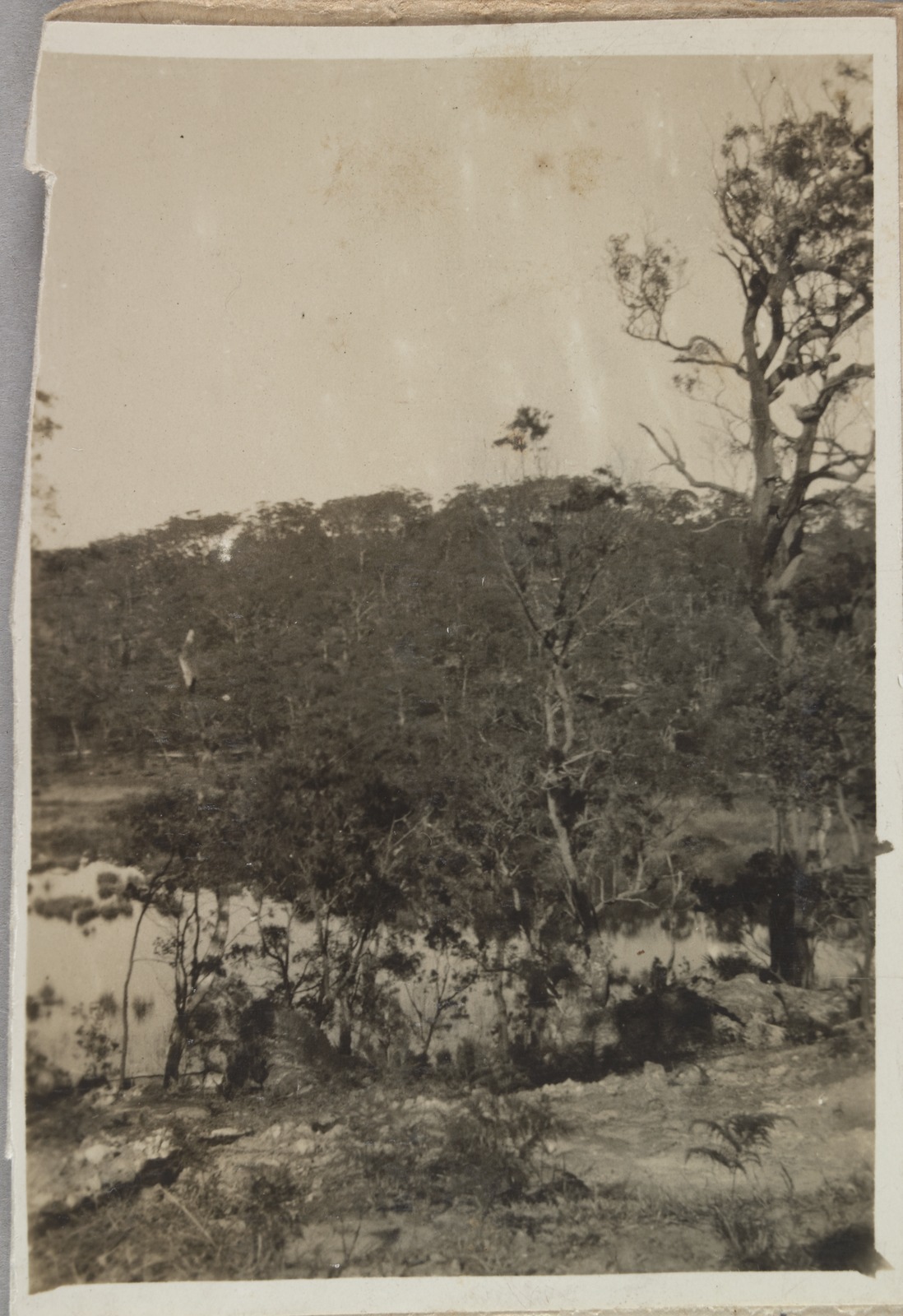
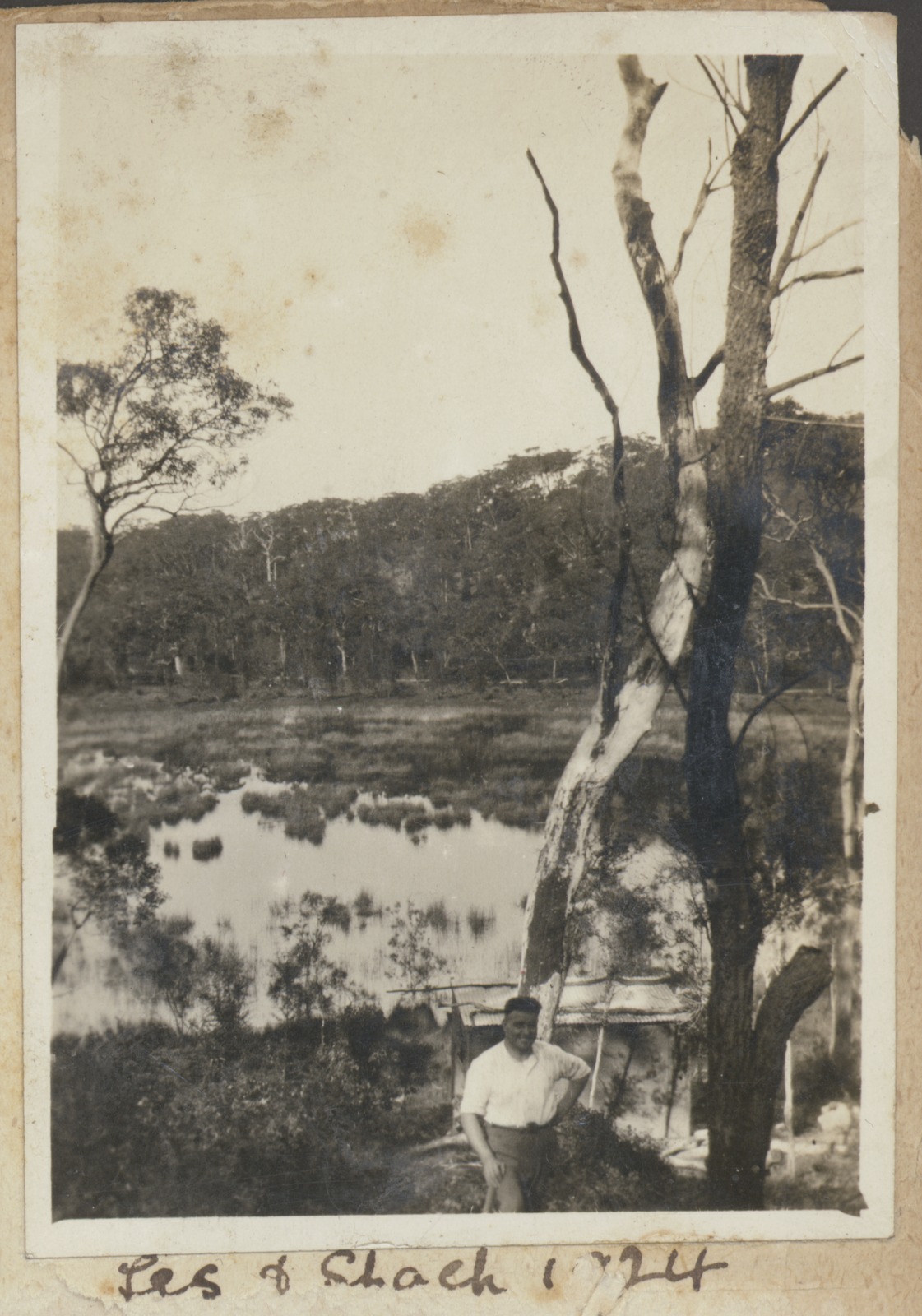
Collection of photographs relating to the Whetton family and name as being in the vicinity of 'Narrabeen'. dated 1924, Items FL15564591 and FL15564563 courtesy the State Library of Victoria.
He is 5 feet 6 inches with fair hair and blue eyes. His NOK is listed as his Reginald Norman Whetton(1889-1972) and Joyce Irene Whetton (Sister) of Samuel Street, Mona Vale. His mother is listed in NSW BDM's as Hilda I. They only had the two children.
ENGERT.-September 10, 1945, at Marrickville, Josephine, dearly beloved wife of Ebenezer Engert and dear mother of Hilda (Mrs. Whetton, deceased), Edna (Mrs. Delaney), and Ernest, grandmother of Grahame Engert, Norman and Joyce Whetton, and dear sister of Arthur Ashdown, aged 72 years. At rest. Family Notices (1945, September 12). The Sydney Morning Herald (NSW : 1842 - 1954), p. 20. Retrieved from http://nla.gov.au/nla.news-article17953009
Norman was given a rank of Warrant Officer on enlistment and served 3 years as a Fitter, with a rank of Sergeant, for the RAAF before trying out for a Pilot in the same on March 31st 1943. He was one of those who wanted to fly, and may have even heard these beauties fly overhead in 1938:

ABOVE: BOMBERS IN FORMATlON OVER MONA VALE ON THE FLIGHT FROM BRISBANE. R.A.F— (1938, November 23). Sydney Mail (NSW : 1912 - 1938), p. 26. Retrieved from http://nla.gov.au/nla.news-article166525725
Both these images are listed in the National Archives of Australia as being of him -:

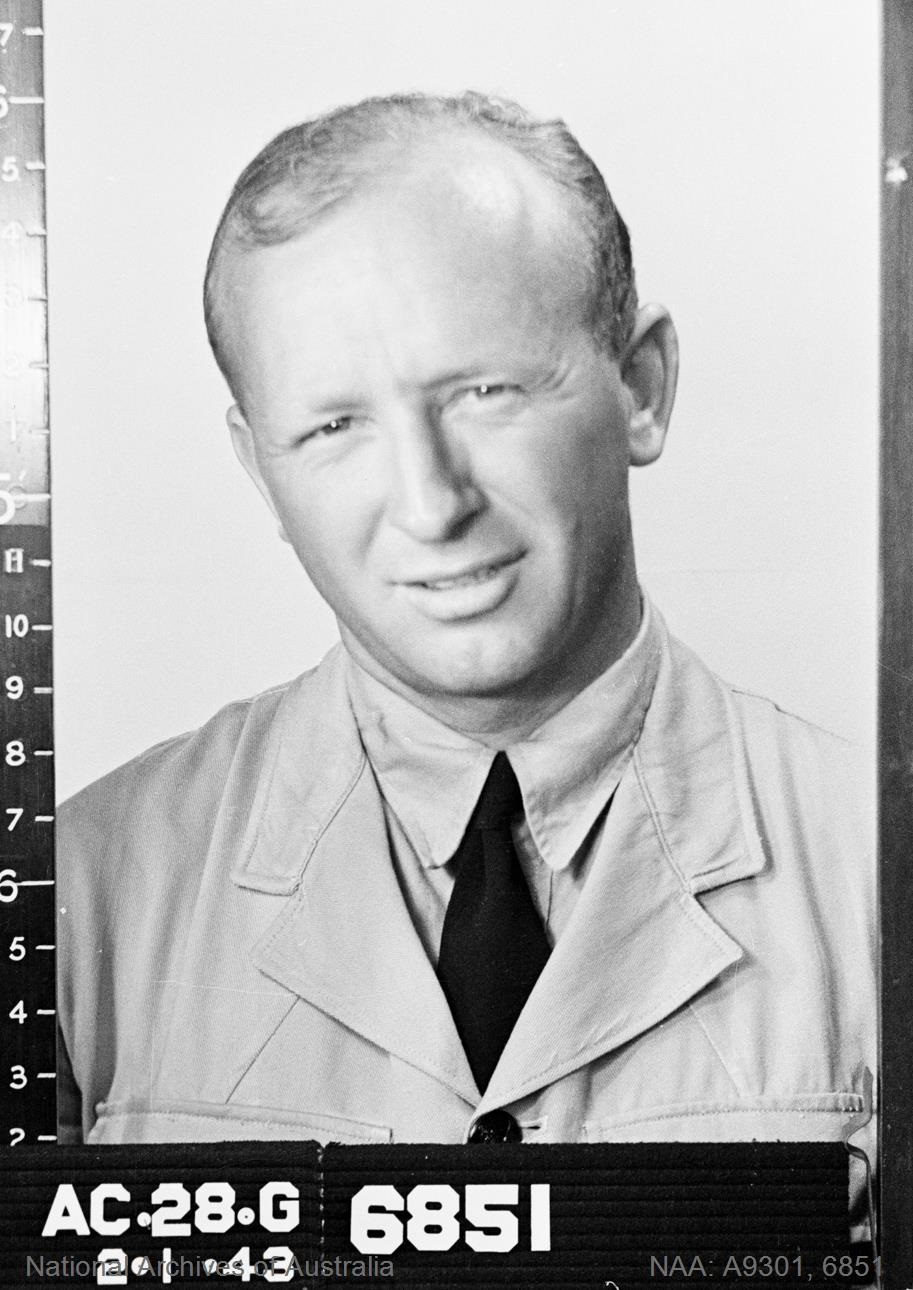

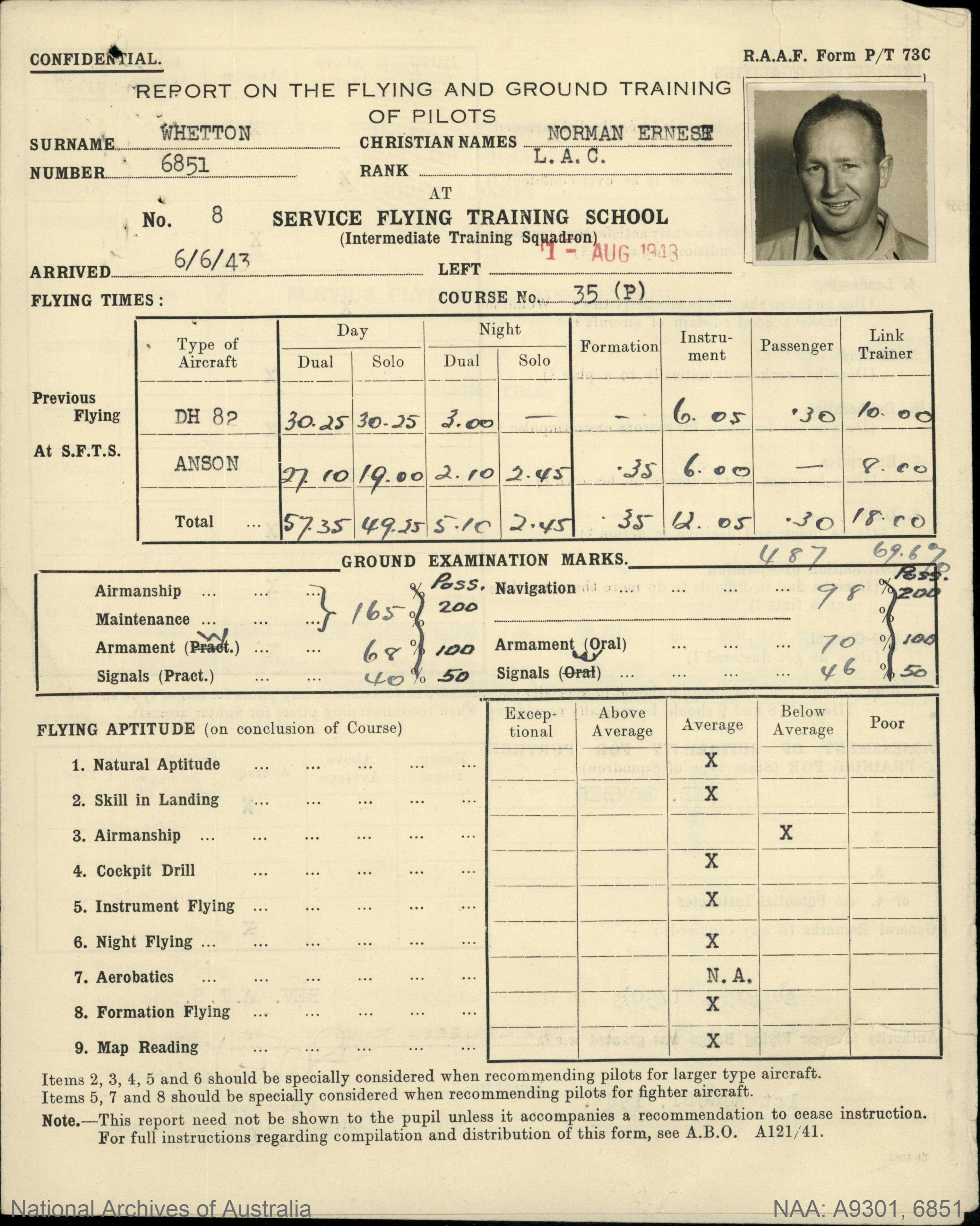
Norman flew Ansons and The Proctor, a single-engined, low-wing monoplane. The Proctor was a military trainer development of the successful British pre-war Percival Gull touring aircraft series designed by Australian Edgar Percival.
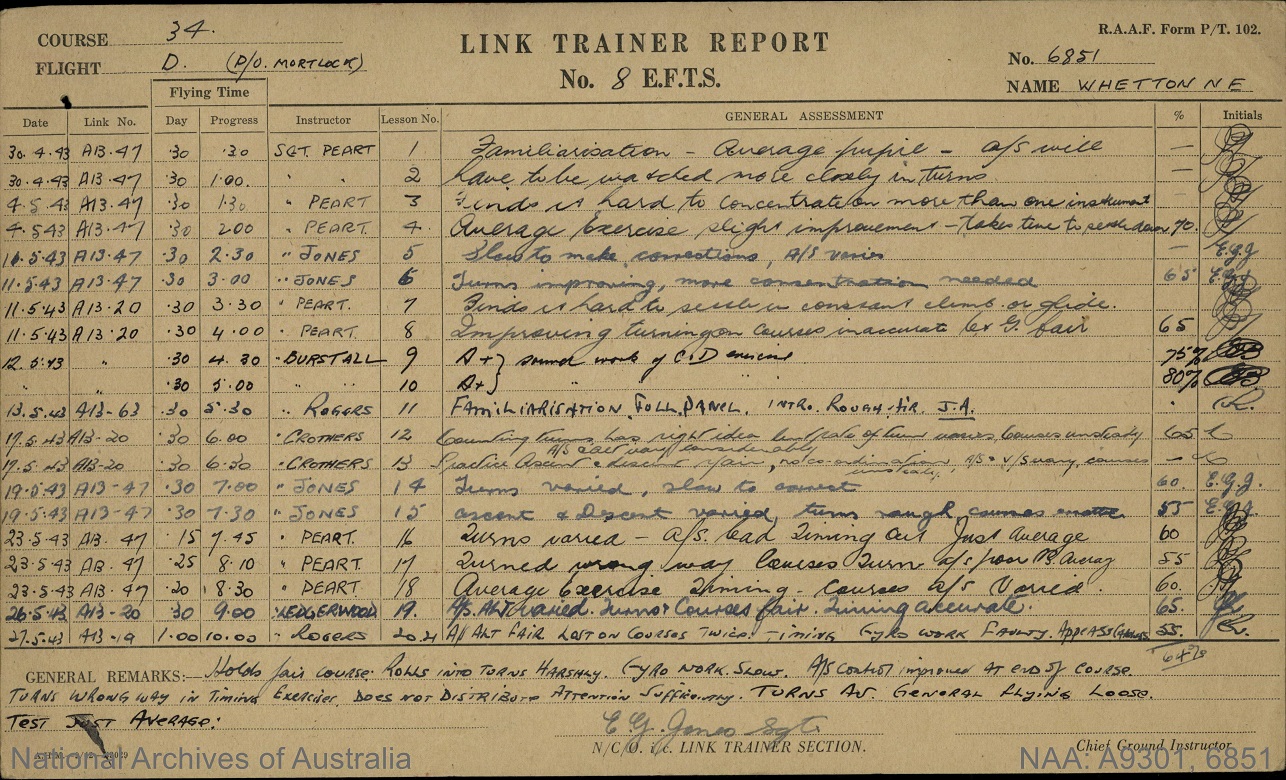
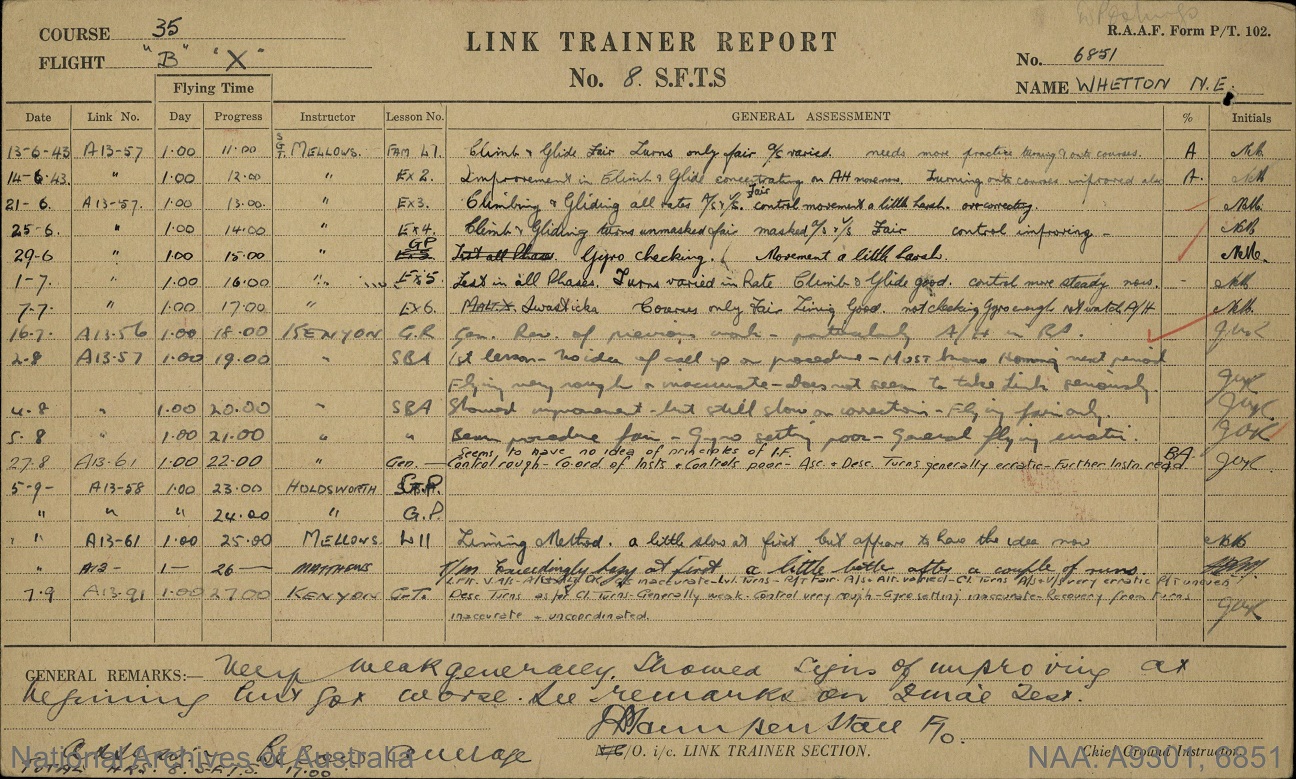
He served in England on attaining his plots licence. He was discharged on January 16th 1946 and had 102 days leave up his sleeve. On discharge he was ranked an Aircraftman Class II and Flight Sergeant. Service Number 6851.
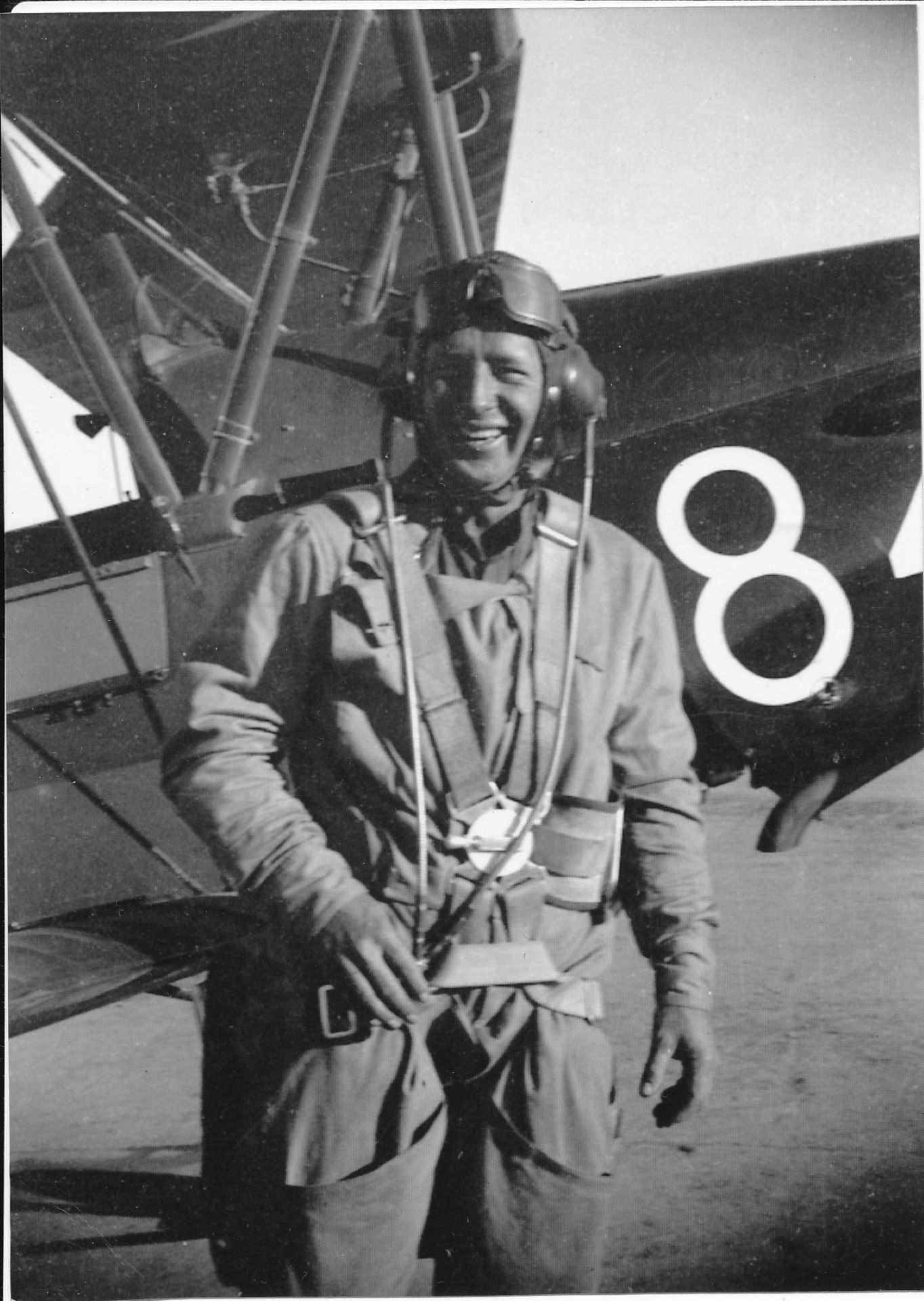
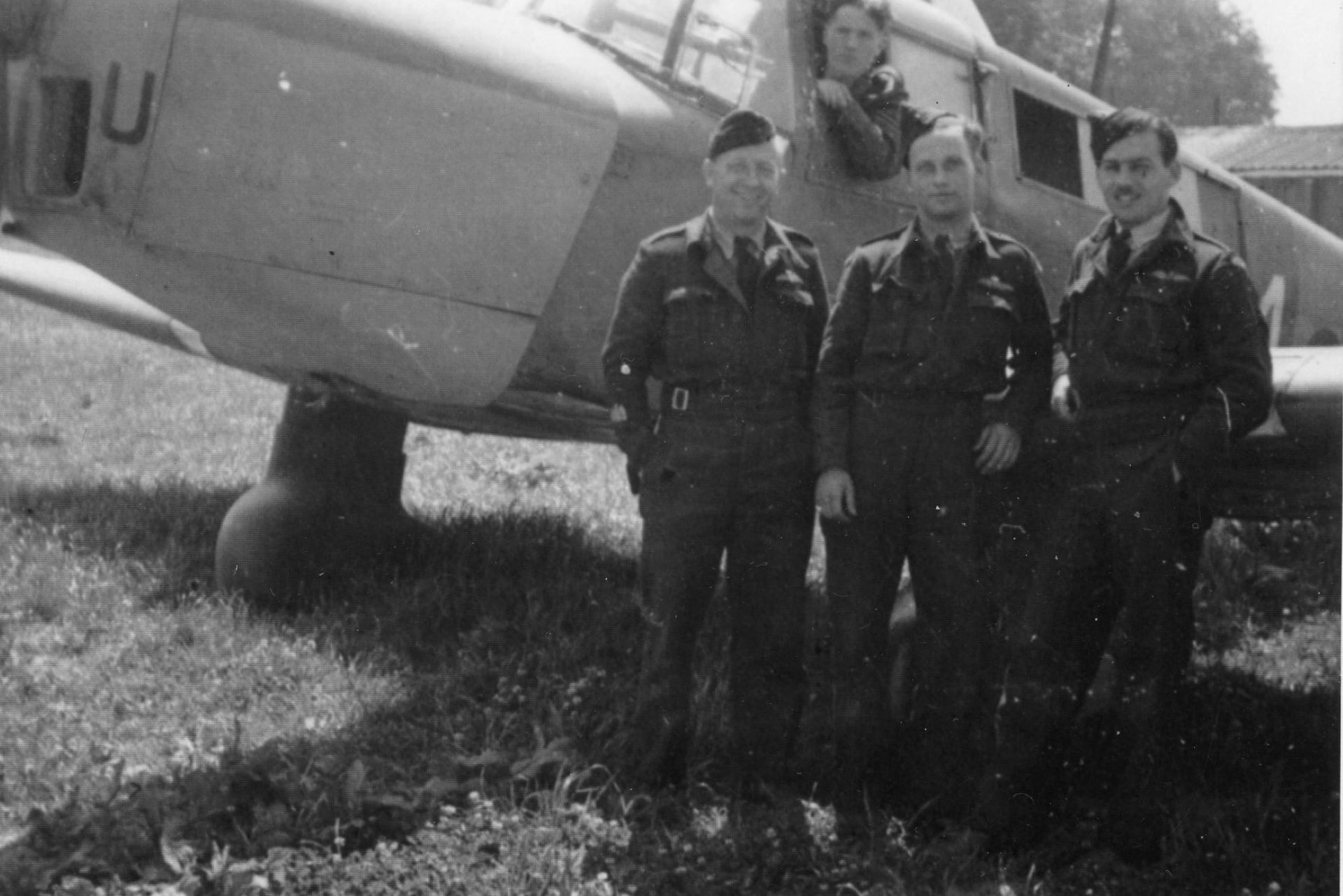
Photos; 2 shows 6 April 1945. It shows 4RS Madley Tiny Kerr, Norm Whetton, Colin Kemp and Tom Thompson.
.jpg?timestamp=1731239026230)
Image 3 is dated 6 May 1944 in St Pauls, London. It shows Gary Simpson, Alan Ainsworth, Bill Sullivan, John Salthouse and Norm Whetton. Photos courtesy of his sister.
He returned to Narrabeen -
WILCOX, A
Albert William Wilcox, born 17th of June 1918 22 years of age Waterview Street, Mona Vale, father; William James Wilcox, Occupation: Motor Driver. Attested at Manly on August 13th 1940, marched into camp September 9th 1940.

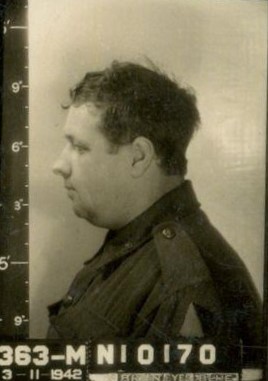
17.3.1941; Transferred to 7th Fd regiment in Ingleburn, ex Headquarters R.A.A. 1 Div. at Wallgrove on 1.10.1941. marched in for training on 29.1.1942 E/C (Eastern Command ?). admitted CDS Tfd 113 AFG Hospital (Varicose Veins) on 16.2.1942. on 13.4.1942 ceased duty as Spec. GR 11. On 18.6.1942 was admitted to 3CCS (Sub Maxillary). On 29.7.1942 discharged from CCS (Mumps). Rejoined 7th Fd. Regiment on 27.7.1942 (Dubbo) ex-CCS, and had been transferred at same time from there to 1st Australian I.T. Battalion on 7.7.1942. On 8.8.1942 was transferred to 18 Lab. Coy – by 13.10.1942 unit now is emplmt Coy (NSW LofC area. On 19.7.1943 as part of the 18th Aust. Emp (Works). Coy he was the subject of a Court of Inquiry held 14.7.1943 declared he absented himself without leave from 21.6.1943 and that he is still so absent. Deficiencies £7/15/10 and transferred to X List. On 16.8.1943 a ‘C’ Warrant for arrest is issued (58579) charge of desertion.
On the 23.1.1945 he was apprehended and held in custody at 6th Aust. Guard Compound. On 12.2.1945 his records state; District Court Martial held at Sydney 27.1.1945, charge: Desertion – absent 2359hours 21.6.1943 to 1300hours 23.1.1945. Finding: guilty of the charge, except that arrest took place at Mona Vale, not Moss Vale, as stated in the charge. Sentenced to undergo detention for one year. Confirmation: confirmed by Col. L. E. Nail on 5.2.1945. date of Promulgation: 5.2.1945. period in confinement awaiting trial: 3 days. Automatic forfeiture: 582 days pay. Total forfeiture: 950 days pay. On 7.2.1945 admitted to 6th Australian Detention Barracks (6 A.D.B)to serve sentence and transferred to General Reinforcements. On 14.3.1945 marched out to 2 AGC. On 27.3.1945 marched out from 2AGC to RR and GDD. Discharged on 19.5.1945 ‘there being no suitable vacancy in which his service could be employed. On 5.3.1945: Sentence Suspended by Col. Nail (General List) by date of release from custody. Total forfeiture: 950 days pay – period of sentence suspended; 306 days – net forfeiture: 644 days pay. Discharge takes effect from 21.5.1945
WILCOX, E
Edward Thomas Wilcox (1917-2000)
WILCOX EDWARD THOMAS : Service Number - NX69739 : Date of birth - 22 Oct 1917 : Place of birth - MONA VALE NSW : Place of enlistment - PADDINGTON NSW : Next of Kin - WILCOX JAMES
WOUNDED IN ACTION.
WILCOX, Pte. E. T., Inf., Mona Vale. ARMY LOSSES (1942, September 30). The Sydney Morning Herald (NSW : 1842 - 1954), p. 9. Retrieved from http://nla.gov.au/nla.news-article17804215
WILCOX, F A
Frederick Allen Wilcox, of Basett Street Mona Vale, born February 20th, 1924, is 18 and a Labourer when he enlists on March 4th 1942 at Manly, listing his sister Ethel Lewis of Basset street as his NOK and again enlisting on August 6th 1942.
He had previously served in the AMF as a gunner N233613 NFDC. He is 5 feet 8 inches with brown hair and eyes and a medium complexion. His brother Edward Thomas, serving in the A I F, is listed as next of kin in his second enlistment paper. He is assigned to the 26th Australian Infantry Battalion NX166193 from 9.4.1942 to 19.2.1943 and then the A J F from 20.2.1943 to 27.6.1946 serving 1251 days in Australia and 152 days overseas.
He is discharged on June 26 1946, aged 22 and 4 months. He serves at 2 HRV TRg Battery and then at North Head from 13.4.1942 before being sent to Newcastle.
He goes AWOL in September 1942 and April 1943 – he is only absent half a day he first time and admonished - the second time he is absent 2 days and loses 7 days pay. He does it again in June 1943, for a day, and is fined £1.
He is transferred to the AIF on the 19.4.1943 and allotted Army No: NX166793.
In July 1943 he has tonsillitis 16.7.1943 and returns to duty on 22.7.1943. in October he goes AWOL again 12.10.1943 and on 27.10.1943 ‘breaks out of barracks 1400 hours to 2300 hours’ and gets fined £5. On December 12th 1943 he is marched in (14th Aust. Detention Barracks) to serve 28 days.
On January 11th he rejoined his Unit at Newcastle. He continues going AWOL into 1944 as well. By June 22nd 1945, when he is being discharged, he has forfeited 80 days pay with 12 days remission.
On January 12th 1945 he is sent to Brisbane and embarked there on the ‘Duntroon’ for Rabaul. On the 24th of April 1946 he is transferred into the 26th Inft. Battalion, and still in Rabaul.
By June 9th 1946 he is being sent to the Eastern Command for discharge.
WILCOX, J
James Henry Wilcox Service Number - NX163364 : Date of birth - 07 Nov 1919 : Place of birth - MONA VALE NSW : Place of enlistment - IN THE FIELD : Next of Kin - WILCOX EDWARD
Wilcox Family of Mona Vale: a few Notes on their generations
Brave Deeds that have won Recognition.
John William Holding, Ernest William Oliver, and Charles Henry Wilcox. We take the following from *' Sydney -, Mail'' of August 18 : —
On July 29, 1908, a message was sent to the Mona Vale police station that a boat with two men in it was in a helpless condition off Fille Reef, near Barranjoey, N.S.W. Mr. Holding, on hearing of the occurrence, with great promptitude put off in' a small boat to the rescue, accompanied by Messrs Oliver and Wilcox, although the constable on duty endeavoured to dissuade him from doing so on account of the heavy sea running. The three men, however, pulled through the breakers, but on reaching the scene found the object was only old wharfage with two posts standing at the end, and with great difficulty succeeded in getting the boat back cross the bar. Heroes of the Year. (1909, September 11). Windsor and Richmond Gazette (NSW : 1888 - 1965), p. 11. Retrieved from http://nla.gov.au/nla.news-article85867466
WILCOX. - February 10. 1932. at her residence The Crescent, Mona Vale. Pittwater. Edith Ethel May, beloved wife of Charles Henry Wilcox, aged 41 years. Family Notices (1932, February 11). The Sydney Morning Herald (NSW : 1842 - 1954), p. 8. Retrieved from http://nla.gov.au/nla.news-article16840085
WILCOX. - The Relatives and Friends of CHARLES HENRY WILCOX and FAMILY of The Crescent, Mona Vale, Pittwater, are kindly invited to attend the Funeral of his late beloved WIFE and their MOTHER, Edith Ethel May Wilcox, to leave her late residence, The Crescent Mona Vale, THIS AFTERNOON (Thursday), at 2.30 o'clock for the Gordon-road Cemetery Mona Vale T WAUGH and CO , Funeral Directors Tele, YU1118 Manly. Family Notices (1932, February 11). The Sydney Morning Herald (NSW : 1842 - 1954), p. 7. Retrieved from http://nla.gov.au/nla.news-article16839965
Edith Ethel May Wilcox, late of Mona Vale, New South Wales, married woman, died 10th February, 1932, intestate; administration was granted to the Public Trustee on the 17th January, 1934.
Dated this 18th day of January, 1934.
W. J. KESSELL, Public Trustee.
St. James Buildings, 107-109 Elizabeth-street, Sydney. £4 14s. PROBATE JURISDICTION. (1934, January 19). Government Gazette of the State of New South Wales (Sydney, NSW : 1901 - 2001), p. 287. Retrieved from http://nla.gov.au/nla.news-article223049885
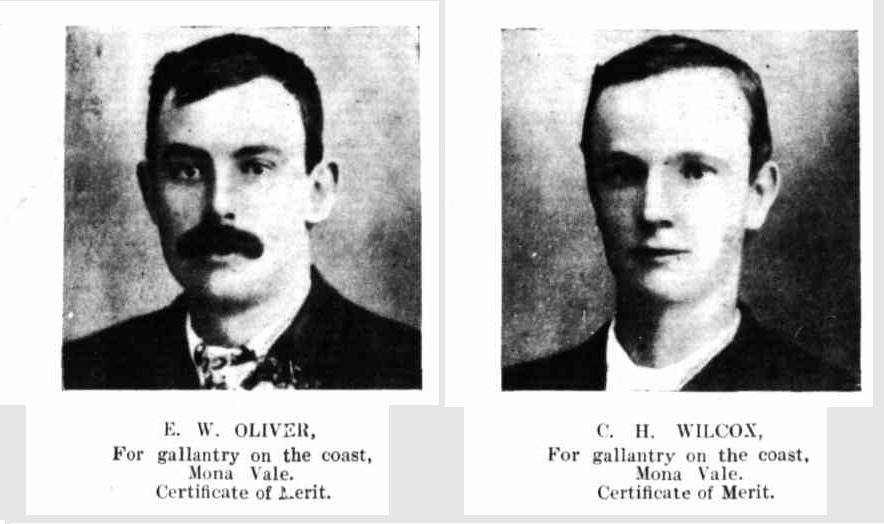
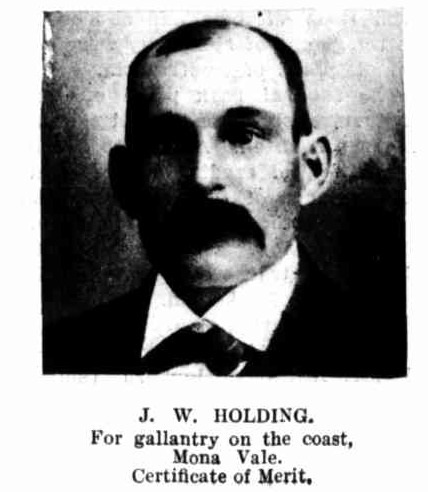
Parents marriage:
2012/1913 WILCOX CHARLES H OLIVER EDITH E M MANLY
Edith’s birth:
OLIVER EDITH E M 20929/1890 THOMAS A MARTHA MANLY
Her Parent’s marriage:
1411/1871 OLIVER THOMAS ALBERT SHAW MARTHA ST LEONARDS
Her father’s and mother’s death:
OLIVER THOMAS A 3716/1918 WILLIAM MARY MANLY
OLIVER MARTHA 17005/1932 JOSEPH SUSAN CHATSWOOD
OLIVER.-February 7, at his residence, Mona vale, near Bay View, Thomas, dearly-loved husband of Martha Oliver, aged 75 years. Funeral will leave Mona Vale this day, Saturday, at 1 p.m., for the Church Point Cemetery. Family Notices (1918, February 9). The Sydney Morning Herald (NSW : 1842 - 1954), p. 12. Retrieved from http://nla.gov.au/nla.news-article15771821
OLIVER-December 23 1932 at her residence Warinoo-road St Ives, Martha widow of the late Thomas Oliver late of Mona Vale aged 80 years. Family Notices (1932, December 24). The Sydney Morning Herald (NSW : 1842 - 1954), p. 8. Retrieved from http://nla.gov.au/nla.news-article16940553
OLIVER. — The Relatives and Friends of the late Mrs. MARTHA OLIVER, late of Mona Vale, arc kindly invited to attend her funeral, to leave her late residence, Warinoo Road, St. Ives. THIS AFTERNOON, at 3.30 o'clock, for Methodist Cemetery, Mona Vale. WOOD COFFILL LIMITED, Motor Funeral Directors. Family Notices (1932, December 24). The Sydney Morning Herald (NSW : 1842 - 1954), p. 7. Retrieved from http://nla.gov.au/nla.news-article16940561
Children of Charles and Edith:
WILCOX EDITH E 12708/1914 CHARLES H EDITH E MANLY
WILCOX ELSIE D 40305/1921 CHARLES H EDITH E M MANLY
WILCOX EDWARD T 50590/1917 CHARLES H EDITH E MANLY
WILCOX JAMES H 46234/1919 CHARLES H EDITH E MANLY
Kitchener Butcher shop – Arthur Clyde Giles; Married Lillian Wilcox in 1921 – registered at Granville
2220/1921 GILES ARTHUR C WILCOX LILLIAN M at GRANVILLE
Lillian is the daughter of Edward and Mary Ann, nee Sutton
Birth: WILCOX LILLIAN M 21704/1893 EDWARD MARY A I registered at: MANLY
One of many siblings of Edward an Mary who moved to Mona Vale in 1884-85:
WILCOX ELIZA ELIZABETH 1378/1876 EDWARD MARY ANN SYDNEY
WILCOX PRUDENCE RACHEL 8195/1880 EDWARD MARY ANN ST LEONARDS
WILCOX EMMA LOUISA 32316/1883 EDWARD MARY ANN MURRUMBURRAH
WILCOX CHARLES H 11697/1885 EDWARD MARY A ST LEONARDS
WILCOX VIOLET M 24550/1886 EDWARD A MARY A WOONONA
WILCOX MARY M 12710/1887 EDWARD MARY A ST LEONARDS
WILCOX WILLIAM J 20889/1890 EDWARD MARY A MANLY
WILCOX LILLIAN M 21704/1893 EDWARD MARY A I MANLY
WILCOX THOMAS E 24038/1895 EDWARD MARY A MANLY
WILCOX DORA E 23278/1897 EDWARD MARY A MANLY
Marriage of Edward and Mary: 602/1875 WILCOX EDWARD SUTTON MARY ANN SYDNEY
His birth: WILCOX EDWARD 2351/1854 V18542351 40 JAMES ELIZA MF
MF: Church of England, Sydney, St Lawrence's
WILCOX. - November 12. 1921, at his residence. Bassett-street, Mona Vale, Pittwater, Edward Wilcox, aged 71 years. Family Notices (1921, November 14). The Sydney Morning Herald (NSW : 1842 - 1954), p. 8. Retrieved from http://nla.gov.au/nla.news-article15963821
Edwards Parents: WILCOX EDWARD 19531/1921 father JAMES mother; ELIZA MANLY
Wife’s death record in NSW BDM's and parents: WILCOX MARY A 4537/1914 father; THOMAS W mother; PRUDENCE R MANLY
WILCOX.—The Relatives and Friends of the late EDWARD WILCOX are kindly invited to attend his Funeral; to leave his late residence, Bassett-street Mona Vale, Pittwater, TO-DAY, MONDAY, at 3.30p.m., for the Gordon-road Cemetery, Mona Vale. T WAUGH and CO, Tel , 42 Manly Funeral Directors. Family Notices (1921, November 14). The Sydney Morning Herald (NSW : 1842 - 1954), p. 7. Retrieved from http://nla.gov.au/nla.news-article15963790
Council's History unit holds the following photo from the family records; Edith Wilcox nee Oliver holding Ted Wilcox third from right back row. Ethel Wilcox third from left front row. Photo; Wilcox family – held in Northern Beaches Council Library Local Studies.
Newport Provisional school; The land this school was on was owned by David Scott and opened in May 1888. The teacher in the photograph is Elizabeth (Lizzie) Giles.
Standing second left is Emma Wilcox and Charles Wilcox is standing second right. For more information about this school and photo see Mona Vale Stories by Guy Jennings, page 55.
Sketch: School was established at Newport in April, 1888. The school was conducted in a tent under the direction of Miss Elizabeth Giles, who was 23 years old with 19 pupils. Miss Giles was there 1888-1894. Sydney Mail, Saturday June 21st, 1890.
In full in Pittwater Online News history page for Newport School anniversary celebrations: The Newport School 1888 to 2016 - extras added into The Newport School: 1888 to 2018
Also more in: Mona Vale Public School 1906 to 2012
WILCOX.-June 25, 1941, at Manly, William James Wilcox, of Bellevue Parade, Mona Vale, beloved husband of Annie and loved father of May, Iris, Albert, Evelyn, Ronald, Vera, Betty, and Donald, aged 51 years. Family Notices (1941, June 27). The Sydney Morning Herald (NSW : 1842 - 1954), p. 8. Retrieved from http://nla.gov.au/nla.news-article17751438
WILCOX - the Funeral of the late WILLIAM JAMES WILCOX. of Bellevue Parade. Mona Vale. will take place in the Mona Vale Cemetery THIS (Friday) AFTERNOON at 2.10 o'clock. T. WAUGH and CO Funeral Directors Manly. Tele XU 1118 Family Notices (1941, June 27). The Sydney Morning Herald (NSW : 1842 - 1954), p. 7. Retrieved from http://nla.gov.au/nla.news-article17751434
Bertha Wilcox
Birth 27 December 1924 - Mona Vale, New South Wales, Australia
Death 7 July 2012 - Mona Vale, hospital, Mona Vale, New South Wales, Australia
Mother Edith Ethel May Oliver
Father Charles Henry WILCOX
Husband Sydney Gordon Joyce
PON Researcher has more 'found notes' on this family. A dedicated page for/of Wilcox family will be made available. There is a lot these people were a part of in Pittwater over a few generations.
William, C
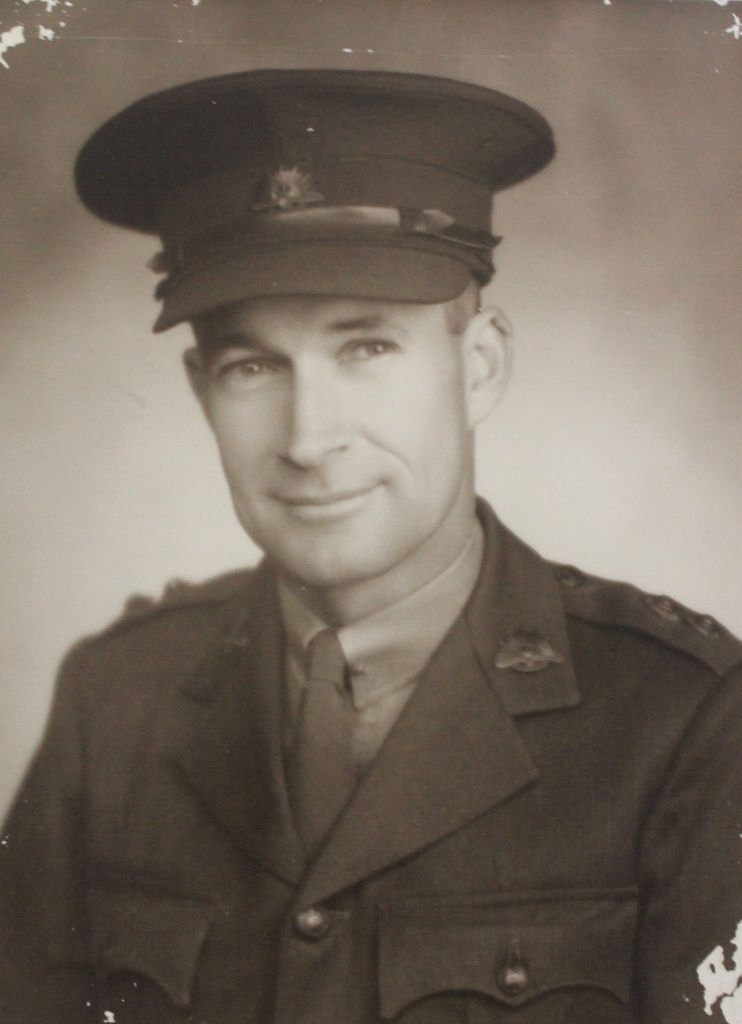
Cedric M Williams, photo courtesy the Williams family - WWII: National Archives of Australia Records - WILLIAMS CEDRIC MORETON : Service Number - N393326 : Date of birth - 19 Jan 1904 : Place of birth - SUMMER HILL NSW : Place of enlistment - PADDINGTON NSW : Next of Kin - WILLIAMS SOPHIE. Date range: 1939 - 1948
Cedric Moreton Williams had the novel idea of using tetrahedrons that had been installed as part of the defence works along our coasts, and in Pittwater, as moorings for the soon to be returned flotilla of local boats that had been moved up the Hawkesbury soon after the conflict commenced.
His son Cedric Vincent Williams explained during his Profile interview:
‘’ From Bayview Golf club to where the creek ran out was a no go area – it was all mud and mangroves. We wouldn’t go in there much – I had a canoe and would go along some of the creek but I was mostly on Pittwater.
Apart from having the net and gate to stop people at the Palm Beach end they put stops around the edges of Pittwater – these concrete pyramids. They were great heavy things they dropped in so nothing could go over them. They used to go all around the foreshores. Eventually they kept sinking down into the mud of course, and there is a lot of them still under the mud even now. They had great big steel loops on them.
My father would get them and make moorings out of them – they could never move, once they were put down they were there, permanently. The only way he could do it was get two dinghies together, wait for the tide to come in to lift it, tie the pyramid concrete onto it, then cut it – a couple of times the dinghy was sinking just as much as the pyramid!
That was one interesting part of local activities during the war.
Loquat Valley School, where that is, was just a thoroughfare which they blocked up. There was a little bit of wharves at the end of the track for the army there – so the Army was fairly prevalent in the area then – you were conscious of them being everywhere.
I also remember at the end of the war P G Taylor brought three Catalina planes down to Bayview. They were delivered to the boatshed and we put them on moorings there. The Navy took the engines and gave the rest to dad who took some of them for parts – the anchors were still great, as was the steel. Dad used them in boats.
PG Taylor put one together out of all three and it was placed in Catalina Park in the Blue Mountains – dad knew the manager of the Guest House up there at Katoomba.''
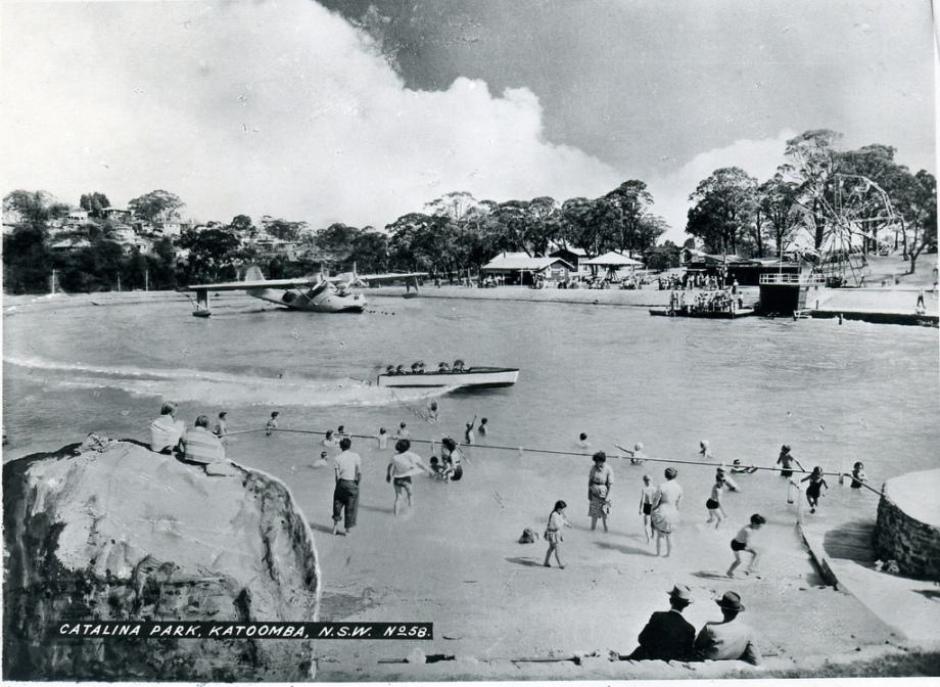
Catalina Park, Katoomba c.1950
Looking south east, showing the Catalina flying boat on the swimming lake, speed boat ride, fun fair, Ferris wheel, "monkey house" shelter constructed of cement over wire netting in the foreground. The land was purchased by Horace Gates owner of the Homesdale Guest House and Wentworth Cabaret who, in 1946, felt that a new attraction was needed to bring tourists back to the Blue Mountains after peace was declared. Accordingly he dammed Katoomba falls creek and had an ornamental lake and amusement park constructed offering ‘every facility for fun and food’.
The park was an instant success and in 1948 the shell of a Consolidated Catalina PBY-5 flying boat was added to the attractions which included speed boat rides, tea rooms, miniature train, Ferris wheel, merry-go-round, swimming pool and a Giggle House showing Charlie Chaplin films. Although many people believed the plane had flown there, it had in fact been dismantled and brought to Katoomba by truck, where it was re-assembled and anchored to a concrete block in the middle of the lake.
Up to thirty passengers paid two shillings each to be taken out to the flying boat by punt where, in the dark, stuffy interior, they viewed film of a flight over Sydney, heard the story of the Catalina and tried out the controls. While the film was showing, an assistant would stand on the wing rocking the plane to simulate flight while the speed boat would circle the lake providing waves and engine noise. Fun seekers emerged from this surround sound experience dizzy and gasping for air, many too ill to enjoy further amusements.
For many years the lake operated as Katoomba’s swimming pool and provided a fireworks display after the New Year’s Eve street parade, however as the town’s population increased, it gradually became run down and the water polluted.
Blue Mountains City Council purchased the land in 1952 with the purpose of turning the area into a public park and treated water swimming pool. In 1954 the Catalina, showing signs of age and wear, was pulled up onto the bank and left to the ravages of weather and souvenir hunters, until in 1958 it was sold to Sheffield Welding & Engineering, Auburn NSW, where it was dismantled and cut up for scrap. Courtesy Repository: Blue Mountains City Library www.bmcc.nsw.gov.au/library/ - Part of: Local Studies Collection
The war records provided by the National Archives of Australia show Boatbuilder Cedric M Williams was still enlisted and serving when he first mooted using these tetrahedrons as such. The Williams boatshed was then near the Bayview wharf - Cedric M served with the Volunteer Defence Corps (VDC)initially until good use was made of his knowledge of boats or 'small craft' as his records show. Additionally Elizabeth Hird (nee Williams, Cedric's sister and daughter of Cedric M) recalled her mother helped make camouflage nets for the army units stationed at Bayview:
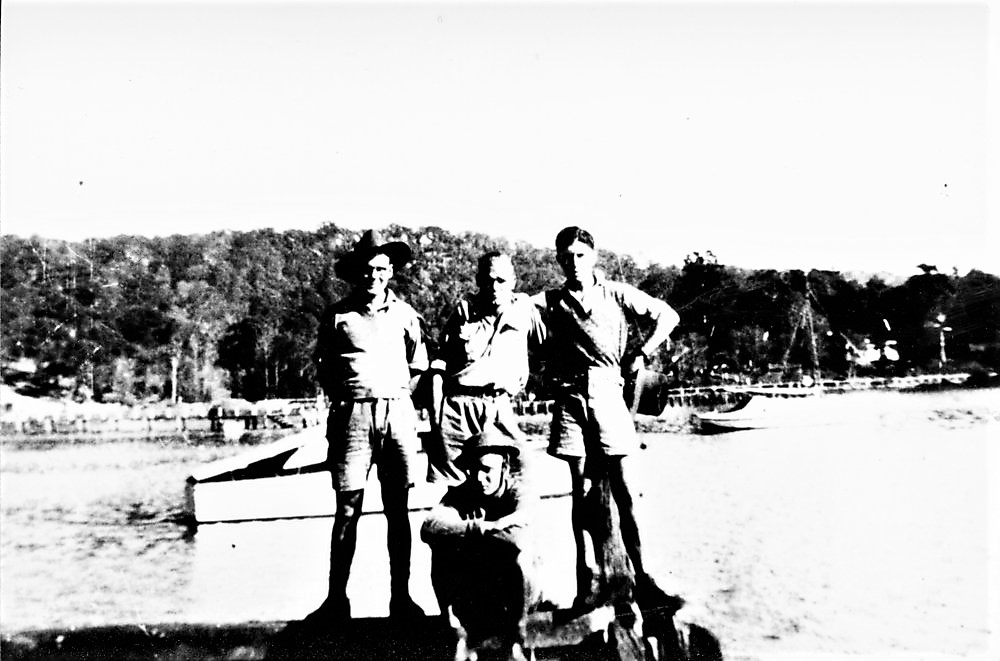
Soldiers at Bayview. 1942.
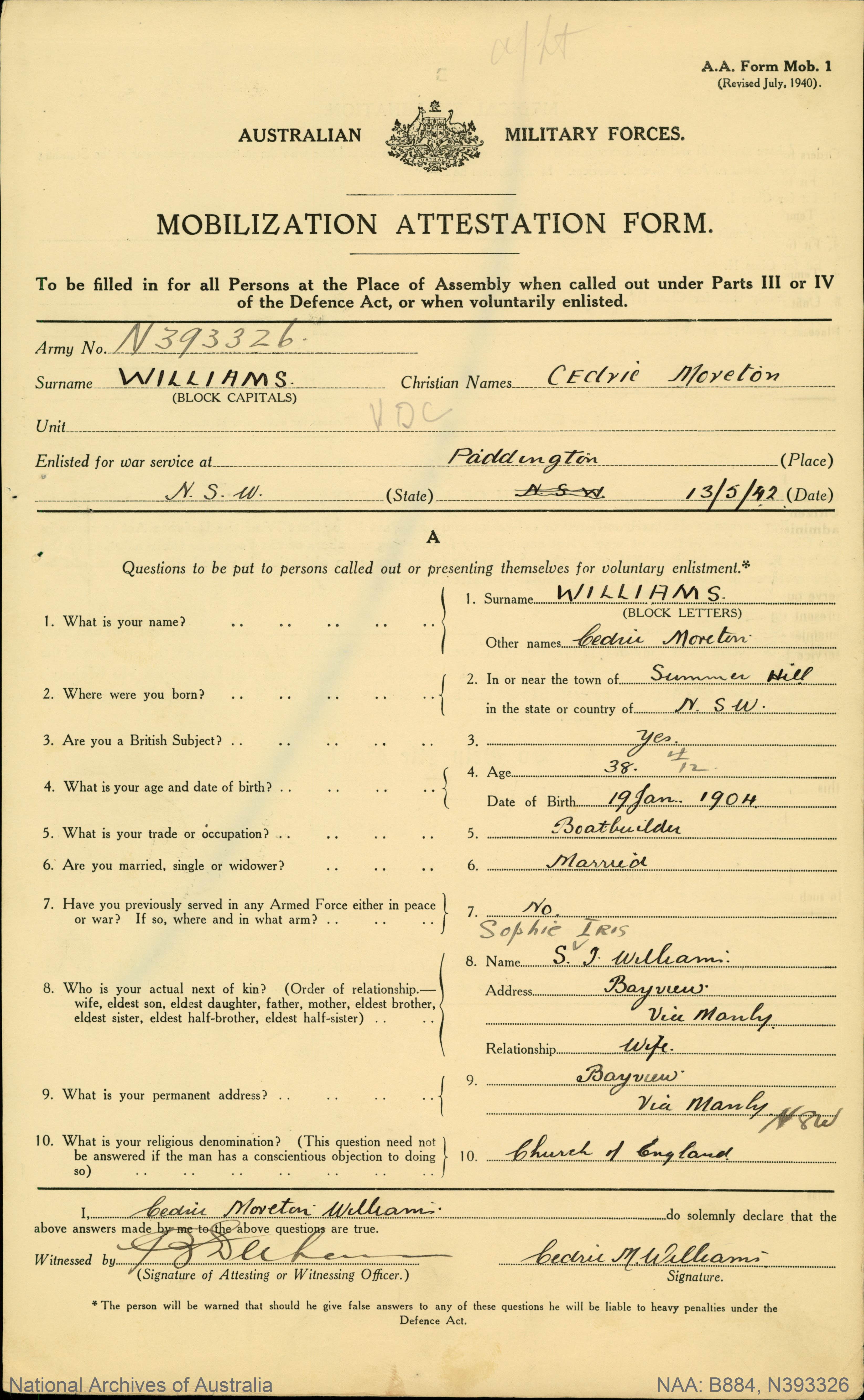
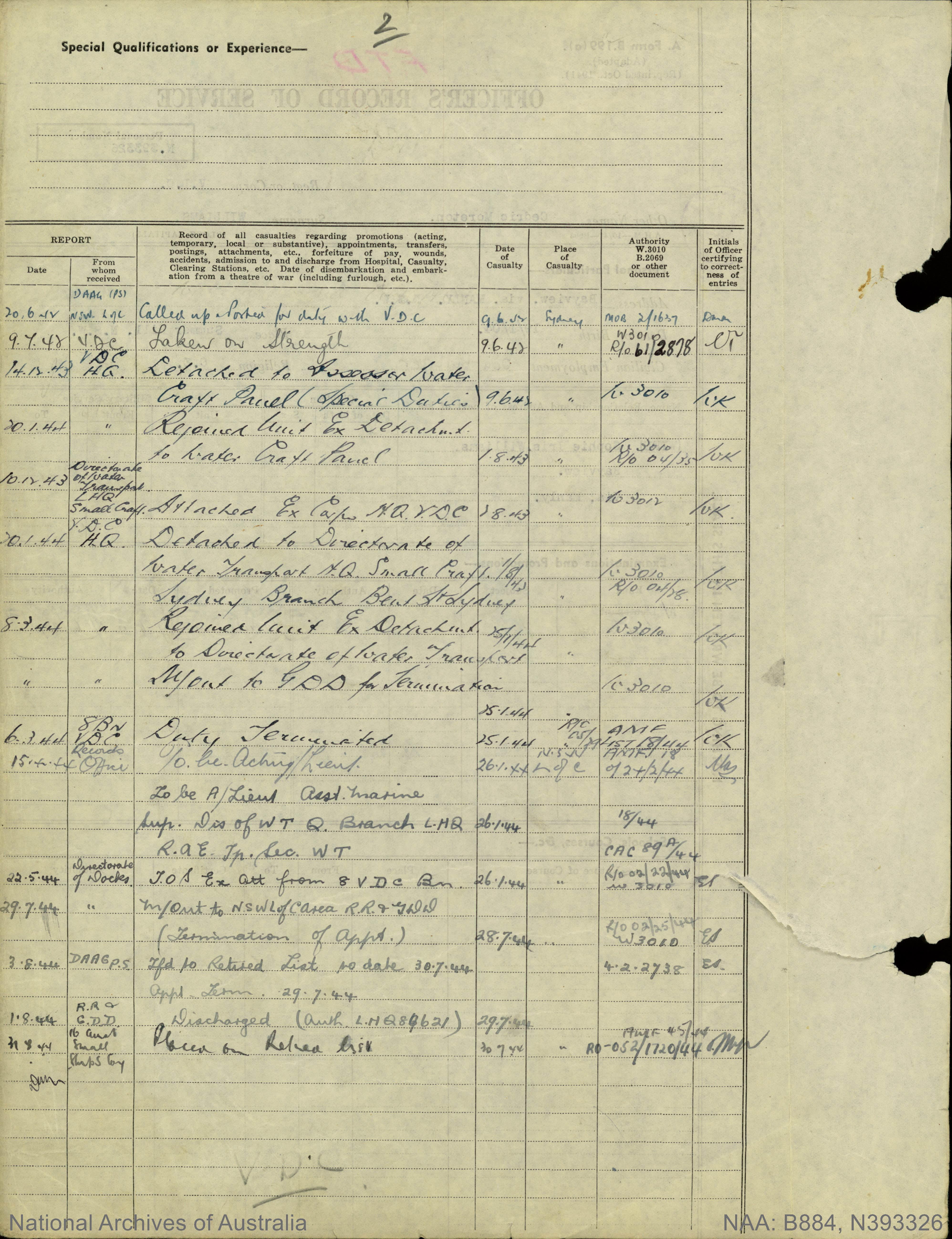
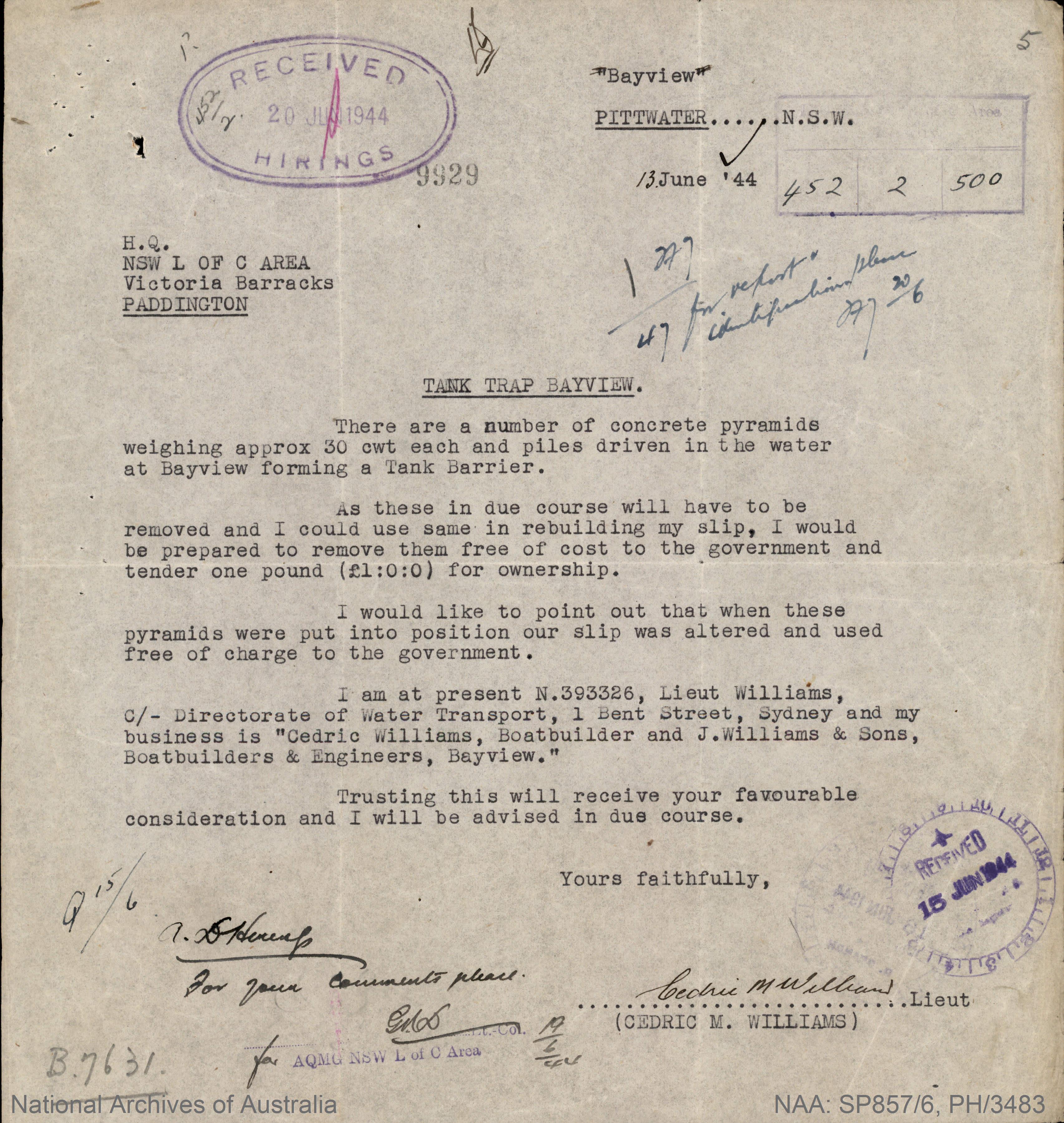
Cedric M Williams was given permission to remove these tetrahedrons once he was discharged. What is interesting about what else was found in this file is the permission given for people to purchase any excess equipment used then - Geoff Searl OAM of ABHS related that the first 'shed' for the Avalon Beach RSL was, to his knowledge, one of the old sheds from the Sun Down camp at Ruskin Rowe.
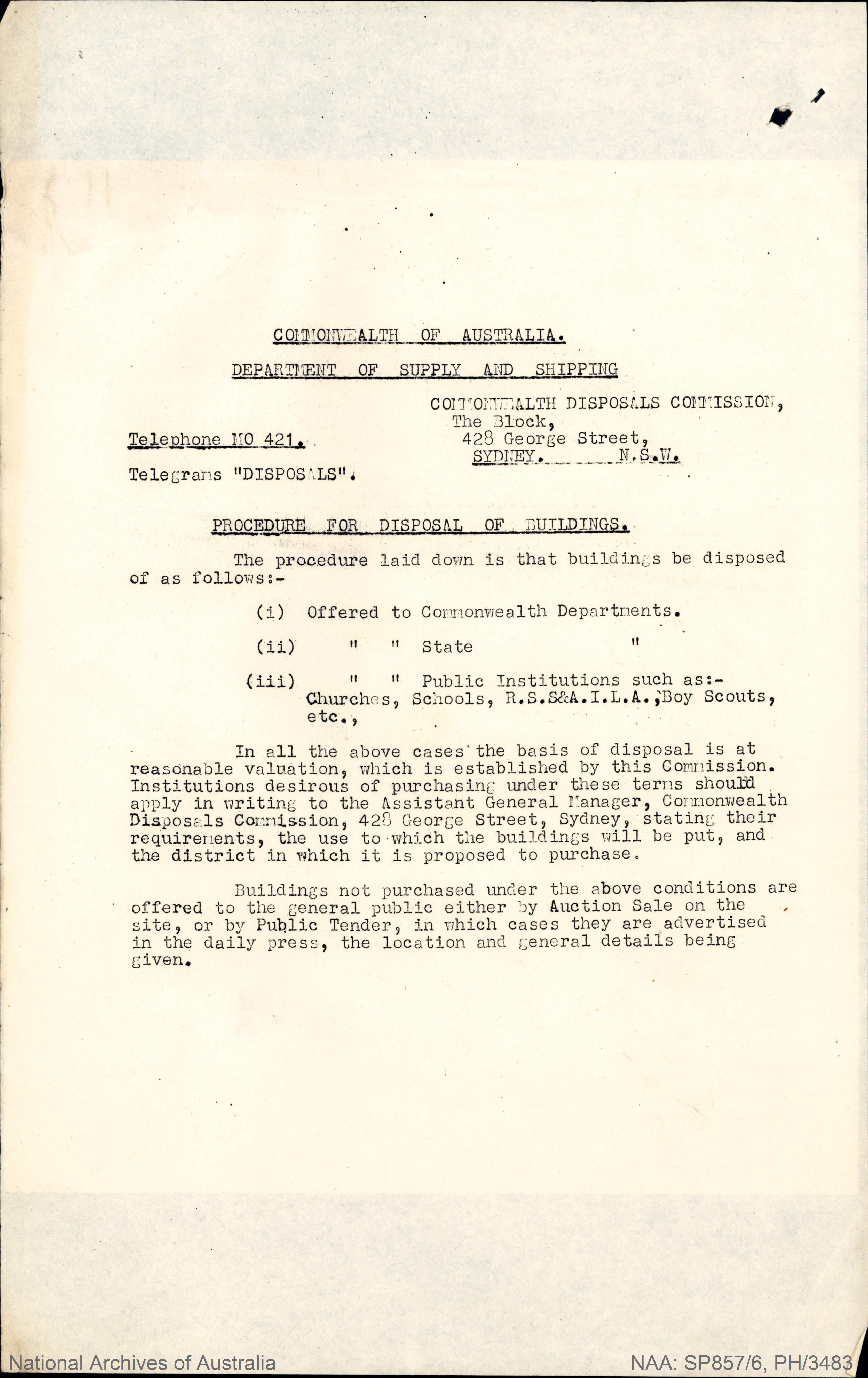
The National Archives of Australia file on Bayview Tank Traps show:
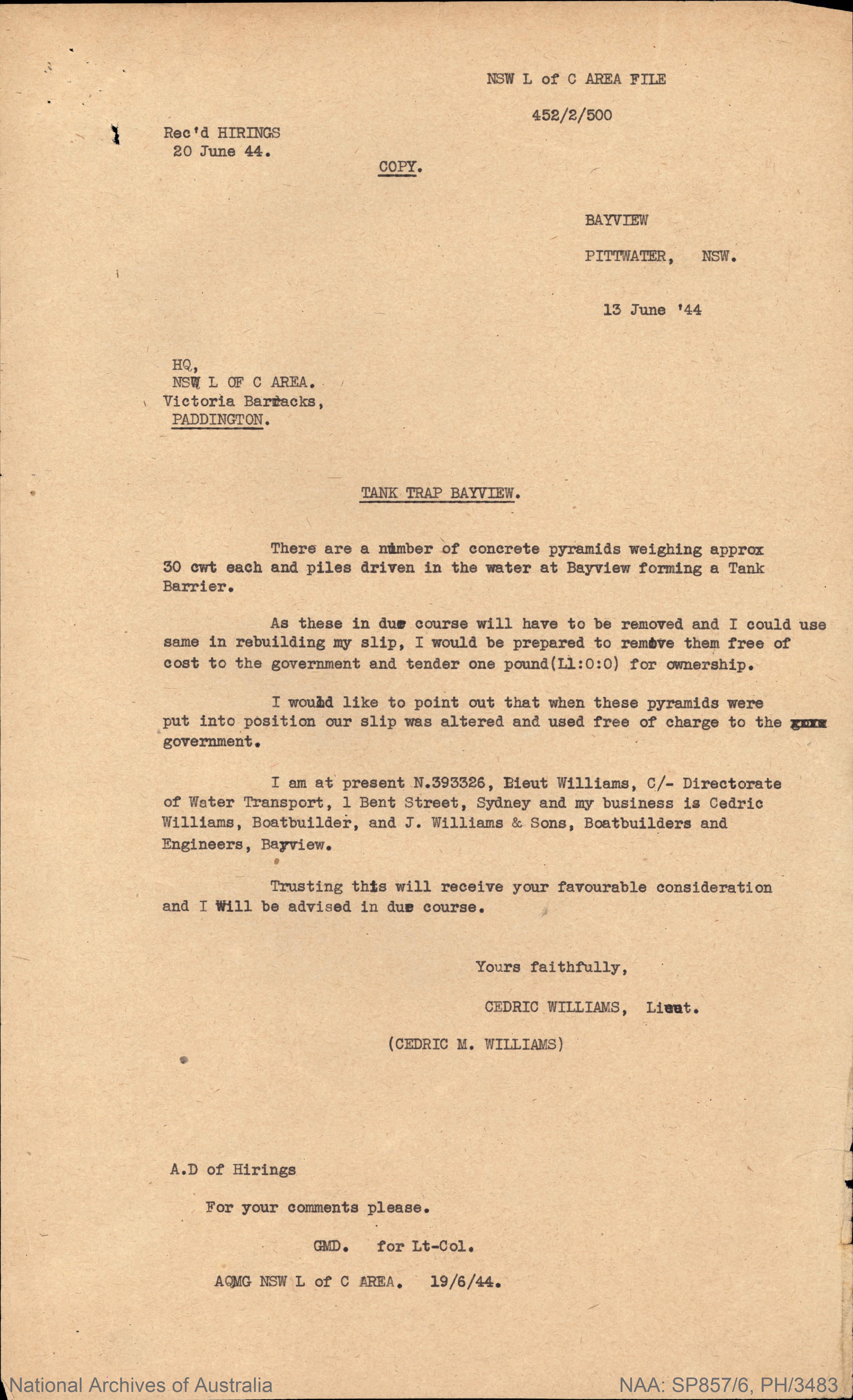
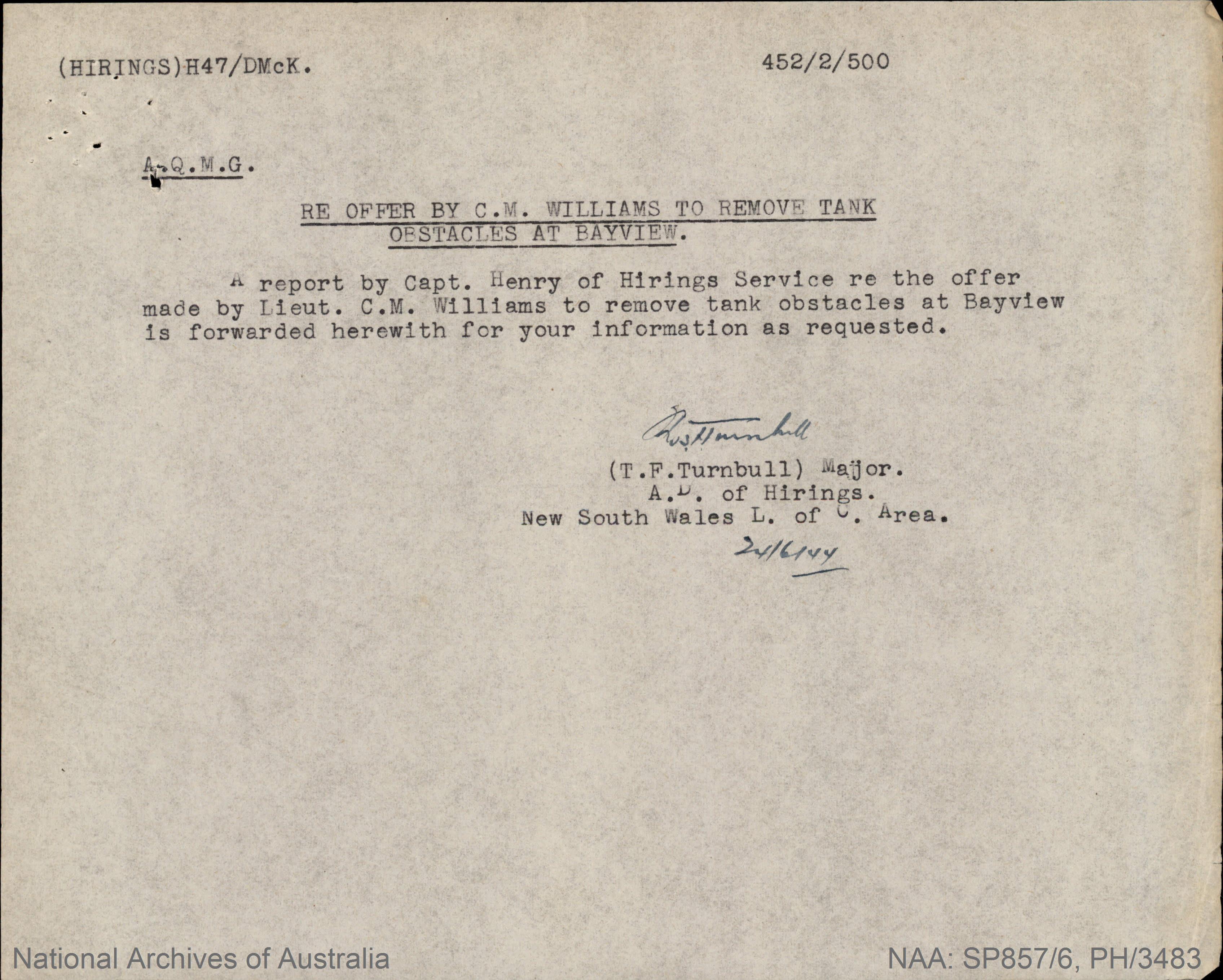
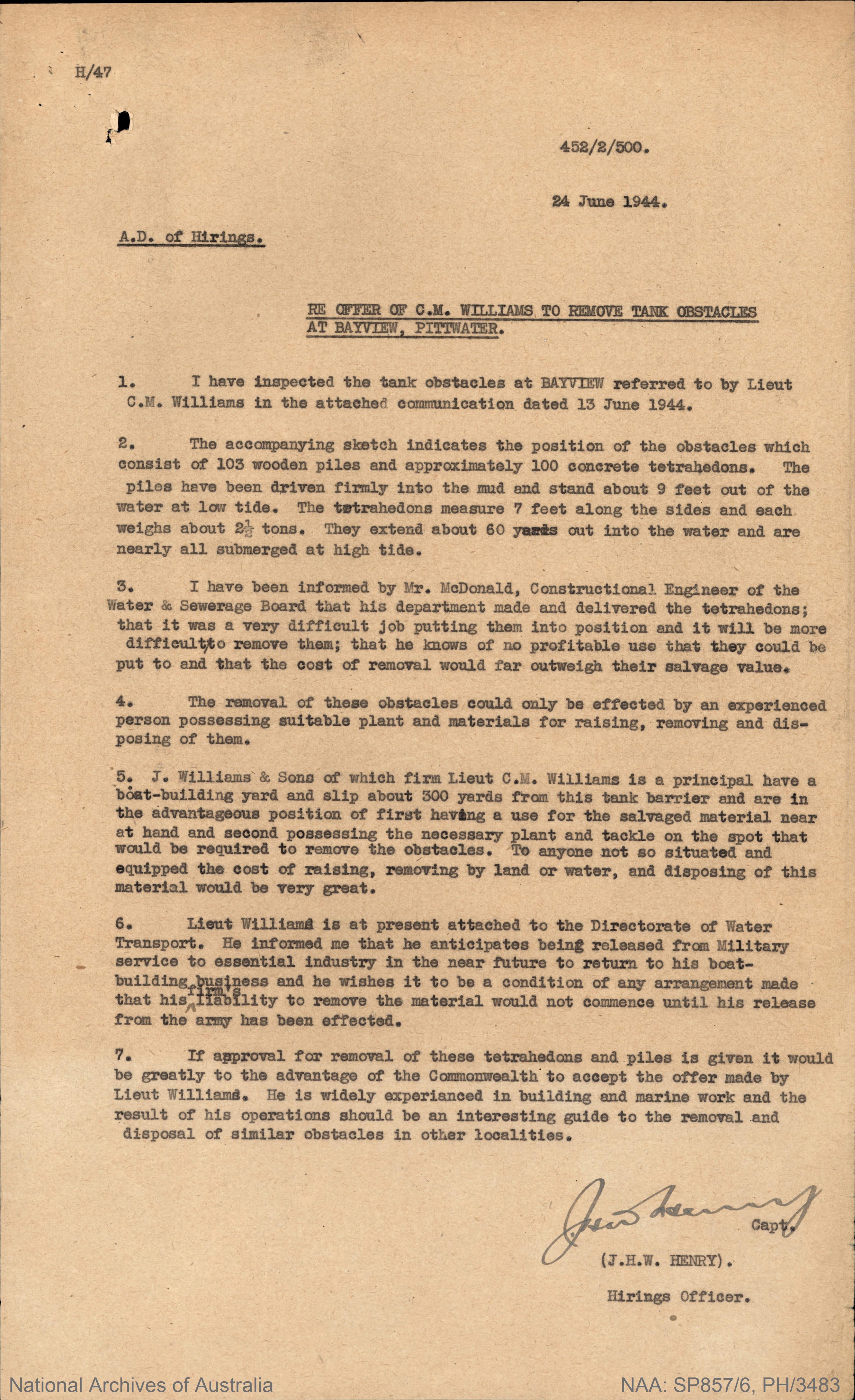
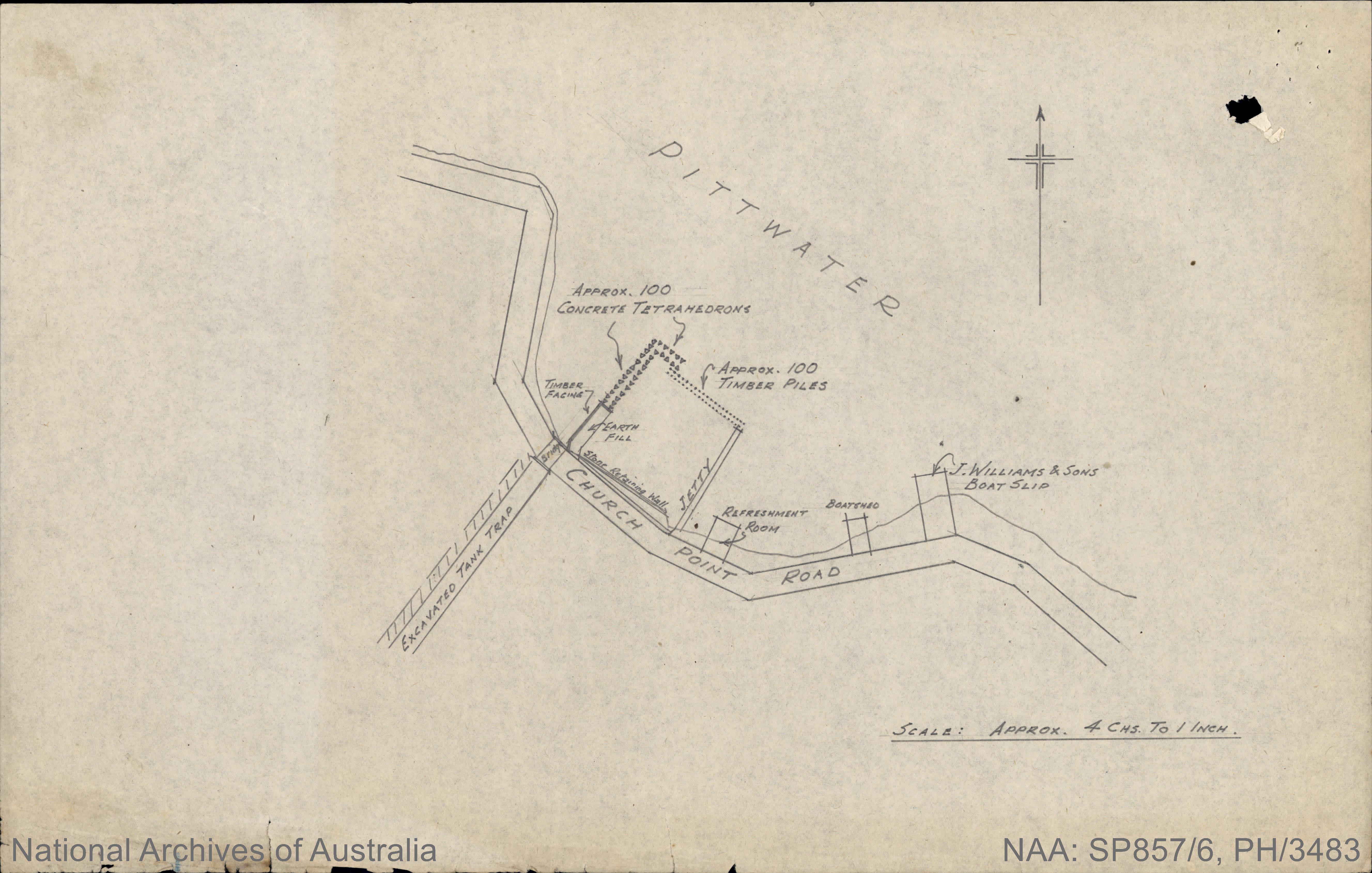
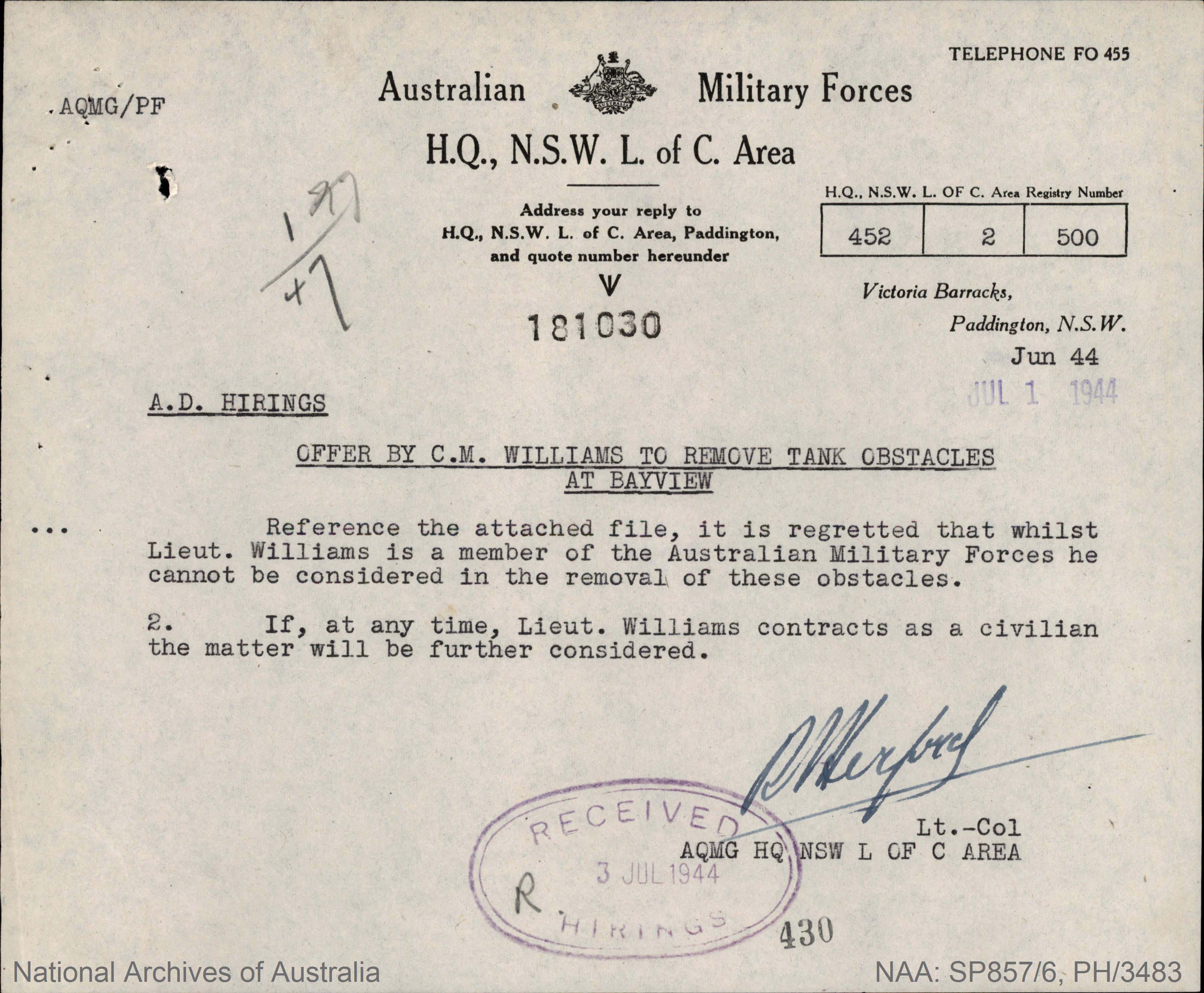
Of course, once he was discharged the work went ahead and the now defunct tetrahedrons were purchased at a minuscule price considering how much concrete went into them. They are probably submerged as moorings around the Pittwater estuary still:
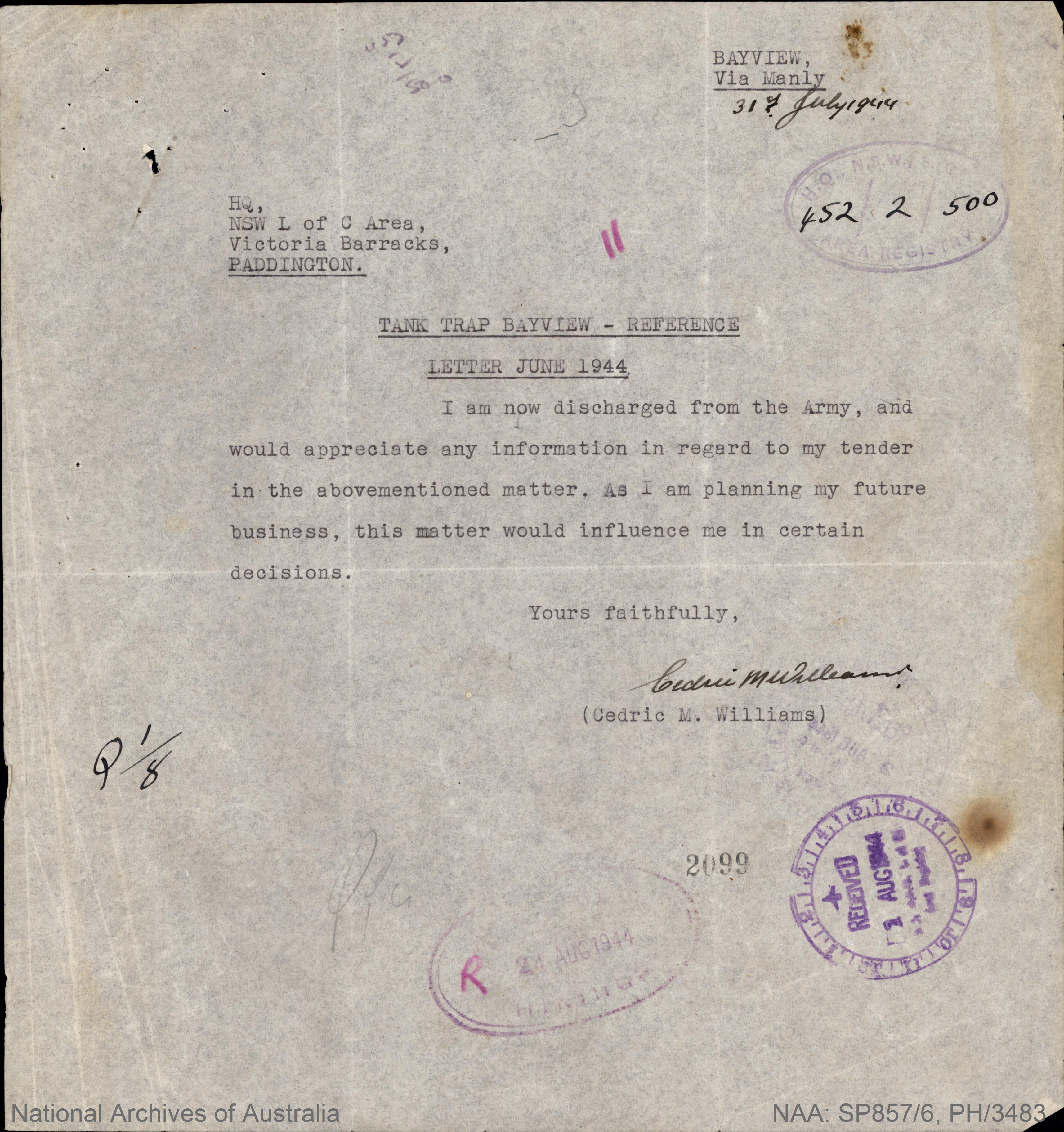
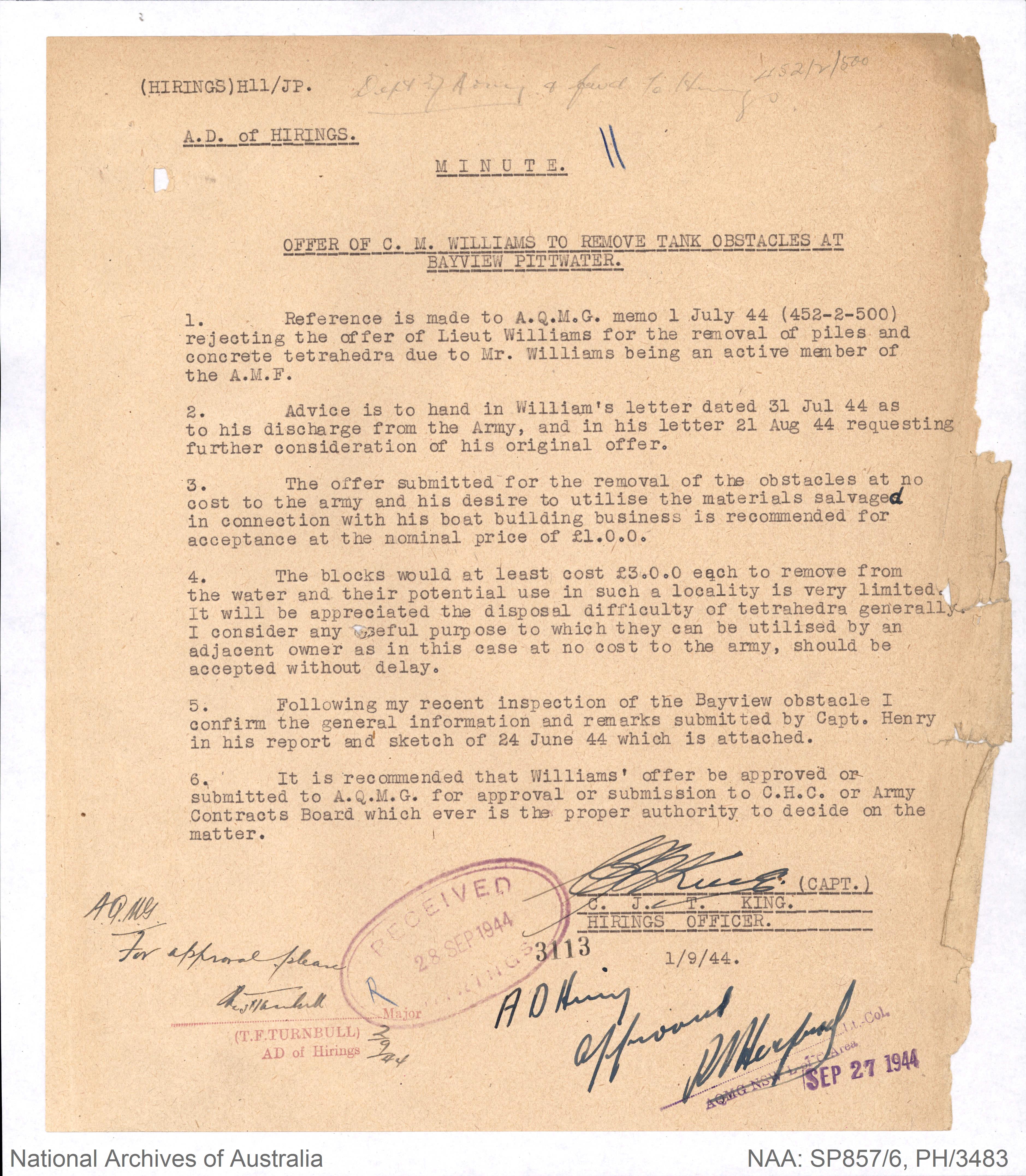
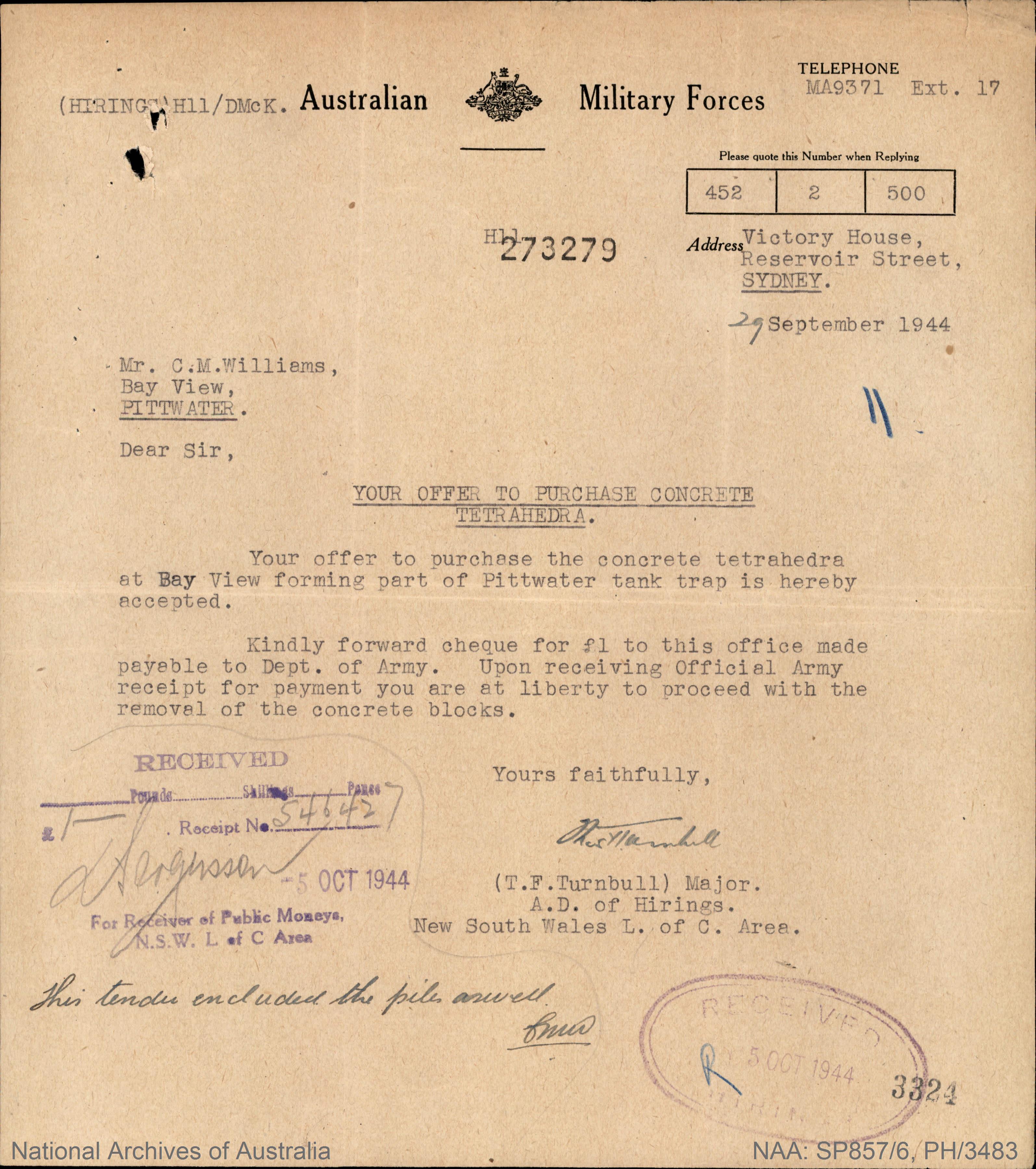
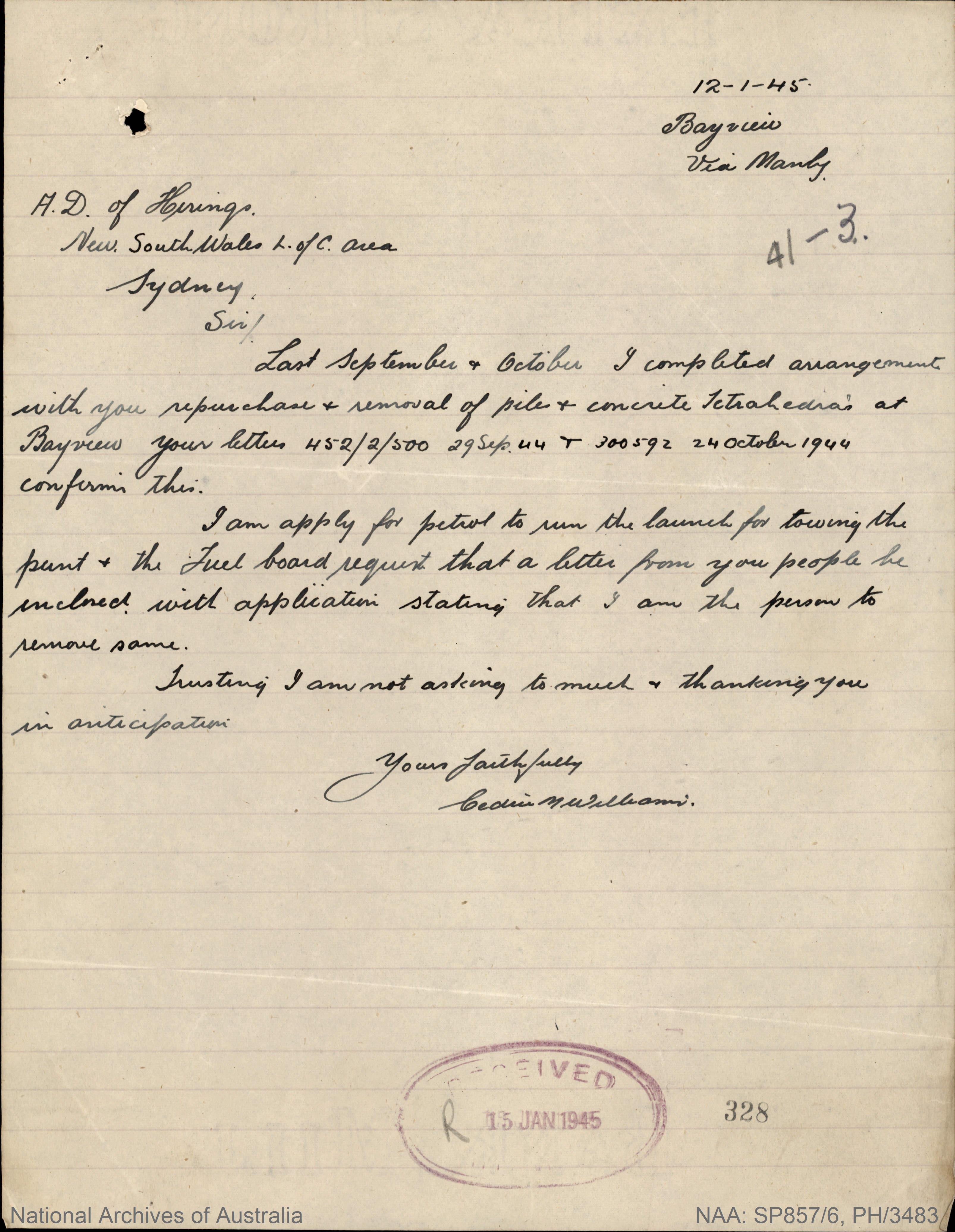
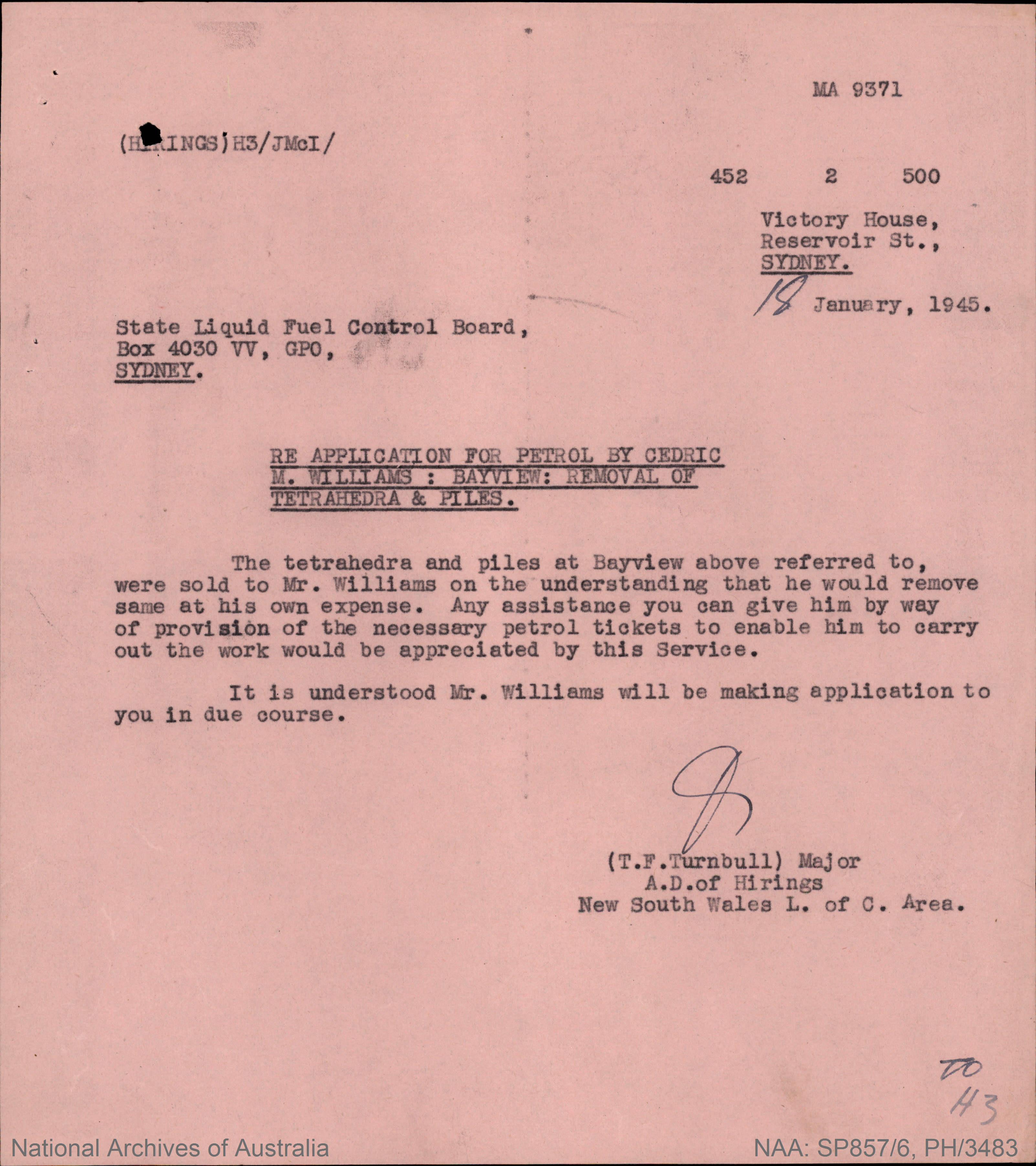
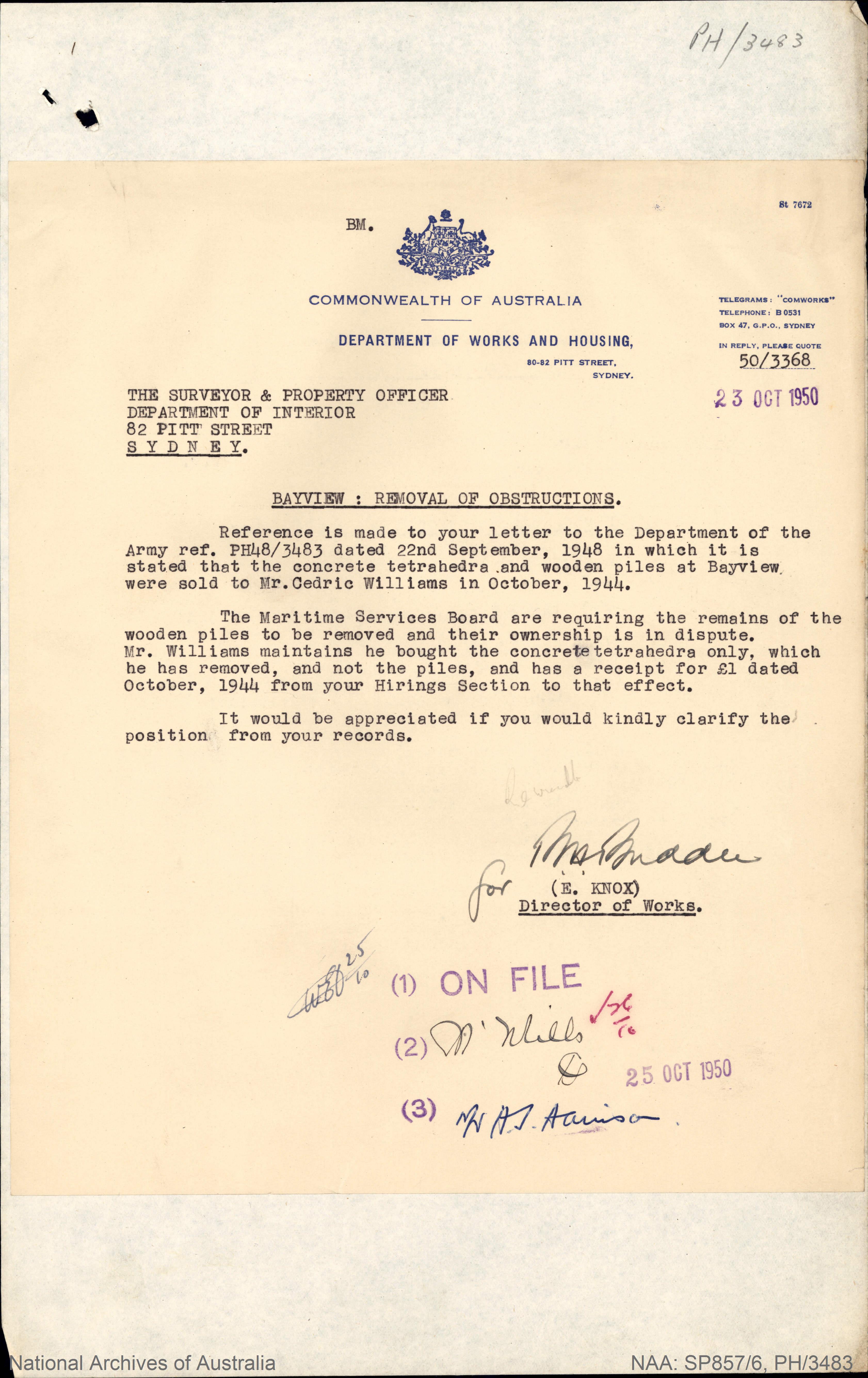
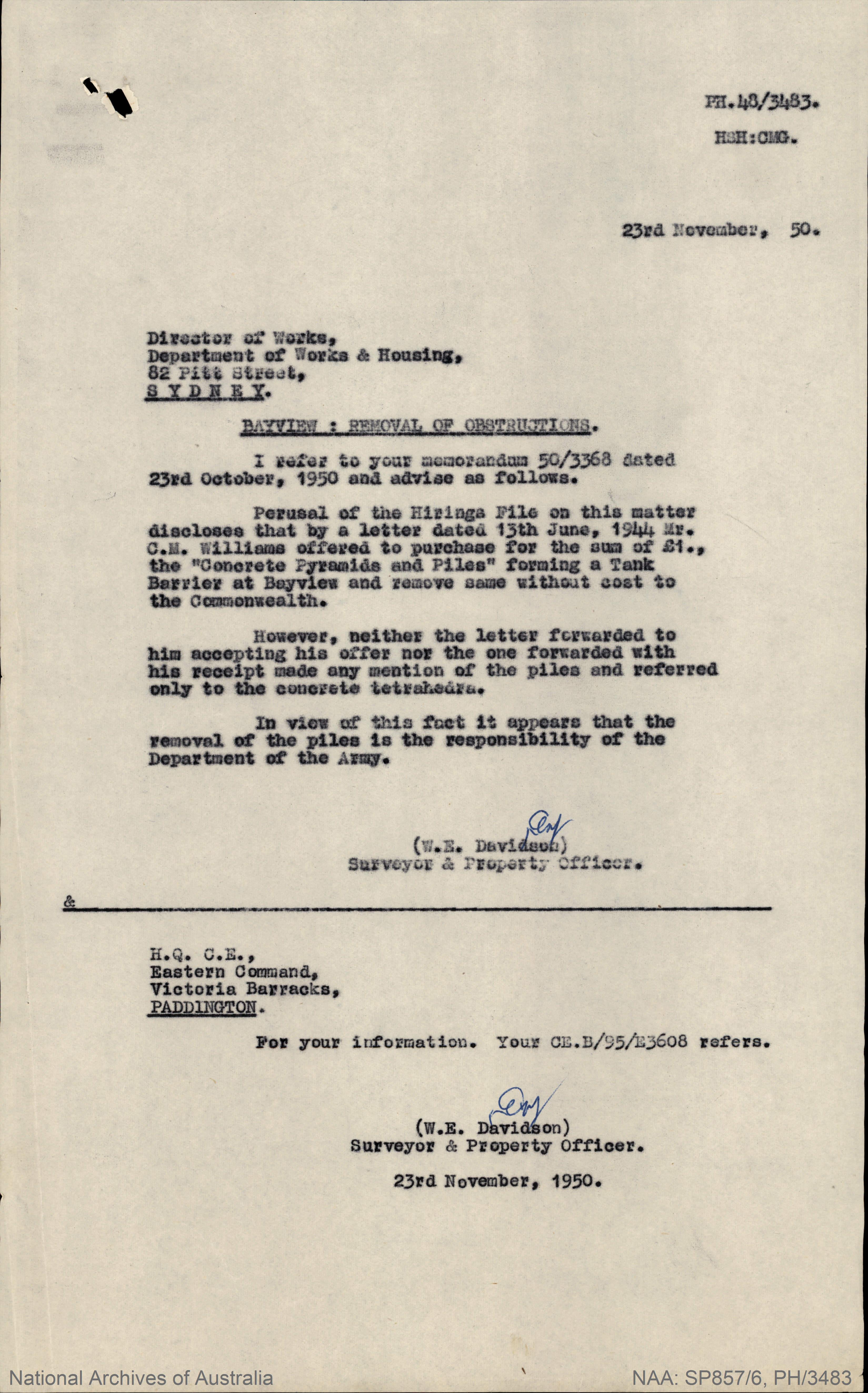
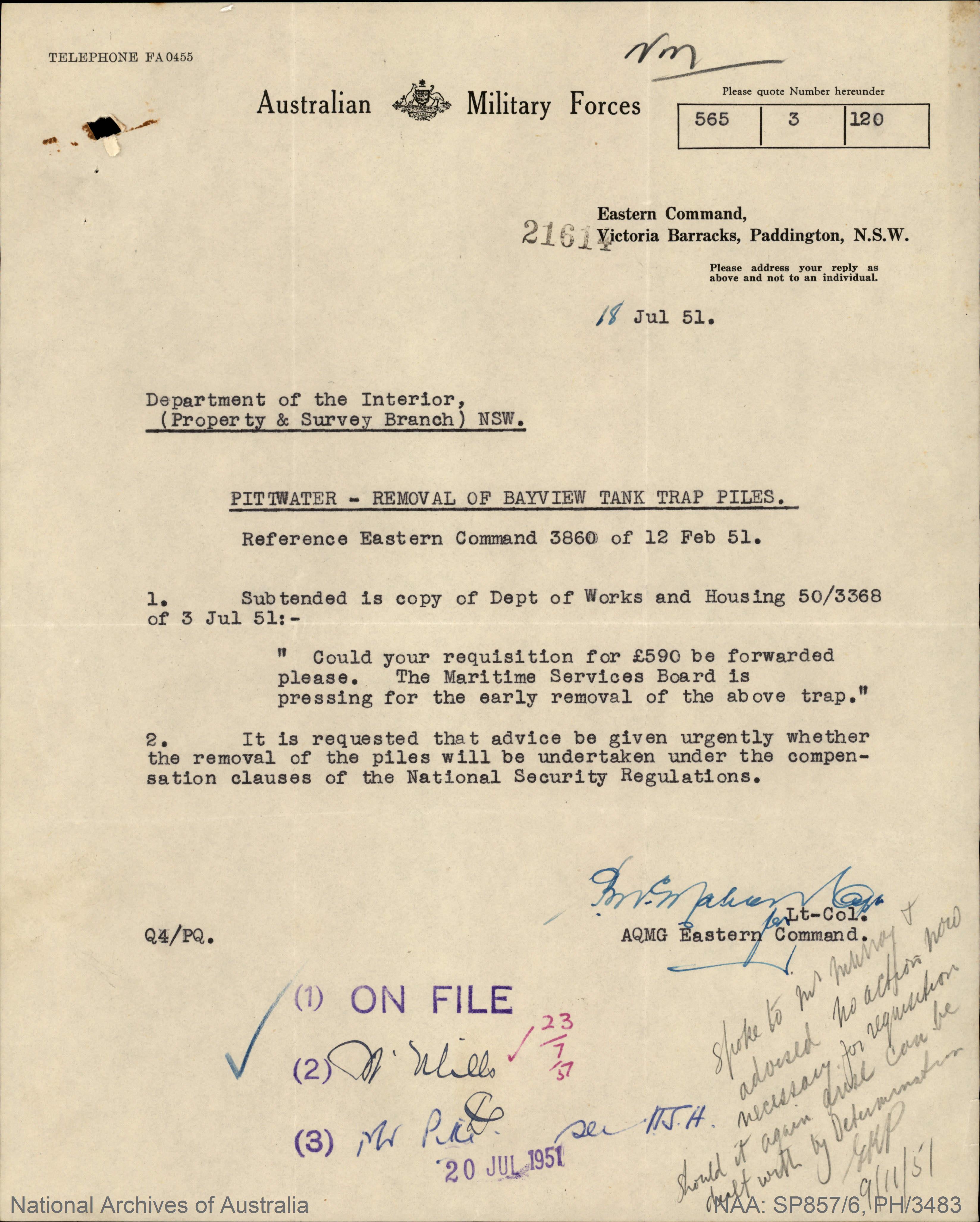
Others were 'deployed' elsewhere:
TANK TRAPS TO PROTECT HOMES
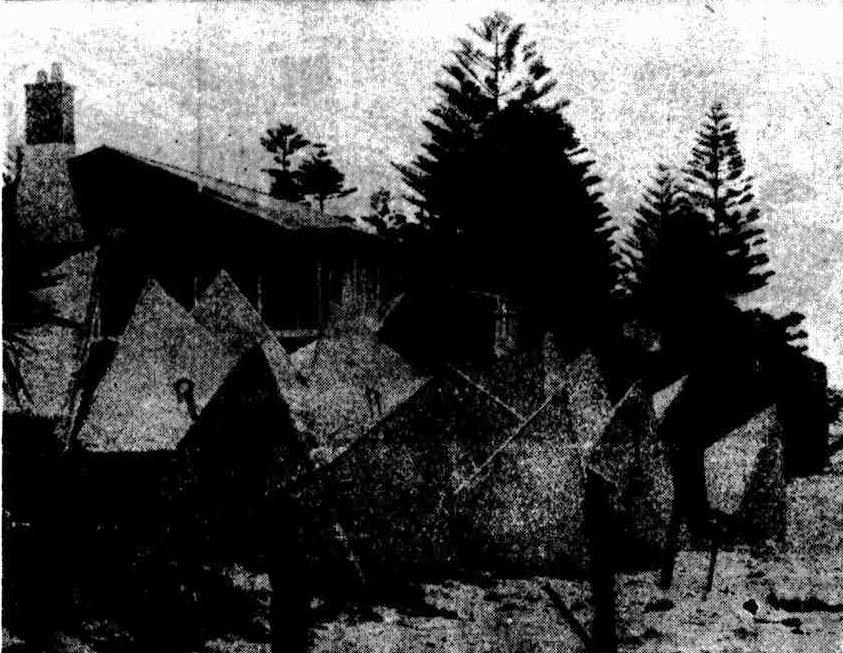
Triangular anti-tank traps have been placed along the beach at Collaroy to prevent washaways of gardens and homes on the waterfront. During heavy storms last year several homes were severely damaged in this area. TANK TRAPS TO PROTECT HOMES (1946, February 14). The Sydney Morning Herald (NSW : 1842 - 1954), , p. 3. Retrieved from http://nla.gov.au/nla.news-article17970399
In the Mona Vale vicinity
Ernest Maxwell Bourke
Ernest Maxwell Bourke of Bayview road Mona Vale, a ‘Machine Drill Man’ as occupation and aged 30 years and 9 months, born August 29th 1909 at Mona Vale NX20210.
He had served as a seaman in the RAN prior to enlisting, again, on June 4th 1940. He served as a Gunner in 2/1 Australian Lt A A Regt. He is 6 feet tall, weighs 196 pounds, has fair hair, blue eyes, a fair complexion and a scar above his right eye and has tattoos on both arms and hands.
By August 1940 he and his wife (Ellen May Bourke) have moved to 22 Gibbs street Chatswood – soon after she moves to Murray Street Collector, NSW. He embarks on June 28th 1941 from Sydney for the Middle East. By February 2nd 1942 he is aboard the HMT Nigerstroom enroute for Australia again, disembarking at Perth in March and on rations, and goes AWOL, over and over, while there. On September 25th 1942 he is admitted to the 103 AGH (Anxiety Neurosis; 22.9.1942) and discharged to GDD on November 27th 1942 with his records stating (‘’Anxiety State’’) – and transferred back to NSW.
On 17.11.1942 he is charged with ‘neglected to obey standing orders’ ands also went AWOL again, for a whole day. On January 267th 1943 he faces a Court of Inquiry held at ‘Georges Heights, whereat the court decrees he illegally absented himself from 21.12.1942 and is still absent. A warrant for his arrest his issued on 28.1.1943 for ‘absconding’. Charged £11-5-11.
On February 1st 1943 he is admitted to 114 AGH while AWOL, by the 2nd it is determined he be discharged and on March 5th 1943 he is diagnosed with schizophrenia and discharged from 114 AGH to GDD MBW.
He is officially ‘Discharged – Medically Unfit for Service Not Occasioned By His Own Fault’ on September 13th 1943. The warrant earlier issued had already been withdrawn in April 1943. He served for 2 years and 251 days and would carry what the conflict had triggered as a condition to be managed for the rest of his life.
BRUDENELL-WOODS—LOWTHER.-The Engagement is announced of Suzanne, eldest daughter of Commander and Mrs. C. Lowther, of Singleton, to Sgt. Kenneth Brudenell-Woods, A.I.F., youngest son of Mr. and Mrs. H. Brudenell-Woods, of Mona Vale. Family Notices (1944, June 10). The Sydney Morning Herald (NSW : 1842 - 1954), p. 20. Retrieved from http://nla.gov.au/nla.news-article17910169
PRISONERS OF WAR: Pte. B. Brudenell Woods, NX13848, Inf., Mona Vale; A.I.F. LOSSES ABROAD. (1941, June 3). The Sydney Morning Herald (NSW : 1842 - 1954), p. 7. Retrieved from http://nla.gov.au/nla.news-article17765176
Arthur Clyde Giles:
Ronald Patten:
Young Singers Engaged
Radio singer with the ABC Dance Band, Valda Bagnall, who has entertained at the Stage Door Canteen every Friday night since it opened, has announced h e r engagement to former Youth Show singer Sgt. Ron Patten. AIF, now with an Army entertainment unit which has toured northern battle areas. Valda has also appeared at numerous camp concerts. She is the daughter of
Miss Valda Bagnall
Mr. and Mrs. W. R. C. Bagnall, of Mosman, and her fiancé is the son of Mr. and Mrs. L. T. Patten, of Mona Vale, formerly of Wellington (NSW). A WOMAN'S NOTEBOOK (1944, December 20). The Sun (Sydney, NSW : 1910 - 1954), p. 8 (LATE FINAL EXTRA). Retrieved from http://nla.gov.au/nla.news-article229282424
Clifton Roby:
ROBY CLIFTON SALISBURY : Service Number - NX54866 : Date of birth - 23 Jan 1917 : Place of birth - MONA VALE NSW : Place of enlistment - PADDINGTON NSW : Next of Kin - ROBY ELLA - went missing in 1942 - presumed dead - never recovered body
ROBY Clifton Salisbury; NX54866 AIF; Year Of Death - 1942; Cemetery - Kranji War Cemetery Memorial, SINGAPORE
Clifton Salisbury Roby was born January 23rd 1917, to Charles Frederick and Ella Roby. Clifton passed away on month day 1942, at age 25
PREVIOUSLY REPORTED MISSING, NOW REPORTED PRISONER OF WAR.
Constable, Cpl E. J. NX19450, Neutral Bay, Med.
Cooper, Pte. A. J., NX28901, Manly, Med.
Ewers, Pte. W. G., NX16950, Manly, Med.
Forssberg, Sgt. C. S., NX24297, Manly,. Med.
McNamara, Cpt. J. W., NX34953, Mosman, Med.
Percy. Pte. R. E., NX9539, Mosman, Inf.
Prince, Sgt. H. W., NX25233, Willoughby, Med.
Rezzonico, Pte. K., NX18791, Mona Vale, Med.
Spence, Pte. A. M.; NX23703, Manly, Med.
Staples. Cpl. J. R., NX20585, Bexley. Med. LONGEST A.I.F. CASUALTY LIST SINCE WAR BEGAN (1941, June 10). Daily Mirror (Sydney, NSW : 1941 - 1955), p. 5 (Late Final Extra). Retrieved from http://nla.gov.au/nla.news-article271155761
Mona Vale Public School World War Two Honour Roll Board: The Stories behind the Names, for Remembrance Day 2024 - threads collected and collated by A J Guesdon 2020 to 2024, and ongoing. © Pittwater Online News
